The purpose of this article is to not only highlight potentially dangerous animals in California, but also hopefully help you learn that many of the animals you might fear have an incredibly low chance of ever harming you. It may also open your eyes on how to avoid dangerous animal encounters as well as what to do should you ever face potential danger.
It is important to remember that the most dangerous animal in all of California is the human. There were over 2,000 murders in California last year, which accounts for many times more deaths than any of these “dangerous animals” are responsible for.
13 Dangerous Animals in California
Mountain Lions

Mountain lion, cougar, puma, panther, and even catamount. Whatever you call it, these are one of California’s primary apex predators and the largest feline species in North America. We tend to call them mountain lion’s in my neck of the woods, where sightings are relatively common.
I would imagine most people who live near the wilds of California have a healthy fear of mountain lions. After all, they are large (about 100-200 lbs), have strong teeth and long claws, and can run up to 50mph! But, mountain lions are known for their solitary and elusive nature and rarely come in contact with humans.
According to the California Department of Fish and Wildlife, there have been 21 confirmed mountain lion attacks in California between 1986 and 2022. That is less than one per year. Only three have been fatal. This means your odds of being killed by a mountain lion are about one in a billion.
About half of the people attacked have been children ages 10 and under. This is why it is important to keep young children within arm’s reach when hiking in mountian lion habitat! Mountain lions may see young children as possible prey. My husband mountain bikes regularly in a park where mountain lions are regularly spotted it is remarkable how many people he sees leaving their young children unattended!
So, what do you do if you encounter a mountain lion? Odds are, mountain lions will see you but you will never see them. And if you do see them, it will be so quick that you won’t have time to react like my neighbor who was mountain biking in Whiting Ranch Regional Park when I cougar quickly trotted across the trail.
According to the National Park Service you should do the following if you encounter a mountain lion:
- Stay calm while facing the lion and standing tall.
- Do not run from a lion. If you run you will trigger the lion’s prey instinct. Instead, keep eye contact and back away slowly. Avoid crouching or bending over.
- Do all you can to appear intimidating. This includes yelling in a loud, deep voice for the mountain lion to go away, clapping your hands loudly, and throwing sticks and rocks at the lion if it attempts to approach you.
If you do see a mountain lion, you should report it. It helps park rangers keep track of the animals’ locations and keep everyone safe, including the lions.
Did you know? Mountain lions are listed as a “specially protected species” under California law. They are also protected under the California Endangered Species Act. Despite these protections, they face various threats such as habitat loss, traffic accidents, and lack of genetic diversity due to a lack of wildlife corridors in more urban areas.
The Liberty Canyon Wildife Crossing in Agoura Hills is currently being built over 10 lanes of US-101 and expected to be completed in 2025. Once completed, it will be a critical wildlife corridor habitat linkage between the Santa Susana Mountains, the Simi Hills and the Santa Monica Mountains.”
Great White Sharks

California’s coastline is known for its population of great white sharks. While shark attacks are rare, it’s important to be mindful when swimming or engaging in water activities in known shark habitats.
Great white sharks are the ocean’s version of an apex predator. Adults are typically 12 to 20 feet long, weigh 1500- 2400 lbs, and swim up to 35mph. Plus, they have hundreds of sharp, triangular teeth! They are ambush-style hunters that eat marine mammals and fish.
Great white sharks prefer nearshore waters, including coastal areas and offshore islands like California’s Channel Islands. They are known to frequent areas where their main prey, such as seals and sea lions, are abundant.
According to the California Department of Fish and Wildlife, “Since 1950, there have been 209 shark incidents in California involving all species of sharks, at least 185 of which involved white sharks. Of those, 15 were fatal and all of the fatalities involved white sharks.”
Of California’s 19 coastal counties, San Diego County currently holds the record for the most shark incidents since the 1950’s at 24. Still, you shouldn’t be afraid to swim in the ocean. According to a Stanford study, you have 1-in-17 million chance of being attacked by a shark in California. You are more than 1,800 times more likely to drown.
Recent drone studies done by Cal State Long Beach’s Shark Lab have discovered that many beaches off the coast of Southern California have become white shark nurseries in recent years as the water warms. Most of the sharks tend to be 50-100 yards offshore and swimming alongside humans regularly with no issues whatsoever.
Del Mar and Carpenteria seem to be popular juvenile white shark spots but most people hanging out past the breakwater (mainly surfers and paddleboarders) have no idea there is a shark swimming near them! The great news is that even with this increase in shark activity, there hasn’t been an increas in shark attacks.
Stingrays

Stingrays are found in shallow coastal waters in California. They are not aggressive towards humans, but they can be dangerous if they are stepped on since they have venomous spines which can cause severe pain.
Stingrays are primarily bottom-feeders, and their diet mainly consists of small fish, crustaceans, mollusks, and other invertebrates. They use their flat, disc-shaped bodies to move along the seafloor while searching for prey. The primary stringray found in California in the round stingray.
In California, there is a seasonal pattern of stingray activity, commonly referred to as “stingray season.” This usually occurs during the warmer months, from late spring to early fall. During this time of year, locals know to do the “stingray shuffle” when entering the water. This involves shuffling your feet along the sand as you enter the water, which creates vibrations that can alert nearby stingrays and give them a chance to move away.
Chris Lowe, the director of the Shark Lab at Cal State University, Long Beach has deemed Southern California the “stingray capital of the world”. There are thousands of sting ray injuries in Southern California each year.
Did you know? It is estimated that over 30,000 stingrays live in Seal Beach where the San Gabriel River meets the sea? It is no surprise that Seal Beach lifeguards treat more than 500 stingray-related injuries each year.
If you get stung by a ray, head to the nearest lifeguard station, as they are well prepared. They will want to remove the barb if a piece is in you and submerse your wound in hot (but not scalding water). This is the best way to neurtralize the sting- not urine as Monica Gellar and Joey Tribbiani on Friends might have led you to believe. The heat breaks up the toxins in the ray’s barb.
The venom of the round stingray is not lethal to humans, but it can cause intense pain, swelling, and other symptoms. The sting may also introduce bacteria into the wound, leading to infection if not properly cleaned and cared for. The risk of infection is the primary danger of a sting.
Rattlesnakes

There are several different types of rattlesnakes that call California home.
The Western Rattlesnake is the most widepspread and there are four distinct subspecies- The Northern Pacific Rattlesnake, Northern Mojave Rattlesnake, Southwestern Speckled Rattlesnake, and the Southern Pacific Rattlesnake. California is also home to the Western Diamondback, Red Diamondback, Sidewinders, and Panamint Rattlesnake.
Read our article all about these venomous snakes in California and discover where they live and how to identify them.
Of all of these species, the Northern Mojave Rattlesnake is the most venomous. Its bite can be fatal if not treated promptly. However, most bites are not fatal, and with proper medical care, the vast majority of people bitten by this snake make a full recovery.
Only about 800 people receive a venomous snake bite in California per year. That”s just 2.5 bites per 100,000 people!
And fortunately, only one or two rattlesnake bites out of the 8,000 per year across the entire country result in death.
Most snake bites occur between April and October, aka: snake season. It should come as no surprise that a large percentage of those who get bit by rattlesnakes are young males who are purposely bothering the snakes (and often intoxicated).
Of course, there are still plenty of people who accidentally get bit by unintentionally stepping on a snake. This is usually a result of walking through thick grass somewhere off trail or not paying attention to wear you are going. Thankfully, a rattlesnake bite may hurt, but it isn’t a reason to panic.
If you get bit by a rattlesnake:
- Remain calm. You don’t want to elevate your heart rate much so avoid activities like running.
- Gently wash the area with soap and water if possible. Apply a cold, wet cloth over the bite.
- Call 911 or head to the nearest emergency room
- Keep the bite site elevated above your heart on your way to the emergency room.
DO NOT Do These Things If You Are Bit By a Rattlesnake
There are many myths surrounding rattlesnake bites. Avoid the following:
- Do not apply a tourniquet
- Do not cut the wound with a knife to “let the poison out”
- Do not try to suck out the venom
- Do not pack the wounded area in ice
If your pet gets bit by a rattlesnake, take them to the nearest emergency vet. Many veterinarians have anti-venom on hand, especially in rattlesnake prone areas.
As an avid hiker, I have encountered rattlesnakes many times and every single time, the snake had no interest in getting involved with a human. In nearly every time, the snake gave me plenty of warning with its rattle.
Scorpions
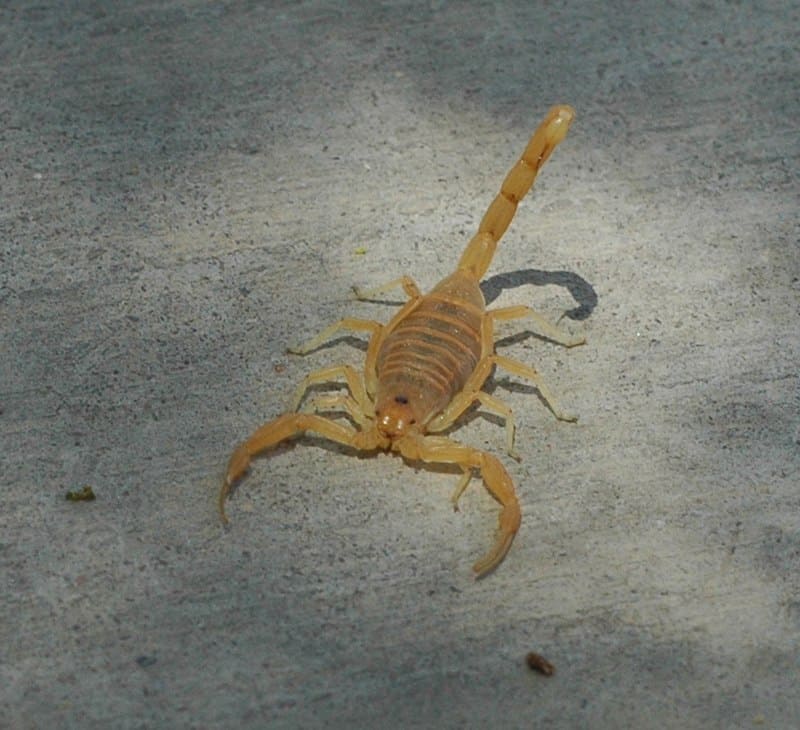
There are several species of scorpions in California, and many of them are venomous. These arachnids are most active at night and while they are most commonly found in deserts, they can be spotted in forests and even some urban areas.
While scorpion stings can be very painful, there hasn’t been a death from a scorpion bite in the United States since the 1940s.
The most common scorpion species in California is the aptly-named California common scorpion. This species is found in various habitats, including deserts, woodlands, and urban areas. While their stings can be painful, they are not typically life-threatening to healthy adults.
The Arizona Bark Scorpion is found in the southern desert regions of California, and is one of the most venomous scorpion species in North America. A sting from this critter is painful, and while healthy adults usually recover without major complications, children, the elderly, and individuals with allergies may experience more severe reactions.
Bark scorpions are typically only three inches long and with a very thin tail. They are climbers and attracted to moisture around homes. They only need a 1/16 inch crack to enter a building and can climb stucco and enter through attics. If you live in bark scorpion territory, make sure you house is well sealed.
The Striped Tail Scorpion is another scorpioon found in California. It is the one you are most likely to find in shoes or sleeping bags while outdoors since they are a burrowing species Luckily, though the sting is painful, it isn’t life-threatening.
If you do happen to get stung by a scorpion:
- Call your doctor ASAP. Most scorpion stings don’t need medical treatment, but it is important to consult with a medical professional to know what symptoms to look for which might indicate a need to a hospital visit.
- While waiting to medical treatment, clean the area around the sting with soap and water, taking care to keep the area around the sting still if possible to reduce the spread of the venom.
- Apply an ice pack or cold compress.
- Take an over-the-counter pain reliever.
- The skin broken by theosting could get infected with tetanus bacteria so it is important to make sure your tetanus shot is up to date.
Deer

When you think about dangerous animals in California, you probably don’t think about deer, but you should! They are actually one of the most dangerous animals in the state because they cause over 20,000 car collisions per year!
And while that sounds like a lot, take comfort in the fact that California is the 49th most likely state to for a driver to be involved in a deer collision; only Hawaii ranks lower.
According to State Farm, there are 1.33 million deer-vehicle collisions in the US per year. The odds of hitting a deer with a car in the country as a whole are 1 in 116, but the odds in California are only 1 in 1,125.
It should be no surprise that you are most likely to hit a deer when they are most active- dusk and dawn. If you are driving in an area with a heavy deer population, be extra aware when driving during those times.
Black Bears

Black bears can be found in many parts of California, especially forested areas. They generally do avoid human contact but they have been known to cruise neighborhoods in search of food, especially on trash day.
Black bear encounters are relatively common in California, especially in areas where human development encroaches on their natural habitat. These areas include the foothills of LA County and the Lake Tahoe region. These encounters are usually not aggressive, and black bears will often flee when they detect human presence. However, they can become habituated to human food sources, leading to conflicts and potentially dangerous situations.
Black bears are the only bears that live in California. There used to be a healthy grizzly bear population in California. As a matter of fact, there were 10,000 grizzly bears in the state before the Gold Rush, enough to put the grizzly bear on the state flag. Unfortunately they were hunted to extinction in the 1920s.
Today, there are 30-40,000 black bears in California. Despite their name, they can have fur color that ranges from black to various shades of brown. Adult male black bears can weigh between 200 to 600 pounds, while adult females generally weigh less, ranging from 150 to 400 pounds.
Fun fact- black bears are not native to Southern California (though grizzly bears were). All of the black bears in the Southern California region today are descendants of 27 bears captured in Yosemite National Park and release in the San Gabriel and San Bernardino mountains in the 1930s!
While their diet consists of berries, nuts, fruits, insects, small mammals, and occasionally scavenged carcasses, they are also known to raid trash cans or campsites in search of food, which can lead to conflicts with humans. Thankfully, according to the World Animal Foundation, there has not been a fatal wild bear attack in the Golden State since 1986.
In June 2022, a wild black bear was put down after it clawed a woman on the face while trying to escape her home in North Lake Tahoe, but this is rare. There are typically less than five bear attacks in the state per decade.
What to do if you encounter a black bear:
- Do not run! This will trigger the bear’s prey drive.
- Keep a safe distance and begin to back away slowly.
- Make yourself look bigger by waving your arms and standing tall.
- Make noise by yelling “Go Away Bear” and clapping your hands. Do not make eye contact.
You can avoid bear encounters by making noise on a trail that is in bear country. Allow them to hear you coming so they can move out of the way.
If you are camping in an area with bears, make sure to practice safe food storage techniques (don’t leave food in your car unless you want it broken into by a furry visitor) and cleaning up thoroughly after a meal. Bear lockers are your friend- use them.
Widow Spiders
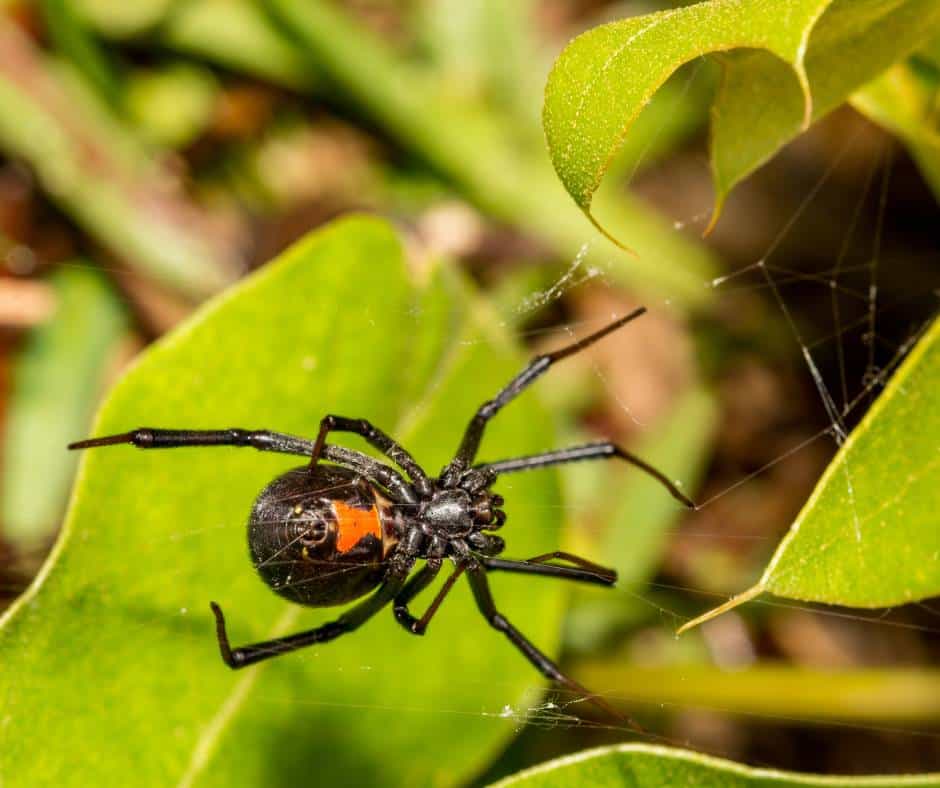
There are two types of widow spiders that call California home, the Western Black Widow and the Brown Widow. The Western Black Widow is the more venomous of the two. Although their bites are rarely fatal, they can cause severe pain and discomfort.
The Western Black Widow is found almost everywhere in California. They are most often found in dark corners of garages and sheds or in pipes and drains. The female black widow has a distinctive black body with a red hourglass-shaped marking on its underside. Female black widows are usually about 1.5 inches long and far more likely to give you a venomous bite.
Young children and older adults are the most susceptible to these spider bites. Bites can cause chest pain, stomach cramping and nausea, swelling of the eyelids, and even burning at the bottom of the feet! Other symptoms include fever, chills, shock, and very high blood pressure.
If you get bit by a black widow spider:
- Call your doctor or poison control. If you exhibit severe symptoms they may want to give you anti venom or anti-spasm pain meds.
- Try to remain calm to slow the spread of toxins through your body
- Ice the wound. You will notice two small puncture wounds at the site of the bite.
- If you can find the spider, take a picture to identify it for medical professionals.
The Brown Widow is another venomous spider found in California. It is similar in appearance to the black widow but has brown coloration with orange or yellow markings. While its bite is generally less potent than that of the black widow, it can still cause symptoms such as localized pain, muscle stiffness, and nausea.
While Brown Widow spiders are venomous, their bites are generally considered to be less harmful to humans than those of other widow spiders like the black widow. Severe reactions are rare.
Desert Recluse Spider

The Desert Recluse is a less common but potentially dangerous spider found in desert regions of California. It is found mostly in the Sonoran and Mojave deserts as well as the foothills of the lower San Joaquin Valley.
It is brown in color and has a violin-shaped marking on its back. The violin shape is less distinct in desert recluse spiders compared to the brown recluse. Bites from desert recluse spiders are not as bad as the dreaded brown recluse (which is not in California), but they can cause tissue damage in some cases.
Symptoms of a desert recluse spider bite include pain, swelling, redness, and a characteristic blister at the bite site. In some cases, the tissue around the bite can become necrotic (dead), leading to an ulcer. Severe reactions are relatively rare.
If you get bit by a desert recluse spider, RICE is recommended- rest, ice, compression and elevation. You should also try to get a picture of the spider of possible because many times people think they were bite by a recluse spider when they were not.
If you start to exhibit severe symptoms, definitely call a medical professional. You should also try to get a picture of the spider if possible because many times people think they were bite by a recluse spider when they were not.
Coyote
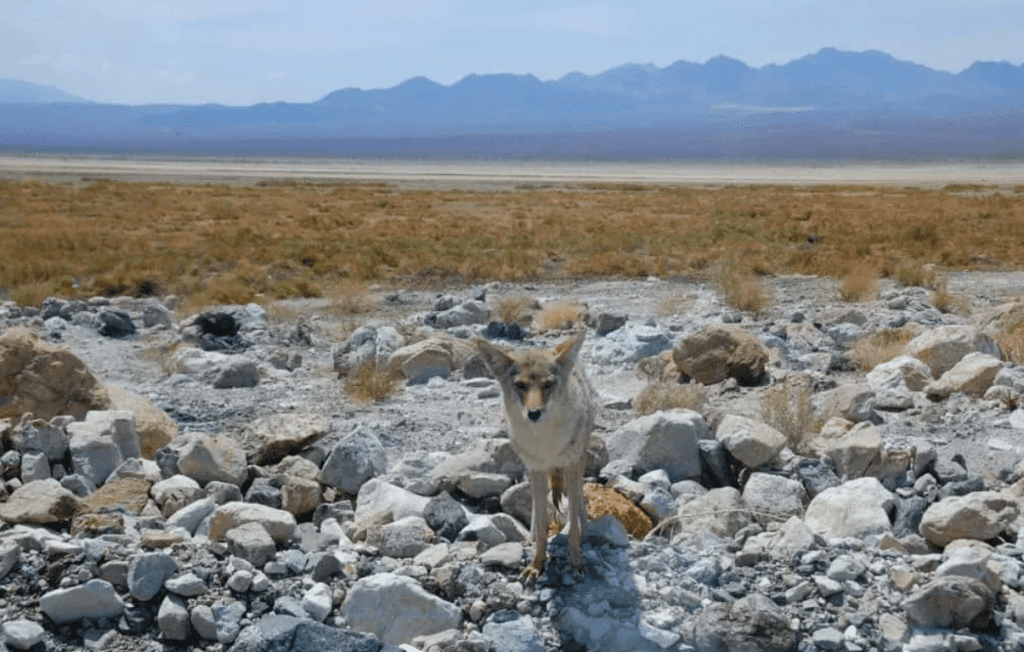
Coyotes are found throughout California, from the desert to the mountains, and even urban areas. They are widespread due to their incredible adaptability. The California Department of Fish and Game estimates 250,000 to 750,000 coyotes live in the state.
Coyotes have been in the news more lately because humans have been continuing to encroach on their wild territory and coyotes have become more and more present in urban areas where they hadn’t been previously spotted. While they are generally shy and avoid humans, they have been known to attack pets and small children. They are most aggressive May through September when they are caring for their pups.
Coyotes are primarily nocturnal and most active at dawn and dusk, but they can also be active during the day. They are opportunistic omnivores, which means they eat a varied diet including small mammals, birds, insects, fruits, and even carrion. They will also happily take advantage of human food sources.
We see coyotes on a regular basis in our neighborhood and I know of zero cases of them attacking humans. However, outdoor cats do not last long in my neck of the woods and small dogs should never be left unattended in a backyard because coyotes can hop a fence with ease and see your little pups as a tasy meal. Never leave pet food outside because this will only attract coyotes.
While coyote attacks on humans are extremely rare, they can occur, especially when coyotes have become accustomed to people and lose their natural fear. There are typically about 10 coyote attacks in California each year, and this number is rising.
If you have a coyote problem in your neighborhood you can use hazing techniques to reinforce their natural fear of humans. Be loud and wave your arms if they attempt to approach. You can also throw rocks and sticks in their direction.
Yellowjackets
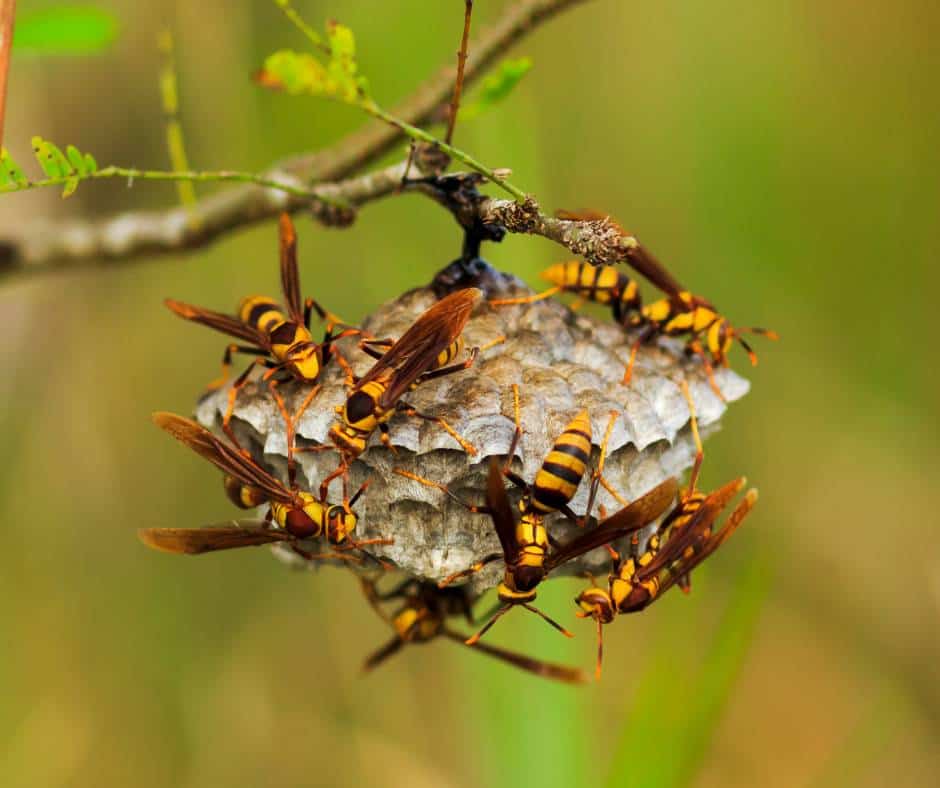
Yellowjackets are large wasps found throughout California. Yellowjackets can be aggressive when disturbed and unlike bees, will sting repeatedly. The stings can be very painful and can cause allergic reactions in some people. They build nests in various locations, including underground, in trees, or on structures.
Yellowjackets are social insects that live in colonies with a clear division of labor. The colonies are founded by a queen, who lays eggs that develop into workers. It’s good to be the queen! The workers handle all the foraging and nest-building duties. Nests can be located underground, in cavities, and in trees or on structures.
Yellowjackets are particularly defensive when it comes to their nests. If they perceive a threat to their colony, become aggressive and sting repeatedly in defense. Mowing lawns, using outdoor equipment near their nests, or even accidental disturbances can trigger defensive behavior.
In late summer and early fall, yellowjackets become more aggressive as their colonies reach their peak size and food sources become scarcer. This is when they are most likely to come into contact with humans and become a nuisance.
If you do get stung, gently remove any visible stingers with a flat-edged object like a credit card. Wash the sting site with soap and water and apply a cold compress to reduce pain and swelling. An over-the-counter pain reliever should help as well. If you experience a severe allergic reaction or have difficulty breathing, call 911 immediately.
Tarantula Hawk Wasps
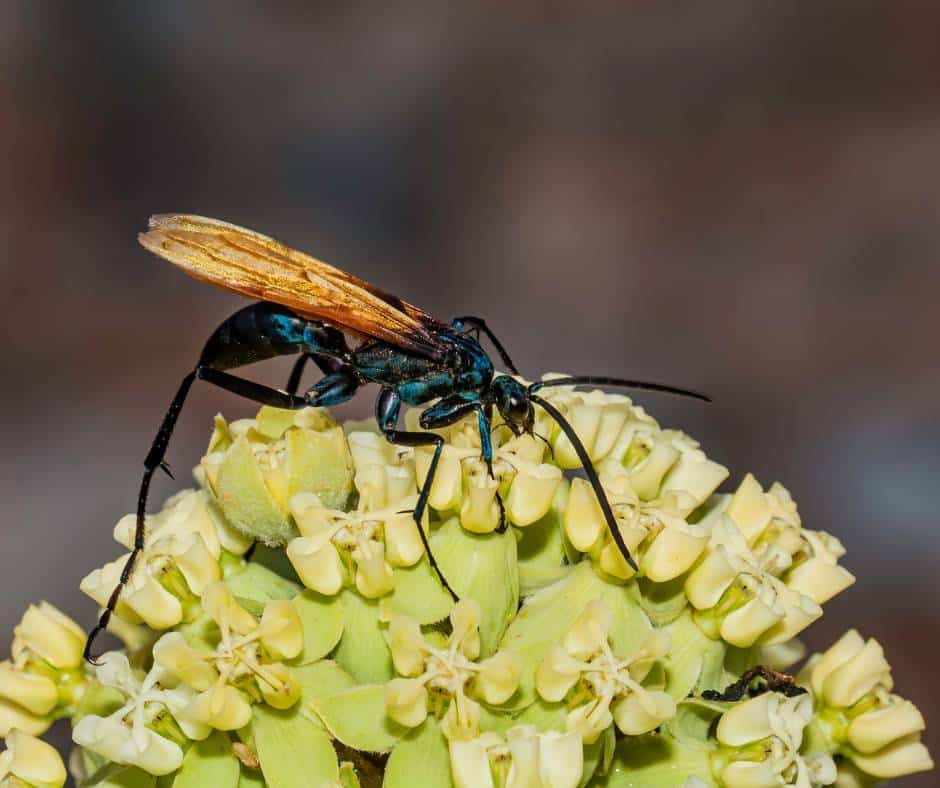
Tarantula hawk wasps are found in California deserts and known for their painful stings. In addition to the deserts, this wasp is common in southern California’s chaparral areas. They are not aggressive toward humans, but will sting if provoked or handled. A sting from the tarantula hawk wasp is considered one of the most painful insect stings, resulting in intense pain and localized swelling.
Tarantula hawk wasps are large, up to two inches in length, and have dark blue, iridescent bodies, bright orange wings, and long legs.
Female tarantula hawk wasps are known for their incredible hunting behavior. They specialize in preying on tarantulas, particularly large and docile species. The female wasp seeks out a tarantula, then paralyzes the spider with a venomous sting.
Once the tarantula is immobilized, the wasp lays a single egg on the spider’s body, drags it to a burrow, and seals the burrow entrance. The developing wasp larva feeds on the still-living tarantula that has been paralyzed by the female wasp’s neurotoxic sting! She then covers the burrow, trapping the spider inside. The larva feed on the spider’s vital organs last, in order to keep it alive long enough for the larva to turn into adult wasps. Freaky!
While the sting of a tarantula hawk wasp is considered one of the most painful insect stings, it is not usually dangerous to humans. The pain from the sting is often described as intense and immediate, lasting for several minutes to an hour. It is described as feeling like an electric shock or a hot poker, so I suggest avoiding these little guys!
Fire Ants

Originally native to South America, fire ants have unfortuntately spread to many parts of the world thanks to human activity. They thrive in warm and humid environments, making them common in the southern US, including some parts of California.
Fire ants are known for their aggressive behavior and deliver painful stings that can cause severe allergic reactions in susceptible individuals. If you have stepped in a bunch of fire ants before, you know that they love to swarm and bite the heck out of you!
California fire ants will nest in the ground, such as at the base of trees or shurb, or in grass. They seem to have an attraction to electricity and have been known to nest in electric outlets, breaker boxes, and HVAC systems. They will eat just about anything, including wire insulation and electric lines.
When threatened, fire ant will quickly swarm and sting intruders multiple times. The sting produces a burning sensation, hence the name “fire ant”. After the sting, victims will experience itching, pain, swelling, and a bunch of tiny, pus-filled blisters.
Right now, fire ants are primarily found in North San Diego County, South Orange County, the San Bernardino area and the Coachella Valley. The fire ant territory is currentlyincreasing by about five miles a year occur by flying females as well as plants that are moved from one location to another with a queen living in them. According to the California Department of Food and Agriculture, “This ant is expected to colonize all irrigated agricultural areas and lawns in California.”
The red fire ant is a quarantined pest in California. If you encounter fire ants on your property, be sure to call the California Department of Food and Agriculture’s Pest Hotline 1-800-491-1899. These pests have the potential to cause major damage to California’s agricultural industry so they actively try to quarantine and erradicate an infestation once it is reported.
]]>Not all poisonous snakes in California cause a life-threatening danger to humans. Some use their venom to subdue their prey and will only cause mild irritation to large mammals. Others are quite dangerous but not deadly, as long as medical treatment is sought immediately.
Only about 800 people receive a venomous snake bite in California per year. That”s just 2.5 bites per 100,000 people! And even better news- there are only one or two deadly rattlesnake bites per year in the entire country! Those are pretty great odds!
Snakes should not be feared but respected. Give them plenty of space and head their warnings (like a shake of the rattle) and you can enjoy these wonderful creatures who play a crucial role in our state’s ecosystems.
At the end of this article you will find snake safety tips as well as tips on what to do on the rare occassion of a venmous snake bite.
Want more California snake coverage? Here is your guide to 45 different types of snakes in Southern California.
Venomous Snakes in California
The Western Rattlesnake is the most widepspread venmous snake in California and there are four distinct subspecies that can be found in the state- The Northern Pacific Rattlesnake, Northern Mojave Rattlesnake, Southwestern Speckled Rattlesnake, and the Southern Pacific Rattlesnake. Here are details about each one:
1. Northern Pacific Rattlesnake
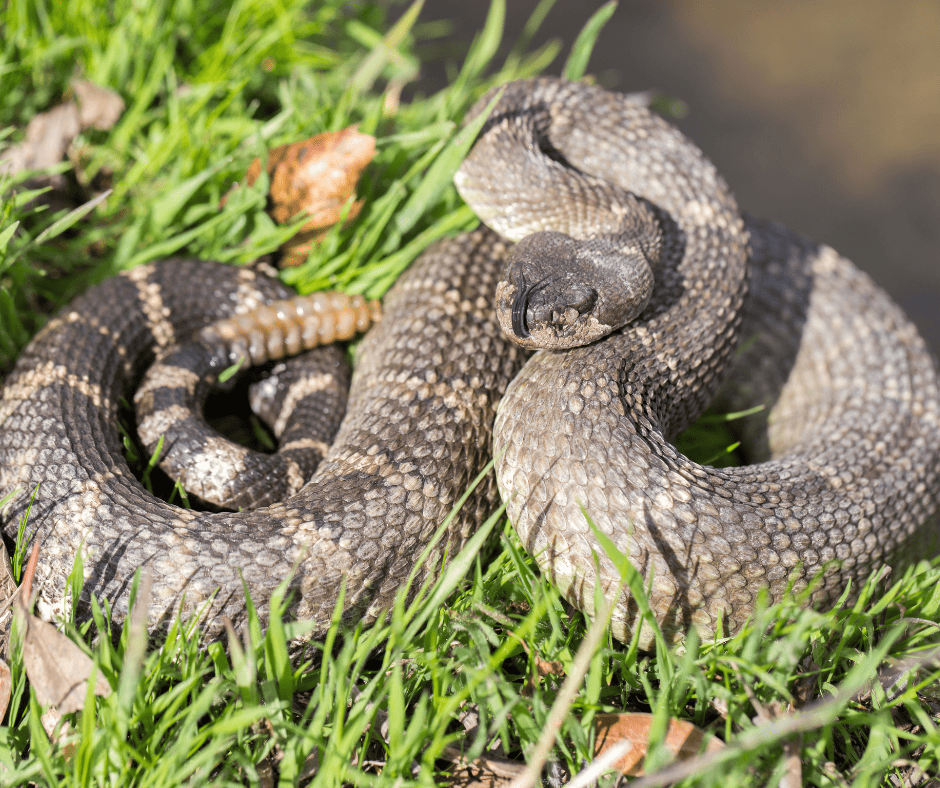
The Northern Pacific Rattlesnake is a larger snake, with adults typically ranging from 3 to 4 feet in length. They have a relatively thick body with a series of dark, diamond-shaped blotches running down their back. The coloration can vary, but they often have a brown, gray, or olive background color, with darker brown or black blotches bordered by lighter scales.
This subspecies is found in the Pacific Northwest, including parts of Oregon, Washington, and Northern California. Northern Pacific Rattlesnakes can be found in a variety of habitats, including grasslands, woodlands, rocky slopes, and desert areas. In California, they are known to inhabit regions such as the Sierra Nevada, the coastal ranges, and the Central Valley.
Northern Pacific Rattlesnakes are primarily active during the warmer months and are most active during the early morning and late afternoon. They are ambush predators, feeding on a diet that primarily consists of small mammals, birds, lizards, and occasionally other snakes. They use their venom to immobilize and digest their prey.
Fun fact: A new rattle is gained each time a rattlesnake sheds it skin!
2. Northern Mojave Rattlesnake

The Northern Mojave Rattlesnake, aka: the Mojave Green Rattlesnake, is found in southeastern California, from the Colorado River north of the San Bernardino County line, west through the Mojave Desert to the Antelope Valley, to Walker Pass in the Sierra Nevada, and east of the Sierra Nevada into Inyo County.
In many ways, the Northern Mojave Rattlesnake looks and acts like a Western Diamondback, but there are some differences in appearance.
The most easy way to differientiate the two is location, location, location. Northern Mojave Rattlesnakes live in the high desert while Western Diamondbacks live in Southern California’s low desert.
It is a stout snake with a triangular head and a blackish or brown body with a series of light-colored saddles. The tail is long and has a prominent rattle. Adults typically measure between 2 and 4 feet in length.
This snake prefers open, arid habitats, such as grassland, desert scrub, rocky slopes, creosote bush flats, open juniper woodland, and light chaparral. It can also be found in lower mountain slopes up to about 8,000 feet in elevation. This rattlesnake feeds primarily on small mammals (mice, rats, rabbits, gophers), but will eat lizards and amphibians as well.
The Northern Mojave Rattlesnake is the most venomous snake in California, and its bite can be fatal if not treated promptly. However, most bites are not fatal, and with proper medical care, the vast majority of people bitten by this snake make a full recovery.
3. Southwestern Speckled Rattlesnake

The Southwestern Speckled Rattlesnake is found in the southwestern United States, including parts of Arizona, New Mexico, and Southern California. It has a light brown or grayish-brown coloration with lighter blotches outlined by darker speckles.
It lives in the Santa Ana mountains of eastern Orange County, most of San Diego County (except the coastal area), eastern Imperial County, most of Riverside County, most of the southern half of San Bernardino County, and the Antelope Valley.
Speckled Rattlesnakes are most often spotted in rocky areas and they come in a variety of colors that camouflage well with their rocky homes. When the rocks are lighter in color, the snake will be snake will be light in color with darker speckled bandings across its back. If the rocks are darker, the snakes will be dark as well.
Adult Speckled Rattlesnakes are typically 2-3.5 feet in length. They do have black and white rings near the end of their tail at the rattle. Like all pit vipers, they have pits on the sides of their triangular heads which they use to detect heat and identify prey. They are primarily ambush predators who eat small mammals, reptiles, and small birds.
Learn more about Southern California wildlife. Here is your guide to all the hawks in Southern California.
4. Southern Pacific Rattlesnake

The Southern Pacific Rattlesnake is the subspecies of Western Rattlesnake that is most commonly seen in Southern California. They live in Southern California west of the San Bernardino Mountain range. They won’t be found in the desert or Imperial County.
Many people tend to think that the rattlesnakes they are seeing in the LA/OC/SD area are Western Diamondback Rattlesnakes, but those snakes do not live in this area. If you see a rattler in this region, it is very likely a Southern Pacific Rattlesnake.
You will see them most often in chaparral, rocky areas, and grassy areas. I have seen them most often near rocks sunning themselves or in dry grass near the edges of trails.
Southern Pacific Rattlesnakes are most active in the spring and fall. Truth be told, they usually see you before you see them and will give you fair warning with a rattle of their tale. They are not aggressive but they are venomous, so steer clear and give them plenty of space if you are passing by.
These snakes are anywhere from 1-5 feet long, and have a stripe behind the eye extending behind the corner of the mouth. Southern Pacific Rattlesnakes have rattles and their tails are more stumpy than a Gopher Snake (which can look similar). Gopher Snakes have tails that taper and become quite skinny at the end and no rattle.
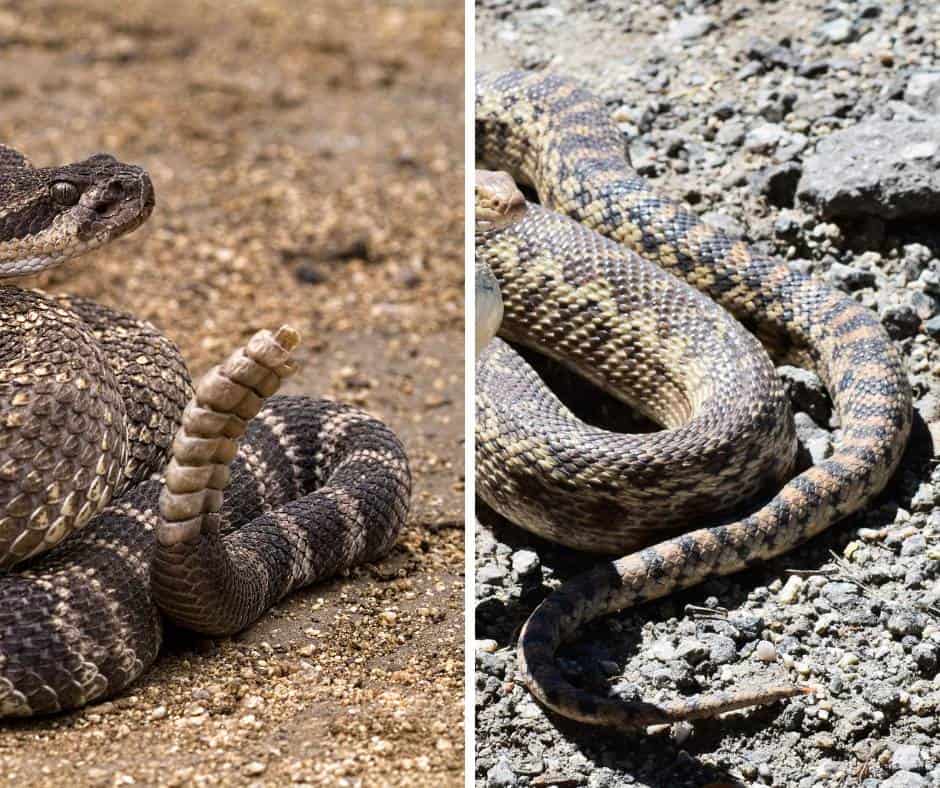
They do have light and dark rings at the tail but they aren’t sharply contrasting like the Western Diamondback and Northern Mojave Rattlesnake. There is a thicker tail ring right before the rattle that is generally dark brown in color. It has a light brown or grayish-brown coloration with distinctive dark blotches along the body.
Like other rattlesnakes in California, these snakes eat lizards, small mammals, amphibians, birds, and even other snakes!
There are over 25 varieties of snakes in Joshua Tree National Park, including the Southern Pacific Rattlesnake. Use our Joshua Tree Day Trip Itinerary and keep your eyes out while exploring.
5. Western Diamondback Rattlesnake

The Western Diamondback Rattlesnake is a beautiful rattlesnake that is highly regarded in Western lore. It is named for the diamond-shaped pattern on its back, which consists of dark brown or gray-brown diamond-shaped blotches outlined in lighter color.
They have a triangular-shaped head and a distinctive rattle at the end of their tail, which they use as a warning signal when threatened. These are big snakes, generally 3-5 feet in length, but some have been recorded at up to seven feet long! The Western Diamondback Rattlesnake is the largest rattlesnake in California.
Western Diamondbacks are not agressive towards humans and most bites occur when people are messing with these snakes or not paying attention to where they are walking. They can strike within one-third of their body length, so give them space!
Diamondbacks have pits on the side of their heads that sense heat and help them target prey. They eat a variety of small mammals such as mice, kangaroo rats, and jackrabbits.
Did you know? Rattlesnake rattles are made of keratin, which is the same protein that makes up our fingernails and a rhino’s horn. Pieces of rattles can get damaged or break off, but it is painless.
6. Red Diamond Rattlesnake
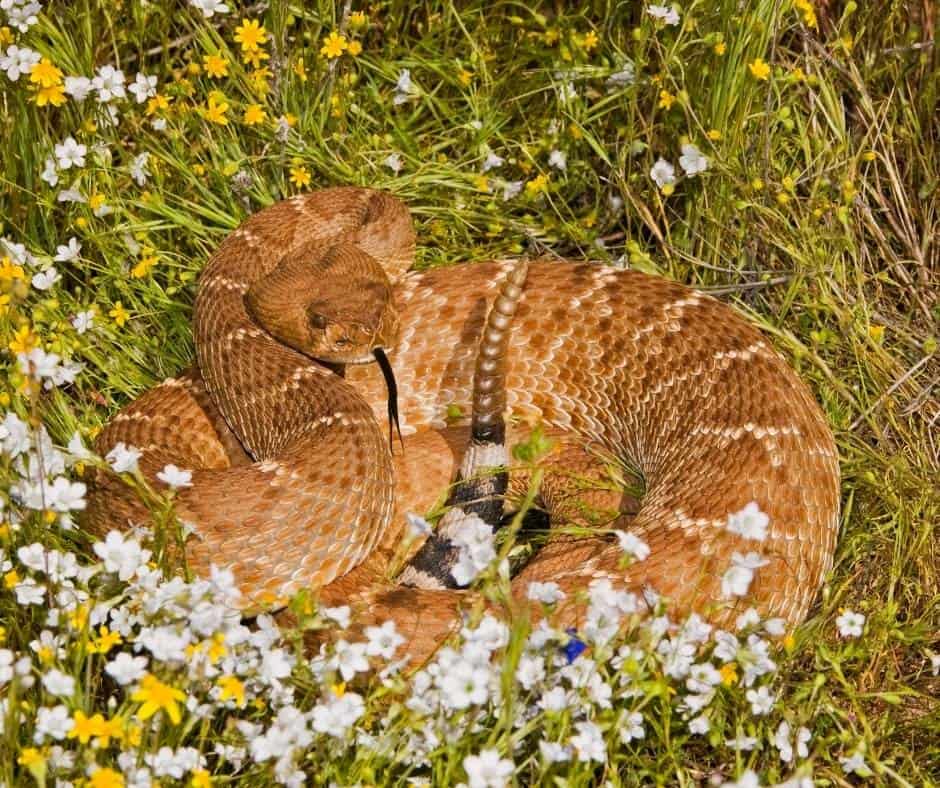
The Red Diamond Rattlesnake is another one of the beautiful venomous snakes in California. It lives in the southernmost reaches of the state, mostly in coastal areas, chaparral, and rocky, scrubby mountain areas in San Diego County, Orange County, and western Riverside County.
It is easiest to identify this snake because of its rusty or ruddy red coloring. The snake’s body does have a faint diamond pattern and the black and white rings near the rattle that are common among many rattlesnakes in Southern California.
The Red Diamond Rattlesnake is 2-5 feet long and has those trademark rattlesnake pits on the sides of their triangular heads used to detect heat and identify prey. They eat small mammals, lizards, and birds .
Fun fact: A rattlesnake shakes its rattle 60 time per second. That’s fast!
7. Mojave Desert Sidewinder
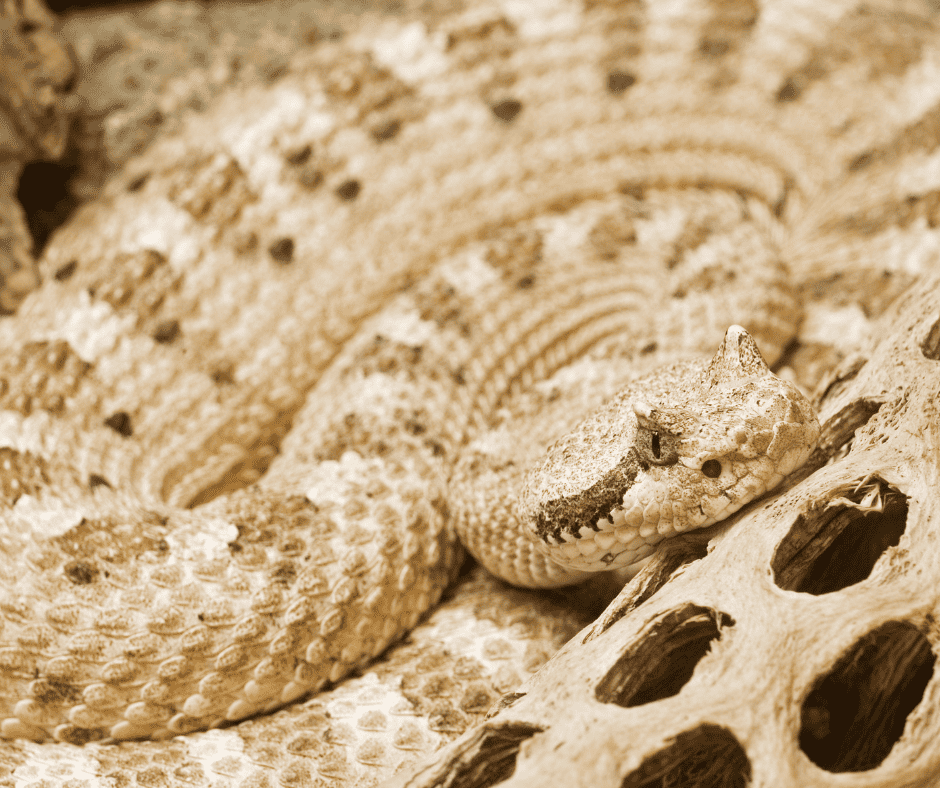
The Mojave Desert Sidewinder or Horned Rattlesnake, is a venomous snake species found primarily in the Mojave Desert in California. Their venom is not considered highly dangerous to humans, and bites are relatively rare. However, if you are bitten, you should still definitely seek medical attention.
The Mojave Desert Sidewinder has a distinctive horn-like projection above each eye, which gives it a unique appearance. The body coloration varies but often includes shades of tan, brown, or gray, allowing the snake to blend in with its desert surroundings and is typically 2-3 feet long.
One of the most remarkable adaptations of sidewinders is their unique mode of locomotion known as sidewinding. Rather than slithering in a typical serpentine fashion, the sidewinder moves by utilizing a lateral series of sideways loops, with only a few points of its body in contact with the ground at any given time. This specialized movement helps the snake navigate loose sandy terrain efficiently.
Sidewinders are pit vipers and use their heat-sensitive pits located between its nostrils and eyes to detect and accurately locate warm-blooded prey, such as small mammals, even in complete darkness or buried beneath the sand. Sidewinders are primarily nocturnal, being most active during the cooler hours of the evening and night.
8. Colorado Desert Sidewinder
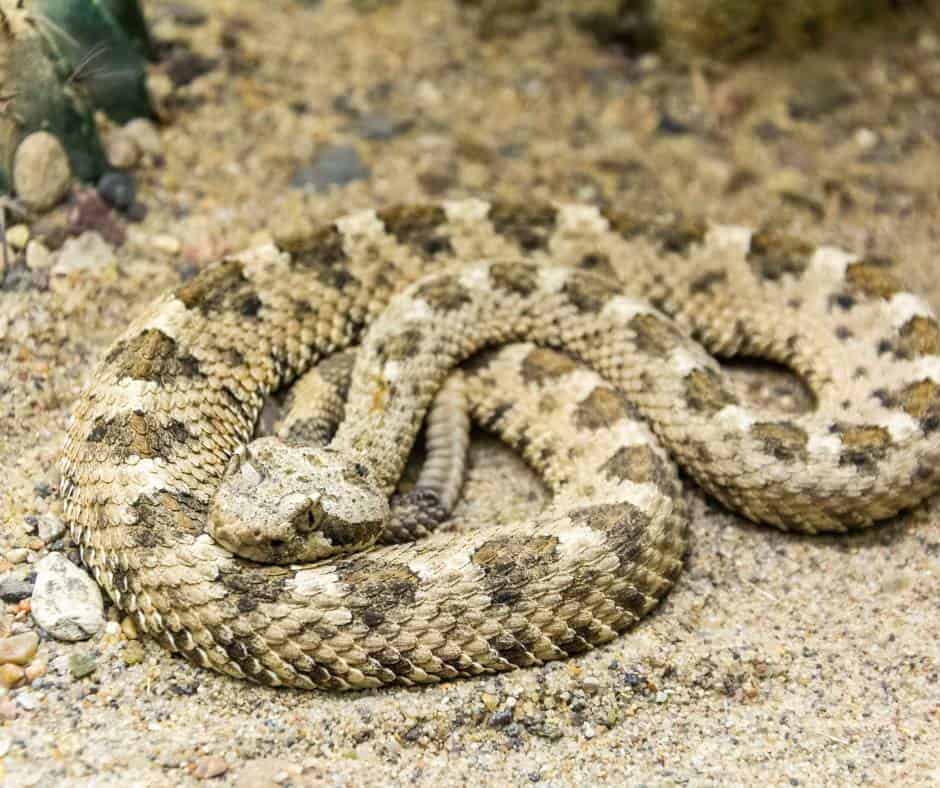
The Colorado Desert Sidewinder is a sidewinder subspecies that is primarily found in the Colorado Desert of California which is in Riverside and Imperial County.
Sidewinders have a distinctive appearance with a relatively small and slender body, typically measuring 1.5 to 2.5 feet in length. They have light tan to pale brown coloration, often with darker brown or reddish-brown patches or crossbands on their back. Their most notable features are the horn-like scales above each eye.
Colorado Sidewinders are well-adapted to desert environments. Their name comes from their unique method of locomotion, where they move by a sidewinding motion. This movement pattern helps them navigate loose sand while minimizing body contact with the hot surface. Their scales are also specialized to enhance traction in sandy environments.
Sidewinders are primarily nocturnal, preferring to be active during the cooler hours of the evening and night. They spend much of their time buried in the sand during the day, seeking refuge from the intense desert heat.
9. Panamint Rattlesnake

The Panamint Rattlesnake is a rattlesnake found in the Panamint Mountains of Death Valley National Park. It lives on rocky slopes as well as the canyons and shrublands of this arid desert range.
This rattlesnake has a slender body with a distinct diamond-shaped pattern along the back. The coloration of the snake varies, but it typically has a gray or brownish background color with dark brown or black blotches bordered by lighter edges. Adults are usually 3 to 4 feet in length.
Like all rattlesnakes, the Panamint Rattlesnake has a rattle at the end of its tail which is used to give a warning as a mechanism of defense. They are primarily nocturnal and secretive, spending much of their time hidden under rocks or in crevices during the day. These ambush predators feed on small mammals, lizards, birds, and even other snakes.
The Panamint Rattlesnake is considered a species of conservation concern due to its restricted range and habitat fragmentation. It is protected under California state law, and efforts are being made to conserve its habitat and monitor its populations.
10. Lyresnake
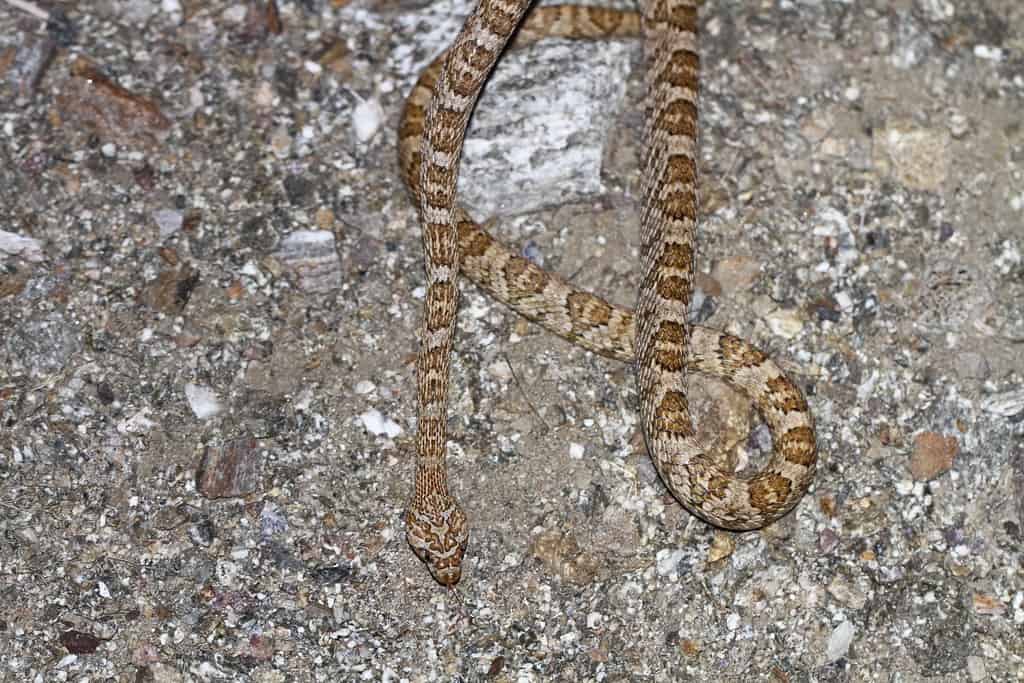
The Lyre Snake is a variety of venomous snake that lives in California. Thankfully, the venom of this snake is not nearly as dangerous of those previously listed in the this guide. It may cause some irritation to humans and large animals, but isn’t truly dangerous.
There are two species of Lyre Snake that call California home. The California Lyre Snake is by far the most common. It lives throughout much of Southern California, other than the desert regions west of the LA Metro area and most of Imperial County. The other variety is the Sonoran Lyre Snake which lives in far eastern San Bernadino, Riverside, and Imperial counties.
These snakes generally live in rocky areas like deserts and chaparral hillsides. They are good at climbing in and around rocks and their coloration makes for excellent camouflage.
The color of these snakes’ bodies (which are 2-3 feet in length) usually matches the rocks of their habitat, which are usually shades of tan or brown. They have large, irregular shaped splotches on their backs and smaller version of those splotches on their sides. The splotches are darker than the body. The Sonoran Lyre Snake has fewer splotches than California Lyre Snake and their splotches tend to be further spaced apart.
They have a v-shaped marking on the top of their heads, aka: a lyre and the pupils of the Lyre Snake are vertical.
Lyre Snakes are nocturnal and mostly eat lizards, but they will also eat small snakes and mammals. They will also eat birds and bats. The tend to camouflage themselves in the rock and sneak up and ambush their prey.
11. Ring-necked Snake
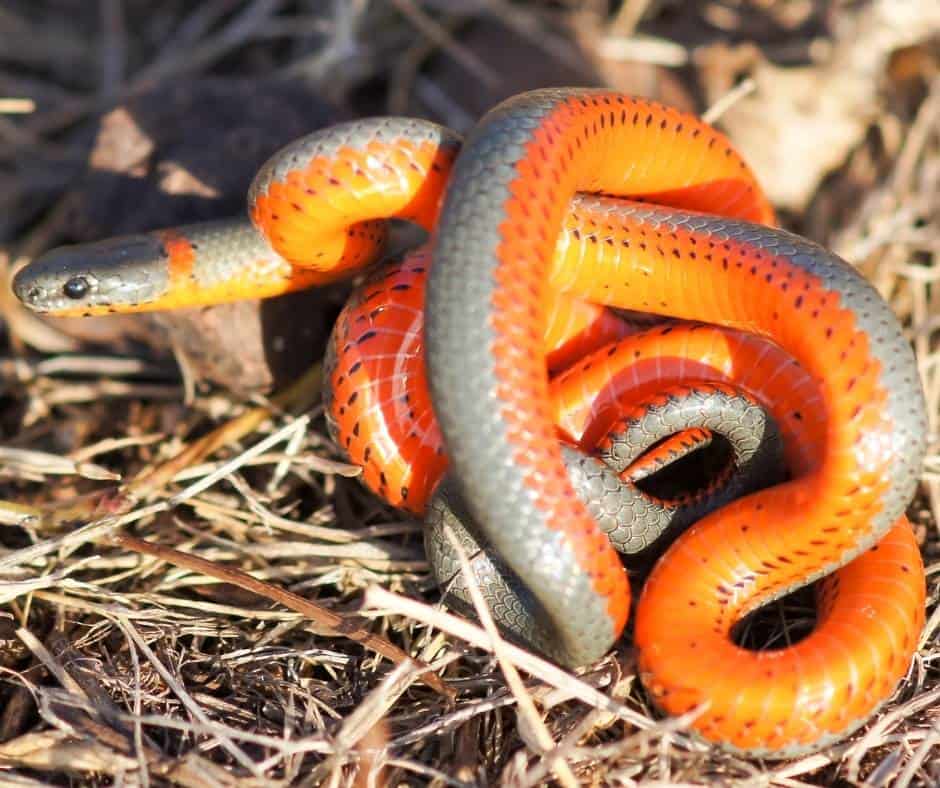
The Ring-necked Snake is mildly venomous, but the good new is that the venom does not pose a threat to humans. In the rare event of a bite from a Ring-necked snake, it may cause a slight irritation or localized reaction, but it is generally harmless and does not require medical attention.
They tend to be shades of gray, from olive to charcoal, and have a distinctive orange or yellow band on the back of their necks. They are bright orange underneath, and will flip their tail up to show you their underside if they feel threatened.
There are four subspecies of Ring-necked Snake in California:
The Monterey Ring-necked Snake lives in Santa Barbara County and up the Central Coast.
The San Bernardino Ring-necked Snake can be found in the LA Metro area (minus the Antelope Valley) frmo Ventura County south to Orange County.
The San Diego Ring-necked Snake lives in San Diego County.
The Sierra Ring-necked Snake lives in montane habitats within the Sierra Nevadas, including forests, meadows, and rocky areas.
Ring-necked Snakes are small, only about pencil width, and just 10-16 inches in length. They live in moist habitats like woodlands, irrigated farmland, grasslands, riparain areas, or rocky hillsides. These are shy snakes that generally hide under things and you are most likely to find them by lifting up rocks or logs, or out around dusk.
They like to eat amphibians like salamanders, small frogs, and tadpoles. They will also eat slugs, worms, and tiny snakes and lizards.
12. Nightsnake

Nightsnakes are another species of snake that is mildly venomous, but the venom is not dangerous to humans. The snake’s venom is primarily used for subduing its small prey, and typically result in only mild symptoms such as slight pain and localized swelling on humans.
There are three subspecies of the Nightsnake in California:
The California Nightsnake lives along the Central Coast, Sierra Nevada Foothills, and the mountains north and west of the Sacramento Valley,
The Desert Nightsnake is in Mojave and Colorado river regions of the state as well as the arid regions in the far northeastern corner of the state.
The San Diego Nightsnake lives mainly in Ventura County, LA Metro, and San Diego Metro regions that aren’t desert.
These snakes are common to chaparral and deserts, grasslands and sagebrush, and even backyards! They like to hide under rocks or pieces of wood during the day. At night they hunt for lizards, frogs, salamanders, and small mice. They inject their mild venom by chewing.
Nightsnakes can look like rattlesnake, but they are much smaller (10-16 inches), don’t have rattles, and are nocturnal. They also have flat, triangular heads. Nightsnakes can also be mistaken for Gopher Snakes but again, they are much smaller. Also they have vertical pupils whereas the Gopher Snake has round pupils.
Their base color tends to match their environment which is usually anywhere for cream to light brown or gray. They have big brown or gray splotches down their backs and small splotches on their sides. They have bigger, darker blotches on their necks and their heads that match their base color.
Tips on How to Minimize Your Risk of Snake Bites While Exploring California

I love to hike and explore the more wild portion of our state, but encounters with wildlife are inevitable. I have seen rattlesnakes while hiking many times but have never come close to a bite because I follow some common sense tips. Here they are:
- Wear appropriate footwear: When hiking or exploring in snake-prone areas, especially during the spring and fall when they are most active, wear closed-toe shoes or boots to protect your feet and ankles. This is the place you are most likely to get bit, especially if you accidentally step on a snake.
- Stay on designated paths: Avoid walking through tall grass, dense vegetation, or rocky areas where snakes may be hiding.
- Watch where you are going: We call my daughter the “snake finder” because she always has her eyes on the ground ahead of her on the trail. She has saved more than one oblivious hiker from an unnecessary encounter.
- Avoid reaching into concealed areas: I feel like this should go without saying but I will say it- don’t stick your hands into holes in the ground or piles of rocks where snakes might be resting. If you want to lift a log or rock, use a tool or stick to gently probe before lifting it up.
- Avoid surprising snakes: Make noise while walking, especially in areas with limited visibility, to alert snakes of your presence and give them a chance to move away.
- Use a flashlight at night: If you’re exploring at night, use a flashlight or headlamp to illuminate your surroundings and watch for any snake movement. Many snakes are nocturnal.
- Keep a safe distance if you see a snake: If you encounter a snake, give it a wide berth and maintain a safe distance. Most snakes will try to retreat and avoid confrontation if they feel threatened. And for goodness snake, don’t try to touch or pick up the snake!
If You Get Bit by a Venomous Snake in California
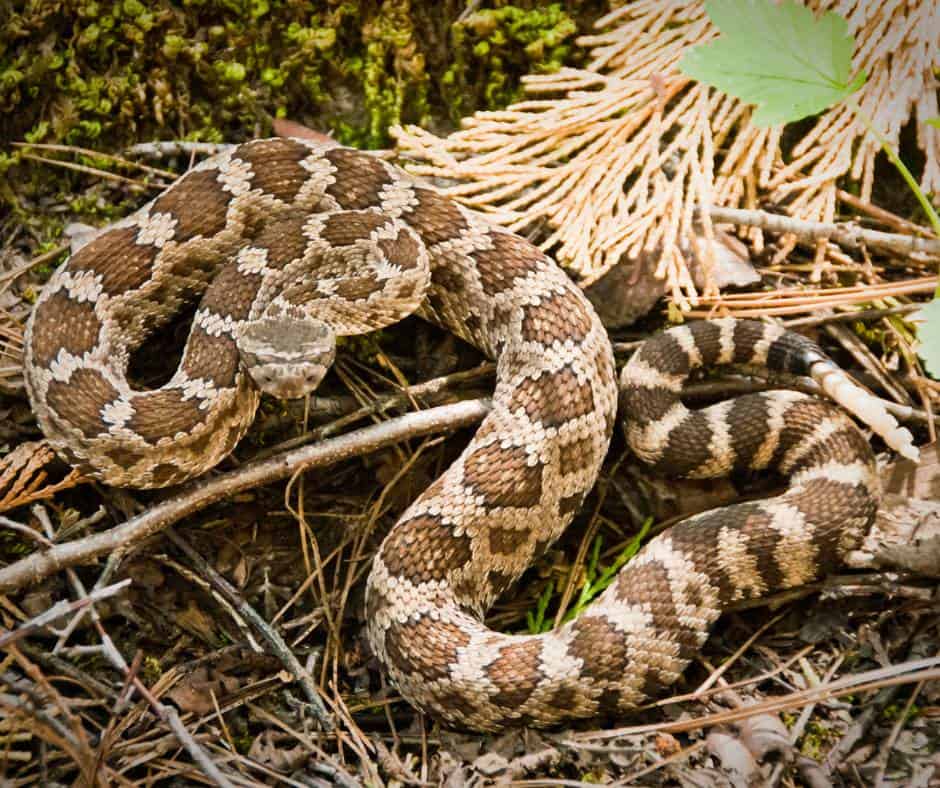
If you get bitten by a rattlesnake, it is important to seek medical attention immediately. Follow these tips and try to get to a hospital as soon as possible:
- Stay Calm: Keep the affected area as still as possible. Movement can spread the venom more quickly through the body.
- Call for help: Call 911 or have someone call for help immediately. Describe the situation and let them know that it is a snakebite.
- Remove tight clothing or jewelry near the bite: Swelling may occur, and it’s important to prevent constriction if possible.
- Keep the bite below heart level: If possible, position the affected limb below the level of your heart to slow the spread of venom. This can help reduce the rate at which venom circulates through the body.
- Do not apply a tourniquet: A tourniquet can worsen tissue damage and restrict blood flow, potentially causing further harm.
- Do not ice the wound: Cold applications are generally not recommended as they can worsen tissue damage.
- Do not attempt to suck out the venom: You have probably seen this happen in Old Westerns but it isn’t a good idea. It is ineffective and can introduce bacteria into the wound.
:
]]>Birds of prey are a group of birds characterized by their predatory behavior and specialized adaptations for hunting. They are known for their exceptional eyesight, sharp talons, hooked beaks, and powerful flight capabilities, which enable them to efficiently capture and subdue their prey.
Birds of prey play important ecological roles as top predators in their ecosystems. They help regulate prey populations and maintain the overall balance of their habitats. They occupy diverse habitats in California, ranging from forests and grasslands to deserts and coastal areas. These birds exhibit a wide range of sizes, shapes, and hunting techniques.
Some common examples of birds of prey include eagles, hawks, falcons, owls, vultures, and harriers. These birds exhibit a wide range of sizes, shapes, and hunting techniques. They occupy diverse habitats in California, ranging from forests and grasslands to deserts and coastal areas.
34 California Birds of Prey You Might See in the Golden State
Eagles That Live in California
1. Bald Eagle
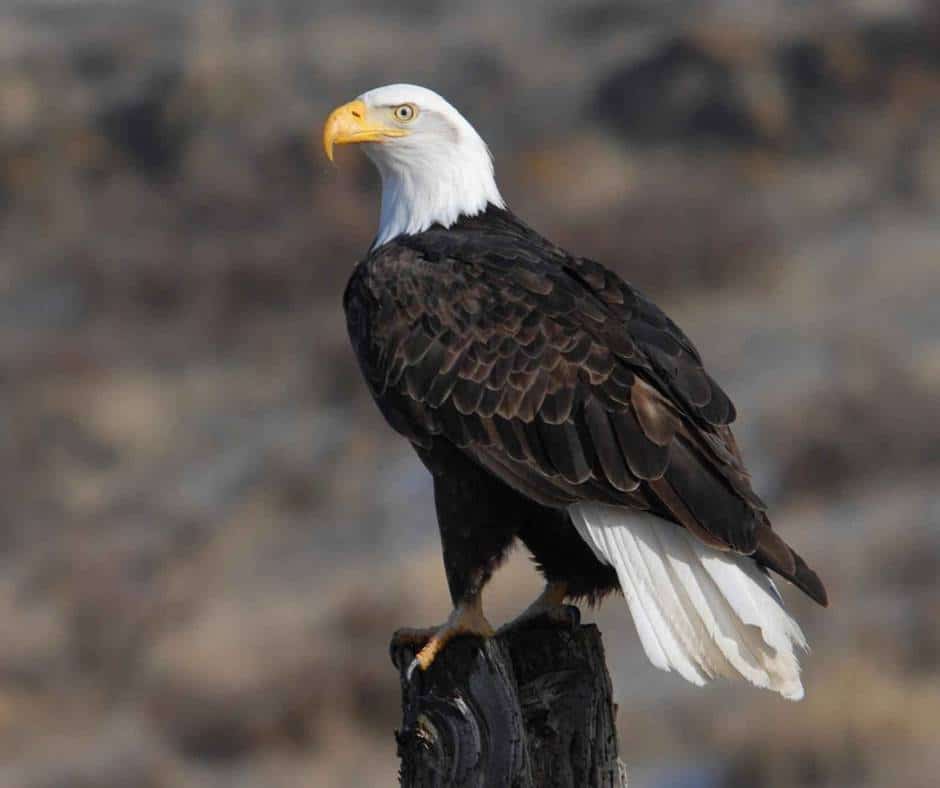
Conservation Status of this California Bird of Prey: Thanks to conservation efforts, the Bald Eagle is now a species of least concern. While the Bald Eagle has a stable population, The Bald and Golden Eagle Protection Act of 1940, prohibits anyone from “taking” bald eagles, including their parts (including feathers), nests, or eggs.
Where in California can I see bald eagles?
According to the California Depatment of Fish and Wildlife, “Bald Eagles are found 41 of the State’s 58 counties,” and, “about half of the State’s wintering bald eagles are found in the Klamath Basin along the California-Oregon border, the location of the largest winter concentration of Bald Eagles in the lower 48 states.”
In all, there are about 1,000 Bald Eagles in California. Some are year round residents but most are only in California through winter. Peak time for spotting Bald Eagles is November through March when they are breeding and hatching new fledglings.
In Northern California, in addition to the Klamath Basin, Bald Eagles are also commonly seen at Shasta Lake and Lake Almanor, thanks to the lakes’ abundant fish populations which attract the eagles. They are also spotted sometimes at Mono Lake on the eastern side of the Sierras.
Bald Eagles have made a comeback in the San Francisco Bay Area in recent years. They can be observed in locations such as Lake Chabot in Castro Valley, Lake Berryessa in Napa County, and Crystal Springs Reservoir in San Mateo County.
In Southern California they are seen most often at Lake Perris, Lake Hemet, Lake Arrowhead, and Catalina Island. There is also a rather famous pair of Bald Eagles that live in Big Bear Lake which have a live bald eagle webcam dedicated to them. The Catalina Island pair has a live cam as well.
Bald Eagle Description and Identification Tips
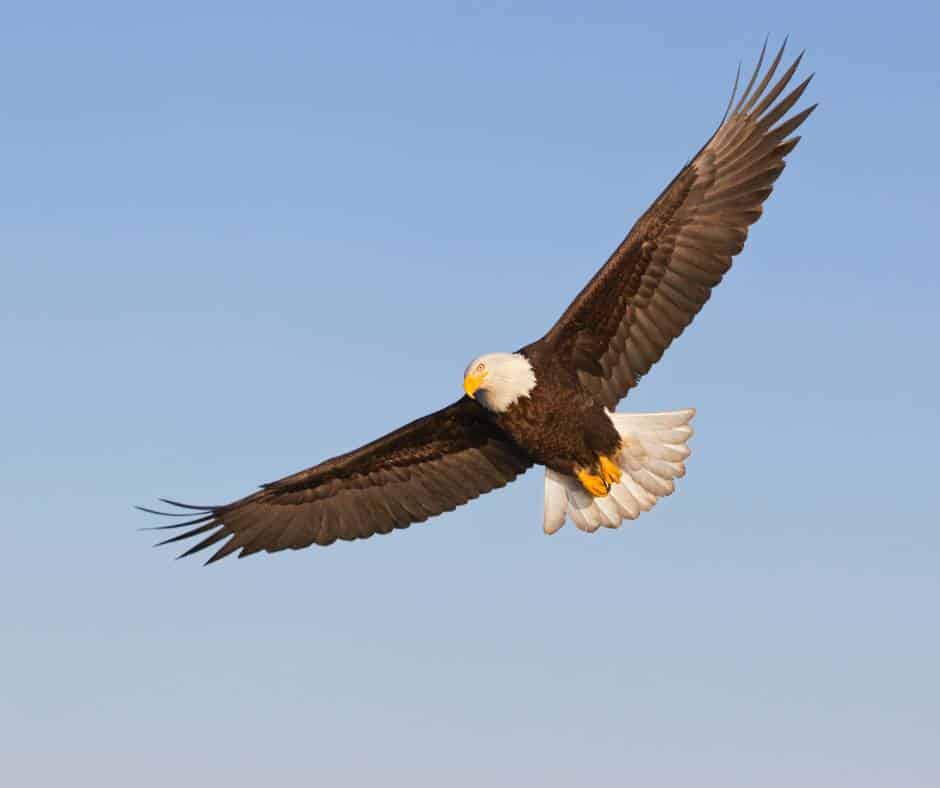
Adult Bald Eagles have a distinctive white head and tail, contrasting with their dark brown body. They have a wingspan of around 6-7 feet and can weigh between 8-14 pounds.
Bald Eagles are primarily fish-eaters and have a diet that consists mainly of fish such as salmon, trout, and herring. However, they are opportunistic hunters and will also feed on small mammals, birds, and carrion. They have powerful talons and sharp beaks to catch and tear their prey.
They prefer to live near large bodies of water such as rivers, lakes, coastal areas, and marshes. Bald Eagles build large nests called “aeries” in tall trees near water bodies. Bald Eagles are monogamous and typically mate for life.
Bald Eagles eggs take 35 days to hatch. Hatchlings learn to fly at around three months of age and fledge about four weeks after that. They reach full maturity at 4-5 years old and typically have a lifespan of 15-25 years in the wild.
Fun Fact: The Bald Eagle was chosen as the national bird and emblem of the United States in 1782 (despite Benjamin Franklin’s lobbying for the turkey). The Bald Eagle appears on the Great Seal of the United States and is widely depicted in American art, currency, and government insignia.
2. Golden Eagle
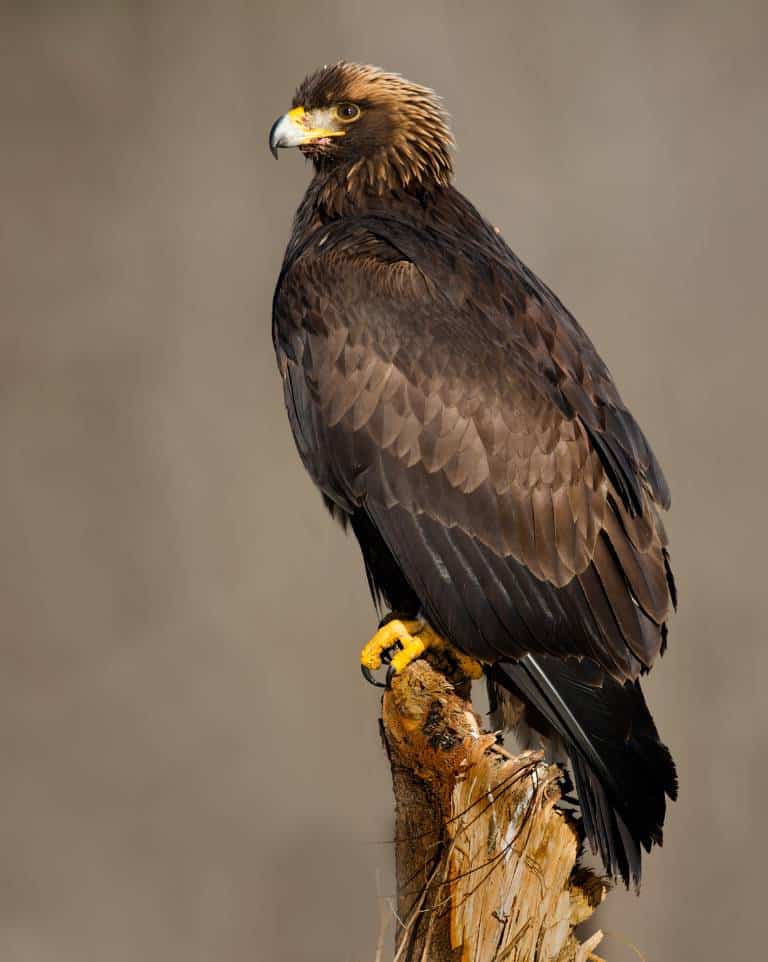
Conservation Status of this California Bird of Prey: While the Golden Eagle has a stable population and is a species of least concern, The Bald and Golden Eagle Protection Act of 1940 prohibits anyone from “taking” golden eagles, including their parts (including feathers), nests, or eggs.
Where in California can I see Golden Eagles?
Golden Eagles can be found up and down the state, but the Bay Area has the largest population of Golden Eagles in the world. There are more breeding pairs around Mount Diablo and the surrounding hillsides than anywhere else.
Unfortunately, wind turbines in the area have had a harmful impact on these majestic birds of prey. According to the California Audubon Society, “Thousands of Eagles have been maimed, injured, and killed by the turbines used to generate wind energy, particularly in Altamont Pass.”
Most Golden Eagles that live in California are year-round residents, but there are some than migrate into California for the winter. In addition to the large Bay Area population, Golden Eagles can be found in forests, canyons, grasslands, and oak woodlands throughout the state. They aren’t seen much in the Central Valley.
Did you know? Golden Eagles started breeding on the Channel Islands thanks to a population of feral pigs, deeer, and endemic Channel Islands fox that provided an easy food source. The result was a catostrophic decline in the fox population, bringing them close to extinction.
The National Park Service made the decision to live trap and relocate the Golden Eagles from 1999-2006. 44 Golden Eagles, including 10 eaglets born on the islands, were trapped and relocated. None have returned and as a result, the fox population has rebounded.
Golden Eagle Description and Identification Tips

Golden Eagles are one of the largest birds of prey in North America. They have a wingspan of about 6 to 7.5 feet and can weigh between 7 to 15 pounds . Adults have dark brown feathers on their body and wings, with a golden-colored head and neck.
Golden Eagles primarily feed on small to medium-sized mammals, such as rabbits, ground squirrels, and marmots. They are also known to prey on birds, including waterfowl and even larger species like cranes and swans. Occasionally, they may scavenge on carrion or even capture larger prey such as deer or sheep.
Golden Eagles are skilled hunters and use their sharp talons and powerful beaks to catch and kill their prey. They are known for their incredible speed and agility in flight, often soaring high in the sky and then diving swiftly to catch their prey.
They are solitary birds, except during the breeding season when pairs come together to raise their young. They do mate for life.
Golden Eagles are known for building huge nests. They are typically 5-6 feet wide and about about three feet deep. They are most often found on cliffs can but also be built on trees, windmills, and even transmission towers. They are not usually city dwellers and stick to more wild spaces with lots of prey.
Female Golden Eagles will lay 1-3 eggs with an incubation period of about 45 days. Eaglets fledge about 7-10 weeks after hatching and juveniles become independent of their parents about 80 days after fledging. They reach maturity at four years of age and generally live 25-30 years.
Vultures That Live in California
3. Turkey Vulture

Conservation Status of this California Bird of Prey: Turkey Vultures are the most widespread vulture in North America and are a species of least concern.
Where in California can I see Turkey Vultures?
Turkey Vultures are the most common bird of prey in California and are found all throughout the state in all sorts of environments such as forests, grasslands, deserts, suburban, and even urban areas. They will basically be found everywhere throughout the state except for the highest elevations.
I live in Orange County and see Turkey Vultures nearly every day. As a matter of fact, we have a large flock that roosts in the wildlands in between two housing developments nearby. They love to circle in the air currents, looking for carrion.
Turkey Vulture Description and Identification Tips
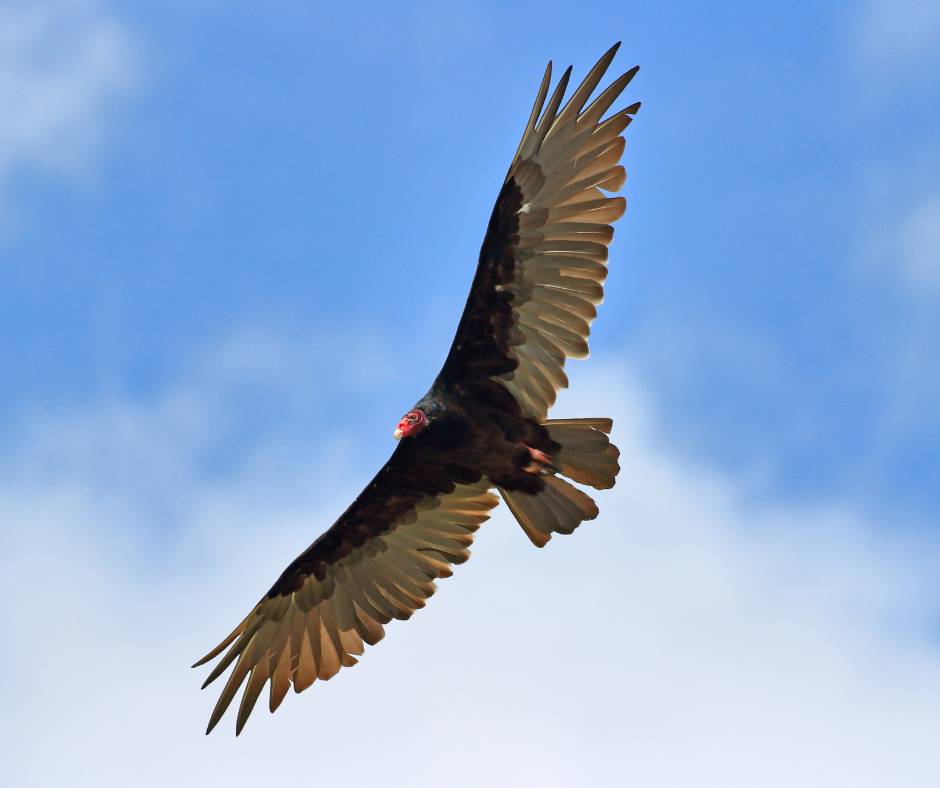
Turkey Vultures have a unique appearance with a bald, red head, a long, hooked beak, and a dark brown to black plumage. They have a wingspan of about 5.5 to 6.5 feet and weigh around 4 to 5 pounds.
They are easy to identify in the air thanks to their light plummage (typically light gray) which forms a “v” from the tips of their wings to their tail. This contrasts with the remaining plummage which is dark brown to black. In flight, their wings form a V-shape and they have a wobbly, rocking motion as they soar.
Turkey Vultures are often seen soaring high in the sky, using thermals (rising columns of warm air) to gain altitude. They have excellent flying abilities and can cover long distances during their flights. When on the ground, they walk with a wobbly, unsteady gait.
Turkey Vultures are primarily scavengers, feeding on carrion (dead animals). They have a highly developed sense of smell, which helps them locate dead animals from a distance. They are not equipped for killing or tearing apart prey like other raptors, but instead rely on their keen sense of smell to locate and feed on decaying carcasses.
Turkey Vultures do not build nests. Instead, they lay their eggs on the ground in caves, hollow logs, or other sheltered locations. They typically lay one to three eggs, which are incubated by both parents. They take about five weeks to hatch.
Babies take about 12 weeks to become fully independent and juveniles take two years to become fully mature. Turkey Vultures live up to 20 years in the wild.
Fun Fact: Turkey Vultures have some pretty gross habits (besides eating decaying animals). One of their main methods of self defense is vomitting their food at an animal that is disturbing it, sending their vomit up to 10 feet in the nuisance’s direction.
Their other gross habit involves them defecating on their feet. They do this for two reasons. First, it cools off their feet in hot weather and second, the digestive juices in their stomach kill bacteria so their feces can act as an antiseptic.
4. California Condor
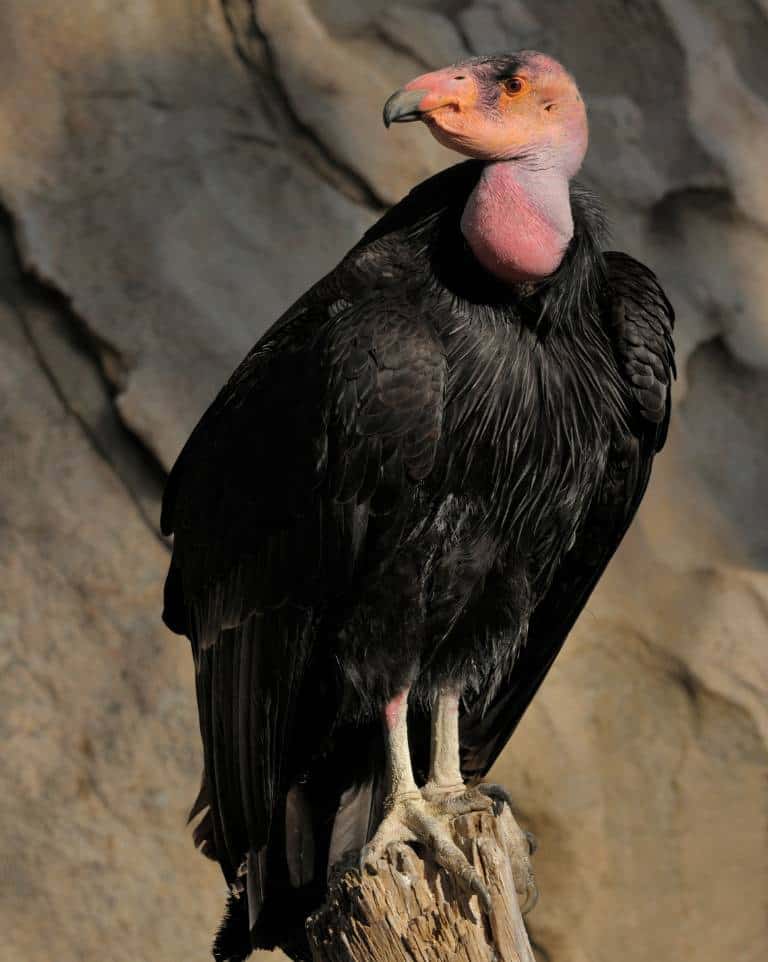
Conservation Status of this California Bird of Prey: The California Condor is Critically Endangered and has been protected as an endangered species by federal law since 1967 and California state law since 1971. At that time, there were only a few dozen condors left in the wild.
In the 1980s, their population reached a low point of only 27 individuals. Through intensive conservation efforts, in large part by the San Diego and Los Angeles Zoos, their population has slowly increased. As of 2022, there were over 561 California Condors.
Where in California can I see California Condors?
The historic range of the California Condor extended across much of North America. However, due to habitat loss, hunting, and poisoning (DDT caused egg shells to be brittle and crack easily and digestion of bullets in animal carcasses resulted in lead poisoning), their population dramatically declined. By the 1970s and 80s, they were only found in a small area of Southern California.
Conservation efforts, including captive breeding and reintroduction programs, have expanded their range, and they can now be found in parts of California, Arizona, Utah, and Baja California, Mexico.
The Southern California Flock at the Hopper Mountain Refuge was established in 1995 and there are 89 birds. The Central California Flock at Pinnacles National Park was introduced in 1997 and there are 94 birds today.
A new Pacific Northwest flock was established in 2022 with eight individuals at Redwood National Park. It is a collaborative effort many decades in the making and the Yurok Tribe has been a large reason for the selection of this particular area for introduction.
California Condor Description and Identification Tips

California Condors are one of the largest flying birds in North America. They have a wingspan of up to 9.8 feet and can weigh up to 26 pounds. They have black feathers with white markings under the wings, and their bare head and neck are pinkish-orange.
California Condors are scavengers and primarily feed on carrion. They rely on their excellent eyesight to locate carcasses from the air. They feed on a variety of animals, including deer, cattle, and smaller mammals. They play a crucial role in cleaning up the environment by consuming carrion and preventing the spread of diseases.
Like other vultures, California Condors do not build nests. They find cavities in rocky cliffs or in the hollows of large redwood trees. Females only lay one egg per nesting cycle. Eggs hatch in about 55 days. Juveniles fledge about six months after hatching. They don’t have adult coloration until they are five years old. They can live for over 60 years, and impressive age for a bird of prey.
Conservation efforts for the California Condor involve captive breeding programs, habitat protection, and public awareness campaigns. The birds are monitored closely, and some individuals are fitted with radio transmitters to track their movements and health. Reintroduction efforts have focused on releasing condors into suitable habitats and reducing threats such as lead poisoning from ammunition fragments in carrion.
5. Black Vulture

Conservation Status of this California Bird of Prey: Black Vultures are considered a species of least concern.
Where in California can I see Black Vultures?
Black Vultures do not breed in California. Instead there are vagrants that seem to be leaving the Arizona population for points north. They have been spotted as far north as Sonoma County in Bolinas, but are mostly seen in California closer to the border. Sometime young Turkey Vultures can be mistaken for Black Vultures.
Black Vulture Description and Identification Tips
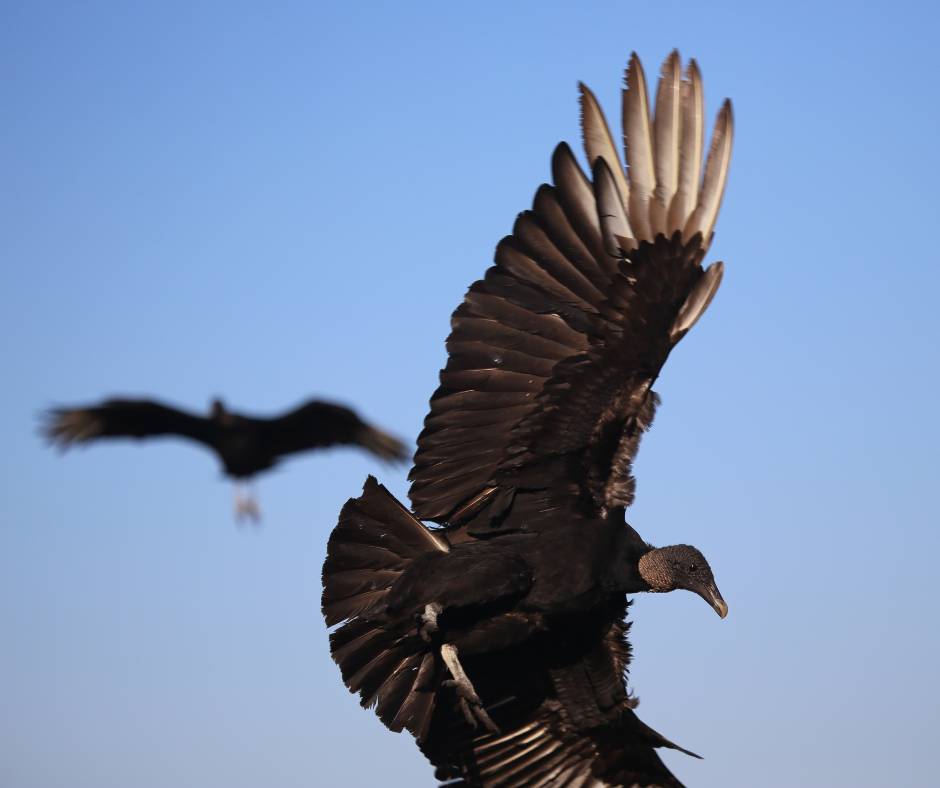
Black Vultures are medium-sized birds with a wingspan of about 4-5 feet and a body length of around two feet. They have black feathers all over their body, including their head and neck. Their legs and feet are grayish-black in color. Unlike other vultures, black vultures have a short, hooked beak.
Black Vultures can be found in a variety of habitats, including forests, open woodlands, grasslands, and urban areas. They are adaptable and can be seen in both rural and urban environments.
Black Vultures are scavengers, feeding primarily on carrion. They have a keen sense of smell and can locate carrion from long distances. They often gather in groups and compete with other scavengers, such as turkey vultures, for food. Flocks can have hundreds of individuals, especially near garbage dumps.
Fun fact: Black Vultures don’t have voice boxes! They will, however, hiss and grunt when bothered.
Hawks That Live in California
6. Red-Tailed Hawk

Conservation Status of this California Bird of Prey: Red-tailed Hawks are considered a species of least concern.
Where in California can I see Red-tailed Hawks?
Red-tailed Hawks are widely distributed across the state and certainly the most commonly spotted hawk in California. They can be seen from the coastline to the desert, and in both wild and urban areas.
The vast agricultural landscapes of the Central Valley provide excellent hunting grounds for Red-tailed Hawks. Look for them perched on fence posts or soaring in the sky.
Along the coastlines of California look for them in areas with cliffs, bluffs, or open fields near the ocean. Red-tailed Hawks can be also found in forested areas throughout the state. They can be spotted soaring above the tree canopy or perched on treetops.
Red-tailed Hawks are adaptable and are often spotted in urban and suburban environments. Look for them perched on light posts, buildings, or in tree-lined neighborhoods. We have a dark morph Red-tailed Hawk that I see in our neighborhood regularly. I usually hear him before I see him soaring above the neighborhood looking for a snack.
Red-Tailed Hawk Description and Identification Tips

Red-tailed Hawks have a wingspan of around 4 to 5 feet and a body length of about 18 to 26 inches. They have broad, rounded wings and a short, wide tail that is often red or reddish-brown, giving them their name. Their plumage can vary but typically includes shades of brown with a pale underbelly and a dark belly band.
Red-tailed Hawks are skilled hunters, primarily feeding on small mammals such as rodents (mice, voles, rabbits), but they also eat birds, reptiles, amphibians, and sometimes carrion. They use their keen eyesight to spot prey from high perches or while soaring, then swoop down to catch it with their sharp talons.
These California birds of prey are known for their impressive aerial displays during courtship, where they engage in thrilling acrobatic flights and aerial courtship rituals. Their loud, high-pitched scream-like calls are often associated with their presence. You can hear them here.
Red-tailed Hawks are solitary birds outside of the breeding season and typically mate for life. They are excellent co-parents and work together to build their nest, incubate the eggs, and raise their young. Red-tailed Hawks tend to lay 2-3 at a time andincubate the eggs for 28-35 days.
Young Red-tailed Hawks stay with their parents for about 10-12 weeks and generally fledge around 45 days. They reach full maturity at 3-4 years of age and live for 10-15 years in the wild.
7. Ferruginous Hawk

Conservation Status of this California Bird of Prey: Ferruginous Hawks are considered threatened. There are currently fewer than 4,000 pairs left on Earth. Their decline is due to hunting and loss of habitat.
Where in California will I find this raptor?
Far less common than the Red-tailed Hawk, the Ferruginous Hawk does use California as a wintering destination. They can be spotted between late September and April in grasslands, sagebrush flats, desert scrub, and low foothills.
They generally prefer open, treeless areas and will roost on a lone tree in the area or even a utility pole. You will not find these raptors in urban areas or heavily treed regions because they do require those wide, open expanses in order to hunt.
The Central Valley offers good habitat for Ferruginous Hawks. Look for them in agricultural areas, grasslands, and open fields. You will also see them in Mojave Desert, Owens Valley east of the Sierra, and Carrizo Plain National Monument which has vast expanses of grassland.
Ferruginous Hawk Description and Identification Tips

Ferruginous Hawks are one of the largest North American hawks, with a wingspan of about 4 to 5 feet and a length of around 22 to 27 inches. They have a robust build with broad wings and a large head.
Their plumage varies depending on the age and geographic location, but adults typically have a rusty or light brown color on their upperparts, while their underparts are pale or white. They have a distinctive white or light-colored throat and a dark belly band. These hawk can be identified in flight by the V that forms as result of their rust legs and white underparts.
They tend to eat small mammals that inhabit grasslands such as rabbits, squirrels, gophers, and mice. They will also eat birds and snakes.
Ferruginous Hawks build large stick nests in trees, shrubs, or on the ground. They may start with an old nest, like a crow’s nest, and then make it much bigger and bulkier with lots of sticks and twigs, as well as cow dung. They often return to their nests year after year, growing them to huge sizes over time.
Fun fact: Back when bison roamed the West, Ferruginous Hawk’s built their nests with sticks and pieces of bison bones, and lined their nests with bison dung!
The female lays around 2-4 eggs, and both parents participate in incubation and raising the young. Ferruginous Hawks co-parent as well, but the mother does most of the nesting and the father does the bulk of the hunting. Eggs hatch after 30-35 days.
The chicks fledge at 45 days and stay a few weeks longer after that to learn to hunt with their parents. The reach full maturity after 3-4 years.
8. Red-Shouldered Hawk

Conservation Status of this California Bird of Prey: Red-shouldered Hawks are considered a species of least concern.
Where in California can I see Red-shouldered Hawks?
The Red-shouldered Hawk is onother one of the more commonly spotted hawks in California. This beautiful bird has a year-round population in the state and can be found in various regions of California, particularly in the central and coastal parts of the state. They prefer habitats with dense woodlands, forests, riparian areas, and wetlands.
It is commonly spotted in riparian woodlands, but it also makes an appearance in residential areas when there is bird feeder attracting song birds that it can easily hunt and eat. It also likes to hang out in eucalyptus groves and oak woodlands.
Red-shouldered Hawks are most commonly spotted in the Santa Monica Mountains, Santa Cruz Mountains, Sierra Nevada foothills, Sacramento Valley, and the coastal areas around San Francisco Bay.
Red-shouldered Hawk Description and Identification Tips

Red-shouldered Hawks are about 17-24 inches long, with a wingspan of approximately 37-43 inches. Generally speaking, they are about the size of a crow and females are larger than males.
These hawks have a distinct reddish-brown coloration on their upper wings and shoulders (no its’s not just a clever name!). They have a barred pattern on their chest and belly, with a white underside. Their tail is marked with dark bands.
In addition to song birds in residential areas, these hawks also eat small mammals (like mice and voles), lizards, and snakes. They hunt from a perch, like a tree, and then swoop down to snag their prey when they spot it.
Red-shouldered Hawks do return to the same nest year after year, so once you have found their “spot”, you can expect to see your new pals again next year. They are monogamous and form long-term pair bonds. They build nests in the forks of large trees using sticks and lined with softer materials such as moss and leaves.
Their nests usually have 3-4 and young hatch after 30-35 days, fledge after six weeks, and stay with their parents for 8-10 weeks longer to get fed and learn how to hunt. They reach full maturity after 2-3 years and live for 10-15 years in the wild.
Explore Southern California with these 20 incredible weekend getaways.
9. Cooper’s Hawk

Conservation Status of this California Bird of Prey: Cooper’s Hawks are considered a species of least concern.
Where in California can I see Cooper’s Hawks?
Cooper’s Hawks are versatile and can be found in a variety of habitats across the state, including forests, woodlands, and suburban areas with ample tree cover. They are particularly fond of edge habitats where they can hunt prey in both open areas and wooded areas.
The Cooper’s Hawk is also a common hawk in urban and suburban areas. While their natural habitat is the forest, they have discovered that they have a taste for doves and pigeons, and they have plenty of both to eat if they stick to where the people are.
If you have a bird feeder, there is a chance that a Cooper’s Hawk might look at it as a smorgasbord, and we aren’t taking about the bird seed! If you do have a hawk that is suddenly using your bird feeder as a hunting ground, remove it for a week and the bird will move on.
Cooper’s Hawk Description and Identification Tips

Cooper’s Hawks have a compact and agile build with rounded wings and a long, rounded tail. Adults have blue-gray upperparts, reddish barring on the chest, and a distinctive black cap on their heads. They have a long tail and shorter wings than a Red-tailed or Red-shouldered Hawk.
Cooper’s Hawks are excellent flyers and move quickly through the air or vegetation to snag their prey. They kill it by squeezing it to death, but they have also been known to drown their prey as well. While they primarily feed on birds, they will also eat small mammals like squirrels and rabbits.
Did you know? Cooper’s Hawks like to eat medium-sized birds, including their own! That’s right, they are cannibals!
A male Cooper’s Hawk is much smaller than a female (they are both around crow size. Males are a small crow, females are a large crow), so it has to be very submissive to the female and send out calls letting her know it is a mate and not food.
Then, the male considers the submission (any thing to make you happy honey, just don’t eat me!) by building the nest and providing all the food for its mate and their young for three months until the young leave the nest.
Cooper’s Hawks are monogamous and typically breed in the spring. They build nests in the dense foliage of trees, usually near the trunk. The female lays 2-6 eggs, which are incubated for about 30-35 days. Both parents participate in feeding the young until they fledge, which occurs around 4-5 weeks after hatching.
10. Sharp-shinned Hawk

Conservation Status of this California Bird of Prey: Sharp-shinned Hawks are a species of least concern.
Where in California can I see Sharp-shinned Hawks?
Sharp-shinned Hawks tend to be winter visitors to California. They can be spotted all across the state in a variety of habitats, including forests, woodlands, and urban areas.
In Northern California look for them at Point Reyes, in the Medocino National Forest, the Sacramento National Wildlife Refuge, and the Lake Tahoe area.
In Central California they are often spotted along the Big Sur coast and in Yosemite National Park. Down south, they are found in desert areas like Joshua Tree National Park and Anza-Borrego Desert State Park as well as destinations close to urban areas like the Santa Monica Mountains and San Diego National Wildlife Refuge.
Sharp-shinned Hawk Description and Identification Tips

Sharp-shinned Hawks look, and in many ways behave, like Cooper’s Hawks, but they are smaller and more secretive.
Like the Cooper’s Hawk, they live in forests but have also adapted to live in urban and suburban areas which are home to lots of songbirds and bird feeders.
So how does one tell a Cooper’s hawk from a Sharp-shinned Hawk? They both have bluish-gray backs, reddish chests, reddish-gold eyes and a blackish-gray cap on their heads. They both have long, banded tails. They are around 10-14 inches in length and has a wingspan of about 20-27 inches.
When in the air, the best identifier is that Sharp-shinned Hawks have square-edged tails while Cooper’s Hawks have rounded tails. If you can see a the hawk perched, take a look at its head. The Sharp-shinned Hawk has a curved head and short neck. The Cooper’s Hawk has a flat head and slightly longer neck.
They are skilled hunters and when the Sharp-shinned Hawk catches their prey, they bang their future meal on a stump or low branch until they die. These hawks tend to eat smaller birds like robins or sparrows, but they will also eat small amphibians and mammals if available.
Sharp-shinned Hawks are monogamous birds and form breeding pairs during the breeding season. Males perform flight displays, which may include swooping, diving, and circular flights to attract the female.
They work together to build the nest and the female lays a clutch of 3 to 5 eggs which are incubated for 28 to 35 days. Young fledge after 25-30 days. They leave their parents after 6-7 weeks and reach full maturity after two years. Sharp-sinned Hawks typically live for 5-10 years in the wild.
11. Northern Goshawk

Conservation Status of this California Bird of Prey: In California, the Northern Goshawk is listed as a Species of Special Concern due to habitat loss and fragmentation.
Where in California can I see Northern Goshawks?
There are about 1,000 breeding pairs in the state of California. Forested regions such as the Sierra Nevada, Shasta-Trinity National Forest, and Lassen National Forest in Northern California are the common locations to see these birds.
In Southern California, the Northern Goshawk is only really seen in the mountains of Los Padres National Forest around Mt. Pinos and Frazier Mountain in northern Ventura County.
Northern Goshawk Description and Identification Tips

The Northern Goshawk is a medium-sized hawk with a stocky build and a broad wingspan of about 40-46 inches. They are fairly easy to identify. Adults have a slate-gray back and wings, a pale gray chest, and a finely barred tail. They have a distinct white eyebrow strip and their eye color is orange to red.
Northern Goshawks are typically found in mature coniferous forests, especially those with dense tree cover. They require a mix of open spaces for hunting and closed canopy areas for nesting.
Northern Goshawks are sit-and-wait predators. They will sit on a treetop and patiently wait until they spot prey like squirrels, woodpeckers, rabbits, or even small birds of prey.
They do breed in monogamous pairs and have huge territories of 2,000-8,000 acres. They build large stick nests high up in trees, usually near the trunk. The female lays 2-4 eggs, and both parents participate in incubation and raising the young.
Goshawks leave the nest after 35-40 days, however they may still rely on their parents for food and guidance for some time after leaving the nest. They reach maturity after 2-3 years and live 10-15 years.
12. Northern Harrier

Conservation Status of this California Bird of Prey: Since heir population is declining, the Northern Harriers is considered a Species of Special Concern in California.
Where in California can I see Northern Harriers?
Northern Harriers can be found in marshes, wetlands, grasslands, agricultural fields, and coastal areas. They prefer open areas with low vegetation where they can hunt effectively.
You are most likely to see this bird in the rice fields or salt water marshes of Northern and Central California. There is a larger winter population but there are some birds that live in the western portion of the state year round.
In Southern California, they have been spotted in marshy areas like the Newport Beach Back Bay, especially during the winter.
Northern Harrier Description and Identification Tips

Northern Harriers have a distinctive appearance. Adult males have a gray body with a white rump and a pale belly. Adult females and immature birds have a brown body with streaks and a more mottled appearance. Both sexes have a white patch near their rump which is a main identifier of this hawk in flight.
These birds are small and light, but their long wings and tails make them appear larger, around the size of a crow. As with nearly all hawks, the females are significantly larger than the males. Harriers fly with their wings higher than their bodies in a v-shape.
Northern Harriers hunt by sound and have a heart-shape facial disk that helps them locate their prey, just like owls. They mainly eat small mammals and birds that live in the marshy areas like mice, voles, and even small ducks.
They fly low over open fields, marshes, and grasslands, using their keen eyesight and hearing to detect small mammals, birds, and other prey. They have a distinctive hovering behavior called “sky-dancing,” where they fly in slow circles or hover in mid-air before diving down to catch their prey.
Northern Harriers are monogamous. The female builds a nest on the ground or in low vegetation, using grasses and other plant materials. They lay 4-6 eggs, and both parents take turns incubating them for about a month. After hatching, the young birds stay in the nest for a few weeks before they start flying at about 30-35 days.
After fledging, the young Northern Harriers still rely on their parents for food and guidance for some time until they become fully independent. These birds reach full maturity after two years and typically live for 10 years.
13. White-Tailed Kite

Conservation Status of this California Bird of Prey: The White-tailed Kite is considered a species of least concern but it is fully protected under California law.
Where in California can I see White-tailed Kites?
The largest population of White-tailed Kites in North America is found in California, mainly in the grassy lowlands west of the desert.
They like farmland, wetlands, and open grasslands. They prefer areas with nearby perches, such as trees, power lines, or fence posts, from where they can hunt.
They will roost in trees on the edges of these more open areas. When they aren’t breeding, you can often find White-tailed Kites roosting together in great numbers, sometimes up to 100 birds will hang out together in a small cluster of trees!
Look for white-tailed kites in the Sacramento Valley, San Joaquin Valley, San Francisco Bay Area, Central Coast, and Southern California. You may find them soaring in the air or perched on elevated spots like utility poles, dead trees, or fence posts.
White-tailed Kite Description and Identification Tips

The White-tailed Kite is a small to medium-sized bird of prey with a distinctive appearance. It has a slender body, long wings, and a white head and underparts. The upperparts are gray, and the tail is white (hence the name) with a black band near the end. Eyes are generally orange or red.
This bird eats mostly mice, voles, and gophers, and hunts by hovering above the ground with its wings flapping and its head tipped down. This behavior is called “kiting”. When it sees movement of a mouse or vole on the ground, it then darts down to grab it.
White-tailed Kites are monogamous and form pairs that last for multiple breeding seasons. They build nests made of sticks in tall trees, shrubs, or sometimes on man-made structures like telephone poles. The female typically lays 3-4 eggs, which both parents take turns incubating. The chicks hatch after about a month, and both parents participate in raising and feeding them.
White-tailed Kites typically fledge after about 4-5 weeks. After fledging, they continue to be dependent on their parents for several more weeks as they learn to hunt and become proficient flyers. They reach maturity after one year and live for 5-10 years.
14. Swainson’s Hawk

Conservation Status of this California Bird of Prey: Swainson’s Hawks are considered a species of least concern.
Where in California can I see Swainson’s Hawks?
Swainson’s Hawks are migratory birds, spending their breeding season in North America and migrating to South America for the winter. During the breeding season, they can be found in a variety of habitats across the western portion of California, including grasslands, prairies, agricultural fields, and open woodlands.
Swainson’s Hawks are commonly found in the agricultural areas of the Central Valley, including the Sacramento Valley and San Joaquin Valley. They are known to nest in trees and utility poles in these areas. They are also seen in Tule Lake National Wildlife Refuge near the Oregon border.
In Southern California, you will Swainson’s Hawks at Carrizo Plain as well as many other coastal and inland destinations as theey migrate through the area.
Swainson’s Hawk Description and Identification Tips

Swainson’s Hawks are medium-sized birds with a wingspan ranging from 4 to 4.5 feet and typically weigh between 1.2 to 2.2 pounds. They have long, slim wings and a relatively small head. Adults have dark brown plumage on their upperparts and a white or pale underbelly with reddish-brown barring. They also have a distinctive white throat patch.
Swainson’s Hawks primarily feed on small mammals, such as rodents, rabbits, and ground squirrels. They also consume a variety of birds, reptiles, and insects. They are known to forage while soaring in the air, searching for prey on the ground.
Swainson’s Hawks are known for their impressive migration patterns. They undertake one of the longest migratory journeys of any North American raptor, traveling thousands of miles from their breeding grounds in North America to their wintering grounds in South America. During migration, they often form large flocks known as kettles, where they soar together in thermal updrafts.
Swainson’s Hawks exhibit an interesting feeding behavior known as “kiting.” They hover in the air, facing into the wind, and flap their wings vigorously while scanning the ground for prey. This behavior allows them to maintain a stable position in the air while hunting.
Swainson’s Hawks are monogamous and form long-term pair bonds. They build large stick nests in trees or on utility poles. The female typically lays 2 to 4 eggs, and both parents take turns incubating them for about a month.
The young birds leave the nest after about 5 to 6 weeks but may stay near their parents for a period of time. Swainson’s Hawks reach maturity after 2-3 years and live for 10-15 years.
15. Zone-tailed Hawk
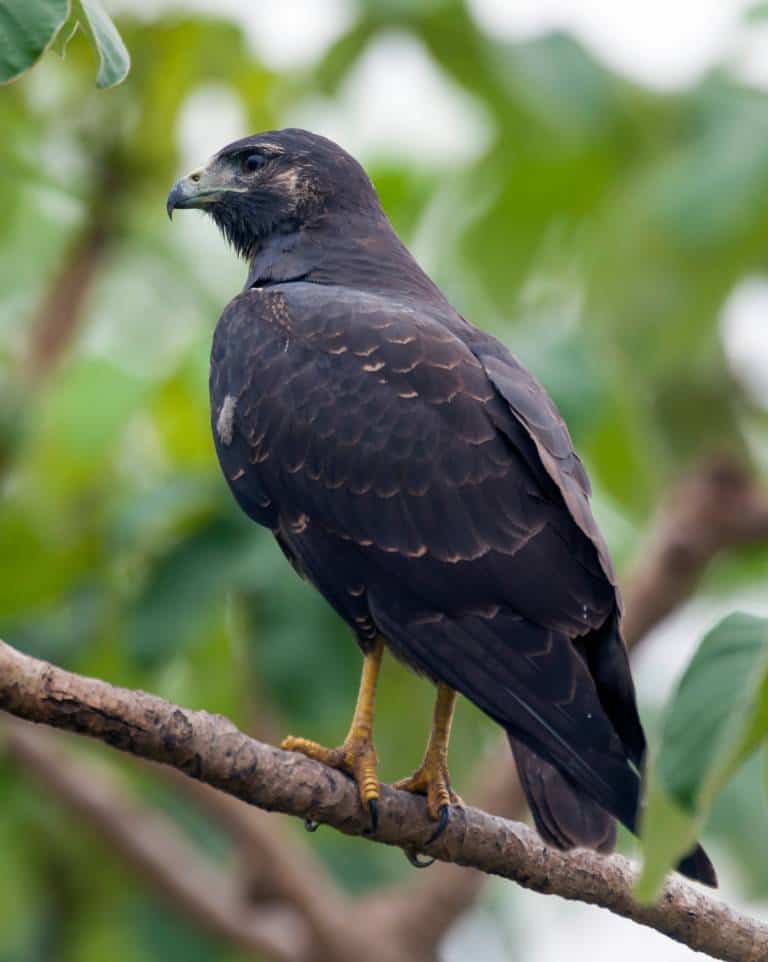
Conservation Status of this California Bird of Prey: The Zone-tailed Hawk is considered to be a species of least concern.
Where in California can I see Zone-tailed Hawks?
The Zone-tailed Hawk is typically found in forested areas, including riparian woodlands, canyons, and mountainous regions. These birds of prey prefer habitats with large trees and open spaces, where they can hunt for prey.
Zone-tailed Hawks are migratory birds, spending their breeding season in the southern United States and Mexico, and migrating to Central America for the winter.
In Central and Southern California, you may find Zone-tailed Hawks in areas such as the coastal regions, deserts, and mountainous regions that have wooded areas near rivers or streams. They are not a common site in California, so if you spot one, take time to enjoy it!
Zone-tailed Hawk Description and Identification Tips
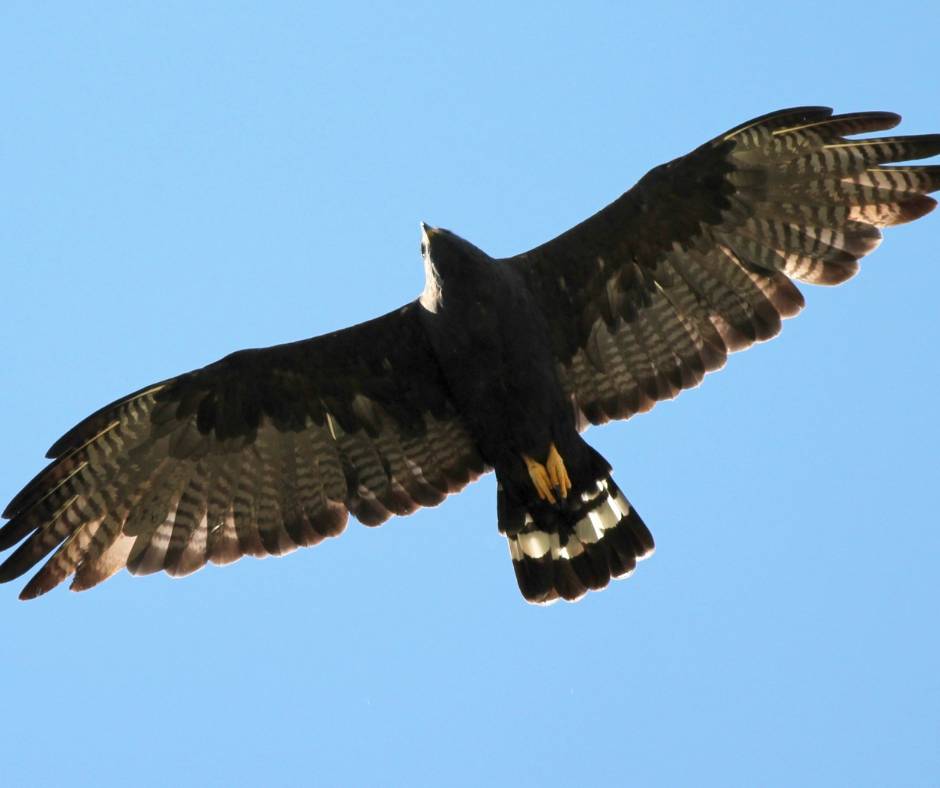
The Zone-tailed Hawk is a medium-sized raptor with a wingspan of around 3.5 to 4 feet and a length of about 17 to 20 inches. It has a dark brown or blackish plumage with a pale grayish-brown barred belly and distinctive whitish bands on its tail. The wings are broad and rounded.
The Zone-tailed Hawk resembles the Turkey Vulture in flight, as it has similar coloring and patterns. However, when perched, it can be distinguished by its broad wings, relatively short tail, and dark plumage. They also have feathered heads while Turkey Vultures do not.
The Zone-tailed Hawk primarily feeds on small mammals, birds, reptiles, and insects. It is known for its unique hunting behavior, where it often flies among groups of Turkey Vultures, taking advantage of their presence to remain inconspicuous and surprise its prey. This clever hunting adaption is called mimicry.
These hawks are monogamous, typically build stick nests in tall trees and may reuse nests from previous years. Females lay one to three eggs, which are incubated for about 30 to 35 days. The young birds fledge and become independent after around 45 to 50 days. Maturity is reached after 2-3 years and their lifespan is 10-15 years in the wild.
16. Rough-Legged Hawk

Conservation Status of this California Bird of Prey: The Rough-legged Hawk is a species of least concern.
Where in California can I see Rough-legged Hawks?
Rough-legged Hawks are migratory birds. They breed in the Arctic during the summer months and then migrate south for the winter. In winter, look for them perched on poles, trees, or hovering in search of prey.
Throughout the state, look for them in grasslands, agricultural fields, marshes, and open woodlands. You are not likely to see them around forests. Sacramento National Wildlife Refuge, Colusa National Wildlife Refuge, and Modoc National Wildlife Refuge are some of the places you might see them.
Rough-legged Hawk Description and Identification Tips

The Rough-legged Hawk has a wingspan that ranges from about 52 to 58 inches and weighs between 1.2 to 3.3 pounds.
They have a stocky build with broad wings and a feathered facial disk that resembles an owl. The adult plumage varies, but it typically features dark brown to black feathers on the body, a white or light-colored head and underparts, and a dark belly band or bib. They have feathered legs that extend all the way to their toes, giving them a rough-legged appearance.
Rough-legged Hawks are known for their hovering behavior, similar to that of a kestrel. They hover in the air while scanning the ground for prey. They are skilled hunters, primarily feeding on small mammals like voles, mice, lemmings, and ground squirrels. They will perch on elevated perches, such as fence posts or trees, from which they can spot potential prey.
Rough-legged Hawks are monogamous and form pair bonds that can last multiple breeding seasons. They build nests on cliffs or high trees using sticks and lined with grass and other soft materials. The female usually lays 2 to 6 eggs, and both parents participate in incubating them for about a month.
The chicks fledge after around 5 to 6 weeks and become independent within a few months. Rough-legged Hawks generally reach maturity at around two to three years of age. Their lifespan in the wild is typically around 10 to 15 years.
17. Broad-Winged Hawk
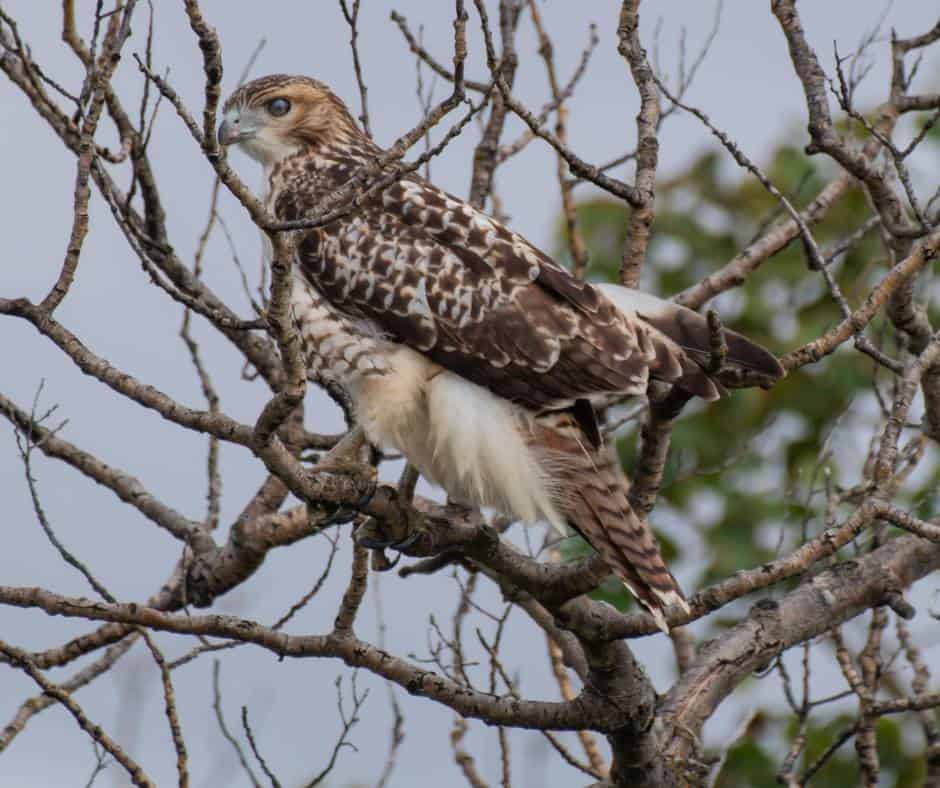
Conservation Status of this California Bird of Prey: Broad-winged Hawks are a Species of Least Concern.
Where in California can I see Broad-winged Hawks?
In California, the Broad-winged Hawk is considered a rare visitor during migration. They have been spotted at the Marin Headlands in Northern California as well as far south at Point Loma in San Diego.
They can be seen primarily during the fall migration. Birdwatchers and hawk enthusiasts often keep an eye out for this species during the migration season in woodlands, edges, and forested wetlands
Broad-winged Hawk Description and Identification Tips

Broad-winged Hawks are relatively small hawks with a body length of about 14-17 inches and a wingspan of approximately 31-37 inches. They have a stocky build, broad wings, and a short, rounded tail. Adult birds have dark brown upperparts with a rufous-barred belly and a white or pale underwing with dark wingtips.
Broad-winged Hawks are known for their distinctive behavior of migrating in large flocks called “kettles” during the fall migration. These flocks can consist of hundreds or even thousands of hawks soaring and spiraling together in thermal updrafts. They are also skilled hunters, preying on small mammals, birds, reptiles, and amphibians.
These hawks are monogamous and form pair bonds that can last multiple breeding seasons. They build nests in the crotch of a large deciduous tree. The female typically lays two to four eggs, which are incubated by both parents for about 30 days. The young fledge after about six weeks and become independent shortly thereafter. Maturing happens after three years and typically live 12-15 years.
Falcons
18. Peregrine Falcon

Conservation Status of this California Bird of Prey: Previously endangered, the Peregrine Falcon was delisted in 2009, but it is still a fully protected species.
Where in California can I see Peregrine Falcons?
Peregrine Falcons have a widespread range in California, occupying a variety of habitats throughout the state. They can be found along the coast, in mountainous regions, and in urban areas.
Locations such as Big Sur, Point Reyes National Seashore, Channel Islands National Park, and the Farallon Islands provide suitable habitat for nesting pairs.
Yosemite National Park and Kings Canyon National Park are wonderful places to observe Peregrine Falcons in the Sierra Nevada. Cities with tall buildings like San Francisco and Los Angeles have nesting pairs that can be observed as well. You can find these amazing birds from the big cities to the suburbs to the forest.
Peregrine Falcon Description and Identification Tips
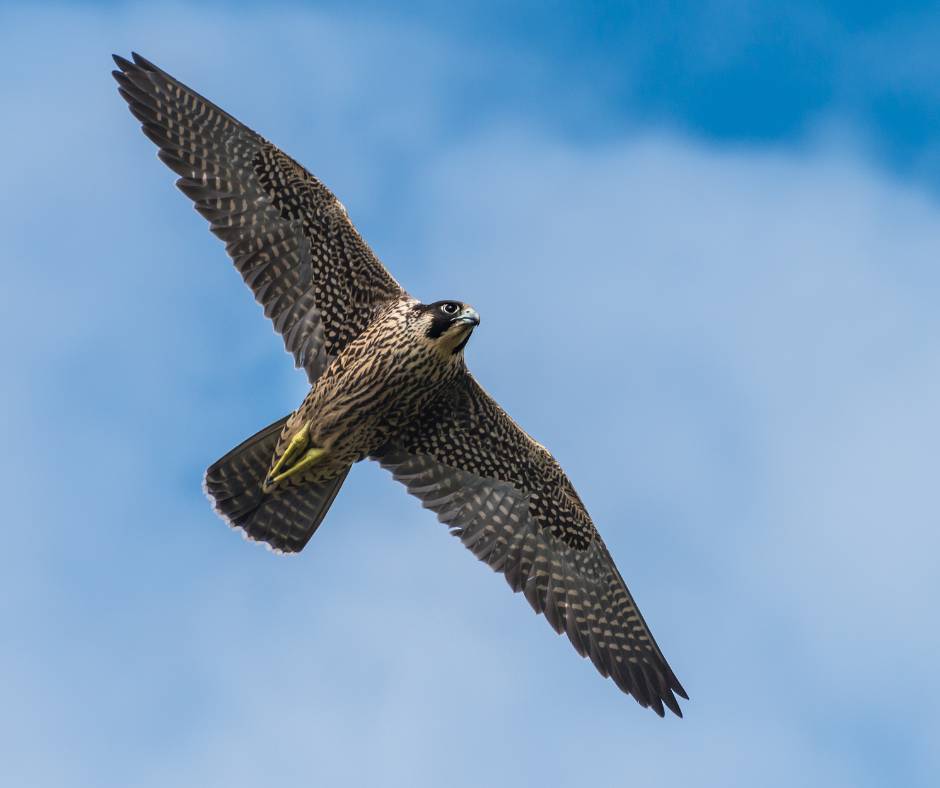
Peregrine Falcons are medium-sized raptors, with adult males measuring around 15-20 inches in length and having a wingspan of about 40-45 inches. Females are slightly larger. They have a compact and streamlined body and long pointed wings. The head is dark with a distinctive black “mustache” mark on each side.
Peregrine Falcons are renowned for their exceptional speed during hunting. They are one of the fastest animals on the planet, capable of reaching speeds over 240 miles per hour in a stoop, which is a steep dive they use to strike their prey. They primarily feed on birds, which they capture mid-air by diving from great heights and striking their prey with their sharp talons.
These California birds of prey faced a significant decline in the mid-20th century due to the widespread use of pesticides like DDT, which caused thinning of eggshells and reduced reproductive success. However, conservation efforts, including banning the use of these chemicals, have led to a remarkable recovery of their populations.
Peregrine Falcons are monogamous and form long-term pair bonds. They construct nests called “scrapes” on ledges, cliffs, or tall structures. Females typically lay 3-4 eggs, which are incubated by both parents for about a month.
The chicks hatch and are cared for by their parents until they fledge, which usually occurs after about 6 weeks. They reach maturity after 2-3 years and live for 10-15 years in the wild.
19. Prairie Falcon
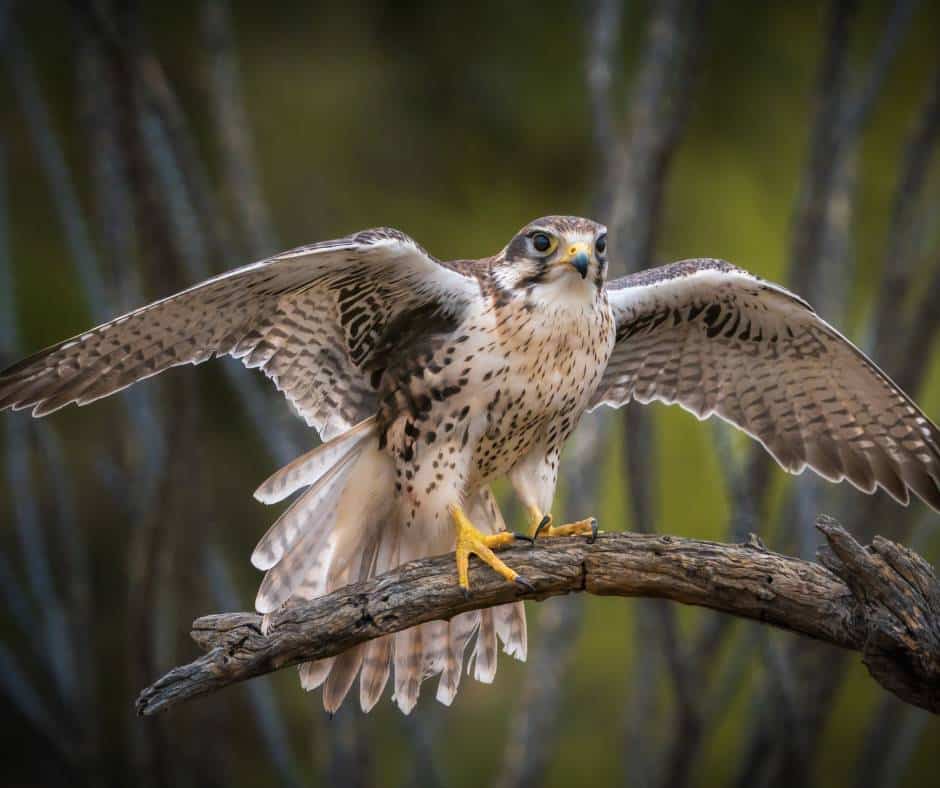
Conservation Status of this California Bird of Prey: Prairie Falcons are a species of least concern.
Where in California can I see Prairie Falcons?
Prairie Falcons can be found in various regions of California, including the Central Valley, Mojave Desert, and parts of the Sierra Nevada. They prefer open habitats with suitable nesting cliffs and abundant prey populations. Look for them in grasslands, shrublands, deserts, canyons, and on rocky outcrops or cliffs.
Prairie Falcon Description and Identification Tips
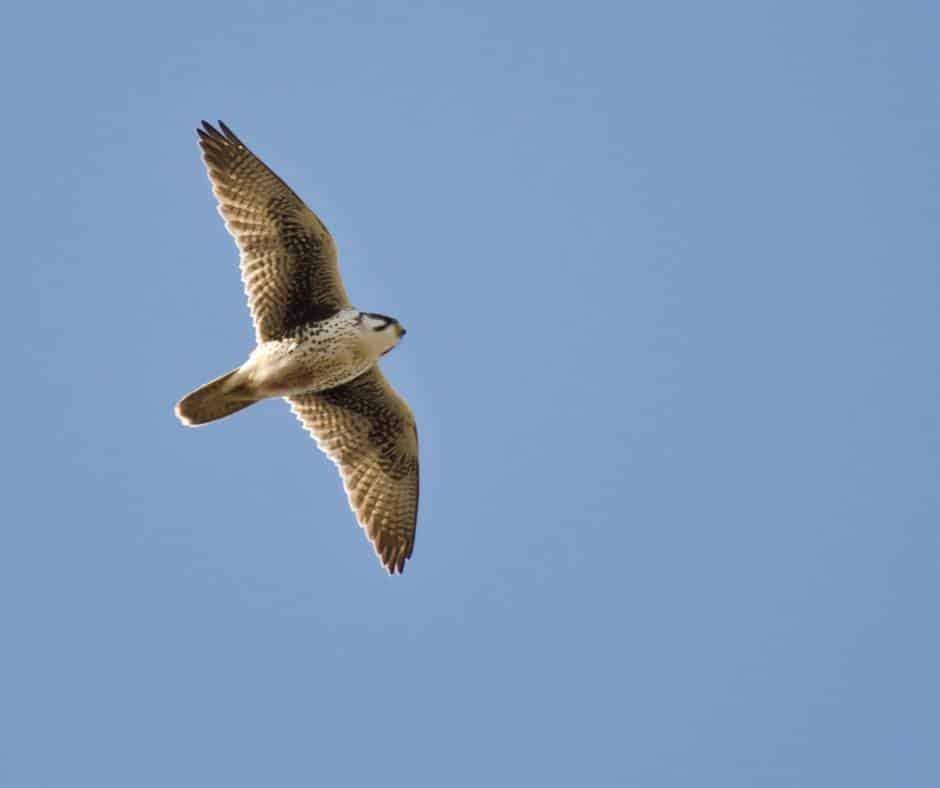
Prairie Falcons have a compact and muscular body with a wingspan ranging from 3.3 to 3.9 feet. They have a dark brown or grayish-brown back and wings, with a paler underbody that may have fine streaks or barring. Their tail is long and tapered, and their face shows a distinctive dark mustache mark.
Prairie Falcons are agile and swift fliers, known for their powerful and fast hunting flights. They primarily feed on small to medium-sized birds, such as songbirds, waterfowl, and shorebirds. They may also prey on mammals, reptiles, and insects.
Like other falcons, Prairie Falcons are known for their ability to engage in high-speed stoop attacks, diving from great heights to capture prey. Prairie Falcons are known for their distinctive vocalizations, which include a series of harsh, raspy calls. They are territorial birds and often defend their nesting areas against intruders, including other raptors.
Prairie Falcons are monogamous and form breeding pairs. They build their nests on ledges or in crevices on cliffs, often reusing the same site in subsequent years. The female typically lays 3 to 5 eggs, which are incubated by both parents for about 30 days.
The young falcons fledge after about 5 to 6 weeks and become independent within a few months. They reach maturity at 1-2 years of age and live for 12-15 years.
20. American Kestrel

Conservation Status of this California Bird of Prey: American Kestrels are a species of least concern.
Where in California can I see American Kestrels?
American Kestrels are found throughout California, in various habitats such as grasslands, agricultural areas, coastal regions, and open woodlands. They are a relatively common and widespread species in the state. They are often perched on wires, poles, or trees, and their hovering hunting behavior can be fascinating to watch.
American Kestrel Description and Identification tips

American Kestrels are small falcons, measuring just 9 to 12 inches in length and having a wingspan of approximately 20 to 24 inches. They weigh only 3-5 ounces.
Males and females exhibit sexual dimorphism, meaning they have different appearances. Males have a distinctive coloration with blue-gray wings, a rusty-red back, and a white and rusty-red belly with black spots. Females are larger and have a similar color pattern but with more brown tones.
American Kestrels are active hunters, primarily feeding on small mammals, insects, and small birds. They have a distinctive hunting style, hovering in mid-air and rapidly flapping their wings while scanning the ground for prey. They are also known for their ability to perch-hunt, where they observe the surroundings from a high vantage point and swoop down to catch prey.
American Kestrels are cavity nesters, often using abandoned woodpecker holes or nest boxes as their nesting sites. The female typically lays 4 to 6 eggs, which are incubated by both parents for about 30 days. The young kestrels fledge after about 4 to 5 weeks and may continue to be cared for by the parents for some time.
They reach matuiry after one year but often don’t breed until the second year. They live for 5-10 years.
21. Merlin

Conservation Status of this California Bird of Prey: Merlins are a Species of Least Concern.
Where in California can I see Merlins?
Merlins can be spotted along the California coast, including coastal woodlands, open beaches, and estuaries. Keep an eye out for them perching on trees, utility poles, or scanning for prey over the water.
Merlins are adaptable and can be found in urban and suburban environments, including city parks, golf courses, and open spaces with trees. They may perch on buildings, lampposts, or other structures. They are most often in areas with a study supply of House Sparrows.
Merlin Description and Identification tips

The Merlin is a small but fierce bird of prey that belongs to the falcon family. Merlins are compact birds, measuring about 9 to 12 inches in length with a wingspan of approximately 20 to 24 inches. Males weigh 5-7 grams and females weigh 6-10 grams.
They exhibit sexual dimorphism, and males are smaller than females. Their plumage varies, but generally, they have a dark brownish-gray back, a pale breast with streaks, and a dark head with a distinctive facial pattern consisting of a mustache-like mark.
Merlins are fast and agile flyers known for their impressive hunting skills. They primarily feed on small birds, capturing them in mid-air during high-speed pursuits. They are adept at maneuvering through trees and vegetation to surprise their prey. They are also known for their characteristic flight display, called “stooping,” where they dive steeply from high altitudes during courtship or territorial defense.
In North America, they breed in the northern parts of the continent and migrate to wintering grounds in the southern parts. Merlins often reuse old crow or hawk nests. They will even lay their eggs on magpie nests.
The female lays 3 to 5 eggs, which are incubated for about 28 to 32 days. Both parents participate in raising the young, and the chicks fledge after about 25 to 30 days. Merlins may have multiple broods in a season. Merlins reach sexual maturity after 1-2 years but they may not breed until they are 2-3 years old. In terms of lifespan, Merlins in the wild typically live around 5-10 years.
Did you know? Medieval falconers called Merlins, lady hawks, and used them to hunt sky larks.
Owls
22. Great Horned Owl
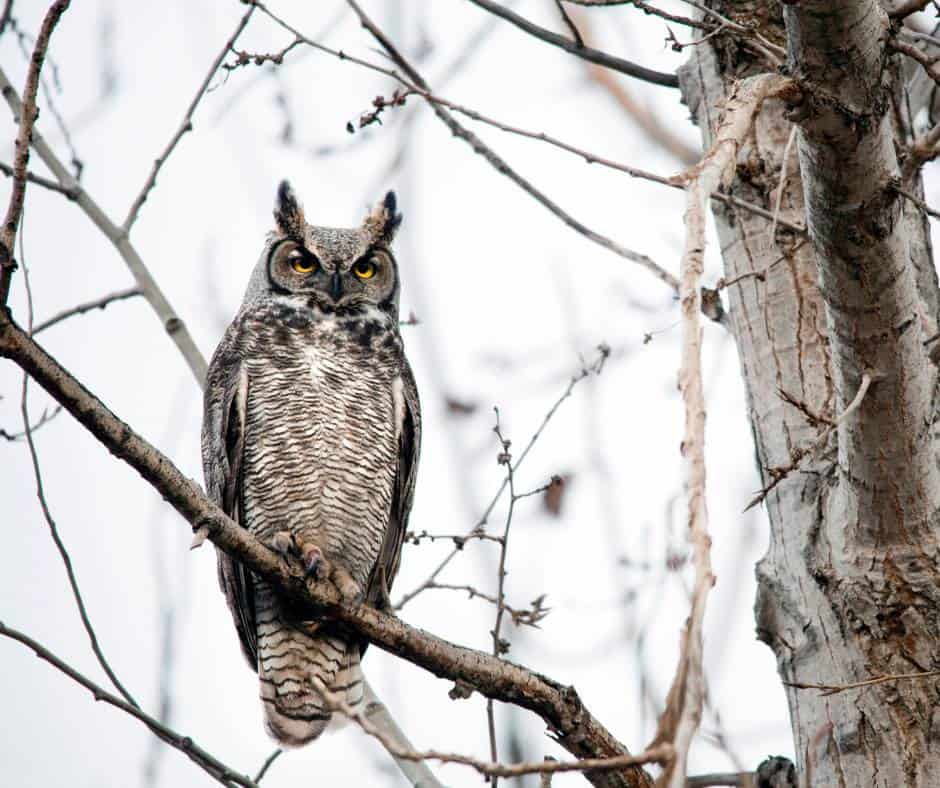
Conservation Status of this California Bird of Prey: The Great Horned Owl is a Species of Least Concern.
Where in California can I see Great Horned Owls?
Great Horned Owls are highly adaptable and can be found in a wide range of habitats including forests, deserts, wetlands, grasslands, and urban areas. They are commonly found in both dense forests and open habitats with scattered trees, as they require perches for hunting and nesting.
There range is basically all over California. In suburban Orange County where I live, we have a Great Horned Owl that lives in our nieghborhood and can often be heard calling in the middle of the night. It is always neat to find him on the roof of one of the homes in our cul de sac.
Great Horned Owl Description and Identification Tips

The Great Horned Owl is a large owl with prominent ear tufts and distinctive yellow eyes. It is one of the most widespread and adaptable owl species in North America and can be found in a variety of habitats in California.
It has a body length of around 18 to 25 inches and a wingspan of about 3 to 5 feet. They weigh 2-4 pounds. They have prominent ear tufts or “horns” on their heads, which are not actual horns but rather tufts of feathers.
Their plumage is mottled and varies in color from grayish-brown to reddish-brown, providing excellent camouflage in their woodland habitats. They have a facial disk, which helps funnel sound towards their ears.
They have a distinctive hooting call that sounds like “hoo-hoo-hoo-hoo,” with the last note lower and drawn out.
Great Horned Owls are opportunistic predators and have a diverse diet. They use their sharp beaks and talons to kill rabbits, squirrels, rats, mice, and voles. They also prey on birds of various sizes, including other owls, waterfowl, songbirds, and occasionally even larger species like herons or raptors. They may also feed on reptiles, amphibians, and insects.
Great Horned Owls typically mate for life and form long-term pair bonds. They build nests on tree branches, in tree cavities, or even on the ground. They are known for taking over abandoned nests of other large birds such as hawks or crows.
The female lays 1-4 eggs, and both parents participate in incubating the eggs and caring for the young. The chicks, known as owlets, hatch after about a month and stay with their parents for several months before becoming independent. Threach maturity after 2-3 years and live for 15-20 years.
23. Western Screech Owl
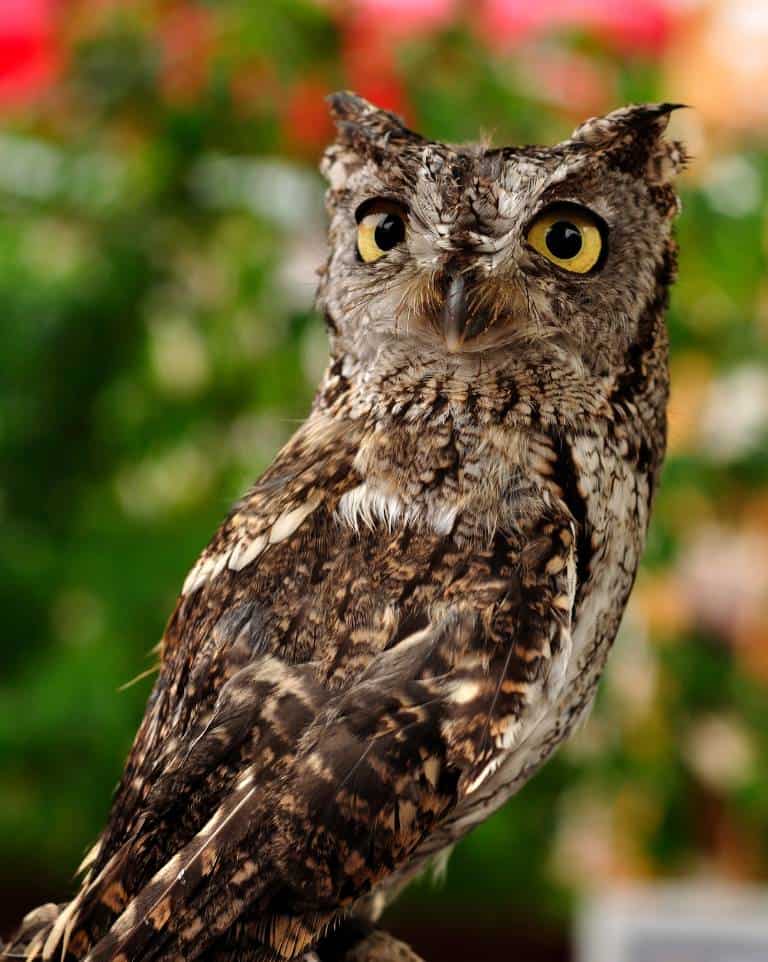
Conservation Status of this California Bird of Prey: Western Screech Owls are Species of Least Concern.
Where in California can I see Western Screech Owls?
Western Screech Owls inhabit forests, woodlands, and suburban areas across California. They are found more frequently found at lower elevations and often roost in tree cavities, abandoned woodpecker holes, or nest boxes. Look for them in forests, woodlands, riparian areas, canyons, and suburban parks and gardens.
Western Screech Owl Description and Identification Tips
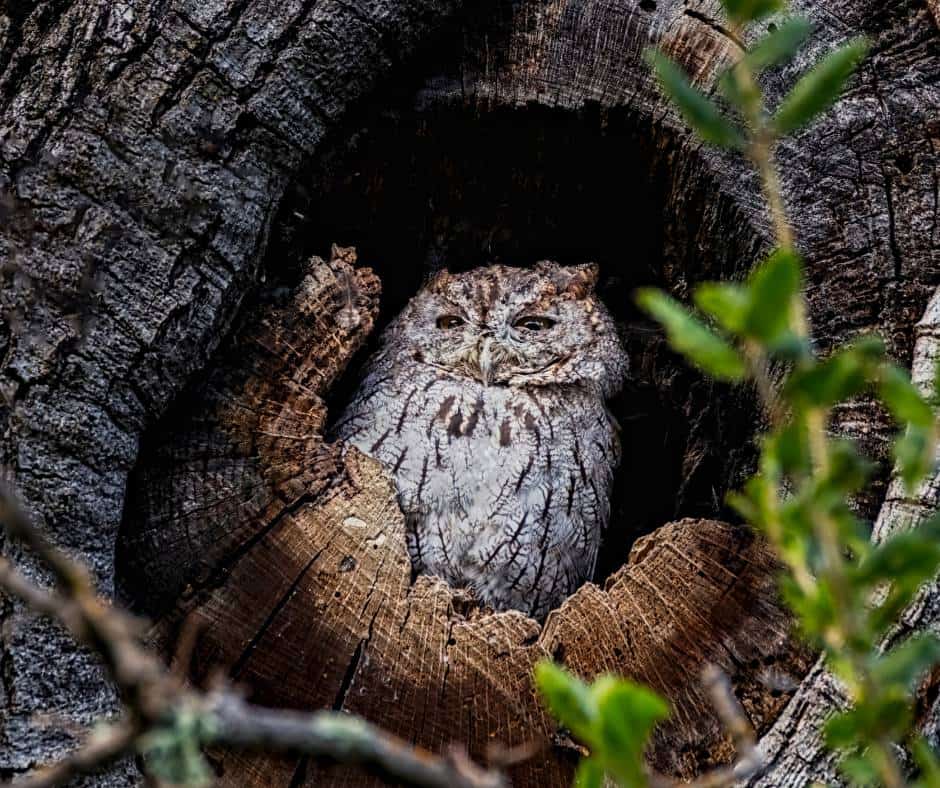
The Western Screech Owl is a small owl with a rounded head and prominent ear tufts. The are typically 8-10 inches in length and weigh just 4-8 ounces. It has a range of plumage variations, including gray and reddish-brown morphs, which provide excellent camouflage against tree bark.
Western Screech Owls can be found in a range of habitats, including forests, woodlands, riparian areas, canyons, and suburban parks and gardens. They often roost in tree cavities, abandoned woodpecker holes, or nest boxes.
Like most owls, Western Screech Owls are primarily active at night. They hunt for small mammals like mice and voles as well as birds, insects, and other prey using their excellent hearing and night vision. They are also known to eat reptiles, amphibians, and invertebrates.
The call of the Western Screech Owl is a distinctive trilling or whinnying sound, often described as a series of soft, descending whistles. Their calls can be heard during the breeding season as well as during territorial disputes or encounters with other owls.
Western Screech Owls typically breed from late winter to early spring. They lay 2-5 eggs in a tree cavity or nest box, which are incubated by the female for about a month.
The young owls leave the nest after several weeks but may remain dependent on their parents for some time. They reach maturity after a year but may not breed for another year. They live 10-15 years in the wild.
24. Northern Pgymy Owl
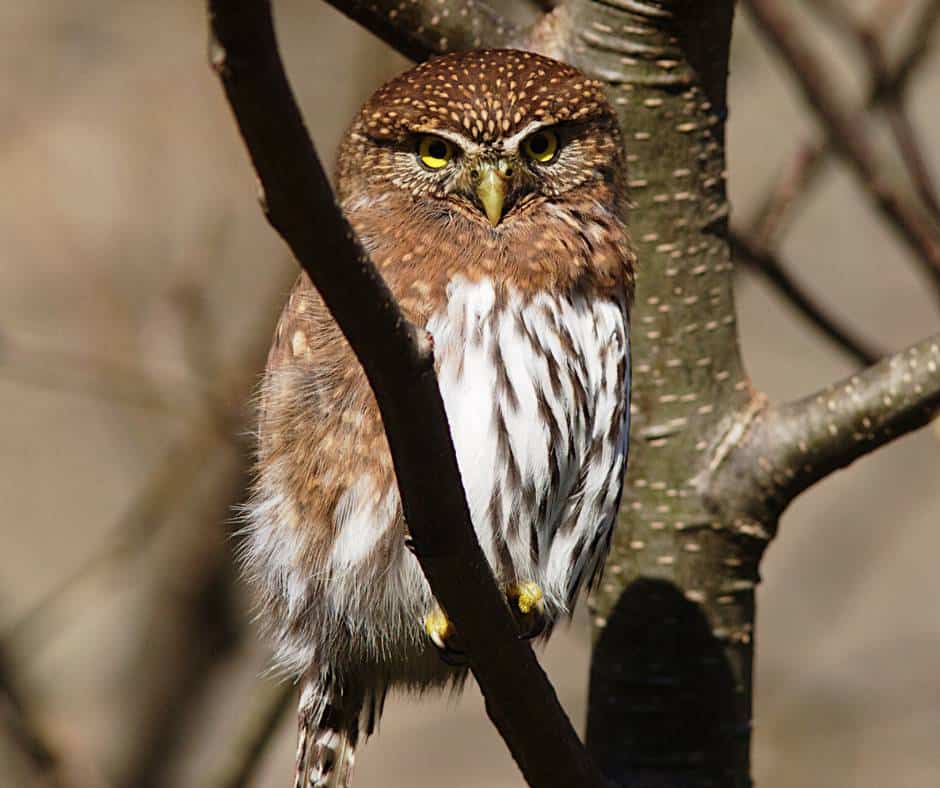
Conservation Status of this California Bird of Prey:The Northern Pygmy Owl is a Species of Least Concern.
Where in California can I see Northern Pygmy Owls?
These owls are most often found in coniferous forests and mixed woodlands of California. Northern Pygmy Owls are relatively small and well-camouflaged, making them challenging to spot. They are primarily active during the day, so keep an eye out during daylight hours and listen for their distinctive calls.
They can be found in the higher elevation forests of the Sierra Nevada range, including areas such as Yosemite National Park, Sequoia and Kings Canyon National Parks, and the Tahoe National Forest. Forested areas along the northern coast of California, such as Redwood National and State Parks and Humboldt Redwoods State Park, are also habitats for the Northern Pygmy Owl.
Forested areas in the central part of the state, including parts of the Los Padres National Forest and the Stanislaus National Forest, may provide opportunities to spot Northern Pygmy Owls. The mountainous regions of Southern California, such as the San Bernardino and San Jacinto Mountains are also home to this owl.
Northern Pygmy Owl Description and Identification tips
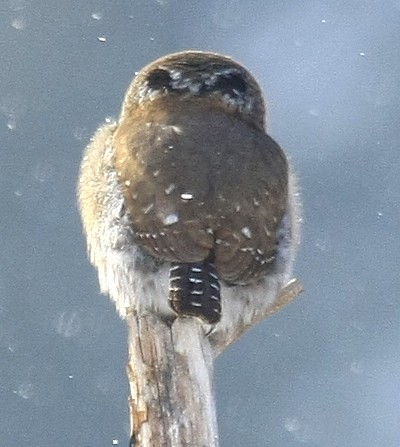
The Northern Pygmy-Owl is a small owl with a relatively long tail and a round head lacking prominent ear tufts. It is one of the smallest owl species in North America, measuring about 6-7 inches in length and weighing just 2.5-3.5 ounces.
It has a rounded head with bright yellow eyes and lacks ear tufts. The plumage varies but typically includes a mix of brown, gray, and white feathers, providing excellent camouflage in forested habitats.
Despite their small size, Northern Pygmy Owls are formidable predators. They primarily hunt during the day and are known for their agility and ability to capture prey larger than themselves. Their diet consists mainly of small birds like sparrows, warblers, and finches, as well as voles, mice, and insects
The Northern Pygmy Owl has a distinctive call that consists of a series of whistling or tooting notes. The male’s call is higher-pitched and more melodious, while the female’s call is lower and harsher. They use vocalizations to communicate with their mate, establish territories, and potentially attract prey.
Northern Pygmy Owls breed in late winter or early spring. They typically nest in tree cavities, often reusing old woodpecker holes or using natural tree cavities. The female lays a clutch of 3-7 eggs, which are incubated by both parents for about 3 weeks.
After hatching, the young owls stay in the nest for several weeks before fledging. They reach maturity after a year and live 3-7 years.
25. Burrowing Owl

Conservation Status of this California Bird of Prey: The Burrowing Owl is a Species of Special Concern due to habitat loss.
Where in California can I see Burrowing Owls?
Burrowing Owls can be found in grasslands and open areas in parts of California.
They can be found in the Central Valley of California, including areas around Bakersfield, Merced, Modesto, Fresno, and Stockton. They are also often found in agricultural fields, and vacant lots.
In the Sacramento Valley, they are quite common around Sacramento, Davis, and Redding. I remember seeing quite a few of these little guys out in the fields when I was studying raptors at UC Davis.
Along the Central Coast, they are most likely to be seen in Carrrizo Plain National Monument and the Santa Maria Valley. In SoCal, the Antelope Valley, Imperial Valley, and Mojave Desert are the best places to see burrowing owls. They can be found in open desert habitats, grasslands, and even near more urban areas with suitable nesting sites.
Burrowing Owl Description and Identification tips

The Burrowing Owl is a small, ground-dwelling owl with a distinctive appearance. It has long legs, short tail, and bright yellow eyes. It nests in underground burrows, often repurposing burrows made by other animals.
Burrowing Owls are small, measuring around 7-11 inches in length, with a wingspan of about 20 inches and a weight of 5-8.5 ounces.. They have a round head, long legs, and a short tail. Their plumage is typically brownish with white or pale spots, and they have bright yellow eyes.
As their name suggests, Burrowing Owls are known for nesting and roosting in burrows. They can be found in open grasslands, deserts, agricultural fields, prairies, and other open habitats with low vegetation. They rely on burrows created by other animals, such as ground squirrels or prairie dogs, or they may dig their own burrows.
Burrowing Owls face various conservation challenges due to habitat loss and degradation. Their reliance on burrows makes them vulnerable to land development and the destruction of nesting sites.
They are protected under state and federal laws, and conservation efforts focus on preserving suitable habitat and creating artificial burrows to support their population.
Burrowing Owls are monogamous and form long-term pair bonds. They breed in the spring and females lay around 6-12 eggs. The incubation period lasts about 28-30 days, and both parents take turns incubating the eggs and caring for the young.
The young owlets leave the nest after approximately 3-4 weeks but continue to be dependent on their parents for several more weeks. They start breeding when they are about two years old and only live for 6-8 years.
26. Barn Owl

Conservation Status of this California Bird of Prey: Barn Owls are A Species of Least Concern.
Where in California can I see Barn Owls?
Barn Owls are one of the most common California birds of prey. They live throughout California except for in the highest elevations. They inhabit a wide range of habitats, including grasslands, agricultural fields, open woodlands, marshes, and even urban areas. They are even found in the desert, but not in as large of numbers.
They are often found near open areas with suitable nesting sites, such as barns, abandoned buildings, birdge girders, cliffs, and tree cavities.
Barn Owl Description and Identification Tips

The Barn Owl is a medium-sized owl known for its heart-shaped face and pale plumage. It is primarily nocturnal and hunts small mammals in open habitats such as fields, meadows, and marshes .
Barn Owls have a distinctive appearance with a heart-shaped face and dark eyes. They have pale, creamy plumage with mottled shades of brown, gray, and white. Their wings are long and broad, allowing for silent flight.
They are primarily nocturnal birds with exceptional low-light vision and acute hearing, which helps them locate prey in the dark. they feed primarily on mall mammals, such as mice, voles, rats, and shrews. They also eat some birds, reptiles, and insects. They hunt by silently flying over their hunting grounds and capturing prey with their sharp talons.
Barn Owls are known for their unique nesting behavior. They don’t build their own nests but instead use existing structures or cavities. They may occupy barns, tree hollows, cliff ledges, or nest boxes.
These owls are monogamous and form long term bonds. The females lay 4-7 eggs and both parents help incubate the eggs which take abotu a month to hatch. Young fledge after 8 to 10 week and reach maturity after one year. The live for 4-5 years in the wild.
27. Long-Eared Owl

Conservation Status of this California Bird of Prey: Long-eared Owls are a Species of Special Concern. Long-eared Owls face various threats including habitat loss, degradation, and fragmentation, as well as disturbance at nesting sites.
Where in California can I see Long-eared Owls?
Long-eared Owls live in dense woodlands, conifer forests, oak woodlands, and riparian areas of California. They can be elusive and difficult to spot due to their excellent camouflage and secretive behavior.
They can be found in these habitats in the Sacramento Valley, San Joaquin Valley, Yosemite National Park, Sequoia National Park, Big Sur, Humboldt County, Mendocino County San Diego County, Los Angeles County, and Orange County.
Long-eared Owl Description and Identification Tips

The Long-eared Owl is a medium-sized owl with long ear tufts that are often difficult to see. It has a slim and elongated body with long ear tufts on the top of its head. It has a mottled brown and buff plumage with streaks and bars, providing excellent camouflage in its woodland habitat. The facial disc is pale with a dark border, and the eyes are orange or yellow.
Long-eared Owls prefer dense woodlands, including coniferous forests and mixed forests. They are also found in riparian areas, groves, and sometimes even in urban parks and gardens.
Long-eared Owls are nocturnal and mainly active during the night. They have excellent hearing and rely on it more than their sight for hunting. They are stealthy hunters, relying on their ability to silently fly and capture small mammals, including mice, voles, and shrews. They may also feed on small birds and insects.
Long-eared Owls typically nest in dense tree foliage, using old nests built by other birds or selecting tree cavities. They may also use abandoned buildings, cliffs, or ground nests. The female lays a clutch of 3-8 eggs, which are incubated by both parents for about a month.
The young owls leave the nest after about 4-5 weeks. They reach maturity after a year, typically start breeding at two years, and live for 4-5 years.
28. Short-Eared Owl
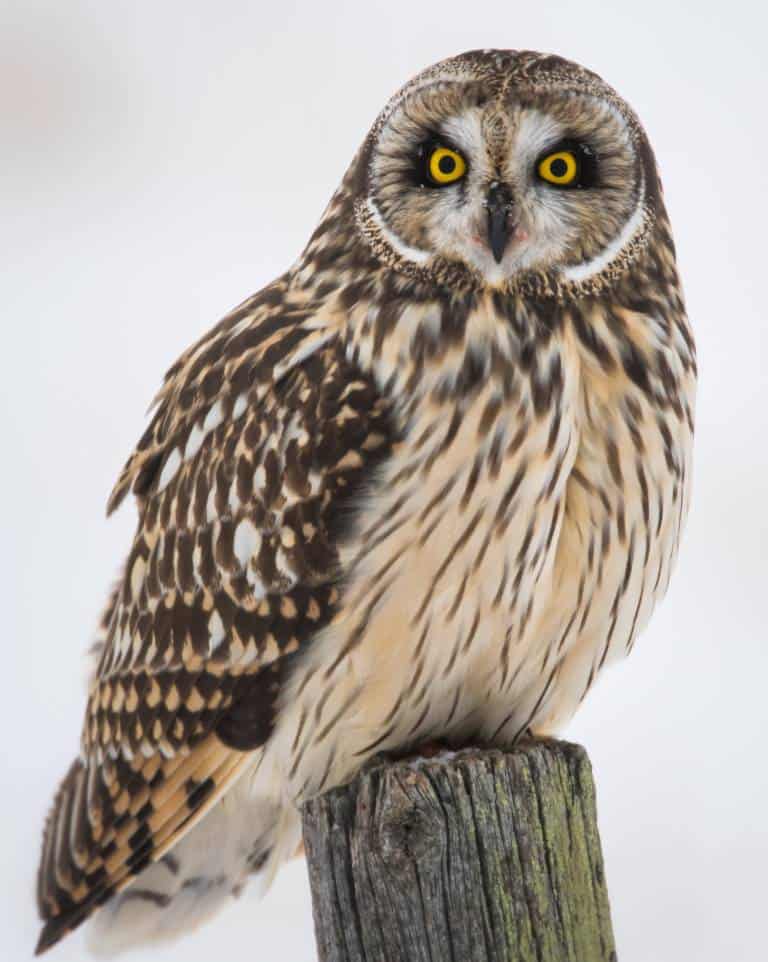
Conservation Status of this California Bird of Prey: Short-eared Owls are considered to be a Species of Special Concern. This is due to habitat loss, degradation, and changes in agricultural practices. Loss of grassland habitats and increased use of pesticides can negatively impact their populations.
Where in California can I see Short-eared Owls?
Short-eared Owls have been observed in various parts of California, including coastal areas, grasslands, and marshes. They can be found in regions such as the Central Valley, Sacramento-San Joaquin Delta, Salton Sea, and coastal areas like San Francisco Bay and Humboldt County.
Short-eared owl Description and Identification Tips

The Short-eared Owl is a medium-sized owl with short ear tufts that are often difficult to see. It has a compact and stocky body with a relatively short tail and broad wings. It has a round head with prominent yellow eyes and small ear tufts (which are usually not visible). The plumage is mottled brown with streaks and spots, providing excellent camouflage.
Short-eared Owls can be found in a range of open habitats such as grasslands, marshes, prairies, agricultural fields, and coastal dunes. They prefer areas with low vegetation cover, which allows them to hunt for small mammals and birds by flying low over the ground.
These owls are often active during the day, especially during dawn and dusk. They have a distinctive flight pattern characterized by buoyant and erratic wingbeats, similar to a moth. Short-eared Owls are known for perching on the ground or low perches like fence posts or shrubs.
Short-eared Owls are ground-nesting birds. They create shallow scrapes on the ground where they lay their eggs, usually in grassy areas or open fields. The female typically lays a clutch of 4 to 7 eggs, and both parents participate in incubating the eggs, which takes about 24 to 28 days.
The chicks fledge around 3 to 4 weeks after hatching. They mature after one year and live for only 3-5 years in the wild.
29. Great Grey Owl

Conservation Status of this California Bird of Prey: Great Grey Owls are Endangered Species in California.
Where in California can I see Great Grey Owls?
Great Grey Owls are in the Sierra Nevada and this population is genetically distinct from the Great Grey Owl populations outside of California.
Yosemite is the southernmost portion of their rang and home to about 300 owls which make up over half the state’s population. This means a visit to Yosemite is your best bet for spotting this owl in California.
Here is our perfect one-day Yosemite itinerary and a great guide featuring over 15 easy hikes in Yosemite. If you love animals you will want to read our guide to animals in Yosemite before your visit as well.
Great Grey Owl Description and Identification Tips
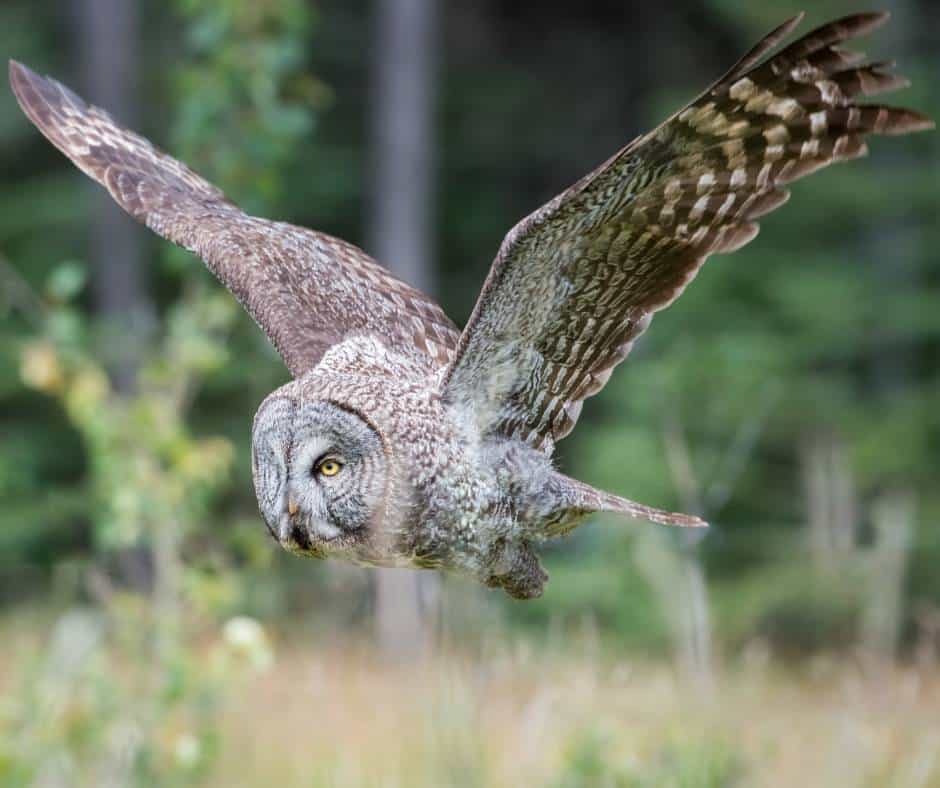
The Great Grey Owl is the largest owl species in length, although it is not the heaviest. They have a height of about 24-33 inches, a wingspan of around 53-60 inches, and weigh 2-4 pounds.
It has a round face with a large facial disc and bright yellow eyes. The plumage is mostly gray, with intricate patterns and bars that provide excellent camouflage against tree bark. It has long wings and a relatively short tail.
Great Grey Owls prefer areas with dense tree cover, particularly where there are old-growth forests with large trees.
These owls are mostly crepuscular and nocturnal, meaning they are active during twilight and night hours. They have excellent hearing and rely on their keen sense of hearing to locate prey in complete darkness. Great Grey Owls primarily feed on small mammals, such as voles, mice, and other rodents.
Great Grey Owls are not known for their hooting calls. Instead, they communicate through a variety of low, soft hoots and whistles.
Female Great Grey Owls lay a clutch of 2 to 5 eggs, which they incubate for about 28 to 35 days. The male provides food for the female during this period. Owlets leave the nest after about 4 to 5 weeks but continue to rely on their parents for several months before becoming independent. They mature after 1-3 years and live for 5-10 years.
30. California Spotted Owl
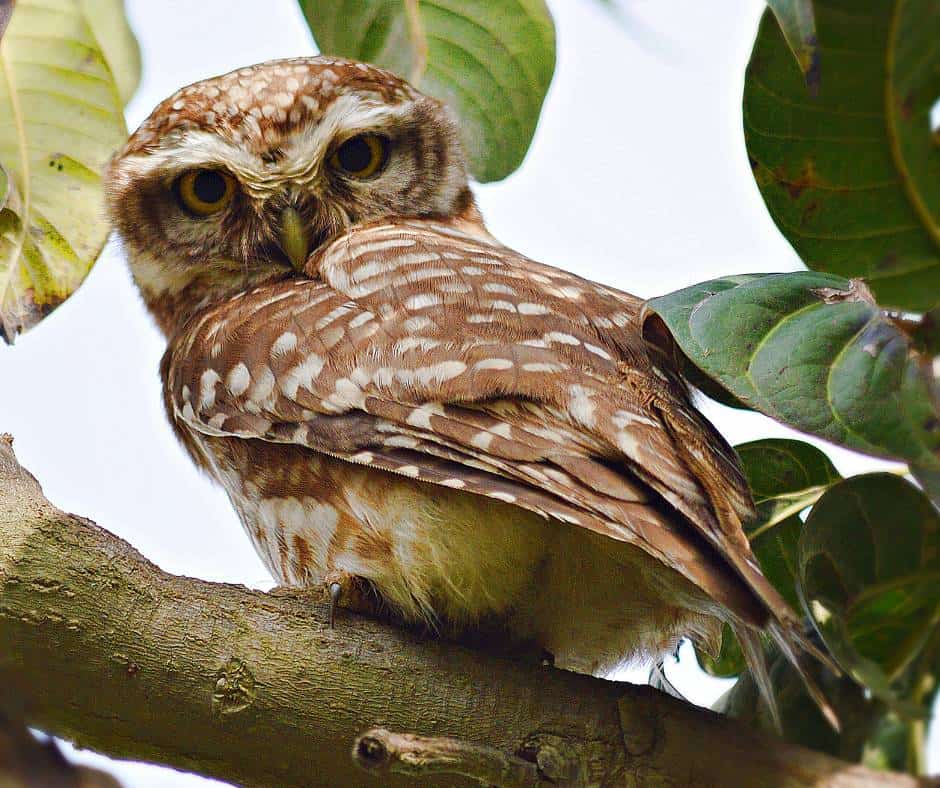
Conservation Status of this California Bird of Prey: California Spotted Owls are Species of Special Concern in California and is listed as a threatened species under the U.S. Endangered Species Act. It faces various threats to its habitat, including logging, wildfires, and habitat fragmentation. The species relies on intact forest ecosystems, and its conservation requires efforts to maintain suitable habitat conditions.
Where in California can I see Spotted Owls?
The California Spotted Owl lives in places with large, old -growth trees and dense canopies. They prefer mixed-conifer forests, including areas dominated by Douglas-fir, white fir, and ponderosa pine. They rely on these habitats for roosting, nesting, and hunting.
They can be found in the Cascade Range up in far northern California (Shasta County), the western slope of the Sierras, and in Southern California’s San Bernardino Mountains.
California Spotted Owl Description and Identification Tips

California Spotted Owls are medium-sized owls, measuring about 16-19 inches in length and weighing around 1.5 pounds. They have dark brown plumage with distinctive white spots on their head, back, and breast. Their facial disc is round and brown with dark brown or black concentric circles around their eyes.
These owls are primarily nocturnal and have a characteristic hooting call, which they use for communication and territorial defense. They feed mainly on small mammals, such as mice, voles, squirrels, and rabbits but will aslo eat birds, reptiles, and invertebrates.
The Spotted Owl does not build its own nest but depends on finding suitable, naturally occurring sites in trees. They will nest in tree cavities or use abandoned nests of other large birds.
These owls are monogamous and form long term pairs over several seasons. Females lays 2-3 eggs, which are incubated by both parents for about 30-35 days. The young owls leave the nest after about 6-7 weeks and become independent after a few months. They reach maturity after two years and live for 10-12 years in the wild.
31. Northern Spotted Owl

Conservation Status of this California Bird of Prey: The Northern Spotted Owl is listed as Threatened under the California and Federal Endangered Species Acts. It faces significant threats due to habitat loss and fragmentation caused by logging, wildfires, and land development. The decline of old-growth forests and the encroachment of the more aggressive Barred Owl species have also contributed to its population decline.
Where in California can I see Northern Spotted Owls?
Northern Spotted Owls live in the coastal range forests of Northern California. They rely on these habitats for nesting, roosting, and hunting. They are typically found at elevations ranging from sea level to mountainous areas. They are found as far south as Marin County and as far east as the Pit River Area in Shasta County.
Northern Spotted Owl Description and Identification Tips

The Northern Spotted Owl is a medium-sized owl, measuring about 17-19 inches in length and weighing around 1.5-2 pounds. Females are typically 20% larger than males. It has dark brown plumage with distinct round spots on its head, back, and underparts. Its facial disc is rounded and dark brown with a pale or grayish rim.
These owls are primarily nocturnal and have excellent low-light vision and acute hearing, which helps them hunt for small mammals like flying squirrels, woodrats, and other rodents. They are known for their silent flight and stealthy hunting techniques.
Northern Spotted Owls typically breed in late winter or early spring. They nest in tree cavities or use abandoned nests of other large birds. The female lays 2-3 eggs, which are incubated by both parents for about 30-35 days.
The young owls, known as fledglings, leave the nest after about 6-7 weeks and become independent after a few months. They mature after two years and live for 10-15 years in the wild.
32. Elf Owls

Conservation Status of this California Bird of Prey: Elf Owls are considered endangered in California due to habitat loss.
Where in California can I see Elf Owls?
Since much of the land along the Arizona border/Colorado River in California has been converted to agriculture, the Elf Owl has suffered tremendous habitat loss in the state. Still, if you are going to see them, along this border region is the place you will spot them.
Elf Owl Description and Identification Tips

Elf Owls are the smallest owls in North America.They measure just 5-6 inches in length and weighonly around 1-1.5 ounces. They have a distinctive rounded head with large yellow eyes and no ear tufts. Their plumage is mainly gray-brown, with white and buff markings on the face and underparts.
They inhabit a variety of habitats, including deserts, scrublands, open woodlands, and riparian areas. They prefer areas with a mix of trees and shrubs, providing suitable nesting sites and a diverse food supply.
These owls are primarily nocturnal and well-adapted for hunting in low-light conditions. They feed on a variety of small prey, including insects (especially moths and beetles), spiders, scorpions, and small rodents. Elf Owls have a distinctive flight pattern characterized by quick, fluttering wingbeats and agile maneuvering through vegetation.
Fun fact: Elf Owls catch blind snakes, which look quite a bit like worms, but they don’t eat them! Instead, the place them in their nestss to eat parasites that might otherwise hurt their owlets!
Read about all the snakes in Southern California, including the blind snake.
Elf Owls are known for their unique and melodious call, which consists of a series of soft, high-pitched notes. They use vocalizations to communicate with their mate, establish territories, and locate each other in the dark.
They nest in tree cavities, often using old woodpecker holes or natural hollows in saguaro cacti. The female lays 2-4 eggs, which are incubated by both parents for about 3 weeks. After hatching, the young owls remain in the nest for another 3-4 weeks before fledging and becoming independent. They reach maturity after a year and live for just 3-5 years.
33. Barred Owls

Conservation Status of this California Bird of Prey: Barred Owls are a species of least concern and considered a nuiscance in California.
Where in California can I see Barred Owls?
Barred Owls have only lived in California for a short time. They were first seen in the state in 1976 and by 2020, 2,000 Barred Owls inhabited the ranges of the Spotted Owls. They are found in Northern California’s coastal forest where the Northern Spotted Owl lives and have recently began to make appearances in the California Spotted Owl’s Sierra Nevada range.
Barred Owl Description and Identification Tips
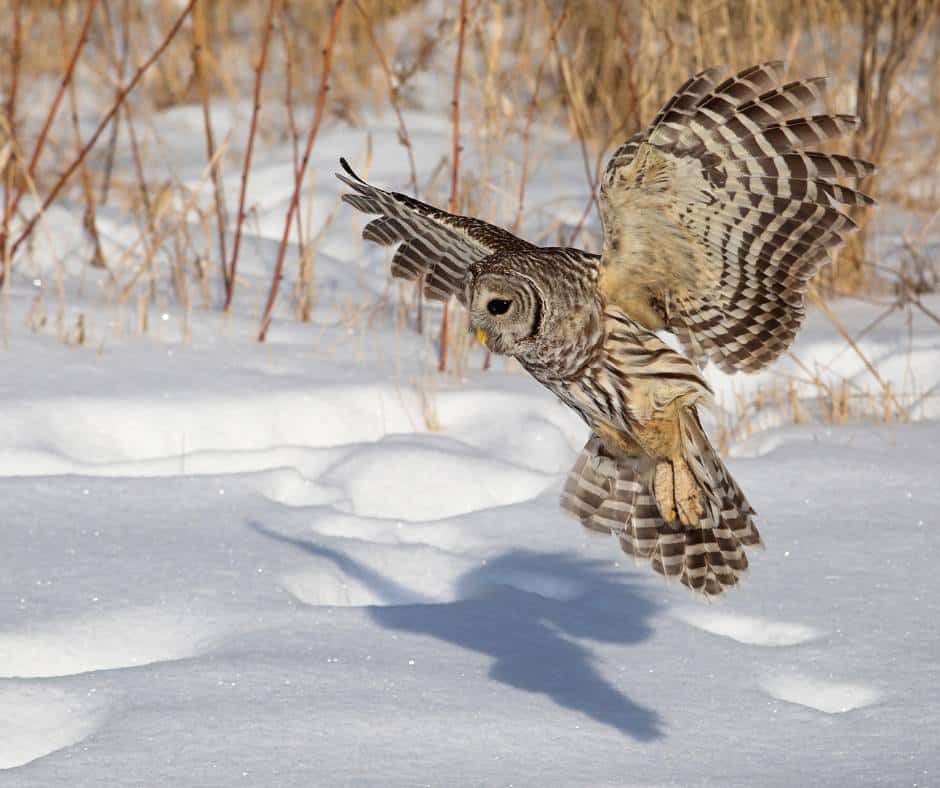
Barred Owls are larger and more aggressive than Spotted Owls. They are also less picky about food options and habitat. Since the Barred Owl entered Spotted Owl habitat, there has been a population decline of the Spotted Owl because they get displaced by the more aggressive owls.
US Fish and Wildlife in currently conducting experiments where they remove the Barred Owls from Northern Spotted Owl habitat to see if that helps the Northern Spotted Owl population grow.
Barred Owls are medium-sized owls. Adults typically measure 16-24 inches in length and have a wingspan of approximately 38-49 inches. They about 1-2.5 pounds and females are generally larger than males.
Barred Owls have a distinctive appearance with a rounded head and no ear tufts. They have large, dark eyes, a pale face with a dark outline, and a hooked beak. Their plumage is primarily brown with horizontal barring on the chest, belly, and wings. The upperparts are mottled brown, while the underparts are lighter with vertical streaks.
These owls are nocturnal, skilled hunters, and primarily feed on small mammals such as mice, voles, squirrels, and rabbits. Barred Owls have a distinctive hooting call, often described as “Who cooks for you? Who cooks for you-all?”
Barred Owls are monogamous and typically mate for life. They nest in tree cavities or abandoned nests of other large birds. The female lays 2-4 eggs which are incubated by both parents for about 28-33 days.
The young owls leave the nest at around 4-5 weeks of age but may continue to be dependent on their parents for several months. They reach maturity after 1-2 years and typically live for 10-15 years in the wild.
Other California Birds of Prey
34. Osprey

Conservation Status of this California Bird of Prey: Osprey are considered a Species of Least Concern.
Where in California can I see Ospreys?
Ospreys can be found throughout California, particularly along the coast, in wetlands, and near bodies of water such as lakes and rivers. The are found south of the Bay Area in the winter, with year-long populations in Marin County and along the Central Coast. They inhabit the northern coastal regions in the summer.
There is also a yearlong population in the lower elevations of the western Sierras, winter population near the Salton Sea, and summer population in the higher elevations of the Sierras.
Osprey Description and Identification Tips
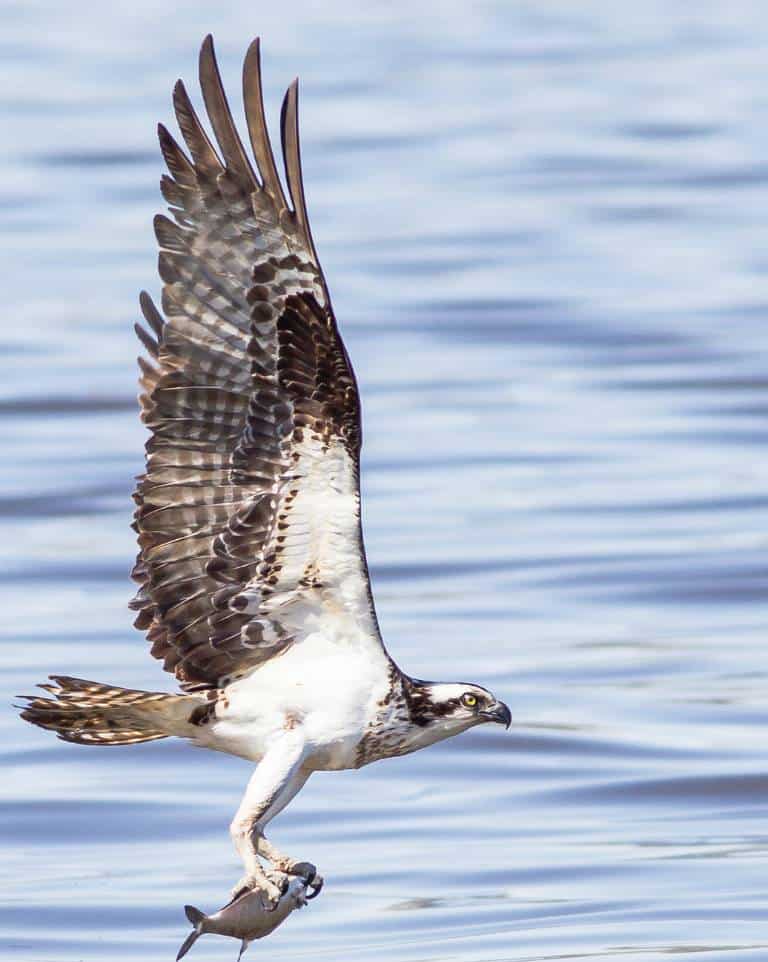
While the Osprey is often referred to as a “fish hawk” or “sea hawk,” it is not a true hawk. Taxonomically, it belongs to its own unique family called Pandionidae. They are large birds of prey with a wingspan of around 4 to 6 feet, body length of nearly two feet, and weight of 3-4.5 pounds.
They have a distinctive appearance with dark brown upperparts and white underparts. Ospreys have a white head and breast with a dark eye stripe extending down to the side of their neck. They also have long, narrow wings and a hooked beak for capturing and feeding on fish.
Ospreys are well adapted for catching fish. They are primarily associated with freshwater or saltwater habitats near bodies of water, such as lakes, rivers, estuaries, and coastal areas.
They have reversible outer toes that allow them to grasp fish with two toes in front and two toes in the back. They are excellent hunters and can spot fish from high above in the air. Ospreys perform dramatic dives, called “plunging dives” or “fish dives,” into the water to catch fish, and then they carry their prey with their feet to take it to a safe place to eat.
Ospreys are monogamous and usually mate for life. They build large nests, called eyries, on high structures such as trees, cliffs, or man-made platforms. Both the male and female participate in nest construction. The female lays 2 to 4 eggs, and both parents take turns incubating them, which typically takes about 5 to 6 weeks. They reach sexual maturity at 3-4 years and live for 10-15 years.
]]>Here are 25 animals you may encounter while in Death Valley National Park. Some of these animals are more elusive than others, but all of them call this desert park home. This is not an exhaustive list of animals that are seen in the park. There are several more rodents, birds, reptiles, and insects that call it home as well.
25 Animals in Death Valley
Coyote

Coyotes are a common sight in Death Valley National Park which is no surprise since they are one of the most adaptable and widespread mammals in North America. Coyotes can be found all throughout the park and are highly intelligent and resourceful.
are opportunistic feeders which means they will eat just about anything incluing small mammals, insects, prickly pear fruit, carrion and whatever humans leave behind at picnic spots and campsites.
The coyote in the photo above actually ran alongside our car while we were driving on Badwater Road. It was clear that it had previous success with roadside begging because it was completely unafraid of our vehicle.
Feeding coyotes is dangerous for many reasons. 1. The park’s coyotes can become dependent on humans for food. 2. It can lead to human/animal encounters that lead to human injury from an overly aggressive or hungry wild animal 3. The practice of running up to cars will surely lead to more coyotes being hit and killed by vehicles inside the park.
Coyotes are most active during the early morning and late evening hours, and are often heard howling at night, but as you can see from the photo above, they have no qualms about showing their faces in braod daylight if the possibility of food is involved.
Like birds of prey? Here are all the different hawks in Southern California.
Desert Tortoise
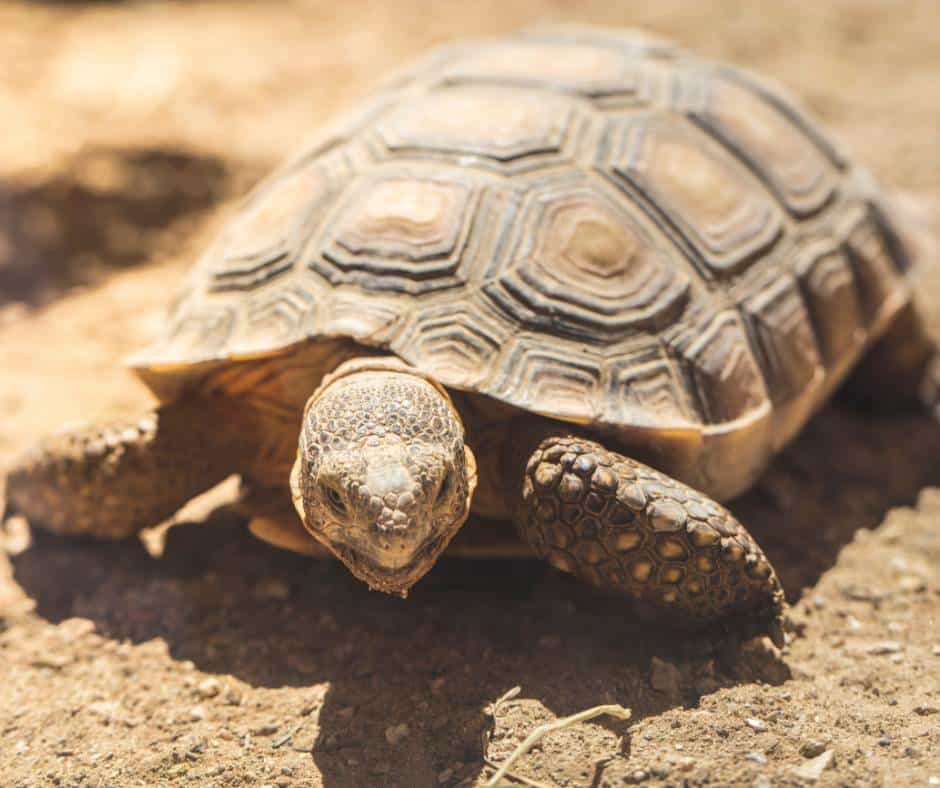
The desert tortoise is a species of turtle that is native to the Mojave and Sonoran deserts of North America, including Death Valley National Park. These tortoises are known for their long lifespan, and many live to be up to 100 years old!
Desert tortoises are listed as a “threatened species” under the Endangered Species Act, and populations in Death Valley National Park have been impacted by habitat loss, disease, and human disturbance. To help protect the desert tortoise and its habitat, the National Park Service has implemented a number of measures, including monitoring populations, enforcing strict regulations on human activity in tortoise habitat areas, and working to control the spread of diseases that can impact the tortoises.
The desert tortoise spends most of their lives in burrows and are completely inactive from November through February. For the rest of the year they do come out for a short period each day to eat, avoiding excessive highs and lows in temperature since they are unable to regular their body temperature on their own.
They are especially active on warm, overcast days. If it rains, the tortoises will also come out to drink water that has gathered in small pools. The desert can go through extended periods of drought, and theses reptiles have developed an adaptation that allows them to store water in their bladders.
Since desert tortoises are soil-colored and rather small (2-15 inches in length), they can be quite hard to spot. They can be found in rocky areas, canyons, and washes where they seek out shelter from the hot sun and access to water sources. They are primarily herbivores, feeding on a variety of plants, including grasses, cacti, and wildflowers.
Visitors to Death Valley National Park may be able to see desert tortoises in the wild, but it’s important to remember that they are a protected species and it is illegal to touch or disturb them. Some of the most common places to see desert tortoises in Death Valley National Park include:
- Mesquite Flat Sand Dunes where tortoises often seek shelter under the brush and cacti that grow in and around the dunes.
- Scotty’s Castle: the historic site located in the northern part of the park is a popular spot for visitors to see tortoises crossing the road or basking in the sun on nearby rocks.
- Titus Canyon: Visitors may spot tortoises near the creek bed or along the canyon walls.
- Wildrose Canyon: This remote canyon is home to a small population of desert tortoises which live in the rocky terrain and among the desert vegetation.
Desert Bighorn Sheep
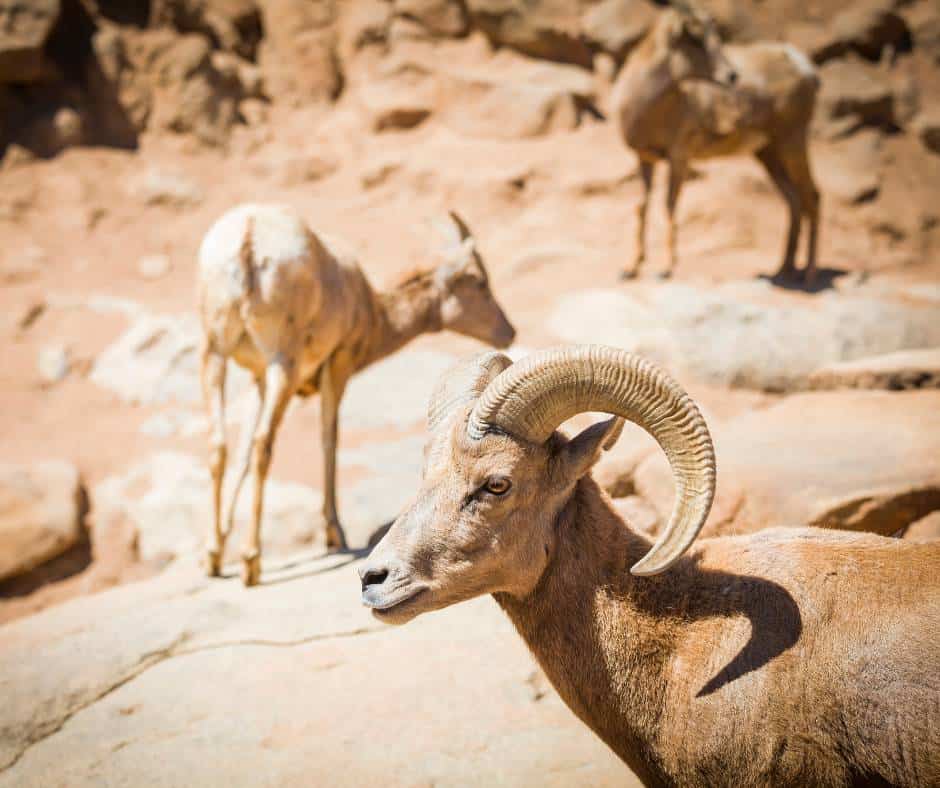
Desert bighorn sheep are one of the most iconic animals that call Death Valley National Park home. These magnificent animals are well adapted to the harsh desert environment and are known for their impressive climbing abilities and keen senses.
Bighorn sheep are most often found in the mountains and canyons throughout the park, where they seek out areas with rocky terrain and water sources. It is especially important for them to drink water during the brutal summers, and these sheep are known to drink gallons at a time before leaving a water source.
They are primarily herbivores, feeding on a variety of plants, including cactus, shrubs, and grasses. Their complex digestive system allows them to eat plants like mesquite which many other herbivores mightnot be able to digest.
Bighorn sheep are known for their impressive horns, which can weigh up to 30 pounds in males and are used for defense and dominance displays during mating season. Males can weigh up to 250 pounds, while females are generally smaller, weighing around 125 pounds.
Bighorn sheep stick to rocky terrain where their agility can help them escape predators, such as coyotes, who are looking to snag a lamb. Lambs have a 50% chance of surviving their first year of life but if they do, they often live 10-15 years.
Visitors to Death Valley National Park can often catch a glimpse of bighorn sheep from a distance, but it is important to remember to give them plenty of space and not disturb them in their natural habitat.
They are most commonly seen in the higher elevations of the park such the Panamint Range, the Cottonwood Mountains, and the Grapevine Mountains. You may also spot them in canyons like Wildrose Canyon, Emigrant Canyon, Titus Canyon, and Grapevine Canyon.
Mule Deer

Mule deer are a common sight in Death Valley National Park’s higher elevations where there is more vegetation and water sources such as the Panamint, Cottonwood, and Grapevine Mountains These large, graceful animals are named for their long ears, which resemble those of a mule.
Mule deer are herbivores, feeding on a variety of vegetation including grasses, shrubs, and wildflowers. They are active throughout the day, but tend to be most active during the early morning and late afternoon hours.
Mule deer are occasionally seen in the area around Furnace Creek, particularly in the early morning or late afternoon hours when they are most active. They are also sometimes spotted around Scotty’s Castle where deer may be seen crossing the road or grazing in nearby meadows.
Death Valley is one of 12 national parks within a days drive of San Diego.
Desert Kangaroo Rats
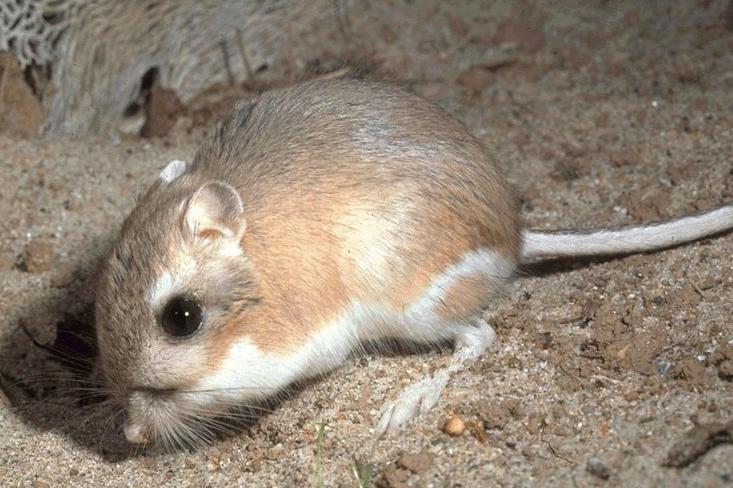
The desert kangaroo rat is a small rodent that is native to the deserts of Death Valley National Park. These rats have adapted to the harsh desert environment and are able to survive on very little water, obtaining most of their moisture from the seeds and plants that they eat.
Desert kangaroo rats are primarily active at night, when the temperatures are cooler. They have large hind legs that are adapted for jumping, and are able to cover long distances in search of food and water. They are also known for their ability to avoid predators, using their sharp senses to detect and evade danger.
Visitors to Death Valley National Park may be able to spot desert kangaroo rats at night, particularly in areas where there is vegetation and a source of water. They may also be seen darting across the desert floor, as they move between burrows and feeding grounds.
Chuckwallla
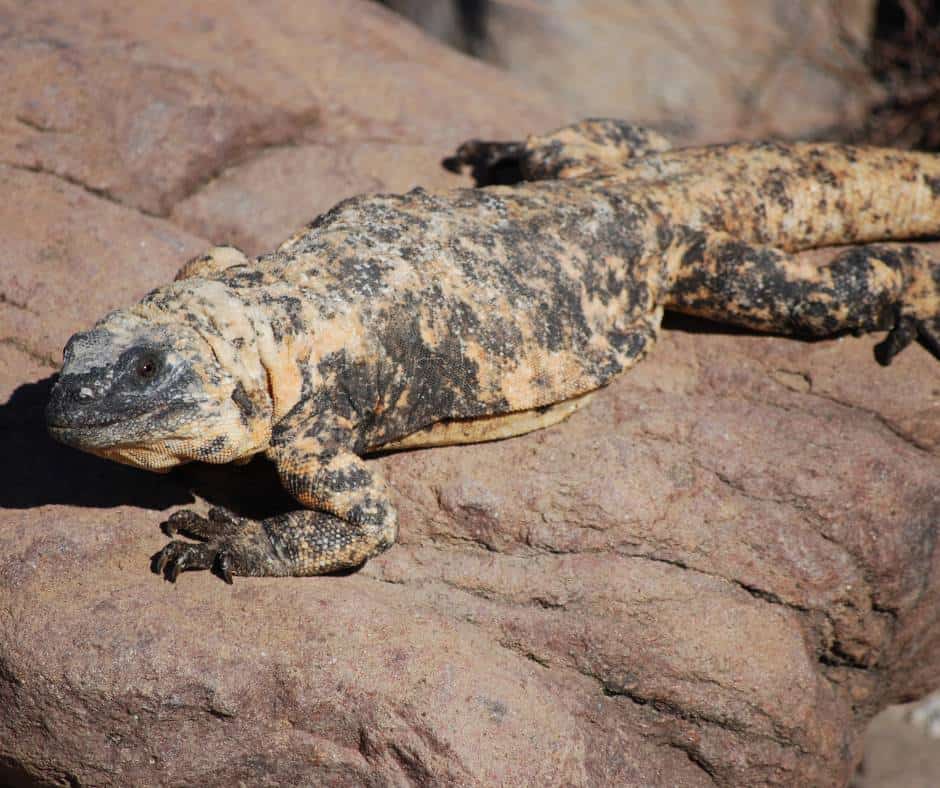
The chuckwalla is a species of lizard found in the southwestern part of the United States, including Death Valley National Park. They are known for their unique appearance, with a stocky body and prominent folds of skin around their neck and shoulders.
In Death Valley, the chuckwallas can often be found basking on rocks or hiding in crevices to avoid the extreme heat of the desert. They are primarily herbivorous, feeding on a variety of plants and occasionally insects.
The chuckwalla has a unique defense mechanism called “tail autotomy,” which allows it to break off its tail if it is caught by a predator. The detached tail will continue to wiggle, distracting the predator while the chuckwalla makes its escape.
These lizards are often brown or gray in color, blending in with their desert surroundings. They can grow up to 16 inches in length and have a lifespan of up to 25 years.
Visitors to Death Valley National Park may be able to spot chuckwallas while hiking or driving through the park, especially in rocky areas or along canyon walls. They are often found basking in the sun on large rocks, especially in the morning hours.
They can be spotted on the rocks around Mesquite Flat Sand Dunes, Mosaic Canyon, Titus Canyon, and around the park’s other canyons and rock formations. They can also be seen along hiking trails, such as the Golden Canyon Trail, Gower Gulch Loop Trail, and Zabriskie Point.
Chuckwallas are generally shy and prefer to avoid humans, so visitors may need to be patient and observant to spot them in their natural habitat. They will hibernate during the winter but are active in high desert temperatures, up to about 102 degrees.
Black-tailed Jackrabbit
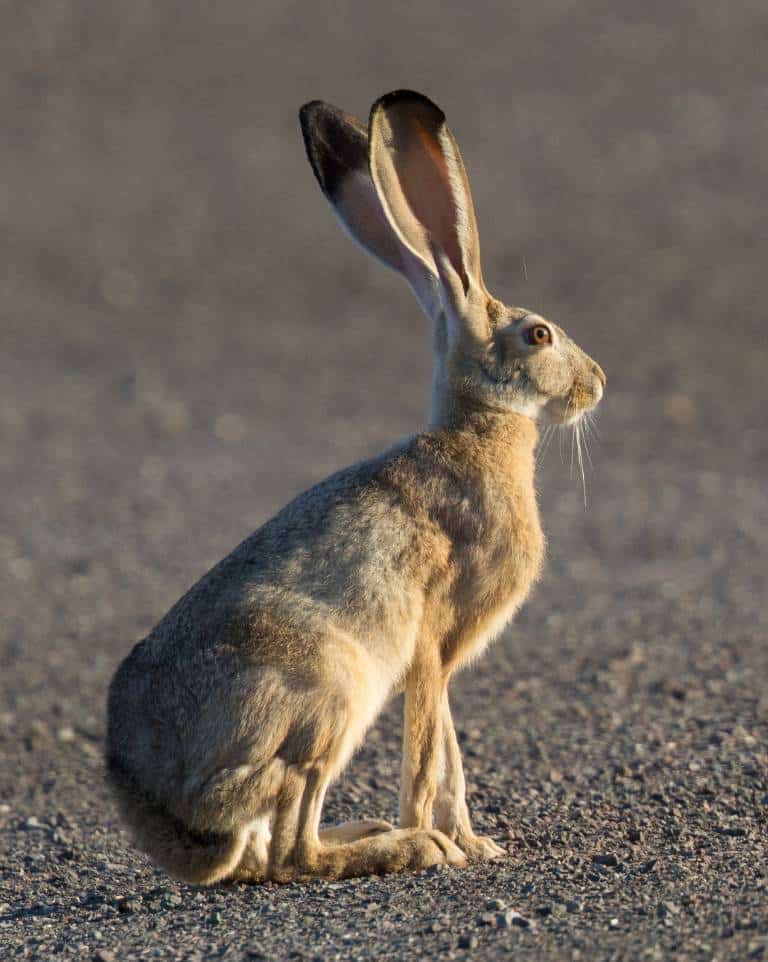
The black-tailed jackrabbit is a common species found in the deserts of California, including Death Valley National Park. They are known for their long ears, powerful hind legs, and distinctive black tail.
In Death Valley National Park, black-tailed jackrabbits are found in a variety of habitats, including desert scrub, grasslands, and rocky areas. They are herbivores, feeding on a variety of plants including grasses, shrubs, and cacti.
Black-tailed jackrabbits are active during the day and are most commonly seen in the early morning or late afternoon hours. They are able to run at speeds of up to 40 miles per hour, which allows them to quickly evade predators such as coyotes and bobcats.
Visitors to Death Valley National Park may be able to see black-tailed jackrabbits in the wild, particularly in the park’s more open and arid areas. One of the most common places to spot them is the Mesquite Flat Sand Dunes where they may be seen hopping through the sand or among the desert vegetation. They can also been along the edges of the salt flat in Badwater Basin and in the canyons and washes of the Stovepipe Wells area.
Desert Cottontail
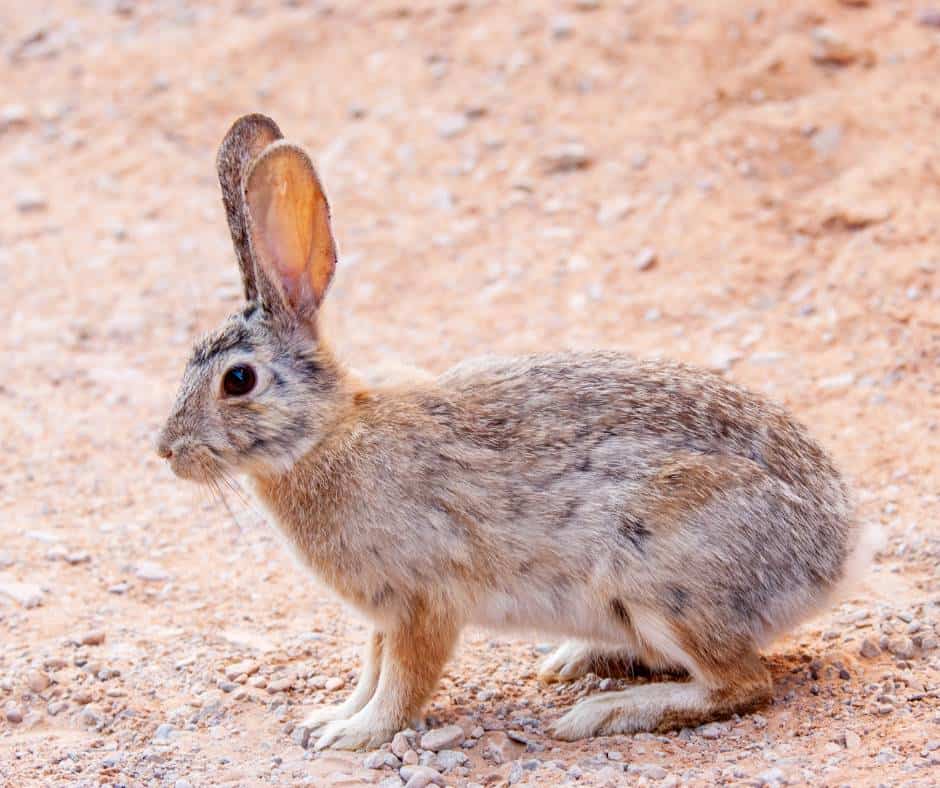
The Desert Cottontail is a common species found in Death Valley National Park. They are a small species of rabbit known for their soft, cotton-like tail and brown or gray fur.
Desert Cottontails are found in a variety of habitats, including desert scrub, grasslands, and rocky areas. They feed on a variety of plants including grasses, shrubs, and cacti They are active during the day and are most commonly seen in the early morning or late afternoon hours. They are able to run at speeds of up to 20 miles per hour.
Visitors to Death Valley National Park may be able to see Desert Cottontails in the wild, particularly in the park’s more open and arid areas. As with all wildlife, it is important to observe them from a safe distance and not to approach or disturb them.
Like the jackrabbit, the cottontail is seen near Mesquite Flat Sand Dunes, Badwater Basin, and Stovepipe Wells. Also keep an eye out for them while visiting Harmony Borax Works. Visitors may see them around the ruins or along the nearby dirt road.
Mojave desert sidewinder rattlesnake
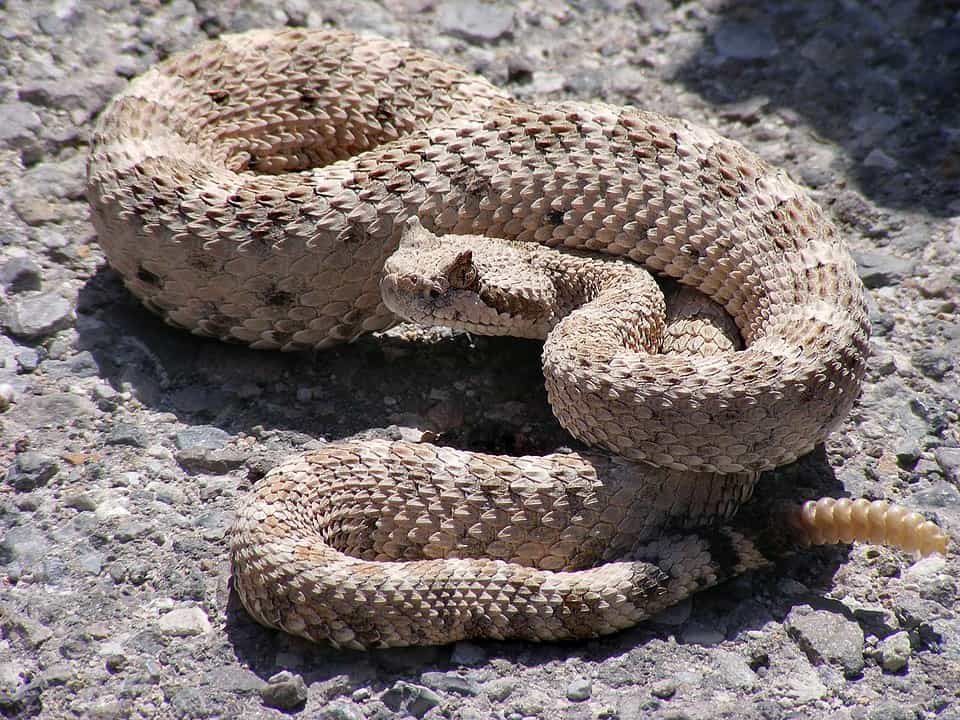
There are nearly 20 different species of snakes that live in Death Valley and you can read about all of them in my extensive guide to the snakes of Southern California. I am going to point out three of the most commonly seen snakes inside Death Valley National Park.
The Mojave desert sidewinder rattlesnake is a venomous snake native to the Mojave and Sonoran deserts, including Death Valley National Park. It gets its name from the distinctive way it moves sideways, with only two points of contact on the ground at any given time, allowing it to move quickly and efficiently across loose sand.
Mojave desert sidewinder rattlesnakes are typically tan or pale brown in color, with darker brown or black diamond-shaped markings along their backs. They are relatively small, typically growing to a length of around two to three feet.
While Mojave desert sidewinder rattlesnakes are venomous, they are generally not aggressive towards humans and will typically try to avoid confrontation if possible. The best places to spot these snakes are in the lower elevations of the park, particularly in areas with loose sand and sparse vegetation. They are most active in the early morning and late afternoon.
Rosy Boa
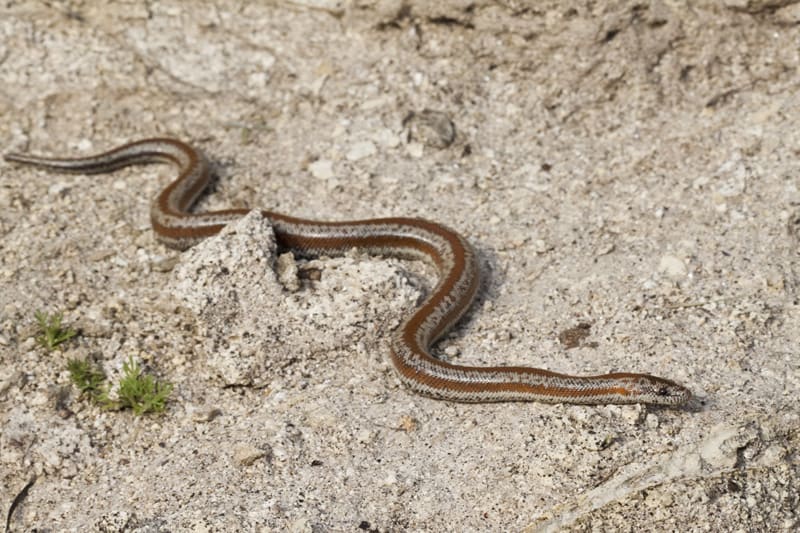
The Rosy Boa is a non-venomous snake species found in Death Valley. These snakes are easily recognized by their characteristic pinkish to reddish-brown dorsal coloration with dark brown or black markings on their back and sides, and a lighter pinkish coloration on their belly.
Rosy Boas are relatively small, with adults typically reaching lengths oftwo to three feet. They are active during the evening and at night, spending most of the day hiding under rocks or in burrows to avoid the heat of the sun. These snakes are carnivorous, feeding primarily on small rodents, lizards, and other snakes.
Rosy Boas are docile and gentle snakes, making them popular as pets, but snakes should never be taken from the wild. These snakes spend most of their time underground, preferring rocky habitats, including boulder piles and crevices, as well as desert scrubland and sandy washes.
Great Basin Gopher Snake
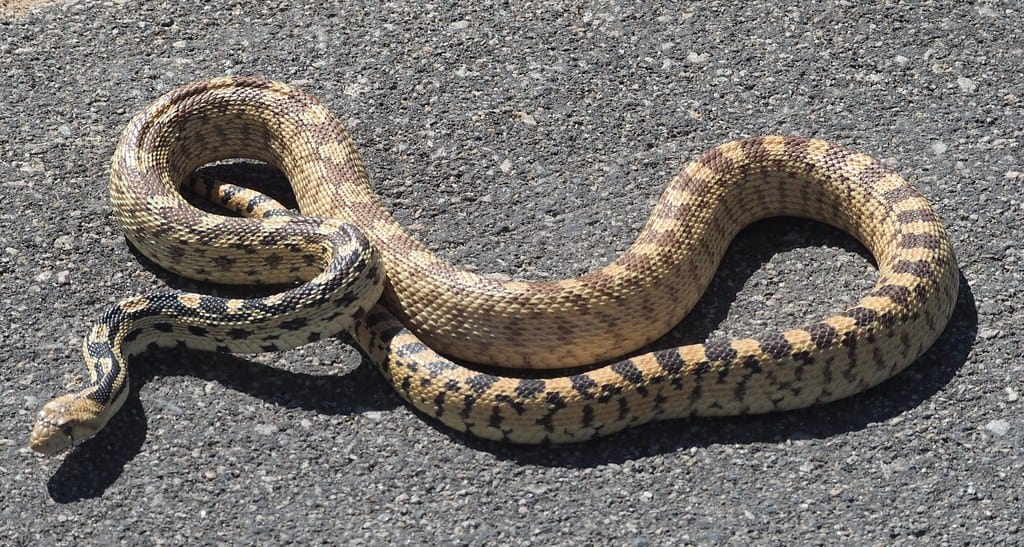
The Great Basin Gopher Snake is a non-venomous snake that grows up to six feet in length. They are primarily found in areas with dry, rocky terrain, such as desert grasslands, sagebrush plains, and rocky hillsides. In Death Valley National Park, they are commonly seen in the higher elevation areas, such as the Panamint Mountains and the Grapevine Mountains.
Great Basin Gopher Snakes are known for their distinctive patterns and colors, which can vary depending on the individual snake and its location. They are usually tan or brown in color with dark brown or black markings that run along their back and sides. They can be mistaken for rattlesnakes but these snakes have no rattle and are not venomous.
The Great Basin Gopher Snake is a carnivore and feeds on a variety of prey including rodents, birds, lizards, and other snakes. They are constrictors, meaning they wrap their bodies around their prey and squeeze until they cannot breathe.
In Death Valley National Park, the best place to spot the Great Basin Gopher Snake is in rocky areas and canyon floors, such as Mosaic Canyon, Titus Canyon, and Golden Canyon. You may also spot them along the trails that lead to the park’s high-elevation peaks, such as Telescope Peak or Wildrose Peak.
Another popular location to see Great Basin Gopher Snakes is along the park’s main roads, particularly in the areas where the road cuts through rocky terrain. These snakes can often be seen basking on the warm pavement during the cooler morning hours so keep an eye out as you drive!
Panamint Rattlesnake

The Panamint Rattlesnake is a rattlesnake found in the Panamint Mountains of Death Valley National Park. It lives on rocky slopes, in canyons, and in the shrublands this arid desert range.
This rattlesnake has a slender body with a distinct diamond-shaped pattern along the back. The coloration of the snake varies, but it typically has a gray or brownish background color with dark brown or black blotches bordered by lighter edges. Adults are usually 3 to 4 feet in length.
The Panamint Rattlesnake is venomous and has a rattle at the end of its tail warning you not to touch. If you get bit by a rattlesnake, seek medical attention immediately.
They are primarily nocturnal and secretive, spending much of their time hidden under rocks or in crevices during the day. They feed on small mammals, lizards, birds, and other snakes.
The Panamint Rattlesnake is considered a species of conservation concern due to its restricted range and habitat fragmentation. It is protected under California state law, and efforts are being made to conserve its habitat and monitor its populations.
Pocket Gophers
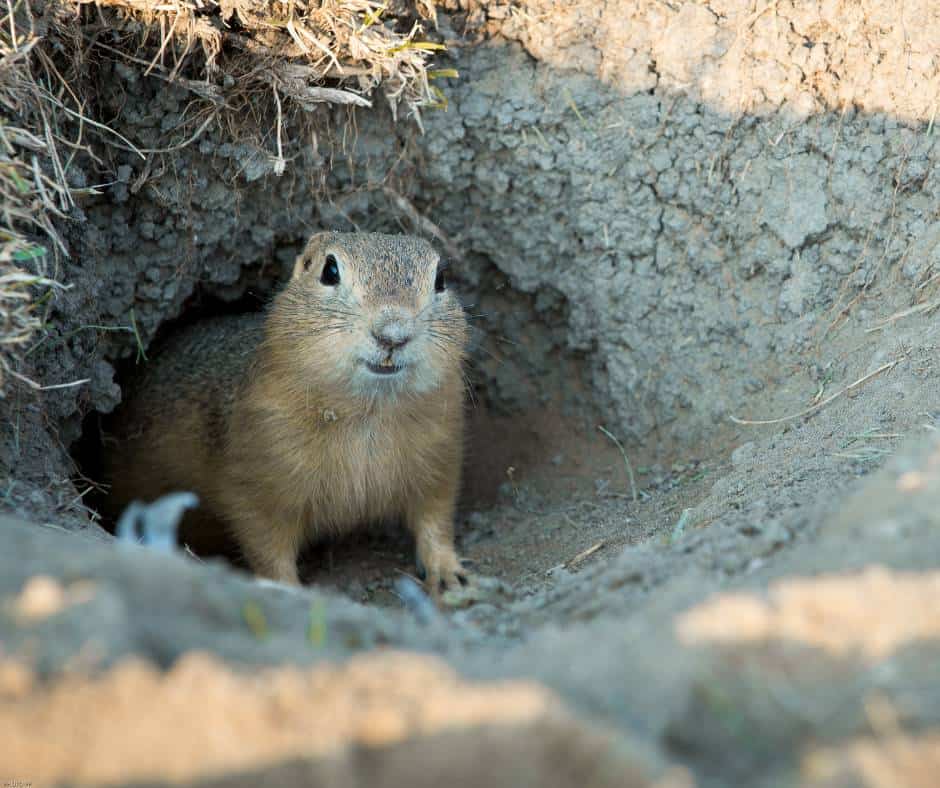
Pocket gophers are small burrowing rodents that are found in Death Valley National Park. These animals are known for their extensive tunneling systems, which they use to obtain food, create shelter, and navigate through their environment.
In Death Valley, pocket gophers are found in a variety of habitats, including desert scrub and open grasslands. They are important ecosystem engineers, as their burrowing helps to aerate the soil, increase water infiltration, and mix organic matter into the soil.
Visitors to Death Valley National Park are unlikely to see pocket gophers, since they spend most of their time underground. However, they may be able to observe their tunneling activity, which is often visible on the surface as mounds of soil or disturbed vegetation.
Ground Squirrel
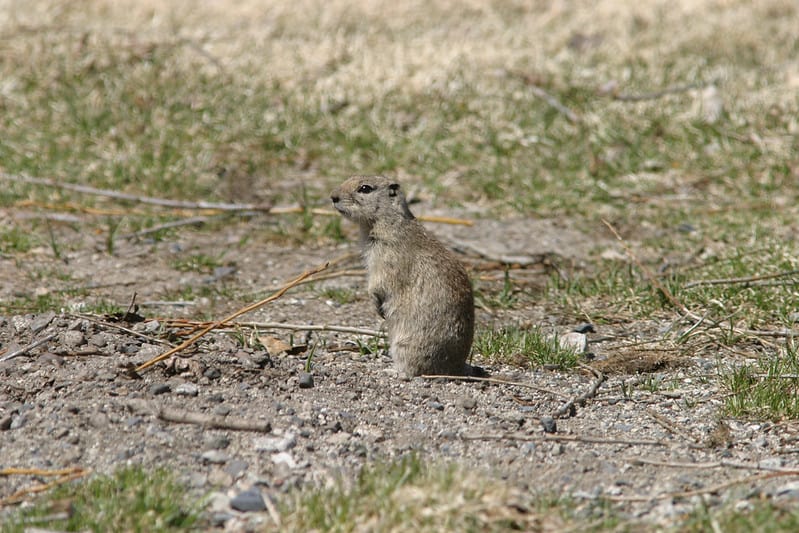
Several species of ground squirrels can be found in Death Valley National Park, including the golden-mantled ground squirrel, the rock squirrel, and the round-tailed ground squirrel. These small rodents are adapted to the desert environment and play an important role in the park’s ecosystem.
Ground squirrels are diurnal, meaning they are active during the day, and can often be seen foraging for food or sunning themselves on rocks or logs. They eat a variety of foods, including seeds, nuts, fruits, and insects.
Visitors to Death Valley may encounter ground squirrels in campgrounds, picnic areas, or along hiking trails. While they may seem cute and harmless, it is important to remember that feeding wildlife is always a bad idea. Feeding ground squirrels can cause them to become habituated to humans, and can also lead to aggressive behavior or the spread of disease like the bubonic plague.
Kit Fox
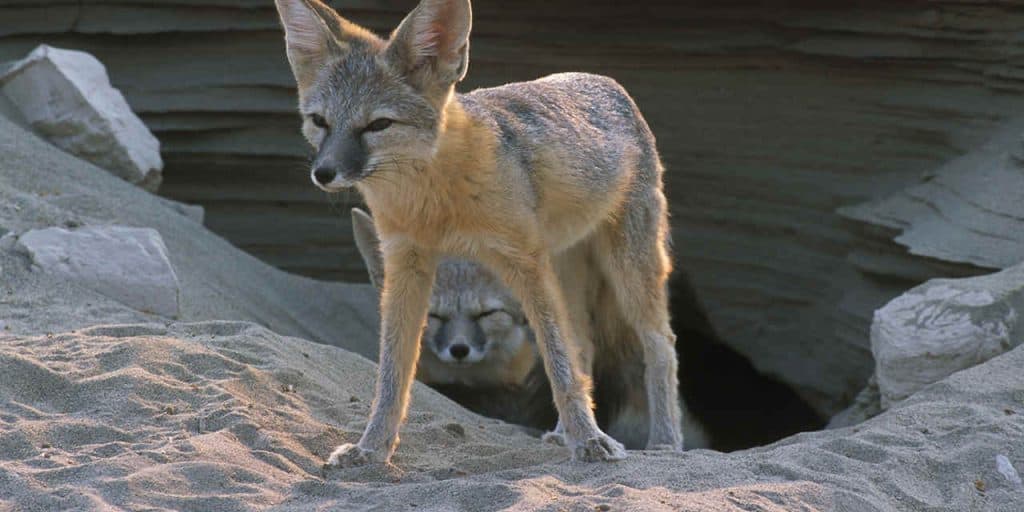
The kit fox is a small, nocturnal canid that can be found in the Mojave Desert, including in Death Valley National Park. They are typically found in arid environments with sparse vegetation, where they feed on small mammals, insects, and fruit.
The kit fox is an important part of the desert ecosystem and helps to control rodent populations. They are also a key prey species for larger predators, such as coyotes and golden eagles.
Kit foxes are well adapted to the harsh desert environment and have several physical and behavioral adaptations that help them survive. For example, they have large ears that help them regulate their body temperature and locate prey, as well as thick fur that insulates them from the extreme temperatures of the desert.
While kit foxes are relatively common in Death Valley National Park, they can be difficult to spot due to their nocturnal habits and the fact that they are generally shy and elusive. Visitors to the park may have the best chance of seeing kit foxes at dawn or dusk, when they are most active. They have been most commonly spotted in the Mesquite Flat Sand Dunes, the Ubehebe Crater area, or along the park’s perimeter.
Gray Fox
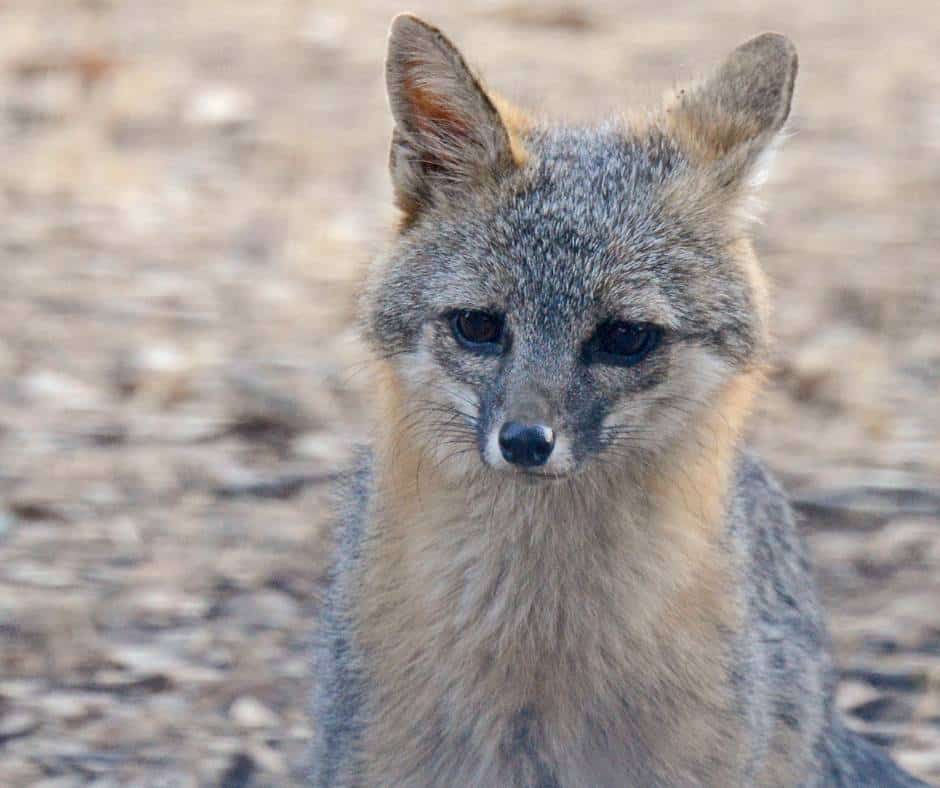
The gray fox is a small to medium-sized canid that can be found throughout much of North America, including the mountainous areas of Death Valley National Park. They are typically found in woodlands, chaparral, and other areas with dense vegetation, where they feed on small mammals, birds, and reptiles.
Gray foxes are notable for their climbing abilities, which are unusual for a member of the canid family. They are able to climb trees and other vertical surfaces using their strong claws and flexible ankles, allowing them to escape predators or access food sources that other animals cannot reach.
In Death Valley National Park gray foxes are most often seen in the Panamint Range and the Grapevine Mountains. They are primarily nocturnal, and are most active at night when they hunt for food.
Badger
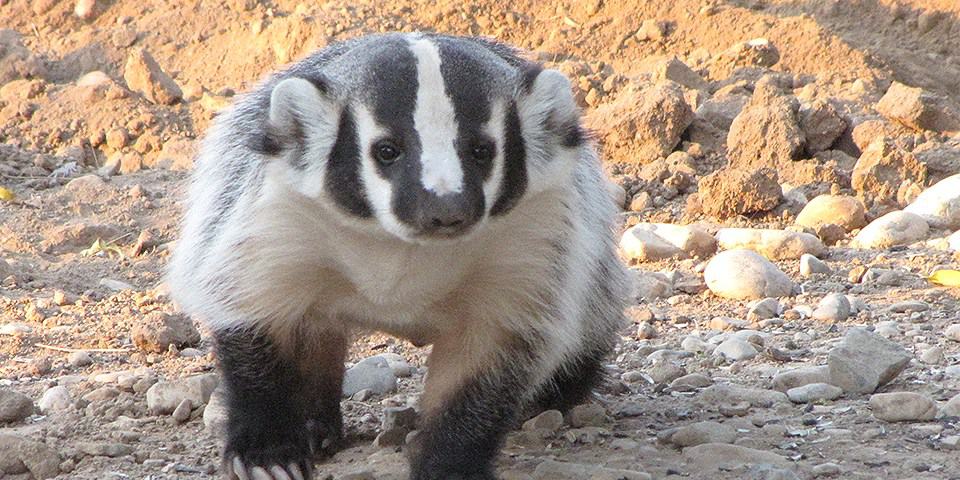
The American badger is a carnivorous mammal known for their stocky, powerful build, and their ability to dig and burrow in search of prey.
In Death Valley National Park, badgers can be found in a variety of habitats, from sandy desert flats to rocky mountain slopes. They are primarily nocturnal and are most active at night when they hunt for prey such as rodents, reptiles, and small mammals.
Visitors to the park may have the opportunity to see badgers while driving or hiking in the early morning or late evening. However, badgers are typically shy and elusive, and are more likely to be heard than seen.
Bobcat

Bobcats are small to medium-sized wild cats that live in Death Valley National Park. They are generally shy and elusive animals, and are most active during dawn and dusk, although they may be active at any time of day.
In Death Valley, bobcats can be found in a variety of habitats, including desert scrub, rocky canyons, and pinyon-juniper woodlands. They are opportunistic hunters and prey on a variety of small mammals, birds, and reptiles, as well as insects and other invertebrates. They may also scavenge on carrion.
They can be difficult to spot due to their secretive nature and their excellent camouflage. However, visitors may be able to spot them at dawn or dusk, especially in areas where prey is abundant. They may also be seen crossing roads or hiking trails, or resting in the shade of rocks or vegetation during the heat of the day.
Burros
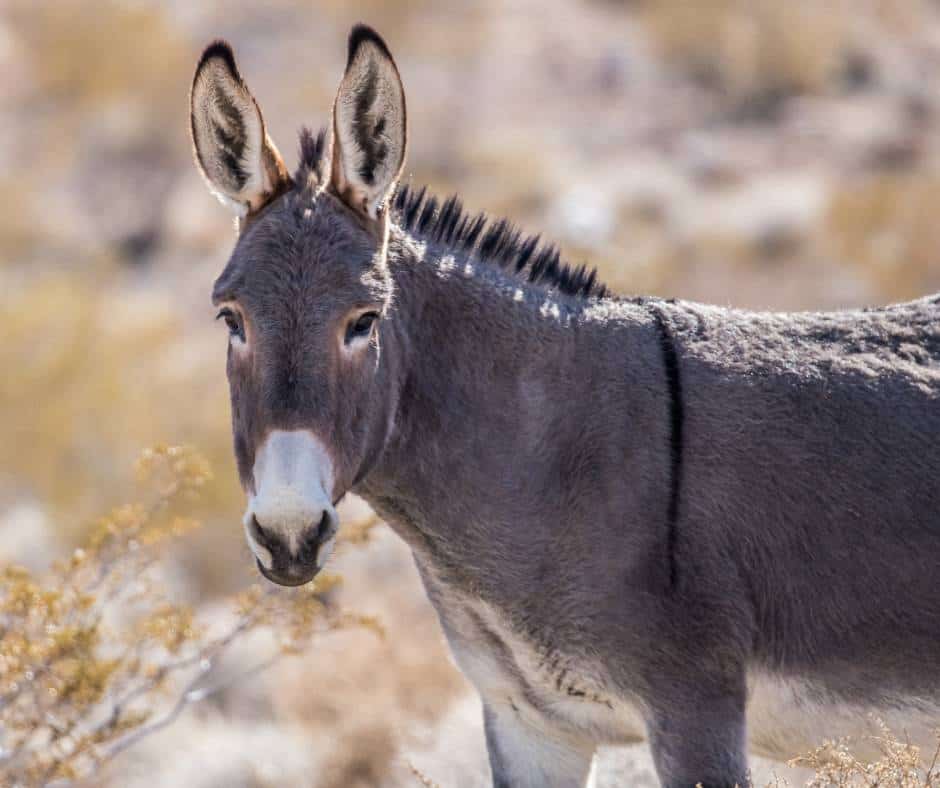
The burro, in Death Valley National Park are descendants of the pack animals brought to the area during the mining era. They are an iconic part of the park’s history and landscape but they are also considerd an invasive species. Today, they experience a population growth of 20% per year!
Burros roam freely throughout the park and can often be seen along the park’s scenic drives and in the surrounding desert areas. They cause damage to the native vegetation and fragile ecosystems as they eat 6,000 pounds of plants per burro per year and compete with native species about desert tortoises and bighorn sheep for resources.
Attempts to remove the burros come at a great cost. In the 1980s $400,000 was spent on a 32 mile fence along the park’s northeastern border. It was ineffective. Useing helicopters to move burros costs about $1,000 per hour- not exactly budget friendly. So, for now, the burros stay.
While these burros may appear friendly, it is important to remember that they are wild animals and should be treated with caution. Feeding or approaching them can be dangerous, and visitors are advised to observe them from a safe distance. It is also illegal to capture, feed, or harass the burros.
Visitors to the park may encounter the burros on the popular Wildrose Charcoal Kilns road or in areas such as Titus Canyon, where the animals sometimes gather around the spring. The burros can also be seen at Furnace Creek Ranch and Stovepipe Wells Village, where they occasionally wander into the parking lots.
Pupfish
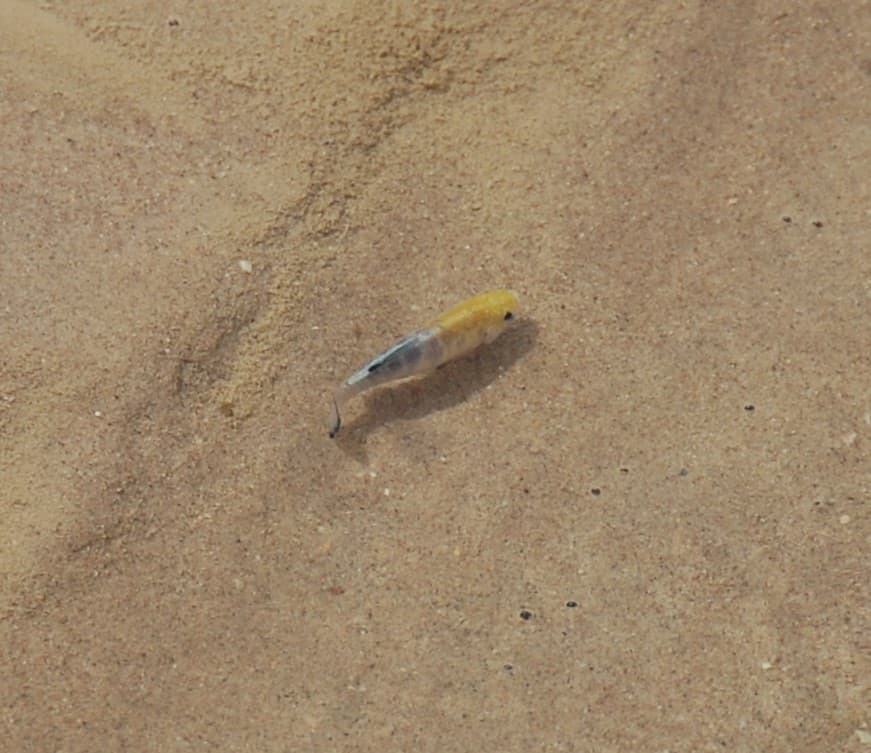
Yes, there are fish in the desert! There are actually several species of pupfish found in Death Valley, all of which are adapted to the extreme conditions of the park’s waterways. These include the Salt Creek pupfish, the Devils Hole pupfish, the Cottonball Marsh pupfish, and the Amargosa pupfish.
The Salt Creek pupfish lives in the shallow, warm waters of Salt Creek and can tolerate high levels of salt and temperatures up to 104°F. They feed on algae and small aquatic insects and have a distinctive breeding behavior where males dig shallow nests in the sand and attract females by flashing their brightly colored fins.
There was a boardwalk known as the Salt Creek Interpretive trail that allowed for easy viewing of the fish in winter and spring but it was destroyed by a massive flash flood in August of 2022. They flood alteres the creek bed and surrounding are and it will take some time to get things rebuilt.
The Devils Hole pupfish, found only in the Devils Hole pool in the Amargosa River basin, is one of the most endangered fish species in the world. They are adapted to the constant, warm temperatures of the pool and have a specialized diet of blue-green algae. hey are heavily protected by park rangers.
A recent study by national park service scuba divers shows that there are about 175 Devils Hole pupfish, up from the low of 35 in 2013.
The Cottonball Marsh pupfish, found in the springs and marshes near the Nevada border, is one of the largest pupfish species in the park and is known for its bright blue coloration during breeding season. They are found in Cottonball Marsh on the west side of central Death Valley.
Finally, the Amargosa pupfish, found in the Amargosa River system, is also adapted to high temperatures and salt levels. They are small and relatively plain in appearance, but are important indicators of water quality in the region. Found in the Amargosa River northwest of Saratoga Springs.
Horned Lizard
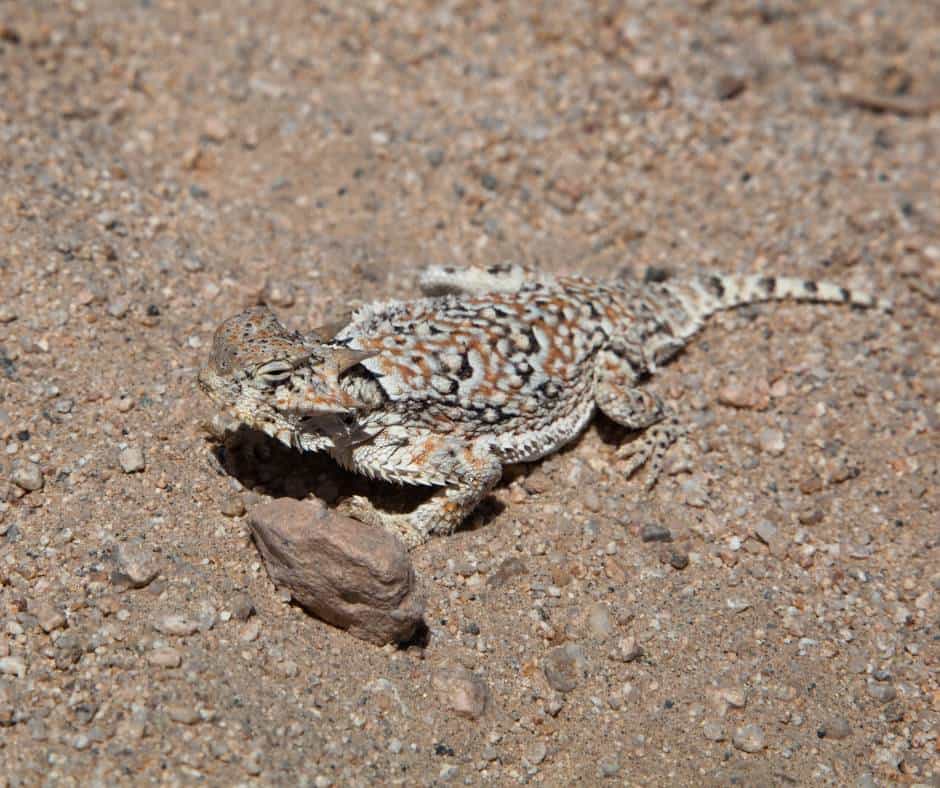
The horned lizard, also known as the horny toad or the horned desert lizard, is a common sight in Death Valley National Park. These unique lizards are easily identified by their distinctive body shape and the rows of horns on their heads and backs.
This small reptile typically grows to be around three to five inches long. They are well adapted to life in the desert, with a wide, flattened body that helps them stay close to the ground and avoid the intense heat of the sun. Their skin is covered in a series of bumpy scales, which help to protect them from predators and conserve water.
One of the most interesting things about the horned lizard is its unique defense mechanism. When threatened, the lizard will puff itself up with air, making it appear larger and more intimidating to predators. Some species of horned lizard are also able to shoot blood from their eyes as a way of deterring predators.
In Death Valley National Park, horned lizards can be found in a variety of habitats, from rocky outcroppings to sandy washes. They are most commonly spotted in the early morning and late afternoon, when they are most active. Look for these fascinating reptiles in rocky areas, or near the base of shrubs and other vegetation.
One of the best places to look for horned lizards in Death Valley is around Mesquite Flat Sand Dunes. Here, visitors may spot the desert horned lizard, which has a distinct pattern of black and white spots and stripes that help it blend in with the sand. Horned lizards can also be found in other areas of the park, including Wildrose Charcoal Kilns and around the Furnace Creek area.
Zebra-tailed Lizard

The zebra-tailed lizard, also known as the “tiger lizard,” is a small species of lizard found in Death Valley. They are easily identified by their distinctive black and white striped tails, which resemble those of a zebra.
These lizards are well adapted to the harsh desert environment, with their flat bodies allowing them to easily move over loose sand and rocky terrain. You may also see them on washes or on the edge of roads. They are primarily active during the daytime, and are often seen basking in the sun or seeking shade under rocks or other objects.
In Death Valley National Park, they can be found in areas with loose sand and rocky outcroppings, such as the Mesquite Flat Sand Dunes and the Badwater Basin. Another great place to see zebra-tailed lizards is in the hills around Titus Canyon.
Zebra-tailed lizards feed primarily on insects such as grasshoppers, beetles, and ants. They are also known to occasionally eat other small lizards.
Desert Iguana
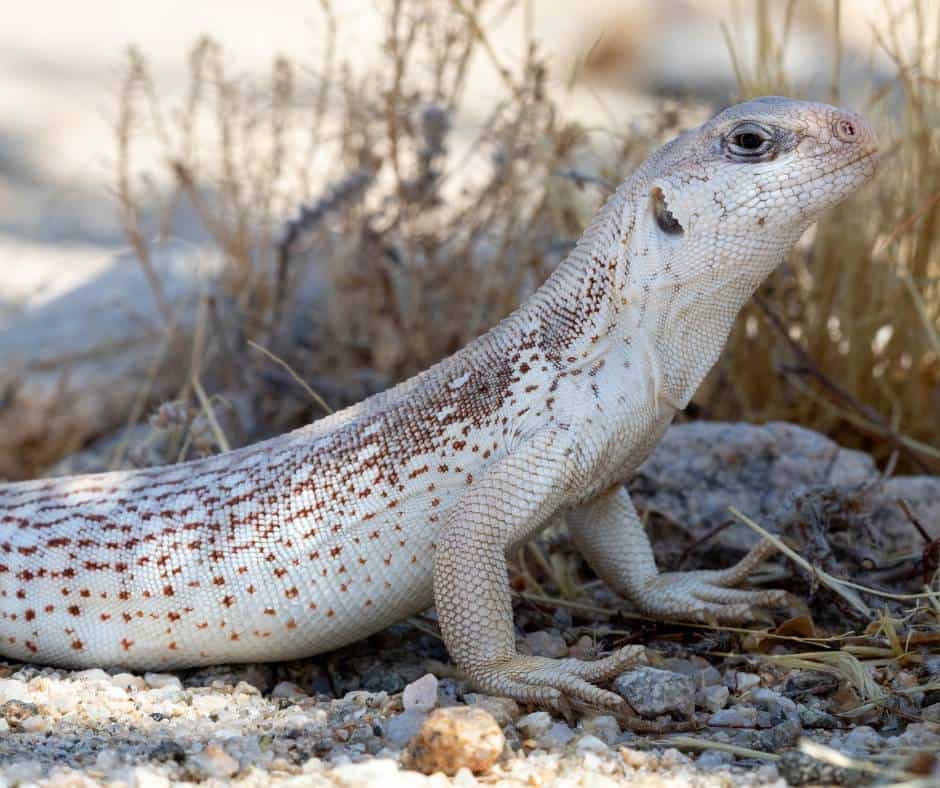
The Desert Iguana is a common lizard species found in Death Valley. It is a medium-sized lizard that can grow up to 10 to 16 inches in length, with a relatively flat body, and a long tail that makes up two-thirds of its total length. They have a unique coloration, with a tan or gray body, and dark spots or stripes on the back, making them well-camouflaged against the sandy desert terrain.
The Desert Iguana is a diurnal reptile, meaning that it is active during the day and rests at night. They are primarily herbivores and feed on various desert plants, such as cactus, flowers, and leaves. However, they occasionally consume insects and other small animals.
During the breeding season, which occurs in the spring and early summer, the male Desert Iguana becomes territorial and will engage in head-bobbing and push-up displays to establish dominance over other males. Females will lay 3-8 eggs in a burrow dug in the sand, where they will incubate for 2-3 months.
Visitors to Death Valley National Park are likely to spot Desert Iguanas in rocky areas or desert terrain where there is ample vegetation. Some of the best places to spot them in the park include the Mesquite Flat Sand Dunes, Mosaic Canyon, and Emigrant Canyon. They are also commonly seen along roadsides, basking in the sun.
Tarantula
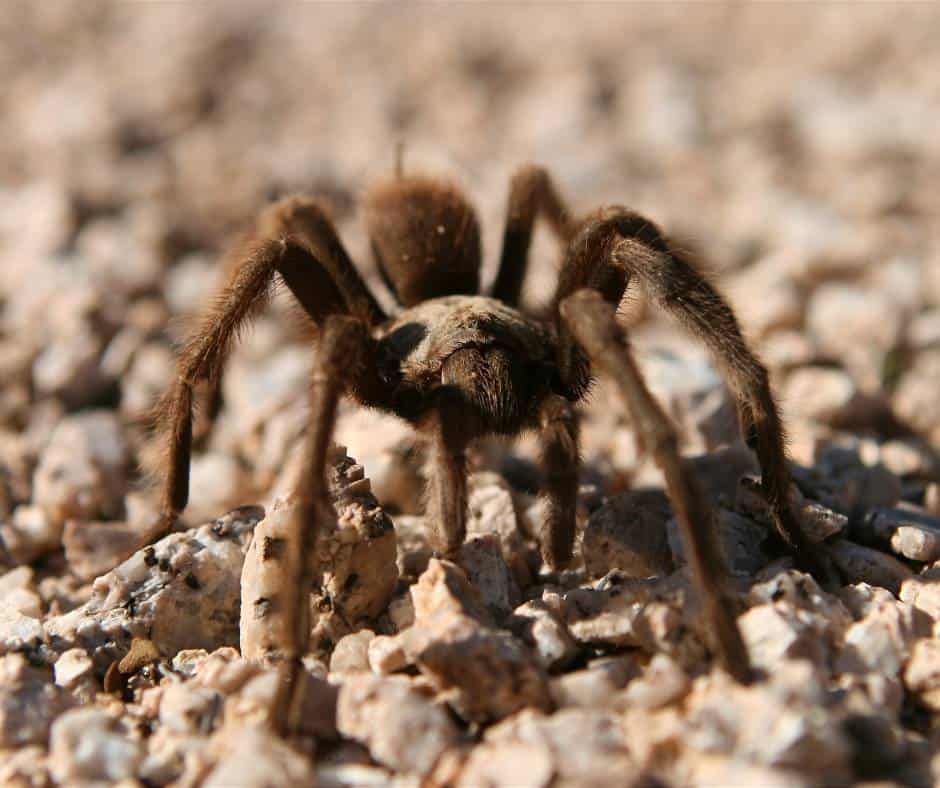
Tarantulas are one of the many interesting creatures found in Death Valley National Park. There are two species of tarantulas in the park, the desert tarantula and the Arizona blonde tarantula. The desert tarantula is the more common of the two and can be found in the lower elevations of the park, while the Arizona blonde tarantula is found in higher elevations.
These tarantulas are generally brown in color with a hairy body and legs. They have eight eyes, but their vision is poor and they rely more on their sense of touch and smell. They are nocturnal and spend their days in burrows that they create in the ground. At night, they venture out to hunt for insects and other prey.
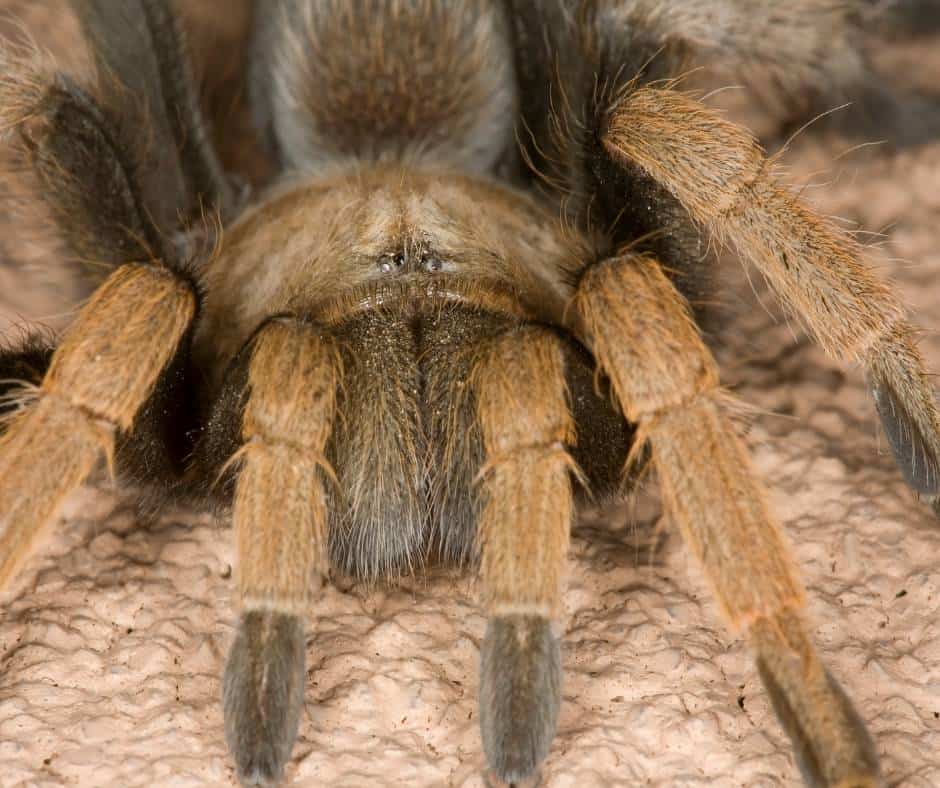
While tarantulas have a fearsome reputation, they are generally harmless to humans. Their venom is not deadly and is mainly used to subdue their prey. However, if provoked or handled roughly, they may bite as a means of self-defense.
The best time to see tarantulas in Death Valley National Park is during the fall when they are out and about looking for mates. They can be found in open areas and along hiking trails. If you come across a tarantula, it is important to give them space and avoid disturbing them.
Scorpion
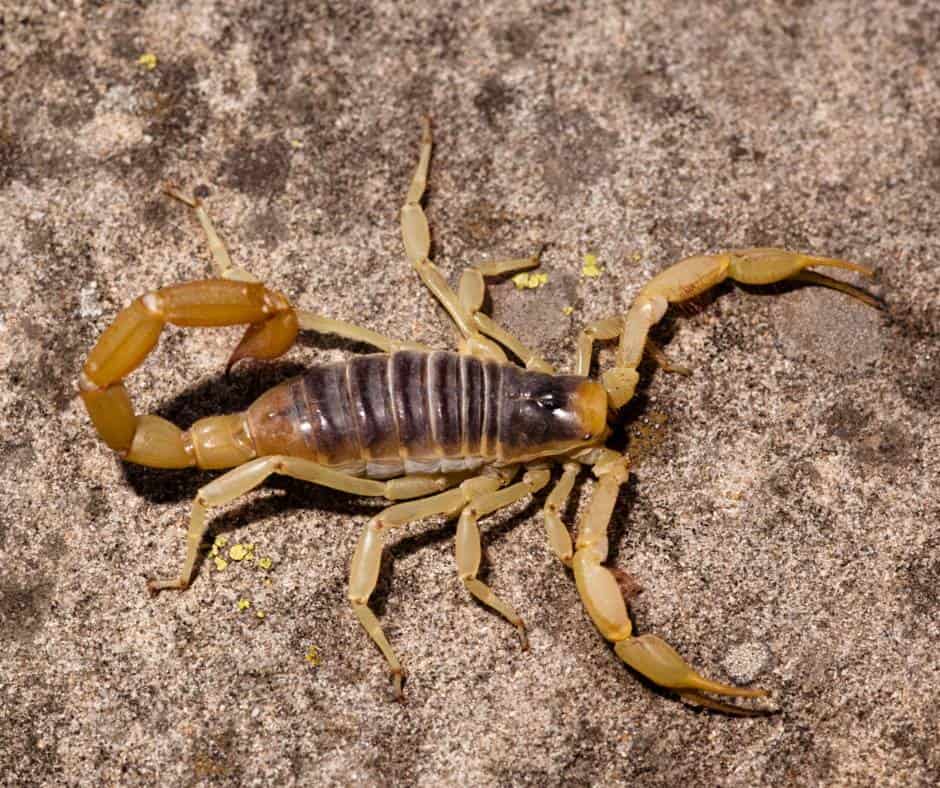
There are two species of scorpions commonly found in Death Valley National Park: the desert hairy scorpion and the stripe-tailed scorpion.
The desert hairy scorpion is one of the largest scorpion species in North America, growing up to six inches in length. They are commonly found in Death Valley, and are known for their hairy appearance. They are nocturnal and feed on insects and other small animals.
The stripe-tailed scorpion is a smaller species, growing up to three inches in length. They are also found in desert regions and are recognizable by the distinctive stripes on their tails. They are also nocturnal and feed on insects and other arthropods.
Both species of scorpions in Death Valley are venomous and should be treated with caution. While their stings are usually not life-threatening, they can cause pain and discomfort, and some individuals may experience an allergic reaction. Visitors should always avoid handling or disturbing scorpions.
Love learning about the animals that live in national parks? Then check out our guide to Animals in Yosemite.
]]>Here are some of the mammals that call this park home. Yosemite animals are varied, given the the park’s many landcapes and elevations. Some are certainly more common than others, but an animal sighting is always something to get excited about. Just be respectful and keep your distance.
In addition to the animals listed below, there are a wide variety of rodents such a mice, voles, woodrats, and gophers living inside the park.
Short on time? Here is your guide to one day in Yosemite.
Animals in Yosemite- 21 Mammals That Call the Park Home
Black Bear
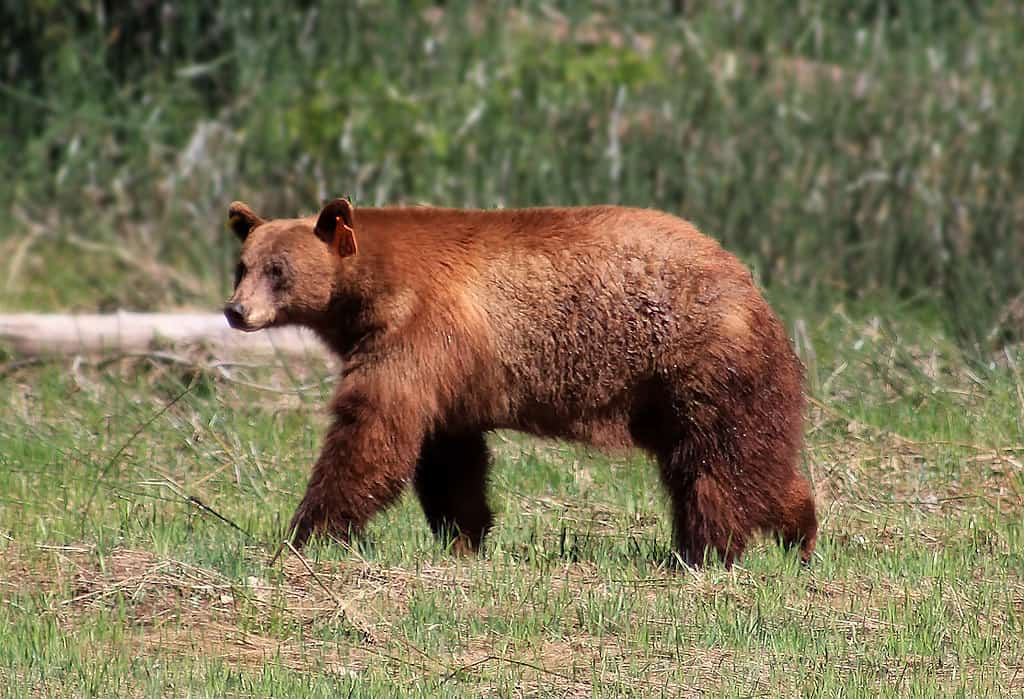
Where to Spot this Animal in Yosemite: I have seen black bears all throughout the park- in the Yosemite Valley, near High Country campgrounds, and in Sequoia Groves.
The animal that most folks come to Yosemite National Park hoping to see is the black bear. There are about 300-500 that live in the park. Keep in mind that the black bear species are not always black; many are brown, reddish brown, or even blond in color. If you see a bear in Yosemite, it’s a black bear as grizzly bears were eradicated from California in 1924.
Black bears are significantly smaller than grizzlies you may have seen in parks like Yellowstone or Glacier. Males tend to weigh around 250lbs and females about 150lbs. Bears in Yosemite tend to mostly eat grass or berries, but they do love snacking on acorns from the local oak trees during the fall.
Black bears do hibernate, and the hibernation season is dependent on weather. They typically hibernate through winter and come back out weighing 1/3 less in March or April. During this time females may also emerge from their dens with one to three cubs. The cubs are adorable, but be sure to never get between a mom and her cubs!
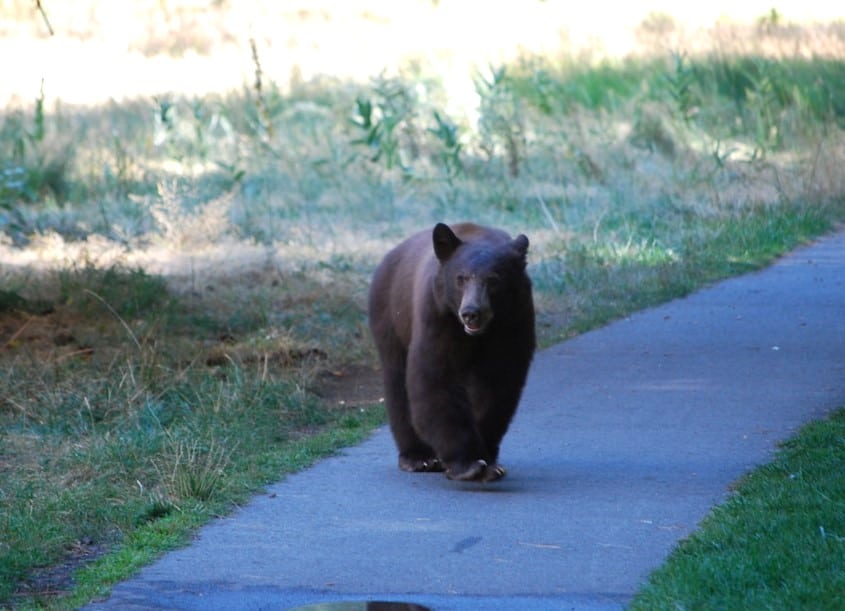
The bears in Yosemite are quite used to people, and nobody has ever been killed or seriously injured by a bear in Yosemite. Still, you want to give them plenty of distance. A good rule of thumb is to give them 50 yards of space.
Bears are known to invade campgrounds, break into cars, and raid unattended backpacks. You can avoid this by never leaving food in your car and using the metal bear boxes inside the park to store your food.
Here are the best easy hikes in Yosemite National Park.
Mule Deer
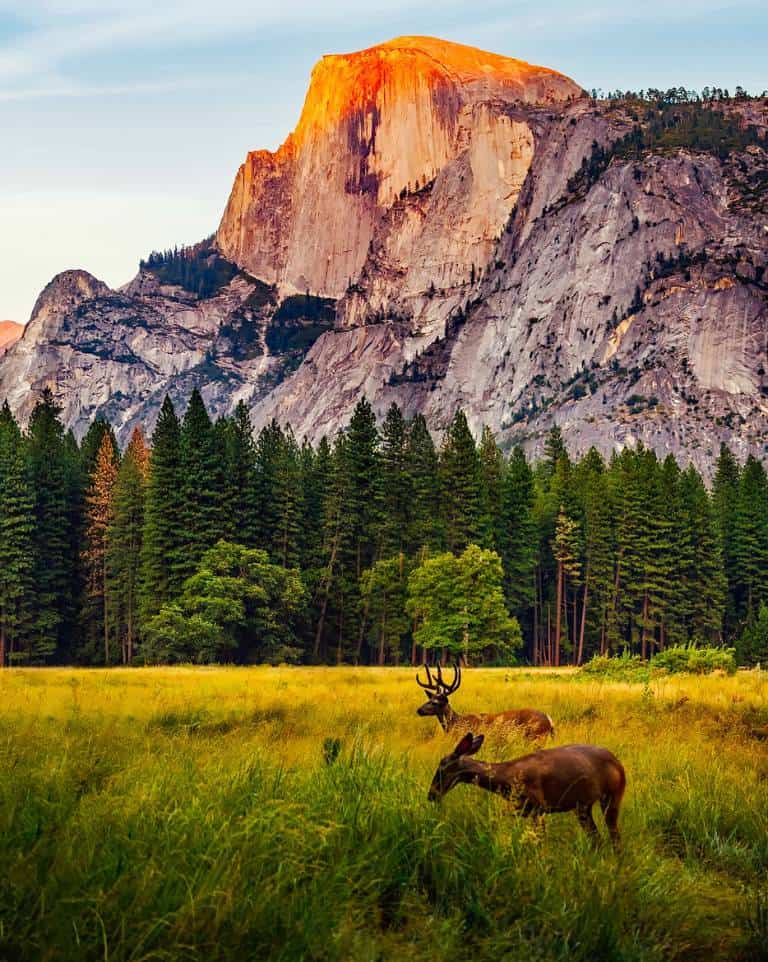
Where to Spot this Animal in Yosemite: You have a great chance of spotting mule deer along roads and in meadows of the Yosemite Valley. During the summer you may also spot them in the higher elevations, like in Tioga Meadow.
Did you know that more injuries in Yosemite are inflicted by mule deer than any other animals in Yosemite? These gentle looking animals may appear docile, but getting close to wildlife is never a good idea, especially during mating season.
Mule deer are the only deer species that call Yosemite home. They are known for their large ears and eat leaves, shurbs, berries, acorns, and grasses. These are large dear, typically measuring about four feet tall. Females are 150lbs, and males average around 200lbs.
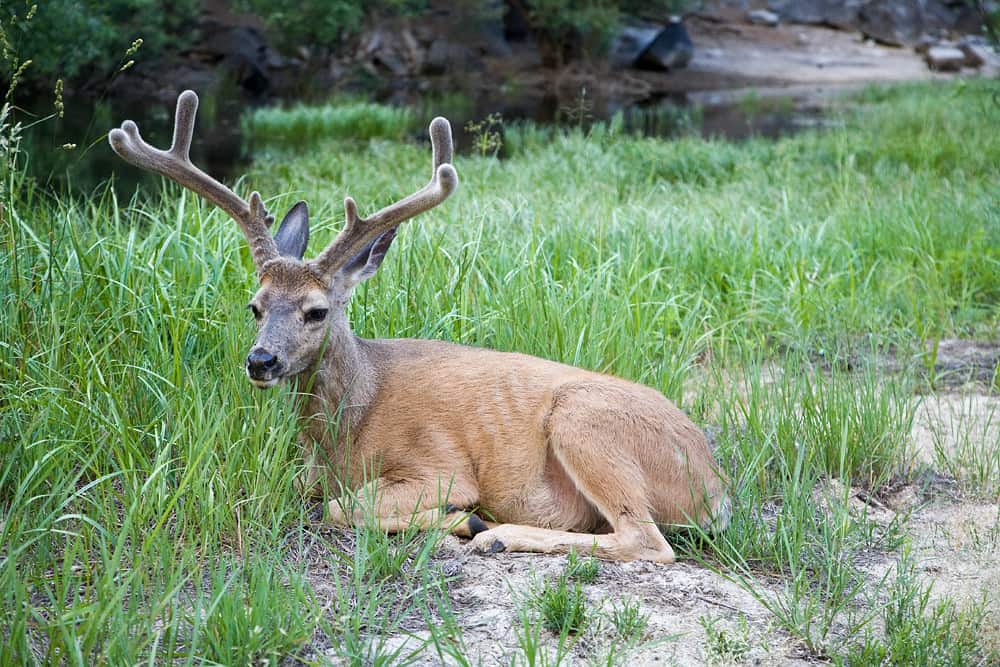
Only males grow antlers and they shed them annually in the winter after “rut” which is the time when they fight for mates. Fawns are born in the spring after a long, 200 day gestation period. They stay with their mothers until the fall.
Squirrel
Where to Spot this Animal in Yosemite: All over the park. Squirrel sightings are guaranteed.
There are several different squirrels that call Yosemite National Park. This is, by far, the most common animal you will see while exploring. They are especially common near parking lots, food establishments, and popular trails. Though they will beg, it is important not to feed the squirrels.
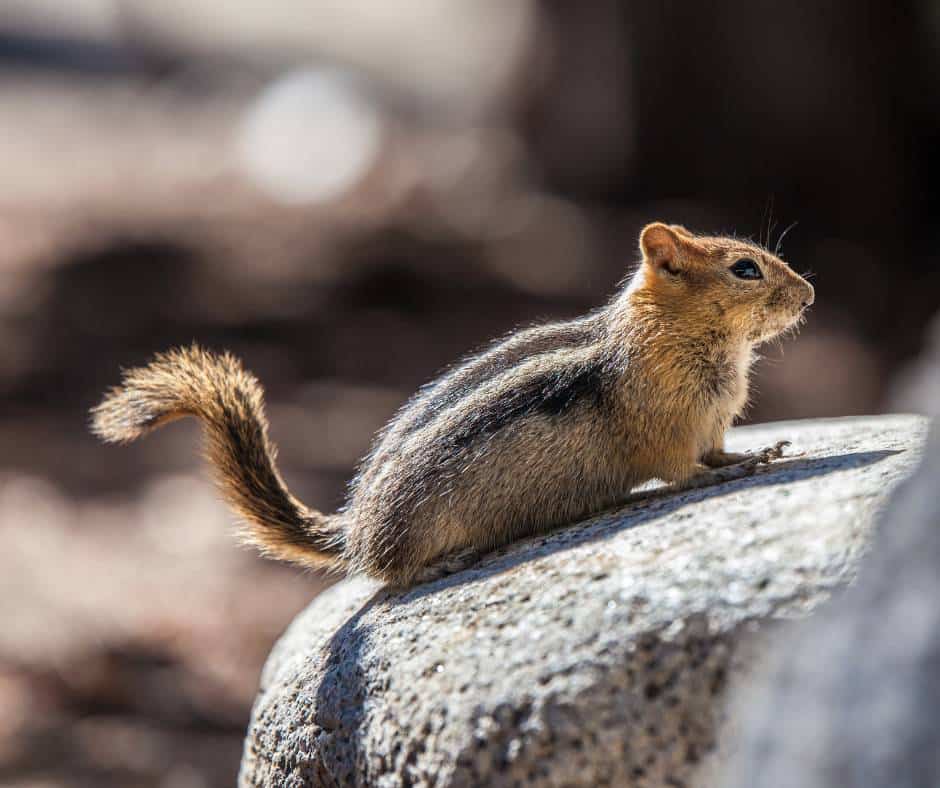
The golden-mantled ground squirrel is often mistaken for a chipmunk because of the distinct stripes on its back and its small size (adults weigh less than a pound). However, there are no chipmunks in California, so if you see anything resembling a chipmunk in the park, its a golden-mantled squirrel!
These ground squirrels hibernate during the winter so they spend much of the year building up fat storage. They can be quite the little beggars, but it is important for them to not gain a dependence on humans and remain wild, so please resist the urge to feed them.
They are found all over the park including on trails, in meadows, in rocky areas, and even in the higher elevation tundra.
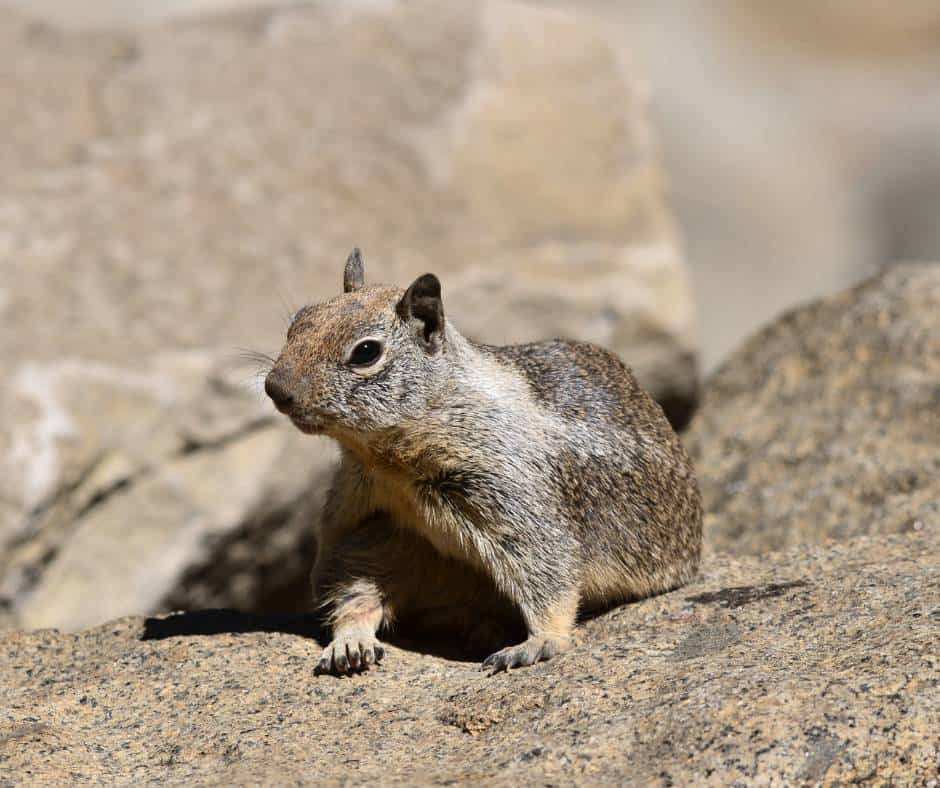
The California ground squirrel is the most commonly seen squirrel in Yosemite. As the name implies, it lives in burrows underground. It does hibernate during the winter and will certainly attempt to beg for food from park visitors.
These squirrels are mostly brown with mottled, light brown or white flecks.

The Western gray squirrel is know for its bushy gray tail. It is probably the squirrel species you are least likely to see since it spends nearly all of its time in trees and has a smaller population density in the Yosemite Valley than other varieties. It does stick to the lower elevations of the park.

The Douglas’s squirrel is a reddish tree squirrel that you will likely hear before you see. The squirrel has a distinct squeak. Its has darker brown fur with a distinct reddish-orange belly and light eye ring.
This squirrel lives in conifer trees like pine or fir because it loves to eat conifer seeds as well as the fungi that grow on the trees.
Listen to the sounds of the Douglas’s squirrel:
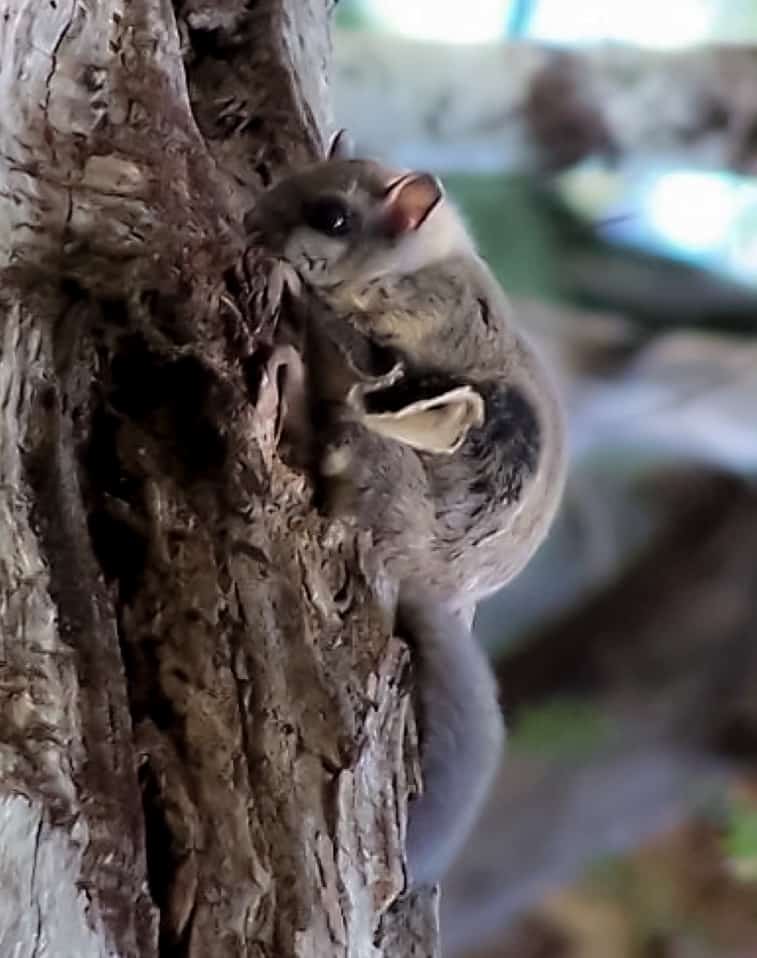
Humboldt’s flying squirrel, which is native to the West Coast, got its own species classification in 2017, due to its mitochondrial DNA being different from other North American flying squirrels.
This is a nocturnal species which uses the web of skin connectins its wrists and ankles to help it glide with ease from tree to tree. They can “fly” as much as 150 feet at a time. You are most likely to see them when light is shown into a tree and they are caught mid glide, looking like little shadows in the distance.
Coyote

Where to Spot this Animal in Yosemite: You are most likely to see coyotes hunting in the Yosemite Valley meadows during winter.
Many of us living in California are quite familiar with the coyote, and regularly see them living among us in both urban as well as rural areas. The coyotes that call my area of Orange County home tend to be much smallers and scrawnier than the beautiful mountain coyotes of Yosemite.
Living in a cooler climate and higher elevations has caused them to adapt with a thicker coat and a size closer to that of a wolf. Alas, wolves have not been spotted in Yosemite for over 100 years (except for one loan gray wolf passing through in 2021).
Coyotes head to lower elevations, like the Yosemite Valley, during the winter to hunt for prey like rodents and other small mammals. They listen for the sounds of these critters under the snow in meadows, and then pounce to snag a meal.
Skunk

Where to Spot this Animal in Yosemite: You are likely to see it in the Yosemite Valley or foothill regions of the park like Wawona.
The striped skunk is most commonly smelled before it is ever seen, but this adorable little animal is still seen rather commonly by Yosemite visitors, especially in the evening. Skunks are the size of a house cat and eat a variety of insects, worms, eggs, small amphibians and even small mice and voles. They will even forage on plants.
Skunks often don’t seem too concerned by the presence of humans, so it is best to give them a wide birth when encountered to avoid getting sprayed.
Spotted Skunk
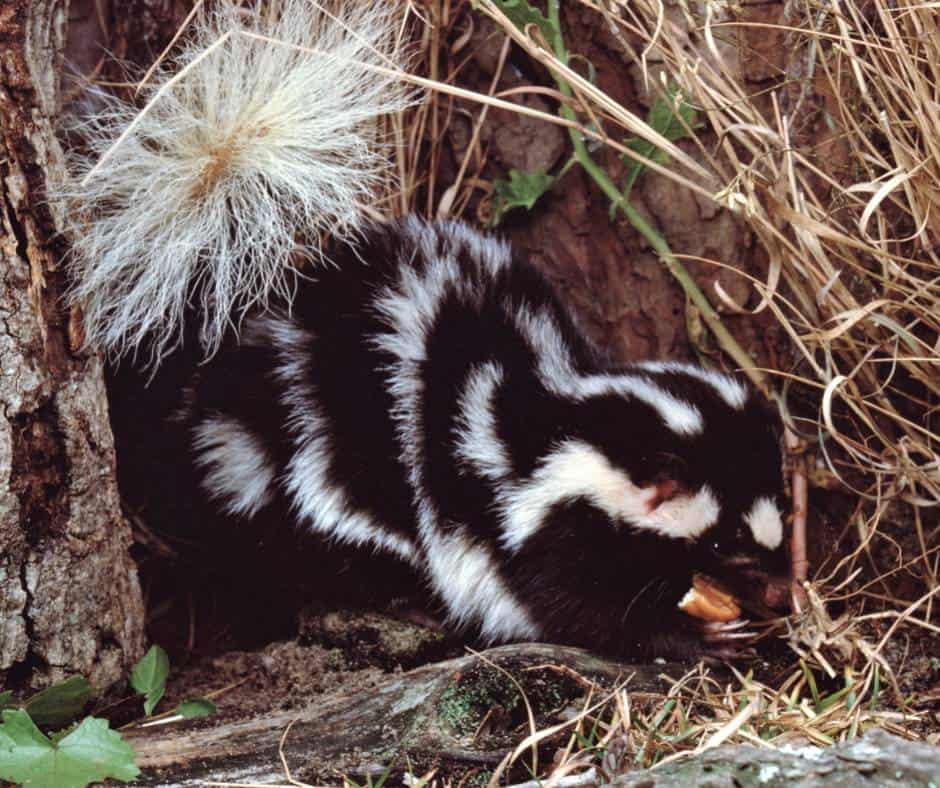
The spotted skunk is a far less commonly viewed species of skunk that also lives in Yosemite. It is most often seen in the lowest evelations of the park but does sometime make an appearace in the Yosemite Valley.
Spotted skunks are smaller than striped skunks, but they share their cousin’s nocturnal habits and food preferences. If they are threatened they have been know to stamp their feet and then stand on front feet and advance towards the threat in a handstand before spraying!
Grey Fox

Where to Spot this Animal in Yosemite: In lower elevations of the park, like Wawona. You might catch one with your car’s headlights in the lower parts of the park at night.
The gray fox is the most commonly spotted member of the canine family in Yosemite. It lives in the park’s lower elevations (including the Yosemite Valley at times), is quick, and is an excellent hunter.
They prefer to livein more shrubby areas where they can hunt their preferred prey, rodents and birds, easily. They are tree climbers and will eat some plants like berries, making them omivores. They are also known to scavenge garbage littered in the park.
Pika
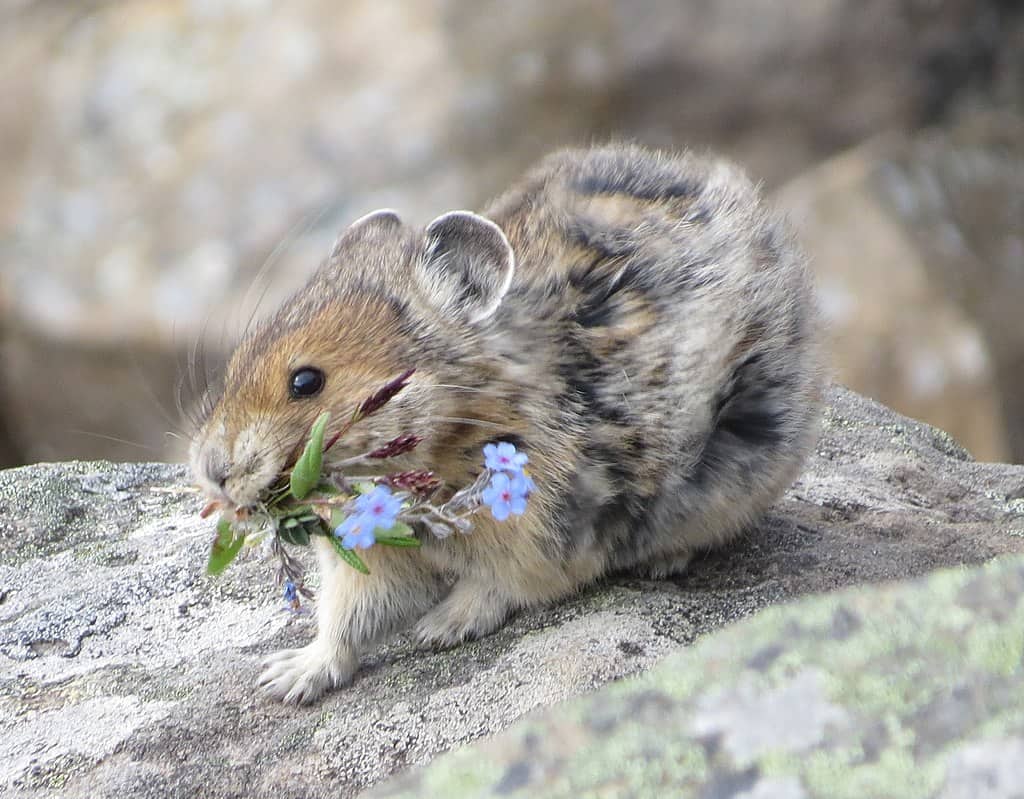
Where to Spot this Animal in Yosemite: Above the tree line in rock slides and rock outcrops. Check for them on the high portions of the trail to Mount Dana.
While the pika may look like a rodent in many ways, it is actually a lagomorph and closely related to rabbits. It is much smaller than a common rabbit, about a third of the size, and has much smaller ears and eyes. Still, it has rabbit-like fur and a similar jaw structure.
The rock rabbit, as it is sometimes called, is typically spotted by High Sierra hikers who know that if they remain quiet and patient near a rock slide ,then are likely to see them. They emit a loud, squeaking call and often sit atop a perch of boulders, squeaking away.
Pikas are experiencing shrinking territory due to global warming. Higher temperature in their high elevation home cause them to overheat. These days you won’t spot one below 9,500 feet.
Ringtail
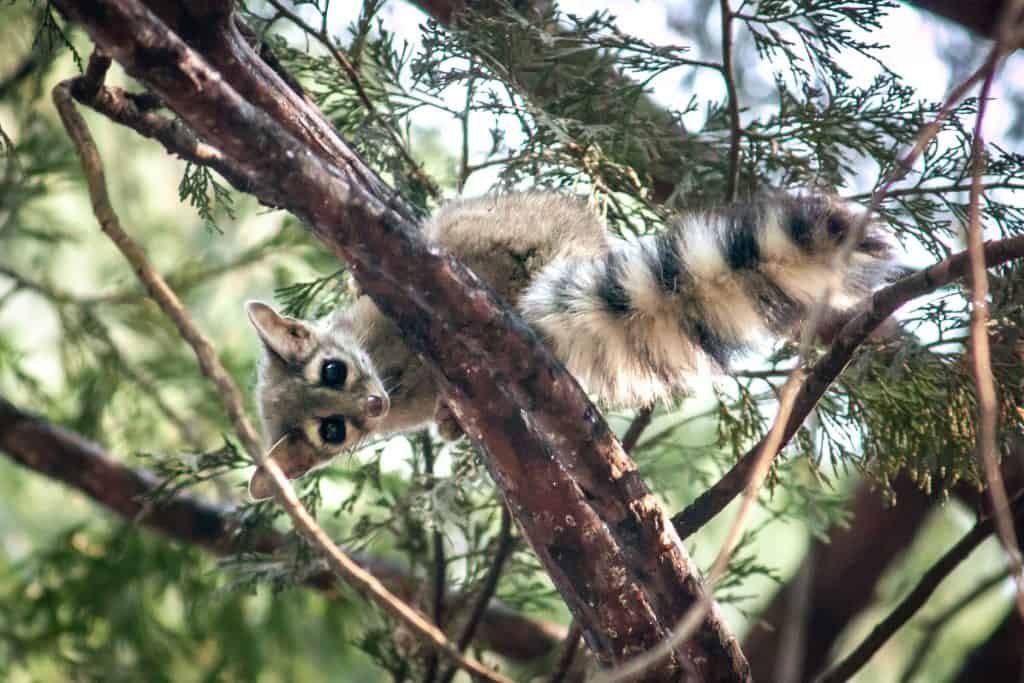
Where to Spot this Animal in Yosemite: Climbing around in a pine tree at night.
The ringtail is one of the most common animals in Yosemite that you may not see. This is because the ringtail is fully noctural. It looks part lemur, part raccoon, part fox, and part squirrel. It is most closely related to the raccooon, but is small like a squirrel.
The body is typically brown to brownish gray and as the name implies, it has a ringed tail. They are carnivores that primary eat rodents, though they will eat nuts and fruits as well. You are most likely see them while flashing a light into the trees in the evening.
Ringtails are known for getting into the attics of buildings inside the park in search of rodents, much like their raccoon cousins.
Raccoon

Where to Spot this Animal in Yosemite: The south entrance near Wawona and in the Yosemite Valley.
Raccoons are a species many suburban and rural residents are already familiar with. Those that live in Yosemite tend to do so in the lower portions of the park. Still, raccoons are far less common inside the park than ringtails.
They are being observed more and more in the Yosemite Valley these days, likely because of the presence of human food. Many visitors have reported that raccoons don’t seem particularly afraid of people and are willing to beg for food. Don’t give in to their adorable advances.
Here is a video of a raccoon hanging out on a balcony at Yosemite Valley Lodge.
Yellow Bellied Marmot
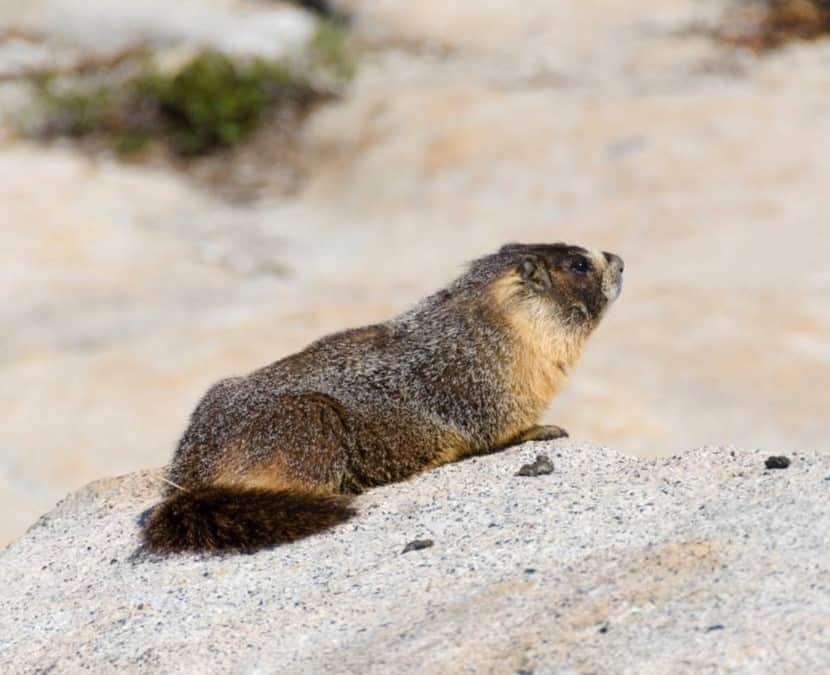
Where to Spot this Animal in Yosemite: In high elevations, sunning themselves on rocks. Check Olmstead Point, Mount Hoffman, or Gaylor Lakes off Tioga Road.
The largest rodent in park is the yellow-bellied marmot, a 5-11lb critter found bathing in the sunshine on rocks at higher elevations. Marmots hibernate for most of the year, staying in their burrows from September to May, so you will only see them in the summer.
Marmots eat plants, insects, and even bird eggs. They are usually quite alert, keeping an eye out for predators like eagles and then quickly darting to safety inside piles of rock. Yellow-bellied marmots let out a shrill whistle to alarm other marmots when they spot a threat and also defend their territory.
Bobcat
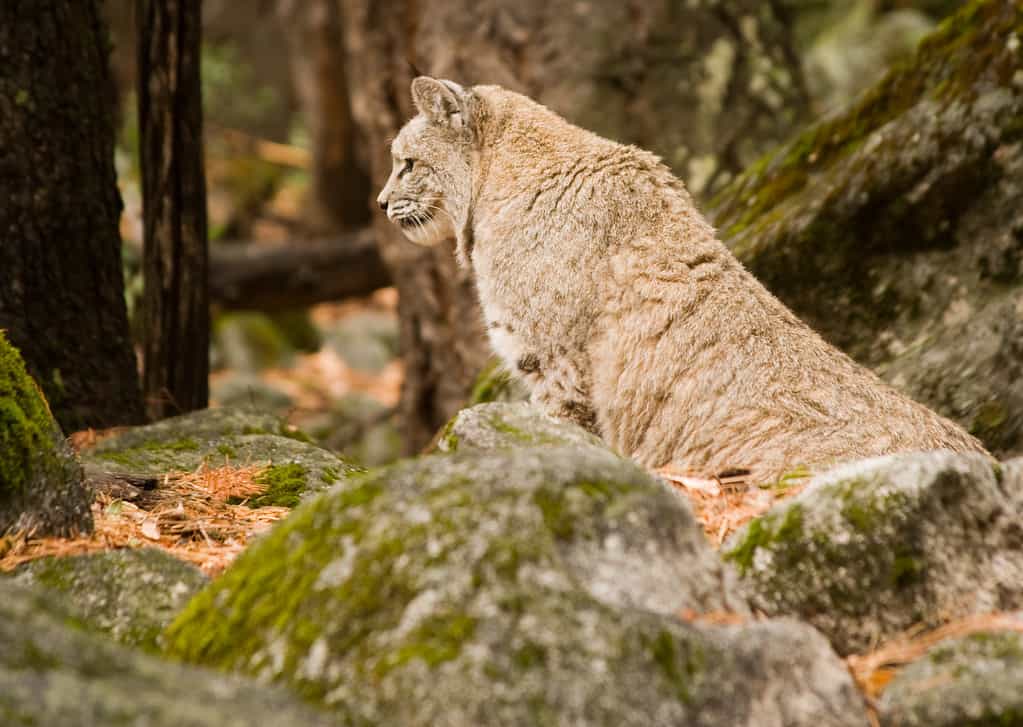
Where to Spot this Animal in Yosemite: In open meadows hunting rodents.
The bobcat is a small but agile cat living in Yosemite. Though they aren’t commonly spotted, they are seen far more often than their much larger counterpart, the mountain lion. I once saw one crossing a meadow near the Ahwahnee hotel.
Bobcats are typically two to three feet in length, tannish in color, and known for their distinctively short bobbed tails. I would compare a bobcat in size that of a large housecat like a Main Coon.
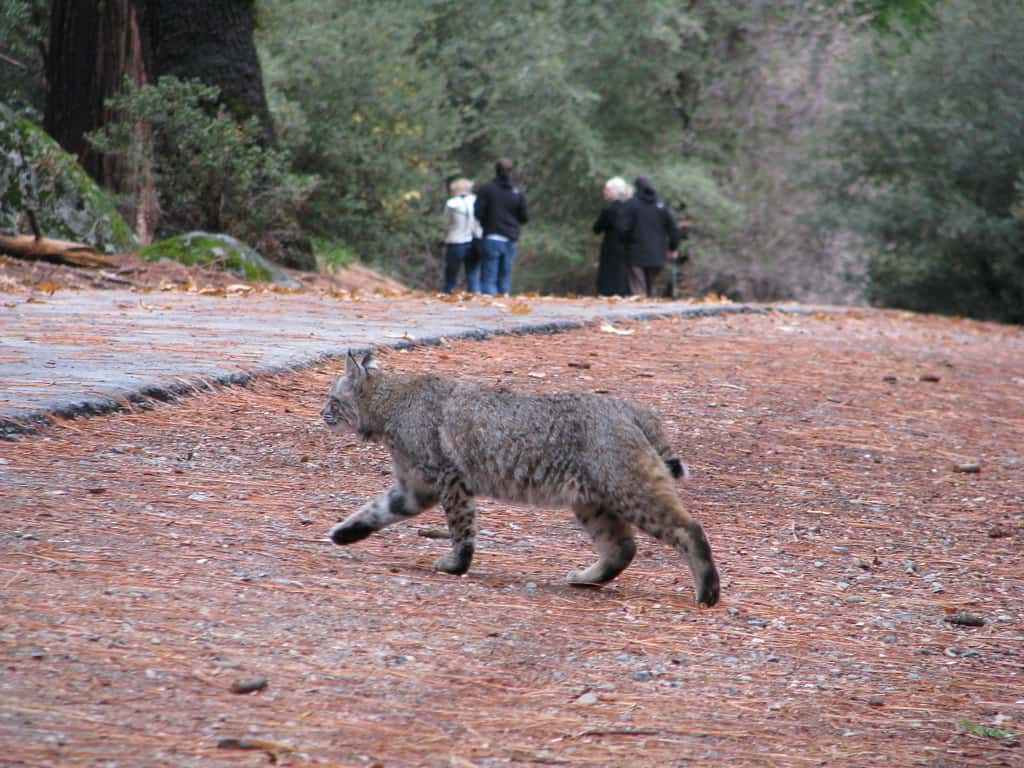
Bobcats can easily climb trees and will hunt in the daytime as well as at night. Like the coyote, them have been seen jumping and diving into the snow to catch rodents. They also like to eat birds and have even been known to occassionally attack deer in deep snow.
Want a guaranteed animal sighting? These are the best zoos in California.
Bats
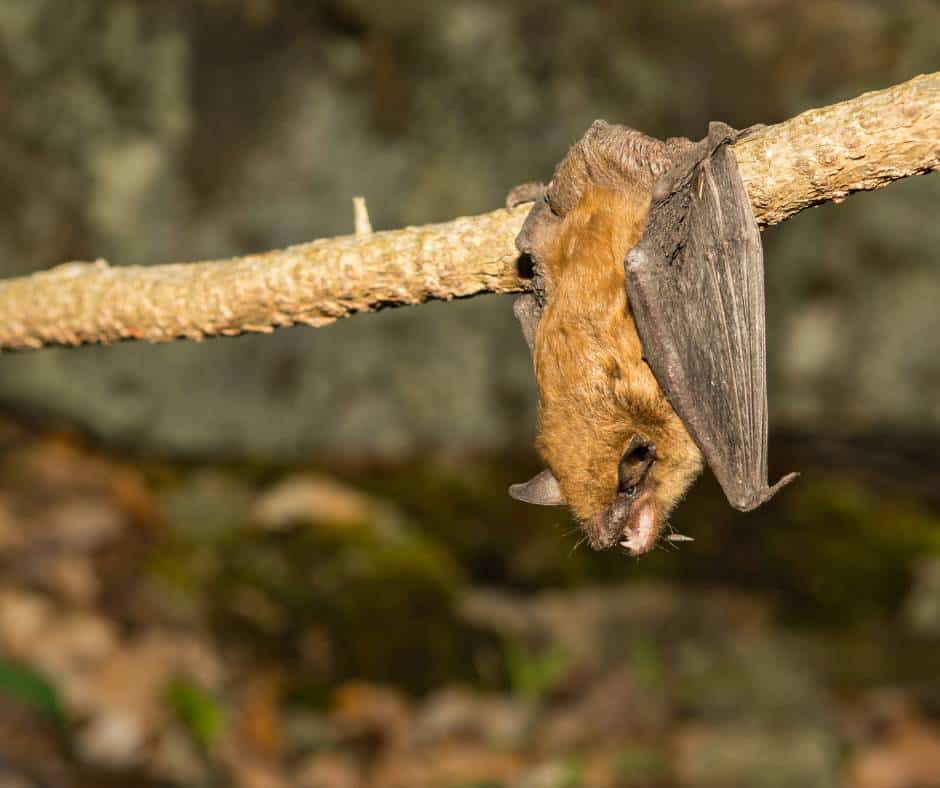
Where to Spot this Animal in Yosemite: In the night’s sky. If you see a “bird” flying in the evening sky, it is likely a bat, the only flying mammals.
Most Common Bat in Yosemite: Big brown bat
Yosemite National Park is home to 17 of the 25 species that exist in California. They are found all over the park, from the lowest elevations to summits above 10,000 feet.
Bats use echo location to find their prey, mainly insects, as they fly across the night sky. They can fly over 15 miles during their 6-7 hour evening hunt.
The largest bat species in North America, the Western mastif, calls Yosemite National Park home. It has a wingspan of 22 inches but is still incredibly light, weighing just over two ounces.
Mountain Lion
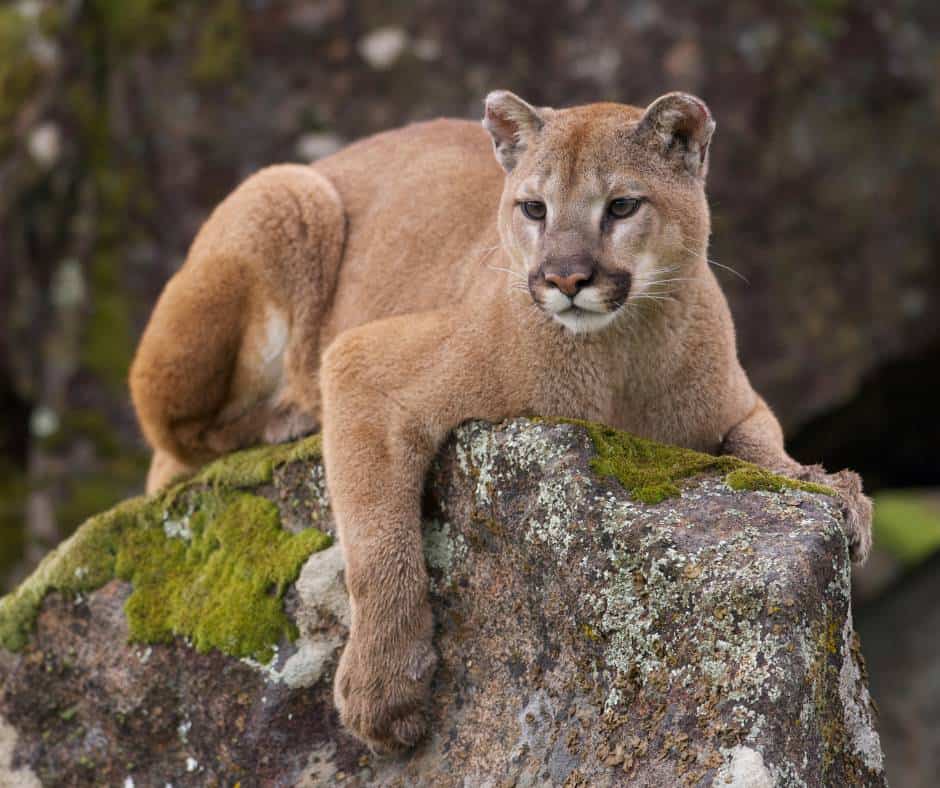
Where to Spot this Animal in Yosemite: Spottings are very rare, but these cats have been seen in the Yosemite Valley as well as the high country.
The mountain lion goes by several names- cougar, puma, panther- but no matter what you call it, this feline is most definitely the largest cat to call Yosemite and the rest of California home. Males are about 130-150lbs and females are much smaller at around 65-90lbs. Mountain lions eat small mammals and tend to hunt at night.
California mountain lions have not had an easy time over the past couple hundred years. Their population has been reduced by hunting and territory loss, but things do seem to be rebounding a bit in the park.
For several years, it was thought that maybe only a dozen cougars lived inside the park, but after an extensive study in 2019, the current number has been estimated to be around 35. Since Yosemite covers 1,169 square miles, that means there is only one mountain lion per 25 miles.
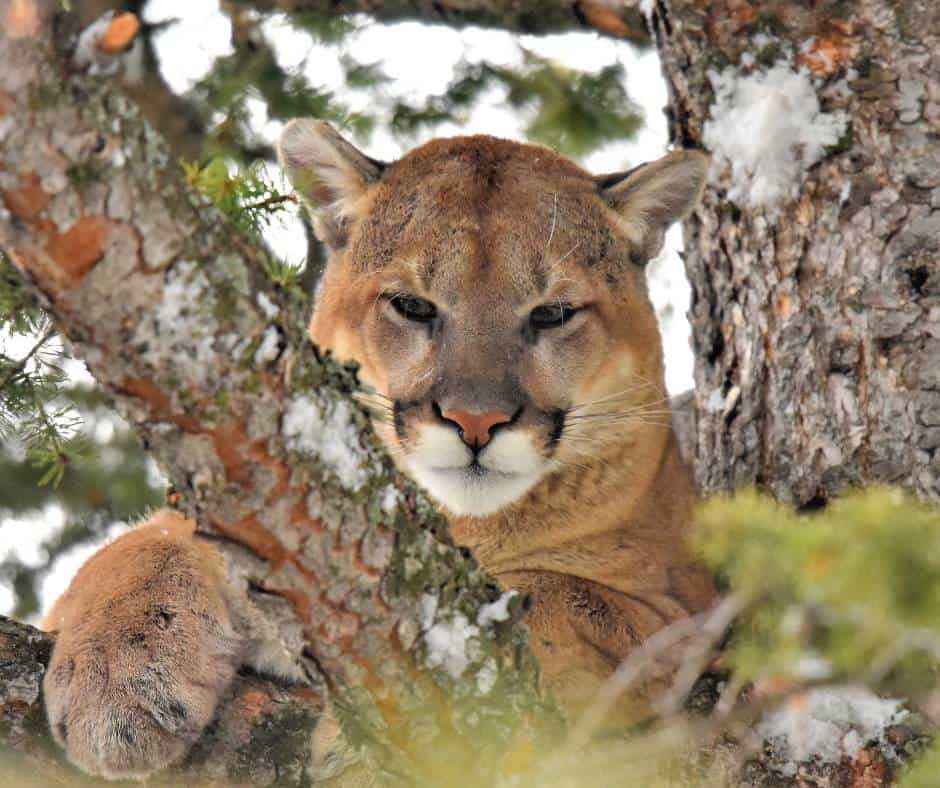
Your chances of ever encountering a mountain lion are quite slim. Still, the cats have been spotted all over the park, from the Yosemite Valley to the Grand Canyon of the Tuolumne River, a wildlife corridor where large mammals have been spotted regularly searching for food, shelter, and mates.
I live in mountain lion country and they have been spotted on the trails that run behind my neighborhood. Dozens of people walk these trails daily without incident. The reality is, a mountain lion is much more likely to see you than you are to see it, and it almost never wants anything to do with a human.
Regardless, if you ever do see a mountain lion DON’T RUN. This will just activate their prey drive. If one starts to approach you act big. Shout in a deep voice. Throw rocks and sticks and maintain eye contact. And remember than whenever you hike with small children you want to keep them close so they don’t get mistaken for prey.
Check out this amazing standoff between a pair of coyotes and a mountain lion near the Ahwahnee Hotel.
Sierra Nevada Bighorn Sheep
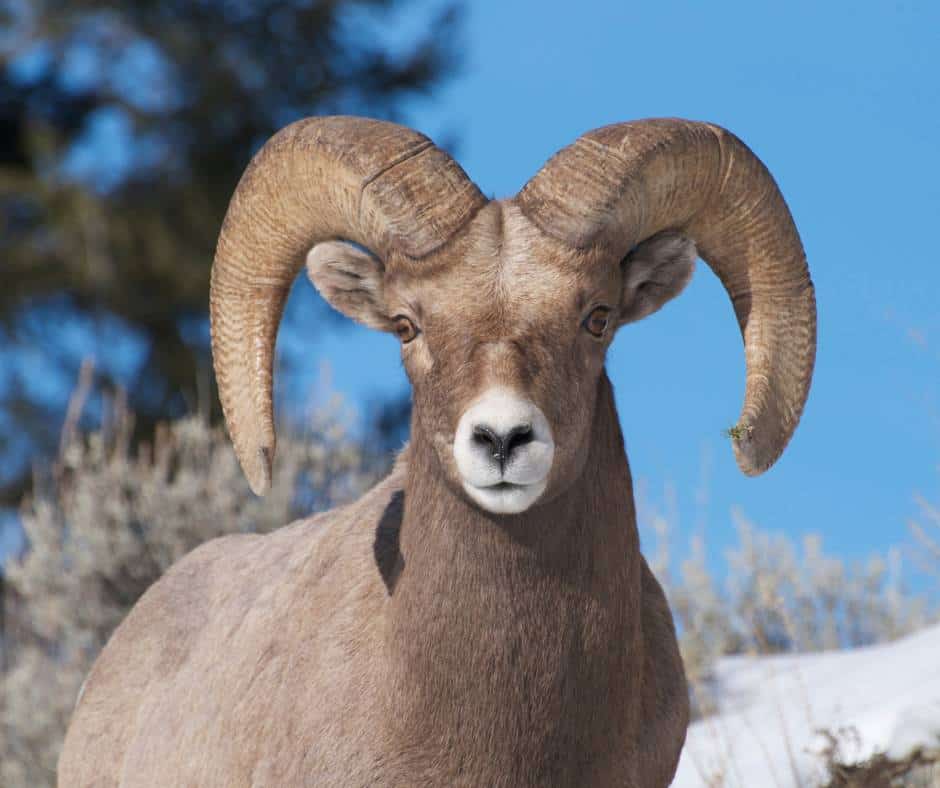
Where to Spot this Animal in Yosemite: Above the 10,000-foot level, mainly in the northeastern corner of the park.
The Sierra Nevada bighorn sheep are an example of a relocation success story. These agile animals went extinct within the park after the first two decades of its formal existence due to over hunting and diseases from domestic sheep brought in by Gold Rush settlers.
In 1986, a small population of just 27 animals were relocated inside the park after a 100 year absence. At first, it didn’t look like the sheep were thriving. But thanks to the Sierra Nevada Bighorn Sheep Recovery Program which was funded by the California legislature, there are now 600 sheep living in Yosemite’s Cathedral Range. They are aso often seen at Summit lake just outside of the park near Mono Pass.
Sierra Nevada Red Fox
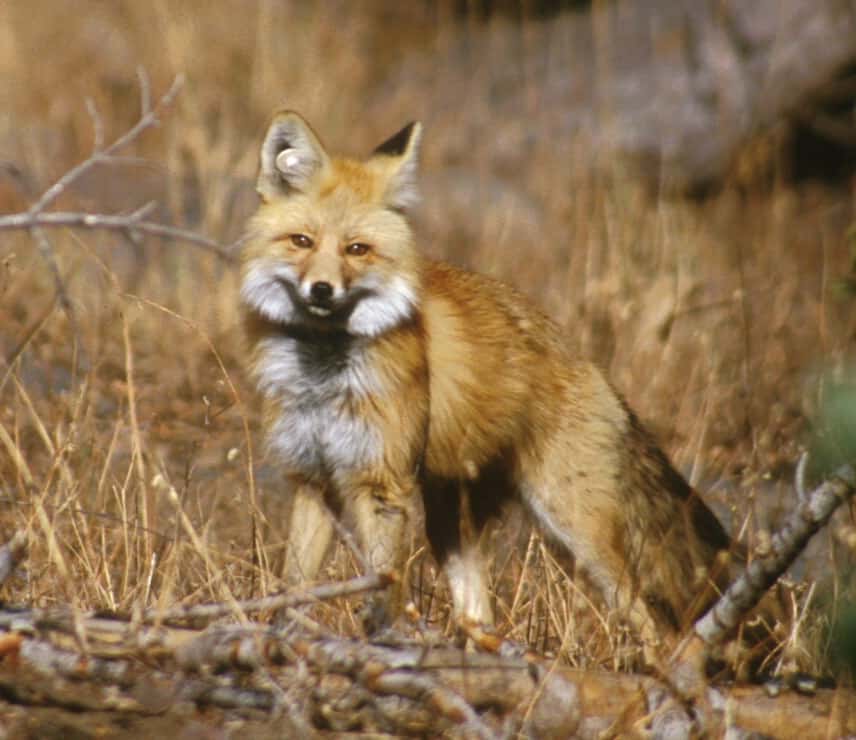
Where to Spot this Animal in Yosemite: You are very unlikely to see this animal, but they do prefer to live at about 6,000 feet in elevation.
After not being seen inside the park since 1916, a motion sensor camera detected the Sierra Nevada red fox inside the park in December 2014. There were thought to be only about 20 of these foxes in their historic range at that point.
This fox is the size of a small house cat, weighing only about eight pounds. It is an effective hunter of rodents, and the fox’s exceptional hearing allows it to hear rodents under the snow to hunt.
The Sierra Nevada red fox is another animal that was the victim of human intervention- as their soft, dense fur was coveted by fur trappers at the turn of the 20th century. Fur trapping has been illegal in California since the mid seventies and the species is endangered.
There have been at least 20 confirmed sightings within the park in the past several years, an encouraging development. If you are lucky enough to spot one, report your sighting online with photo documentation to the state’s wildlife officials.
Fisher
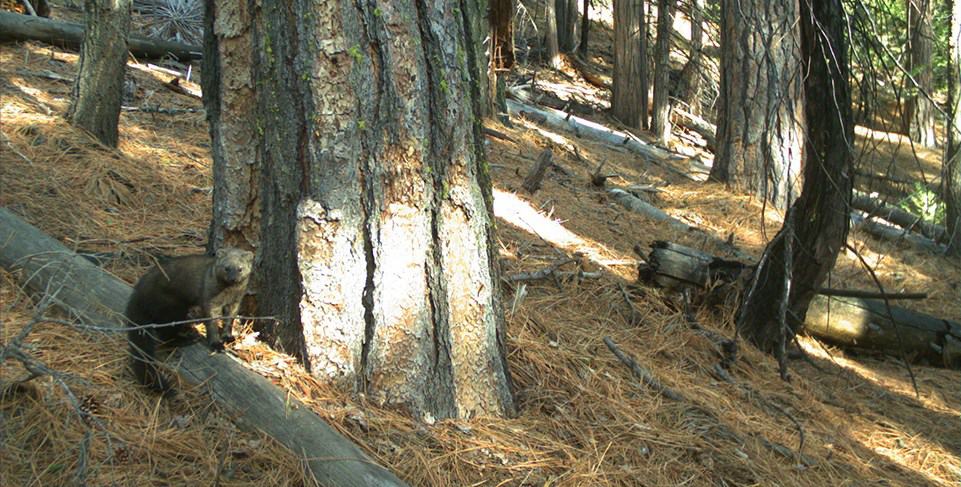
Where to Spot this Animal in Yosemite: Along the Merced River, closer to the southern reaches of the park.
The population of fishers that live in Yosemite National Park and the neighboring Sequoia National Forest is both small and isolated. There are about 200 of these cute critters in what is known as the “southern Sierra Nevada population”.
Just like the Sierra Nevada fox, fishers were victims of fur trappers, but they have also been victimized by habitat loss and logging. Unfortunately, the fishers do not currently have any federal protection, though they are considered a sensitive species by the U.S. Forest Service and the Bureau of Land Management.
Fishers are a member of the weasel family and despite their name, they don’t actually fish. They mainly eat rodents and birds, and are excellent climbers. They are technically omnivores and will eat nuts and berries as well. An adult fisher weighs 8-12 pounds and is three feet long.
Weasel

Where to Spot this Animal in Yosemite: It is possible to see them in the Yosemite Valley, as well as . The range is from the red fir forest up to the timberline.
Weasels are seen more often than one would think, in part because they are known from being fearless. There are both long-tailed and short-tailed weasels inside the park.
Long-tailed weasels are small in size, about the size of a squirrel, with a long tail that makes up half their body length. In the winter, they are primarily white except for the tip of its tail which is white. In the summer, they are mostly brown with lighter creamy yellow underparts.
The short-tailed weasel (also known as a stoat or ermine) is small as well. Only about nine inches in length with, you guessed it, a short tail. Their coloring is similar to the other species of weasel- white in the winter and brown atop and cream underneath in the winter.
Weasels hunt rodents and can do down into their burrows to snag them. They will also eat grasshoppers and frogs.
If you are looking for either of these creatures in the Yosemite Valley they have been known to be spotted near the Yosemite Museum, and the meadows near Swinging Bridge and Sentinel Bridge. The have also been spotted up high near Tioga pass.
Pine Marten
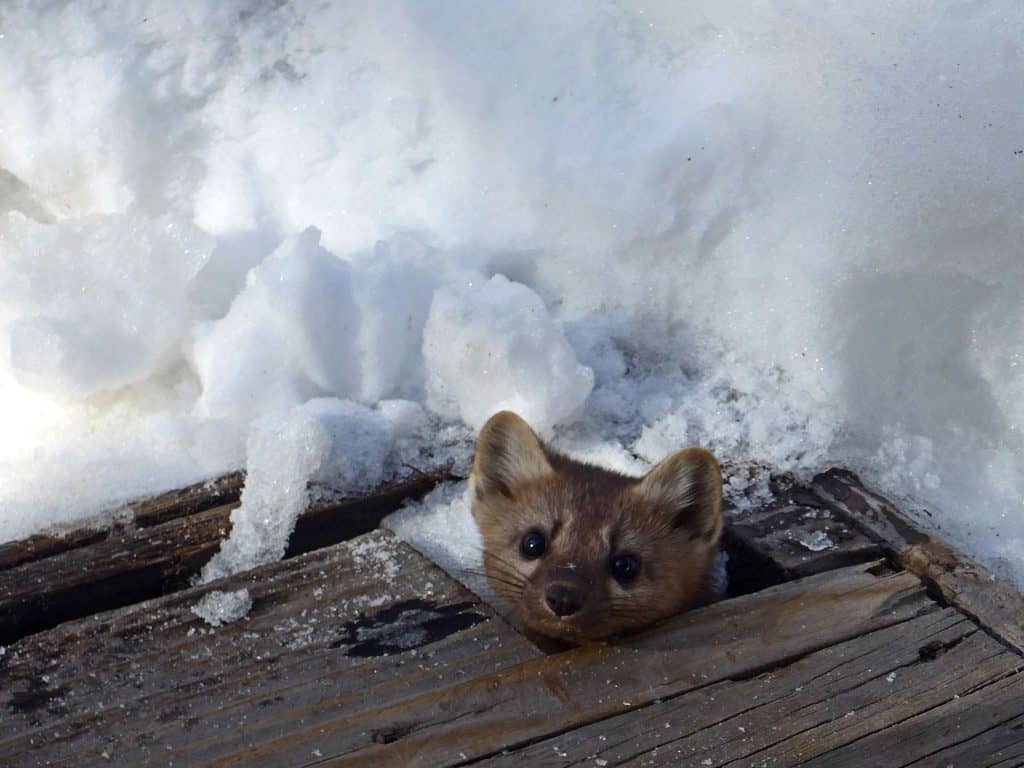
Where to Spot this Animal in Yosemite: Chances of spotting are rare, but they have been seen in Tuolumne Meadows.
Pine martens are another member of the weasel family that lives in Yosemite. It can live anywhere in the red fir belt up to the tree line, but is rarely spotted due to declining populations.
Pine martens are larger than the other weasels, but are still quite small. They weigh 2-3 pounds and are typically 1.5 – 2 feet long. They have a more fox-like face than the other weasels within Yosemite.
Pine martens love to eat voles, but they will eat variety of small rodents including tree squirrels thanks to their strong tree climbing skills. They will also birds when they can catch them.
Martens are active day or night, summer and winter. Though forest animals, they are found in Yosemite around high country rockslides and rocky meadows in summer. They eat small rodents and such birds as they can catch.
Unfortunately, pine martens are not protected by the Endangered Species Act but they are considered a is considered a “species of special concern” by the state of California.
California Badger
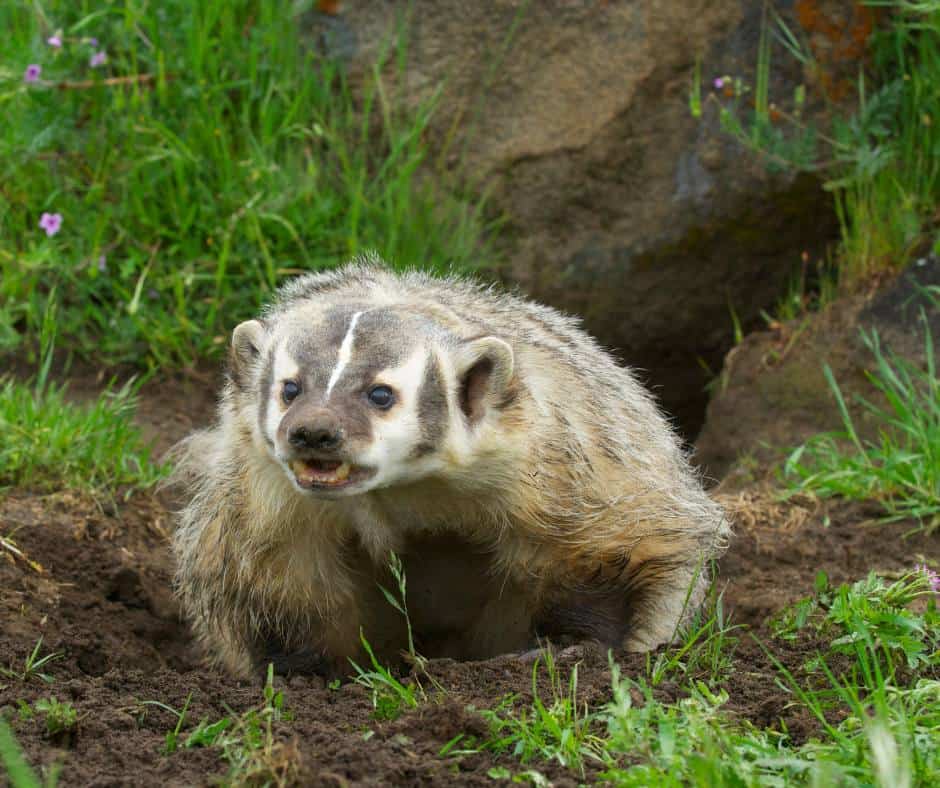
Where to Spot this Animal in Yosemite: Badgers are extremely rare to spot but are most likely found in the open areas of higher elevations. If you do see a badger, be sure to report it.
They look cute as they waddle along the ground but trust that badgers are ferocious predators, with strong claws and powerful jaws. Definitely steer clear if you happen to spot one.
Adult badgers are 2.5 feet loong and weigh about 20 pounds. They are primarily tan with a strong white streak along the center of their head and neck. They use their impressive claws to dig up ground squirrel nests and other rodent tunnels to catch their prey.
Fun Fact: Badger Pass Ski Resort, named for the California badger, is one of only three ski areas inside of a national park.
River Otter
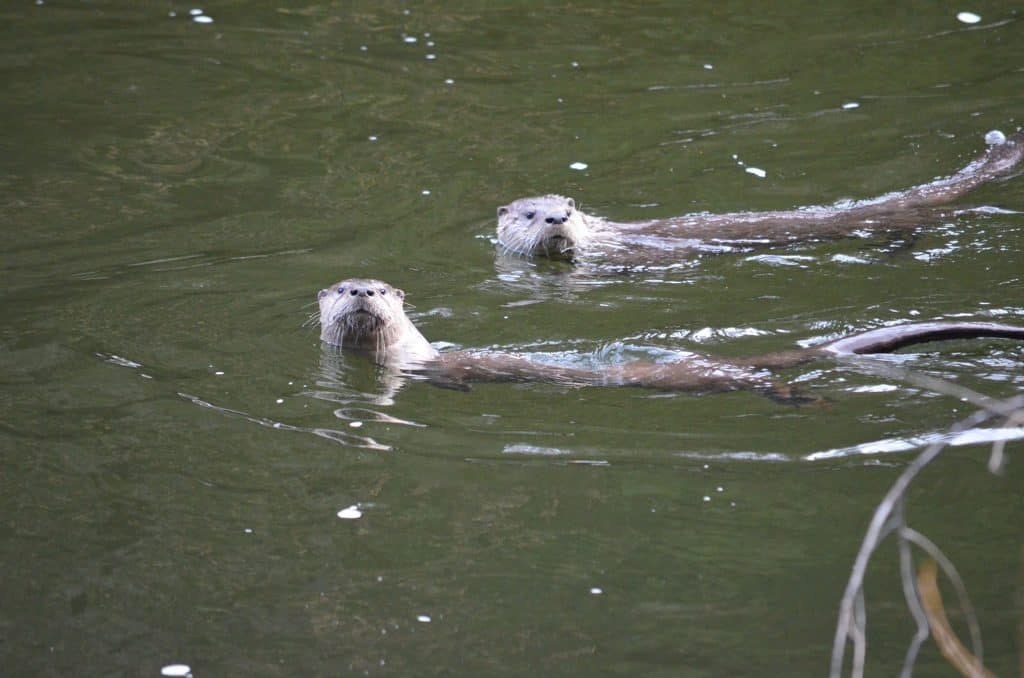
Where to Spot this Animal in Yosemite: In the Merced River both in the Yosemite Valley as well the more western portions of the park.
River otters are relatively recent residents of the Yosemite Valley. They were first seen in the Valley in the Merced River in 2014. There are some theories that they have moved up to these higher elevations because of the drought.
There are currently two known groups (a group of otters on land is a “romp”) known to move in and out of the Yosemite Valley along the river.
The California river otters are dark brown, 11 – 30 pounds, and about four feet in length. They primarily eat fish crayfish, and frogs. If you do see an otter, it will likely be in the water or along the shore.
Love otters? Here are the best places to see sea otters in California.
Beaver

Where to Spot this Animal in Yosemite: In the Merced River at Yosemite Valley, at Mirror Lake, and near Wawona.
There are not many beavers in the Yosemite, but there are a few. They tend to stick to the lower elevations of the park, as well as the Yosemite Valley. Beavers eat the bark of small trees like the cottonwood, and build dams and dens in the waterways.
There is a theory that the river otters have moved into the Yosemite Valley in part because of the beavers. Otters like to take over abandoned beaver lodges.
]]>Of course, being a coastal state, California also has some pretty fantastic aquariums as well. The Monterey Bay Aquarium ranks among the best in the country with plenty of wildlife to enjoy both inside the aquarium as well as in the bay it sits on.
These zoos in California focus on education, rehabilitation, and even captive breeding of endangered species. They allow visitors the opportunities to have up-close experiences with animals that might otherwise never see, thus gaining an appreciation for the importance of conservation.
The 21 Best Aquariums and Zoos in California
1. San Diego Safari Park

15500 San Pasqual Valley Rd, Escondido
The San Diego Safari Park is near and dear to my heart. My family has held membership to both the San Diego Zoo and San Diego Safari Park for many years and we feel grateful to live within driving distance of such a remarkable (and different) zoological institution.
The San Diego Safari Park houses 300 different species and more than 3,600 animals call this massive 1800-acre wildlife park home.
It is known for its Africa Tram Safari Tour which heads out onto the park’s huge savannah for a 25-minute tour where they will see animals like giraffes, rhinos, various antelope, and zebras living life with each other just as they would on the African savannah.
There are also large, world-class exhibits with gorillas, tigers, cheetahs, lions, elephants, California condors, and several other species. There is even an exhibit where you can walk among kangaroos and wallabies.
But that’s not all! There are several other premium “safaris” that you can pay extra to experience. Cart safaris which allow small groups to go inside the savannah enclosure and get up close with animals like giraffes and rhinos; some even include wine or mimosas!
There are also special experiences like the Sun-up Cheetah Safari where you get and up close view of a cheetah running at full speed, behind-the-scenes tours covering various animals, zip lining, and a tethered balloon ride which gives you an amazing view of the Safari Park from above.
Admission Info: There are various admission options, some of which include admission to the San Diego Zoo and SeaWorld as well at a discount. Discounts are given for advanced online ticket purchases as well.
2. San Diego Zoo
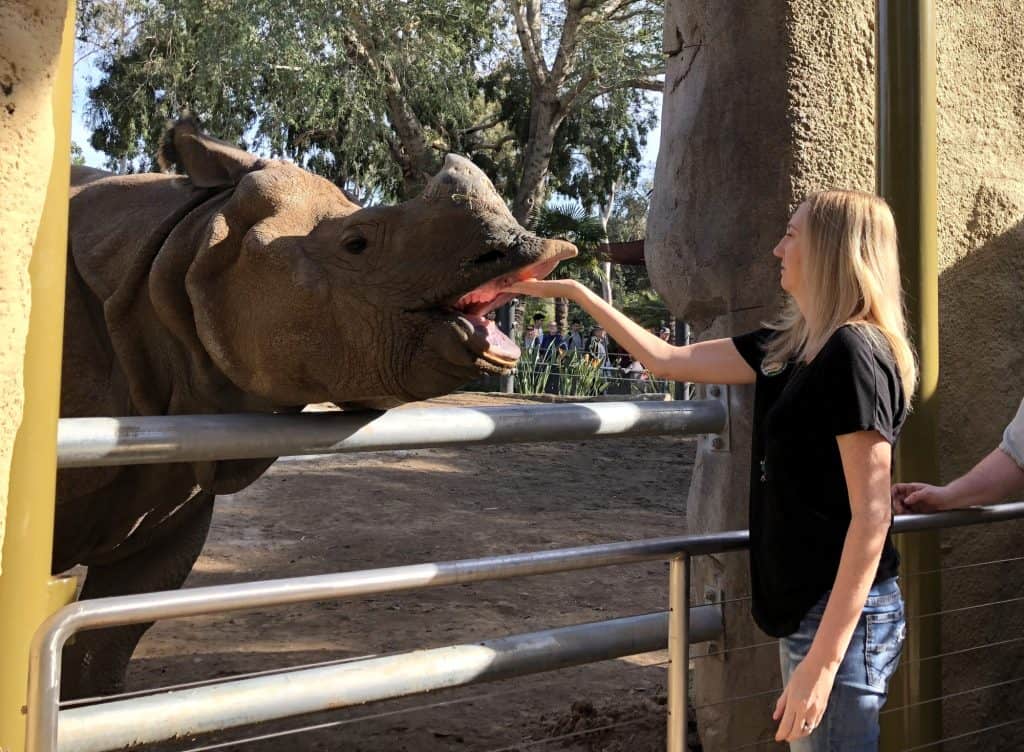
2920 Zoo Dr, San Diego
The San Diego Zoo is easily one of the most famous zoos in the country. It also happens to be one of the best. This 100-acre zoo and botanical garden is a pleasure to visit any time of year, thanks to San Diego’s marvelously mild climate.
In all, there are 12,000 rare and endangered animals, representing more than 650 species and subspecies that live at the San Diego Zoo. Equally impressive is the collection of 3,100 species of plants that live on the grounds as well. The remarkable landscaping of this zoo really adds to the experience.
Highlights of the San Diego Zoo include impressive exhibits housing polar bears, several species of endangered cats, dozens of primates, intimidating komodo dragons, adorable koalas, and species rarely seen in most zoos like the fossa and tasmanian devil. You will certainly need a full day to see them all.
Since the zoo is so large and hilly, they offer a guided double-decker bus tour which is a nice way to get an overview of the zoo and see some of the highlights. The Skyfari aerial tram is a great way to experience the beauty of the zoo and Balboa Park from above.
If you are looking for a special experience, a highly recommend booking the Animals and Action experience. This is a small group tour which will allow you to meet some animals up close. On our tour we were able to pet a zebra, feed flamingos and a rhino, and see animals like cheetahs and binturongs leashed and standing just feet away from you!
Admission Info: There are various admission options which include admission to the San Diego Safari Park and SeaWorld as well at a discount. Discounts are given for advanced online ticket purchases as well.
3. Safari West

3115 Porter Creek Rd, Santa Rosa
Did you know you can experience an African safari nestled among the vineyards of Sonoma County? Safari West is about 20 minutes from the heart of Santa Rosa, but it might as well be a world away. We think Safari West is a great alternative for those who can’t afford a true African safari, or just want to enjoy a unique wildlife experience closer to home.
This special destination is a place where you can board a jeep and go on a safari to see animals like giraffes, ostriches, cape buffalo, zebras, and southern white rhinos roaming on the wildlife preserve’s 400 acres. There is also a walking portion of the tour where you can see the park’s predators like hyenas and cheetahs, as well as smaller critters such as fennec foxes, porcupines, lemurs, and flamingos.
While you can visit Safari West as part of a day tour, the best way to enjoy this incredible place is by staying overnight in one of their 30 luxury safari tents or cottages. Imagine listening to the sounds of wildlife in the evenings (ear plugs are provided if they get too noisy) and then waking up in the morning to enjoy complimentary breakfast in the Savannah Cafe.
Admission Info: Reservations are required to visit Safari West. Pricing varies depending on the day of week and season.
See which zoos made Trekaroo’s list of the best zoos in the United States.
4. Monterey Bay Aquarium

886 Cannery Row, Monterey
The Monterey Bay Aquarium is the best aquarium in California and certainly among the best aquariums in the country. It is located on Monterey Bay in the city’s famed Cannery Row district.
This massive aquarium educates and inspires visitors to help them gain a deeper understanding of our planet’s amazing oceans. You will need a full day to explore everything this aquarium has to offer.
Be sure to check the schedule for feeding times, movie showings, and special presentations in the auditorium before you arrive so that you won’t miss any of the day’s highlights. Feeding times can get quite crowded so if you want a good view, arrive early.
One of the highlights is the new Into the Deep exhibit which showcases the largest collection of deep-sea animals in North America like giant isopods and transparent jellies that glow. Other favorites include the kelp forest, Monterey Bay habitat, touch pools, penguins, giant Pacific octopus, and the sea otters.
Speaking of sea otters, be sure to take time outside to use the Aquarium’s viewing scopes to spot sea lions, whales, and sea otters out on the Moterey Bay. Monterey Bay is one of our favorite places to spot sea otters in California.
The on-site café offers healthy meal options and sustainable seafood, but it can get crowded. Another option is to get your hand stamped and grab clam chowder at one of the restaurants in Cannery Row.
Admission Info: Tickets are no longer available at the main entrance and must be purchased online.
5. Aquarium of the Pacific

100 Aquarium Way, Long Beach
The best and largest aquarium in Southern California is the Aquarium of the Pacific in Long Beach. This aquarium features around 12,000 animals in over 100 exhibits which showcase the diversity of the Pacific Ocean, the largest ocean on the planet.
There are Tropical Pacific, Northern Pacific, and Southern California/Baja Galleries filled with aquariums of sea-going creatures, as well shark and ray touch lagoon, penguins, sea otters, seals, sea lions, frogs, and lots of different sea jellies, including moon jellies that you can touch and feed.
When the weather is warm, kids love playing at the giant water-squirting squid playground sculpture. Children also enjoy touch pools filled with sea stars, anemones, and urchins.
Since it located right on the water, the Aquarium of the Pacific also hosts whale watching tours. You will need to book a reservation ahead of time. You can book your whale watching trip here.
Admission Info: Tickets for the aquarium must be purchased in advance online as reservations are required.
6. Santa Barbara Zoo
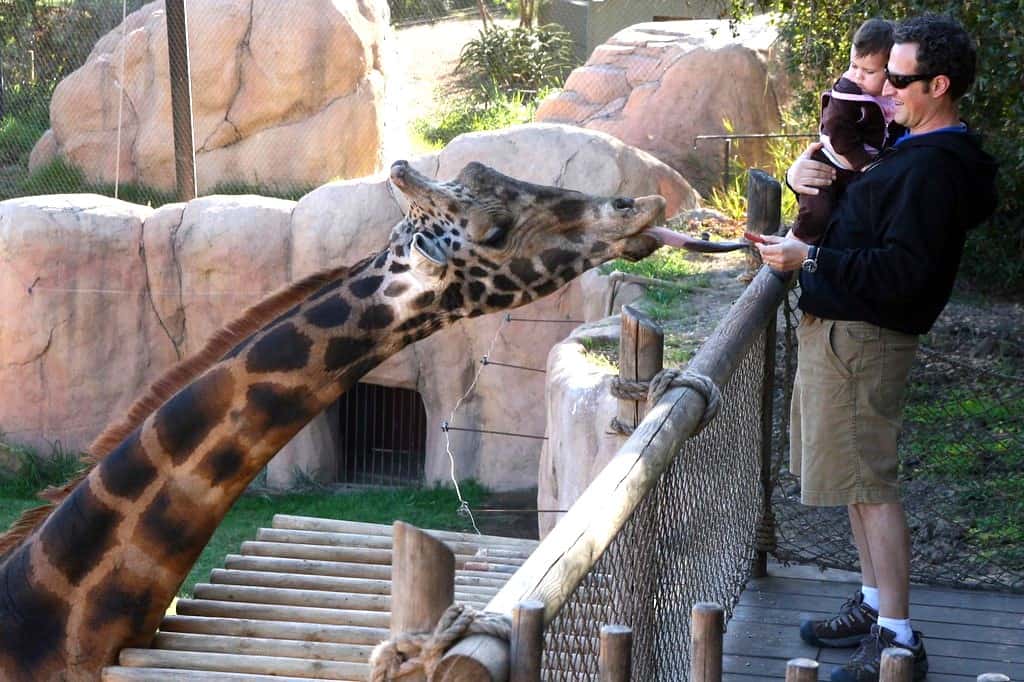
500 Ninos Dr, Santa Barbara
I have a special place in my heart for the Santa Barbara Zoo. It is just so beautiful and charming, and the giraffes have a million-dollar ocean view that I can’t help but be jealous of.
While it does not house as many animal species as the larger zoos in Los Angeles and San Diego, the Santa Barbara Zoo has some unique features that make it quite special.
A small train circles the entire zoo, giving riders a backstage peek at the zookeepers caring for the animals. They can also visit the Ridley-Tree Animal Kitchen and watch keepers prepare food for the animals via a large viewing window.
Make time to feed the giraffes and visit the Australian Walkabout where you can see kangaroos, wallabies, and emus up close.
They offer several special behind-the-scenes animal encounter experiences such as the Humbolt Penguin Fish Toss and lion or amur leopard training wall demonstrations.
After a couple hours at the zoo, walk down the hill to East Beach. This sandy beach stretches for 1.5 miles and has sand volleyball courts as well as a fun playground for the kids.
Admission Info: Tickets to visit the Santa Barbara Zoo must be reserved in advance online. Both time and date must be selected.
7. The Living Desert Zoo and Gardens

47900 Portola Ave, Palm Desert
If your travels take you to the Coachella Valley, definitely make time to visit The Living Desert Zoo and Gardens in Palm Desert. This world-class zoo and botanical garden is filled with exhibits featurings the plants and animals that call the deserts all over the world home.
Endangered cats like the cheetah, amur leopard, caracal, jaguar, and mountain lion call this zoo home. So do hyenas, Mexican wolves, meerkat, giraffes, and a wide variety of reptiles, among mant others.
If you have always wanted to feed a rhino, The Living Desert is a great place to do it. The Rhino Care Team will introduce you to a black rhino in a semi-private encounter. There are also giraffe feedings and seasonal camel rides (which take place in the cool season).
Additionally, The Living Desert is home to an extensive model train display, train rides, and a carousel. A tram runs around this sprawling zoo and has many stops, ideal for hot summer days or people with mobility issues.
Admission Info: Tickets for The Living Desert should be purchase in advance online as reservations are required at time of purchase.
8. San Franciso Zoo

Sloat Blvd & Upper Great Hwy, San Francisco
The San Francisco Zoo is a 100-acre zoo with a great location, just across the street from Ocean Beach on the city’s southwestern side. Highlights include the Lemur Forest, grizzly bear habitat, penguin pool, and the zoos big cats.
I have fond memories of watching the big cats (lions and tigers) get fed daily from inside the Lion House, but that experience has been temporarily closed, likely due to Covid.
Zoo Keys are another nostalgic aspect of this zoo that my in-laws remember from growing up in San Francisco and visiting the zoo regularly. For just $5 you purchase a plastic key and then turn on various boxes that have recording of stories and fun facts about animals.
Children love animals, but sometimes it is good to mix in a ride or some time on a playground. This zoo has a carousel and miniature steam train, as well as a playground and children’s zoo where kids of all ages can pet sheep and goats and watch the ever-entertaining meerkats and prairie dogs.
Admission Info: Tickets to visit the San Francisco Zoo must be reserved in advance online. Both time and date must be selected.
9. SeaWorld San Diego

500 Sea World Dr., San Diego
Acrobatic dolphins, playful penguins, silly sea lions, and splashtacular rides have made SeaWorld one of San Diego’s most visited attractions. Where else can you learn about marine ecology, get kissed by a beluga whale, and enjoy thrill rides all in the same day?
SeaWorld has been the subject of some controversy in recent years, resulting in them ending the captive breeding of orcas. There are still several orcas at SeaWorld SanDiego, but once these residents grow old, they will not be replaced. Until then, you can enjoy up close views of these majestic animals.
There are several different up-close encounters that guests can pay to experience with animals such as beluga whales, dolphins, sloths, penguins, sea otters, and more. These encounters give you a chance to learn more about these creatures and get an idea of what training and care goes into keeping them onsite.
Families always enjoy touching the bat rays at Bat Ray Shallows, feeding the sea lions, watching sharks swim overhead in the massive aqaurium, and watching the engaging animal presentations featuring orcas, dolphins, sea lions, and otters.
Of course, rides have become a big draw for some visitors to SeaWorld and there are now more than a half dozen coasters as well as rides geared towards younger children.
Admission Info: You can purchase “any day” tickets but there are significant discounts available for when you select specific days online. You can also purchase bundles to visit the Sand Diego Zoo and Safari Park or include all-day dining with your admission.
10. Oakland Zoo
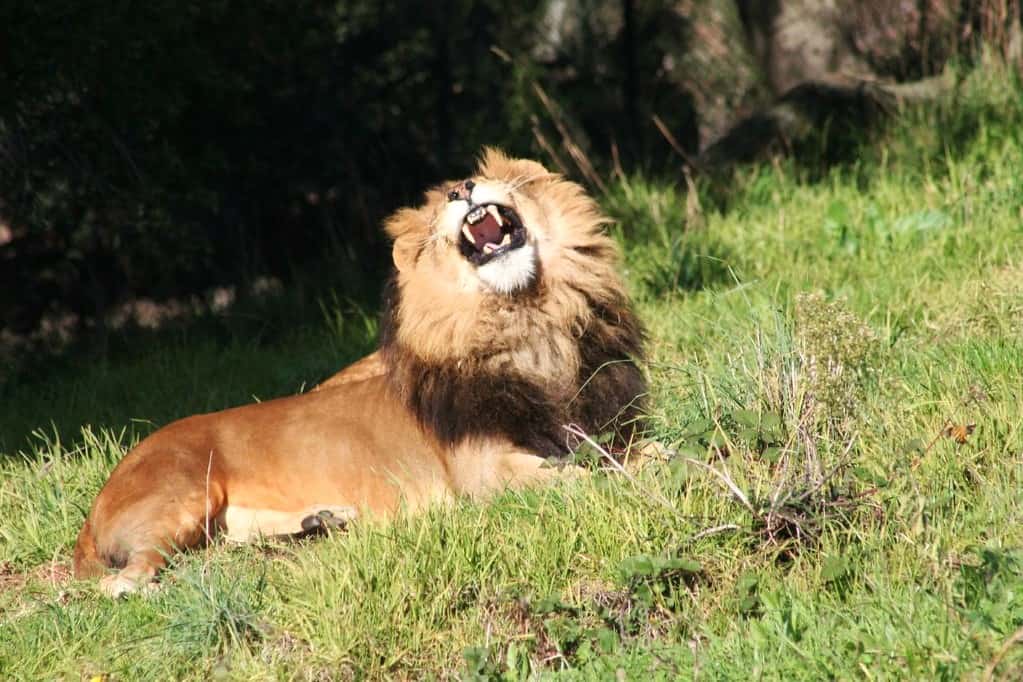
9777 Golf Links Rd, Oakland
The Oakland Zoo has been delighting Bay Area families with its animals for more than 100 years! It is home to an impressive African savannah area with modernized enclosures for elephants, tigers, monkeys, camels, and more.
You will definitely want to take the aerial gondola to the California Trail which is home to black bears, bison, bald eagles, and the mighty California condor. This area also has a nice play area for the kiddos.
This zoo is also home to a large exhibit focused on rainforest animals as well as a Wild Australia exhibit home to adorable wallaroos, and always-entertaining emus. Unlike most zoos in California, this one also has a few rides. There is a carousel, small roller coaster, a train, and three other rides geared towards young children.
Oakland Zoo has the largest wildlife veterinary hospital in Northern California which allows it to conduct collaborative research with other zoos and scientists as well as help in the resuce of local wildlife.
Admission Info: Tickets must be reserved in advance online. Both a specific time and date must be selected.
11. Los Angeles Zoo

5333 Zoo Dr, Los Angeles
When I was growing up, the Los Angeles Zoo was my local zoo. I remember it fondly, including the lush atmosphere in Griffith Park and the exibits housing gorillas, elephants, and the revered and feared komodo dragon.
Much has changed at the zoo since my childhood, but its commitment to educating the LA metro urban sprawl about animal conservation continues. As a matter of fact, the LA Zoo played an important role in the successful attempts to save the California condor from extinction with a captive breeding program.
Today, more than 270 different animal species call this zoo home, including favorites like chimpanzees, jaguars, and sea lions, as well as lesser known creatures like the fossa, Coquerel’s Sifaka, and the babirusa.
Admission Info: Advance online reservations are required for entry and the last admission to the zoo is 3:45 as it closes at 5pm daily.
12. Santa Ana Zoo
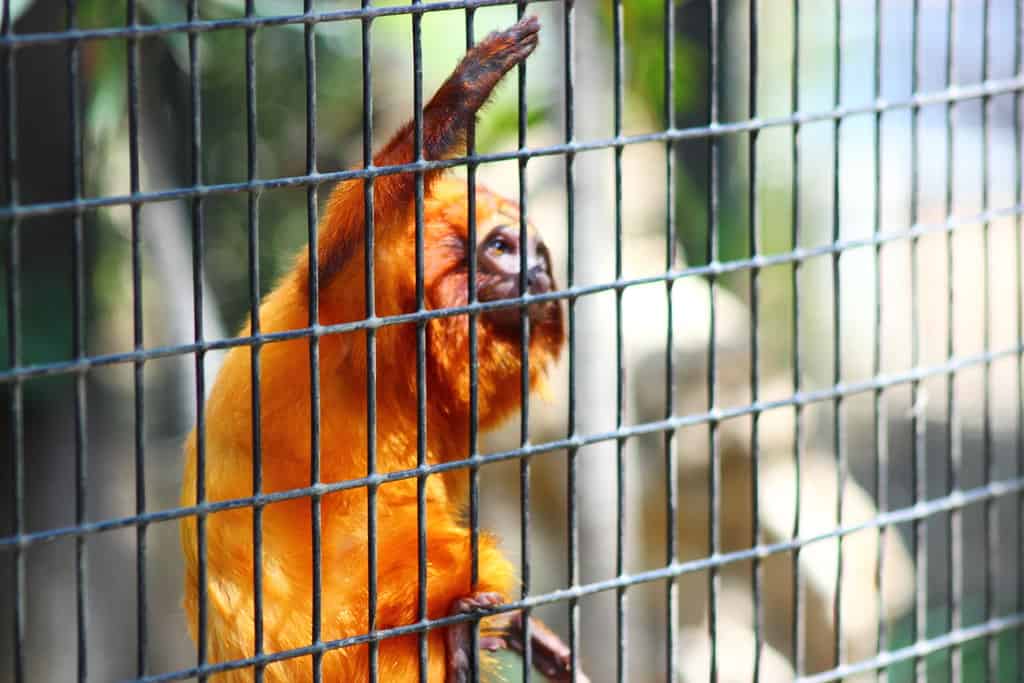
1801 E Chestnut Ave, Santa Ana
The Santa Ana Zoo is small in size but perfect for families with young kids. It is home to an impressive monkey collection and is often to referred to as “the monkey zoo” by locals due to its founder’s requirement that the zoo house at least 50 monkeys at all times.
You won’t want to miss Tierra de las Pampas, a South America- focused exhibit with anteaters, guanacos, and rheas that is designed to immerse guests in a landscape typical of where these animals live in the wild.
The zoo also has a train (orignally used the old Santa’s Village near Lake Arrowhead), a large playground, carousel, Ferris wheel, and farm, all of which are popular with kids 10 and under.
Admission Info: The Santa Ana Zoo is open daily from 10-5pm. Tickets can be purchased at the gate.
13. Orange County Zoo

1 Irvine Park Rd, Orange
The Orange County Zoo is a small zoo inside of Irvine Regional Park, a fantastic park filled with playgrounds, trails, paddleboating, horseback riding, surrey rentals, and the ever-popular Irvine Park Railroad.
This zoo focuses on animals that live in Orange County or once lived in the Orange County. This includes bears, bobcats, mountain lions, bald eagles, porcupines, a variety of reptiles, and more. There is also a small petting zoo with goats and sheep.
Since admission to the zoo is just $2 and there are so many other things to do inside the park beyond the zoo, it is easy to make a visit to Irvine Regional Park an inexpensive, all-day outing.
Admission Info: Admission can be purchased at the gate.
14. Birch Aquarium
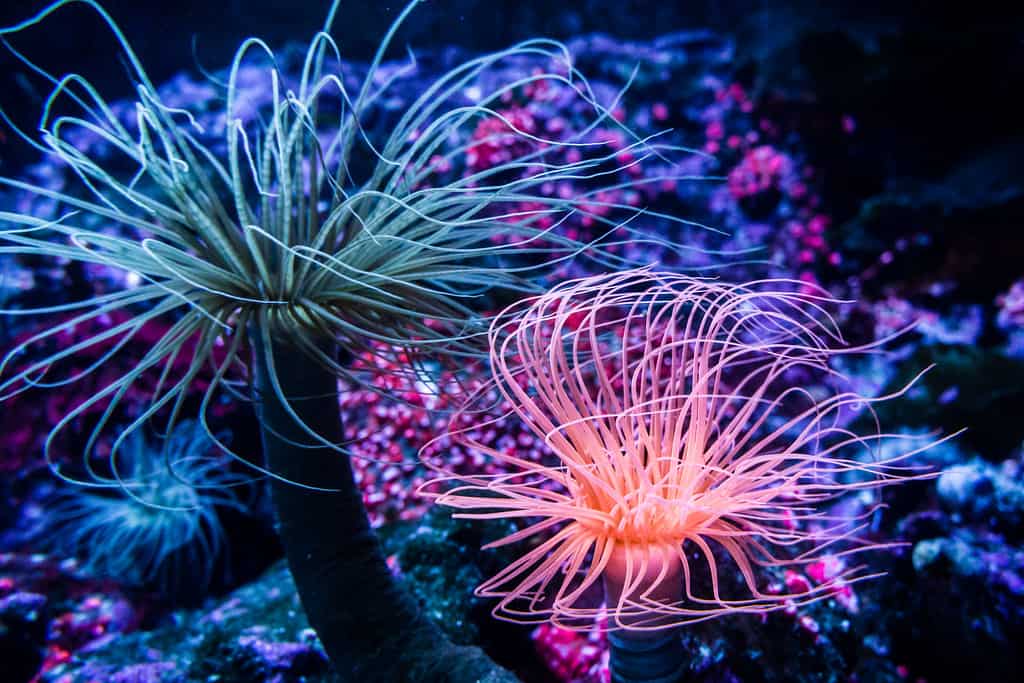
2300 Expedition Way, La Jolla
Birch Aquarium is an aquarium run by the Scripps Institution of Oceanography at the University of California, San Diego. The facility houses 3,000 animals representing 380 species. The main attraction is the Hall of Fishes which has 60 different tanks showcasing sea animals of the Pacific.
Outside you will find Shark Shores, home to the La Jolla’s famed leopard sharks and Tide Pool Plaza where you can touch sea stars, sea anemones, sea cucumbers, and hermit crabs.
The newest and most exciting attraction at the Birch Aquarium is the exhibit housing Little Blues, the smallest species of penguins. They are less than a foot tall and weigh just two to three pounds! This is the only place on the West Coast to see these adorable seabirds.
Admission info: Advanced ticket reservations online are highly recommended.
15. Sacramento Zoo
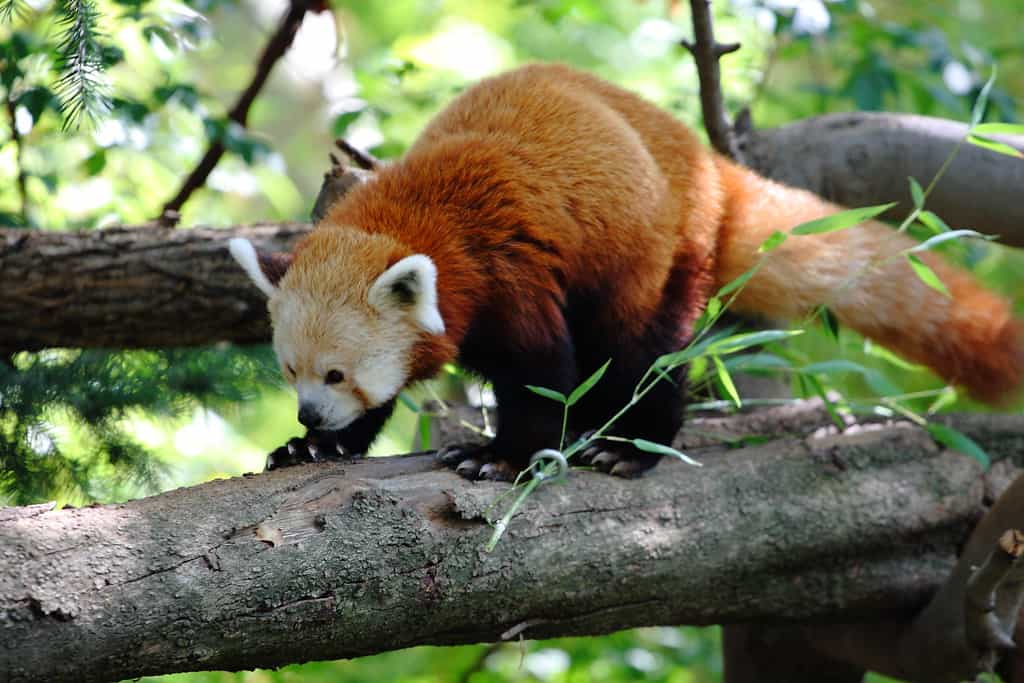
3930 W Land Park Dr, Sacramento
The Sacramento Zoo opened nearly 100 years ago with just 40 animals. Today, more than 400 animals call this small but mighty zoo in William Land Park home.
Many of the favorites can be found here like cheetahs, lions, kangaroos, giraffes, sloths, and red pandas. They have a few different behind-the-scenes tours, including one where you get to hand feed an okapi! There is also a tour where you can help prepare meatballs for cheetahs and then watch them up close during a training session.
Tip: If you have young children be sure to make time for Fairytale Town across the street. It was always a big hit with my kids when they were toddlers.
Admission Info: If you purchase your tickets online you will save over the “at the gate” pricing.
16. Fresno Chaffee Zoo

894 W Belmont Ave, Fresno
The largest zoo in the Central Valley is the Fresno Chaffee Zoo. It is small, only occupying 39 acres, but it has been providing entertainment to families in this agricultural region for generations.
Feed the stingrays at Stingray Bay, check out an underwater view of sea lions at play at Sea Lion Cove, and excavate fossils at the Dino Dig area. A favorite is the Roo Walkabout housing kangaroos, wallabies, emus, and other Australian animals in an open-air enclosure which allows the critters to hop right past you! The walkthrough portion of this exhibit is currently open Friday – Sunday during regular Zoo hours.
There are several different close-up encounters that guests can pay for, which typically involve the opportunity to meet and feed animals like red kanagaroos, warthogs, elephants, giraffes, and a giant Gilapagos tortoise.
It can get hot in Fresno during the summer months and the Wilderness Falls water play area is a great place for the kids to cool off from the summer heat. There are restrooms to change into swimsuits right there, and tables for parents to sit at while the kids play.
Admission Info: You can purchase your tickets in advance online or at the zoo gate.
17. Monterey Zoo
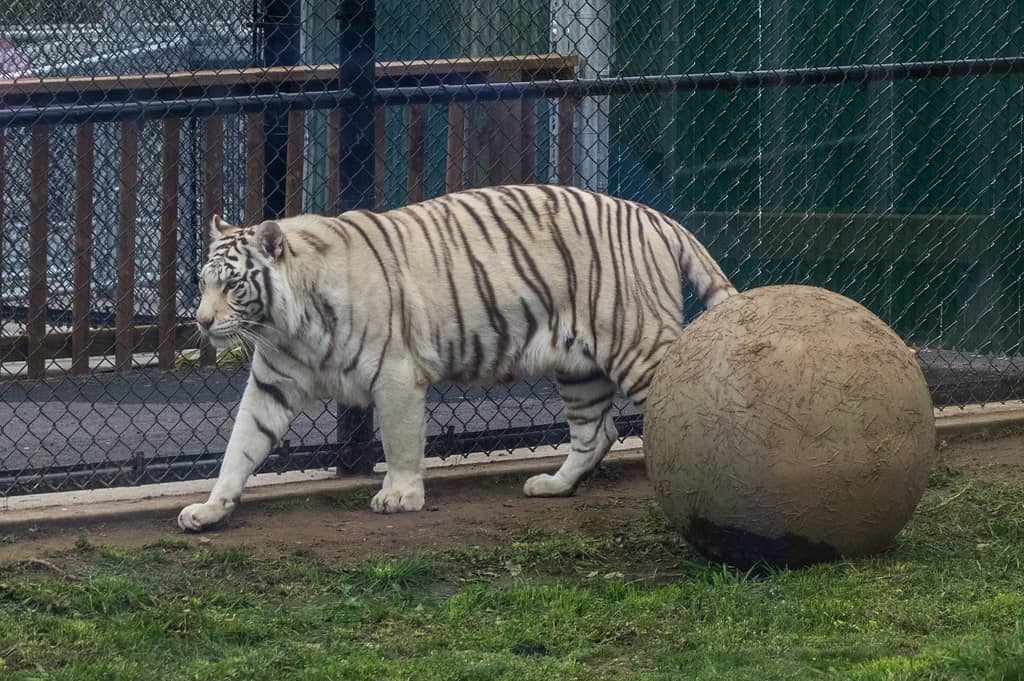
400 River Rd, Salinas
The newest zoo in California is the Monterey Zoo. This zoo was started by a police officer who responded to a call about a pet cougar in someone’s garage. This led to him adopting this exotic animal (and others), becoming a Hollywood animal trainer, and eventually buying Vision Quest Ranch in 1994.
After years of running private educational programs, the zoo opened in 2020 and is home to 100 different animals. There are several cat species like leopards, lions, tigers, cougers, servals, and caracals. There are also elephants, bears, primates like lemurs and baboons, reptiles, several more mammals, and a small collection of birds.
The Vision Quest Ranch Bed and Breakfast (on the same property) has been in business before the zoo was accredited. It has several African tent-style bungalows that allow you to glamp with the sounds of lions and tigers roaring only yards away.
In the morning you will enjoy a continental breakfast and get the chance to meet one of the zoo animals. You will likely also see trainers on their evening walks with zoo ambassador animals. Visits to the zoo are complimentary for B&B guests.
There are several different behind-the-scenes tours available for purchase which get you closer to the animals as well.
Admission Info: Tickets to visit the zoo can be purchased online or at the zoo’s gift shop. Special tours and stays at the Bed and Breakfast should be booked online.
18. Charles Paddock Zoo

9100 Morro Rd, Atascadero
The Charles Paddock Zoo is very small, only five acres, but it provides are great opportunity for families on the Central Coast to enjoy wildlife. It was established by a local park ranger who was known for his ability to nurse injured wildlife back to health.
In many ways, it is like the Orange County Zoo in that it is small but also sits in a lovely park with a playground, paddle boats, bike rentals, but this zoo focuses on exotic wildlife instead of local animals.
Animals you can exepect to see at the Charles Paddock Zoo include Malayan tigers, a red panda, lemurs, monkeys, tortoises, snakes, birds, meerkats, and more.
Admission Info: The zoo is open seven days a week and admission can be purchased at the gate.
19. Happy Hollow Park and Zoo

748 Story Rd, San Jose
Happy Hollow Park and Zoo has been delighting Silicon Valley families since the 1960’s. It is another small zoo and park at only 16 acres in size.
The zoo has a nice assortment of lemurs, birds, capybaras, fossa, and other unusual animals. There is also a variety of barnyard animals and wallabies near the petting zoo- including miniature horses, zebu, and donkey.
In addition, there is a small amusement park, with several pint-sized rides, a couple fantastic playgrounds, and even puppet shows! There is also a fun sandbox to dig/sweep for fossils, and a ‘swamp’ the kids like to cross.
Overall, this zoo is a great option for toddlers and preschoolers since many of the additional attractions are geared towards them.
Admission Info: You can purchase tickets in advance online or at the gate.
20. Sequoia Park Zoo
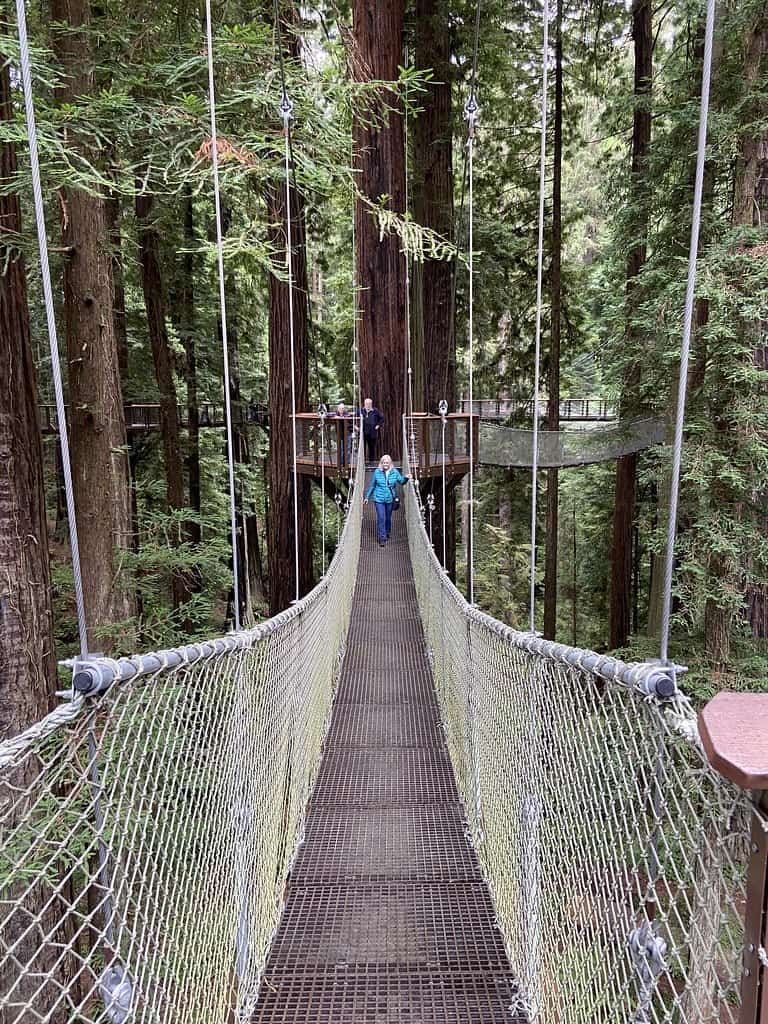
3414 W St, Eureka
Sequoia Park Zoo holds the designation of being the oldest zoo in California. It was founded in 1907 way up in the northwest corner of California in the town of Eureka.
It is set in the redwoods so it is no surprise that they opened the Redwood Sky Walk in 2021. It is the longest skywalk in the West at a a quarter mile in length, and sits 100 feet above the forest floor. Almost all of the Sky Walk is wheelchair and stroller accessible, except for the optional 369-foot adventure leg.
Of course, the animals are an important draw as well. The Watershed Heroes exhibit focuses on animals that live in Pacific Northwest watersheds like otters, bald eagles, and salmon. The red pandas, cotton top tamarins, and barnyard animals are all popular with visitors. A new bear and coyote exhibit is expected to open soon.
Admission Info: The zoo is open Tuesday through Sunday. Admission can be purchased at the gate.
21. Big Bear Alpine Zoo

42801 Moonridge Rd, Big Bear Lake
Big Bear Alpine Zoo gets the distinction of being the highest zoo on our list. Sitting at nearly 7,000 feet in elevation, this zoo is a great place to spend some time with rescued wildlife. The zoo treats and releases sick, injured, and orphaned animals from across the region, but those that are too injured to be returned to the wild are given a permanent home in the zoo.
The zoo is home to native species such as bobcats, coyotes, black bears, bald eagles, and mountain lions, as well as exotic animals like snow leopards and gray wolves.
Admission Info: Tickets can be purchased online or at the gate. During the winter hours may vary after a snow storm due to snow removal.
I have been obsessed with California sea otters since I wrote a research paper on these curious creatures way back in 7th grade Life Science class. Over the years, I have traveled up and down the coast, eager to catch a glimpse of these precious, endangered animals in the wild. And thanks to extensive research and firthand experience, I know the best places to view sea otters in California.
Before I list my favorite places for spotting sea otters in Caifornia, I want to share some fun facts about these interesting creatures.
California Sea Otters- Where to Spot Them & Lots of Fun Sea Otter Facts
How Many Sea Otters Live in California?

Historically, the range of the sea otter extended up and down the California coast. Unfortunately, these dense-coated marine mammals were almost wiped out completely by fur traders by the early 19th century. By 1910, there were only about 50 sea otters left in California!
Thankfully, sea otters were given protected under the Endangered Species Act in 1977, and their population has slowly been recovering ever since. Before they were protected, there were only about 1,000 sea otters off the coast of California.
After a few decades of steady increase, the population has seen a bit of a decline. This is likely due to shark attacks, algae blooms, and disease. Today, there are a little over 3,000 sea otters in the wild and the good news is that range is continuing to expand.
Where do you Sea Otters Live in California?

The furthest south you will find sea otters is by San Nicholas Island (of Island of the Blue Dolphins fame), the most remote of all the Channel Islands, located 61 miles off the coast.
It is home to a large population of otters, many which are descendants of Southern California sea otters which were relocated there once sea otters were banned from the region in 1986 thanks to pressure from the commercial fishing industry.
You read that right. A protected species was banned from its native territory because the commerical fishing industry didn’t want to compete with the sea otters.
Unfortunately, we can’t visit the sea otters of San Nicholas Island because the island is controlled by the US Navy. Fortunately, there are plenty of other places where you can see sea otters in California!
Read about the efforts to return sea otters to portions of their former range in Northern California and Oregon.
Why are California Sea Otters Important?

Sea otters are a keystone species. This means that they are a species that the ecosystem, in this case the kelp forest, is highly dependent on in order to maintain balance. When there are no sea otters in the kelp forest, the entire ecosystem suffers.
Sea urchins graze on kelp. Without sea otters around to eat sea urchins, the kelp forests can be over grazed, causing the entire ecosystem to become unhealthy. Kelp forests flourish when there are sea otters living in them to keep the system in balance.
Healthy kelp forests are obviously important to the animals that live in this ecosystem, but they are also important to humans as well. Kelp forests are nurseries for several species of fish that are fished commercially. They also provide a platform for ecotourism, which can help boost the local tourism economy.
Sea kelp is also becoming more and more popular as a product unto its own. There are kelp fertilizers which are great for growing bigger and better backyard vegetables, kelp dietary supplements filled with antioxidants, and edible seaweeds that are especially popular in salad form.
What do California Sea Otters Eat?

The California sea otter’s favorite food is sea urchin. The more sea urchins in an area, the more likely young sea otters survive into adulthood.
In addition to sea urchin, sea otters will also eat abalone, mussels, clams, snails, and crabs. In other words, they tend to stick to a diet of invertebrates. They will use tools, like a rock, to help crack open shells.
Fun fact: Sea otters eat 25% of their body weight every day!
What is a Group of Sea Otters Called?

A group of sea otters is called a raft. How cute is that? The name “raft” probably comes from the fact that sea otters will wrap themselves in seaweed to keep from floating away from each other and a big group of them floating together does kind of look like a raft!
What is the Difference Between a River Otter and a Sea Otter?

There are over a dozen different otter species in the world, but only two in North America- the sea otter and the North American river otter. The most obvious difference between them is that one lives in the ocean and the other lives in fresh water, but there are a few other things that make each species distinct.
Sea otters are much bigger than river otters. They weigh anywhere from 45-90lbs while little river otters only weigh about 20 lbs. Sea otters have a short, flat tail and river otters have one that is long and round. Sea otter fur is much more dense, giving them that super furry face that everyone loves. River otters look more like weasels.
Fun fact: Sea otters have the densest fur of any animal. This dense fur is what keeps them warm since they don’t have a thick layer of blubber like walruses, seals, and sea lions.
River otters swim on their stomachs while sea otters spend most of their time floating on their backs. River otters spend a good chunk of their lives on land as they mostly use water to travel and hunt. Sea otters, on the other hand, spend their lives almost exclusively in the water; they even give birth in the ocean! They also tend to only have one pup at a time while river otters often have four!
Love California wildlife? Check out our guide to the hawks of Southern California.
What are the Best Places to See Sea Otters in California?
Elkhorn Slough in Moss Landing

My absolute favorite place for viewing sea otters in California is at the Elkhorn Slough about 20 miles north of Monterey. This special place is home to the largest concentration of sea otters on the California coast, with over 100 sea otters calling the estuary home.
Elkhorn Slough is one of the best places for wildlife viewing in the state. In addition to sea otters, it is home to sea lions, harbor seals, over one hundred bird species, and dozens of fish species. It is no surprise that it has been designated a Wetland of International Importance.
The best way to view sea otters in Elkhorn Slough is in a kayak. Sea otter sightings are pretty much guaranteed.
There are individual kayak rentals available but if you are a first timer, I highly recommend a guided kayak tour. Guides know exactly where to go to see the wildlife and will provide you with a wealth of information about these critters.
The very best time to kayak in Elkhorn Slough is during the spring when there are baby sea otters, harbor seals, and sea lions to tug at your heart strings. They are even more cute in person than you can imagine!
Morning is the best time to paddle the tidal waters of the Elkhorn Slough. Winds are more likely to pick up in the afternoon.
If you aren’t up for kayaking, check out the harbor in Moss Landing. You will often view sea otters floating around just offshore. There is also a group of sea otters that likes to hang out in the cove near the sand dunes at Moss Landing State Beach.
Tip: if you get hungry after all that paddling and sea otter viewing, we recommend you stop by the Haute Enchilada Café, Gallery & Social Club in Moss Landing for lunch. This eclectic cafe serves up Latin American dishes, many of which feature sustainable seafood and local organic produce, and has a gallery featuring local artists.
Monterey

Monterey is a popular seaside vacation destination, known for being the home of the famed Monterey Bay Aqaurium, one of the finest aquariums in the world. While you can see sea otters at the Aquarium, it is more exciting to see them in the wild.
The Monterey Bay Coastal Recreation Trail runs from Lovers Point Park, past Cannery Row (where the aquarium is located) and Fisherman’s Wharf, and continues 18 miles towards Castroville. It is a great trail to bike, stopping along the way to check for sea otters bobbing out in the water.

Lovers Point Park and Beach is technically in neighboring Pacific Grove, but it is close to all the action in Monterey and also happens to be a great place for spotting sea otters. There is a nice kelp forest offshore where they like to hang. You can rent kayaks and explore the area, scuba dive, or just watch from the picture-perfect shoreline.
I have seen sea otters swimming around just below Old Fisherman’s Wharf many times. Grab a bowl of the famous clam chowder in a sourdough bread bowl and enjoy it while keeping your eyes on the water around the wharf.
There are several whale watching trips that originate in Monterey, and are especially popular in the winter during gray whale season. Sea otters are commonly spotted on these trips as well.
Pebble Beach

Well known as one of the premier golfing destinations on the planet, Pebble Beach is also a haven for wildlife. Harbor seals, sea lions, deer, migrating whales, birds, and even the mighty sea otter call this beautiful place home.
While you can spot sea otters bobbing around in the water from the golf course, you don’t have to be a golfer to enjoy the resident sea otter population. Stillwater Cove‘s calm and protected waters are the place to be.
You do have to pay the fee to access 17-Mile Drive (which is well-known for its incredible views) and head to the public parking along Cypress Drive which is right next to the Beach & Tennis Club. You can head to the beach by following the public access path or join a guided kayaking or stand-up paddleboard tour of the cove.
Point Lobos State Reserve

Located just south of Carmel-by-the-Sea, Point Lobos State Reserve was once deemed “the greatest meeting of land and water in the world”, by Australian landscape artist Francis McComas.
It is a striking landscape of turquoise waters, craggy cliffs, and sculptural Monterey cypress trees. One of the “crown jewels” of the California State Park system, Point Lobos is a great place to enjoy hiking and wildlife viewing while surrounded by some of the most stunning scenery anywhere.
The best time to view sea otters in the coves of Point Lobos is during the fall and early winter. China Cove and Hidden Beach are two of the best places to spot them. Spring is another great time if you are trying to catch a glimpse of babies. Binoculars will certainly help your efforts as well.
If you are a scuba diver and can score one of the 15 permits offered per day, Whalers Cove and Bluefish Cove are the best places to explore the kelp forests that the otters call home.
Morro Bay

Morro Bay, a small coastal town known for towering Morro Rock that looms over the bay, has become a great destination for viewing sea otters in recent years.
This population of around 40-60 sea otters is doing very well, thanks in part to the Morro Bay Estuary which provides protection from predators and a safe place to raise little sea otter pups.
Morro Rock is a great place to visit and watch the sea otters in the kelp beds, especially in the morning. Look for them on the trail that leads from the parking lot on the bay side of the rock. Binoculars are useful for spotting the otters.
There are several spots along the Morro Bay Embarcadero that you can stop and catch views of the sea otters floating in the bay. You will often see them from the pier.

The best way to get up close and personal with the sea otters is by taking a kayak tour. Operators like Central Coast Outdoors know exactly where these furry critters like to hang out, and will give you lots of great information along the way. Some tours even involve a sunset paddle with wine!
If you would rather paddle on your own, there are several kayak outfitters in the area. Just remember to respect the wildlife and give them space.
If you want to get out on the water but aren’t up for paddling, you can rent a pontoon boat from Estero Adventures and cruise around the bay in search of otters. Prefer to leave the driving to someone else? Take a tiki cruise, head out on a cruise with Captain Stew, or even on a sea sub tour which will explore life above and below the water line.
In nearby Cayucos, head to Estero Bluffs State Park and take the three-mile trail that hugs the coastline. Bring your bincoluars and keep your eyes out for sea otters bobbing offshore.
San Simeon

San Simeon is a great place to visit if you want to see sea otters and elephant seals in the same place. San Simeon’s elephant seal rookery is definitely worthy of your time, and the parking lot is a great jumping off point for your sea otter spotting adventure.
Take the Boucher Trail north along the beach towards the Piedras Blancas Light Station, and keep your binoculars handy. You will usually spot sea otters along the water adjacent to the two-mile trail. They are commonly seen near the lighthouse.
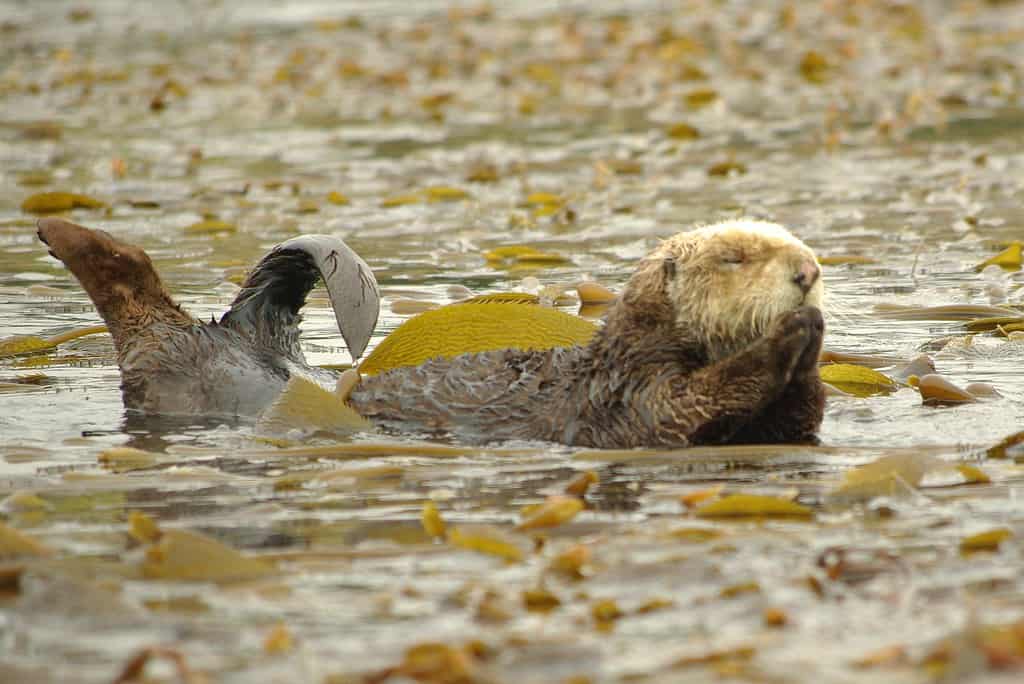
Closer to town, you can also see sea otters in San Simeon Cove, home to the San Simeon Pier and William Randolph Hearst Memorial State Beach. Make a reservation for a tasting at the Hearst Ranch Winery tasting room which sits by San Simeon Cove, to celebrate you sea otter viewing victories afterward.
Avila Beach

Avila Beach is a cute little seaside vacation destination for many Central Valley families. It has a nice beach, lots of ice cream and salt water taffy, and a pier. The water is chilly, but those escaping those Central Valley summers never seem to care!
In recent years, I have seen sea otters bobbing around in the waters just off the Avila Beach Pier. You can also see them over by the Harford Pier which is located on the north side of town along San Louis Obispo Bay. If you want to head out into the bay you can rent a kayak from Avila Beach Paddlesports.
9 More Places for Sea Otter Spotting in California

Almost the entire central California coastline has potential for sea otter spotting. Pack your binoculars and keep an eye on kelp beds, where sea otters tend to hang out. Here are a few more spots we know that have sea otter viewing opportunities:
- The Bluff Trail at Andrew Molera State Park in Big Sur.
- Partington Cove Beach in Julia Pfeiffer Burns State Park in Big Sur.
- The Castle Rock Viewpoint near the famous Bixby Creek Bridge in Big Sur.
- Garrapata State Park which has two miles of beachfront in the Monterey Bay Marine Sanctuary.
- Pismo Beach near the pier. Sea otters were considered a pest here for decades because of the impact they had on Pismo Beach’s once robust clamming tourism industry.
- Moonstone Beach in Cambria. You can also rent kayaks here.
- Montaña Del Oro State Park‘s Bluff Trail is a good location for sea otter spotting just south of Morro Bay.
- Wilder Ranch State Park in Santa Cruz. Check out the views from the sea cliffs along the Old Cove Landing Trail.
- Año Nuevo State Park in Pescadero is one of the northermost places to see sea otters in California. This state park is known for being a elephant seal haven in the winter months.
Ready for a vacation? Don’t miss these incredible Southern California weekend getaways.
Lead image via Flickr.
]]>There are at least 45 different species and subspecies of snakes that call Southern California home. Some are definitely more common than others, but it is always exciting to see one slither by.
I have put together this guide to snakes in Southern California to help you identify the snakes you discover while exploring SoCal, and give you a little insight into the tremendous diversity we are lucky enough to have.
45 Snakes in Southern California
California Kingsnake
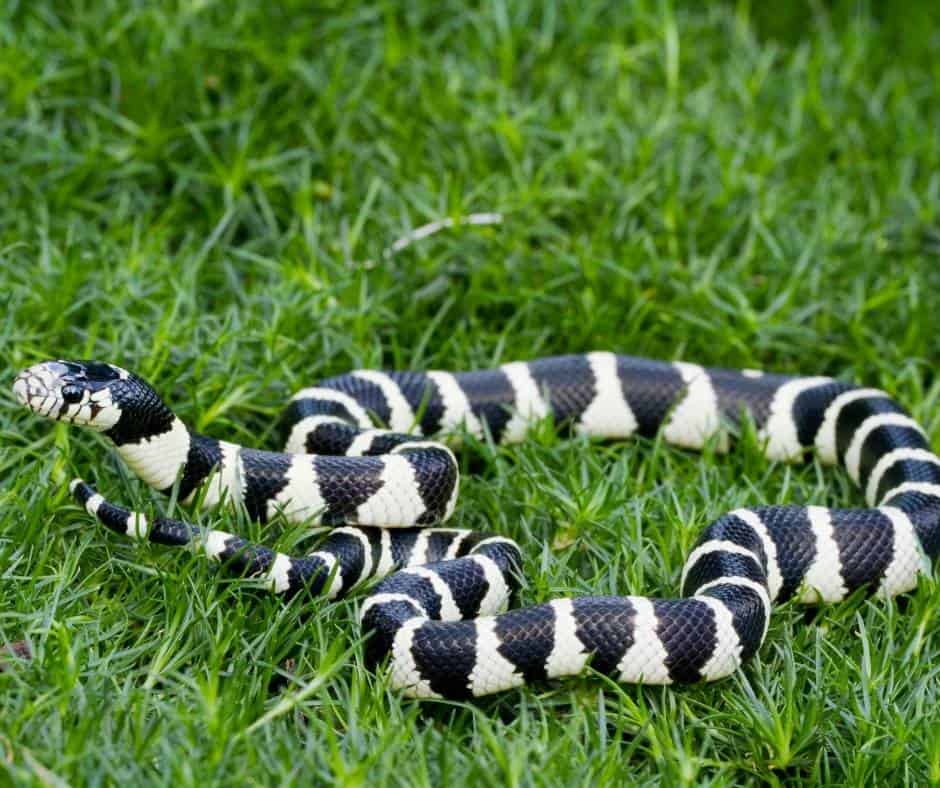
Is a California Kingsnake venomous? No
Where does the California Kingsnake live in Southern California? Kingsnakes live in every county in Southern California. They inhabit a wide variety of landscapes including coastal scrub, woodlands, grasslands, chaparral, and desert scrub.
Kingsnakes are one of the more common species of snake in Southern California. This is in part because they are adaptable to a wide variety of landscapes.

They do come in a variety of colorations, but the most common are dark brown or black in color with whitish yellow bands. They are known as “king” snakes because they eat other snakes, including venomous rattlesnakes! They also eat lizards, birds, and rodents.
Califronia Kingsnakes are slender but they can grow about 2.5 – 4 feet in length. They weigh about 3lbs.
Learn more about Southern California wildlife. Here is your guide to all the hawks in Southern California.
Coast Mountain Kingsnake

Is a Coast Mountain Kingsnake venomous? No
Where does the Coast Mountain Kingsnake live in Southern California? Mountain areas across Southern California, especially closer to the coast, but as far east as the San Bernardino Mountains.
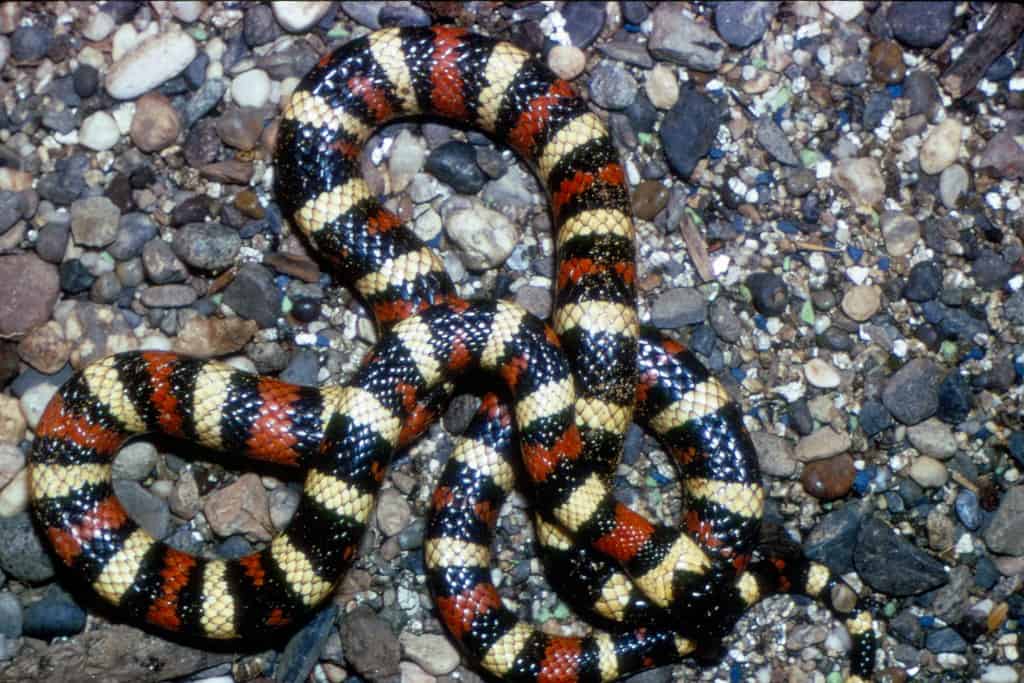
The California Mountain Kingsnake is one of the most beautiful snakes in Southern California. It has repeating bands of reddish orange, black, and off white. This distinct coloring makes them easy to identify. They are generally 2-3 feet long and slender.
Their diet is similar to that of the California Kingsnake- primarily reptiles, birds, and rodents. They live in oak and pine woodlands, chaparral and coastal sage srub, and wooded areas near water.
Southern Pacific Rattlesnake

Is the Southern Pacific Rattlesnake venomous? Yes! If you are bit seek medical treatment immediately.
Where does the Southern Pacific Rattlesnake live in Southern California? This rattlesnake lives in every county of Southern California except Imperial County. It can be found in nearly all of Santa Barbara, Ventura, LA, Orange, and San Diego counties. It is also in the western third of Riverside County and southwestern corner of San Bernardino County.
The Southern Pacific Rattlesnake is the subspecies of Western Rattlesnake that is most commonly seen in Southern California. It is the snake I most commonly see when I am out hiking in Orange County. You are most likely to see them sunning themselves in the spring and fall.
They often see you before you see them and will give you fair warning with a rattle of their tale. They are not aggressive but they are venomous, so steer clear and give them plenty of space if you are passing by.

Many people tend to think that the rattlesnakes they seeing in the LA/OC/SD area are Western Diamondback Rattlesnakes, but those snakes do not live in this area. If you see a rattler near these heavily populated urban and suburban areas, it is very likely a Southern Pacific Rattlesnake.
They live in a variety of Southern California landscapes such as chaparral, rocky areas, and grassy areas. I have seen them most often near rocks sunning themselves or in dry grass near the edges of trails.
These snakes are anywhere from 1-5 feet long, and have a stripe behind the eye extending behind the corner of the mouth. They have the triangular head that is common with all pit vipers.
Southern Pacific Rattlesnakes have rattles at the end of their tales, but young rattlers may only have a single rattle. Their tails are more stumpy than a Gopher Snake (which can look similar). Gopher Snakes have tails that taper and become quite skinny at the end.
They do have light and dark rings at the tail but they aren’t sharply contrasting like the Western Diamondback and Northern Mojave Rattlesnake. There is a thicker tail ring right before the rattle that is generally dark brown in color.
Fun fact: A new rattle is gained each time the snake sheds it skin!
Their coloring varies in shades of medium brown to a darker olive brown. They have bloches going down the length of their body which are outlined by a light brown/offwhite color. Their undersides are typically pale in color.
These snakes eat lizards; small mammals like mice, rabbits, and ground squirrels; amphibians; birds; and even other snakes!
They are often ambush predators but they will also chase a critter when they are on the move. Since they are pit vipers, they have pits on the side of their heads that sense heat and help them target prey.
There are over 25 varieties of snakes in Joshua Tree National Park, including the Southern Pacific Rattlesnake. Use our Joshua Tree Day Trip Itinerary and keep your eyes out while exploring.
Western Diamondback Rattlesnake

Is a Western Diamondback Rattlesnake venomous? Yes! Immediately seek out anti-venom at a hospital if bit.
Where does the Western Diamondback Rattlesnake live in Southern California? This rattlesnake is found in most of Imperial County and the eastern half of Riverside County in the Colorado desert. If you spend time at the Colorado River, you just may encounter this snake.
The Western Diamondback Rattlesnake is a beautiful rattlesnake, highly regarded in Western lore.
These are big snakes, generally 3-5 feet in length, but some have been recorded at up to seven feet long! This is the largest rattlesnake in the state.
Western Diamondbacks are not agressive towards humans and will only attack as a defensive measure. Most bites occur when people are messing with these snakes or not paying attention to wear they are walking and step near them. They can strike withing one-third of their body length, so give them space!
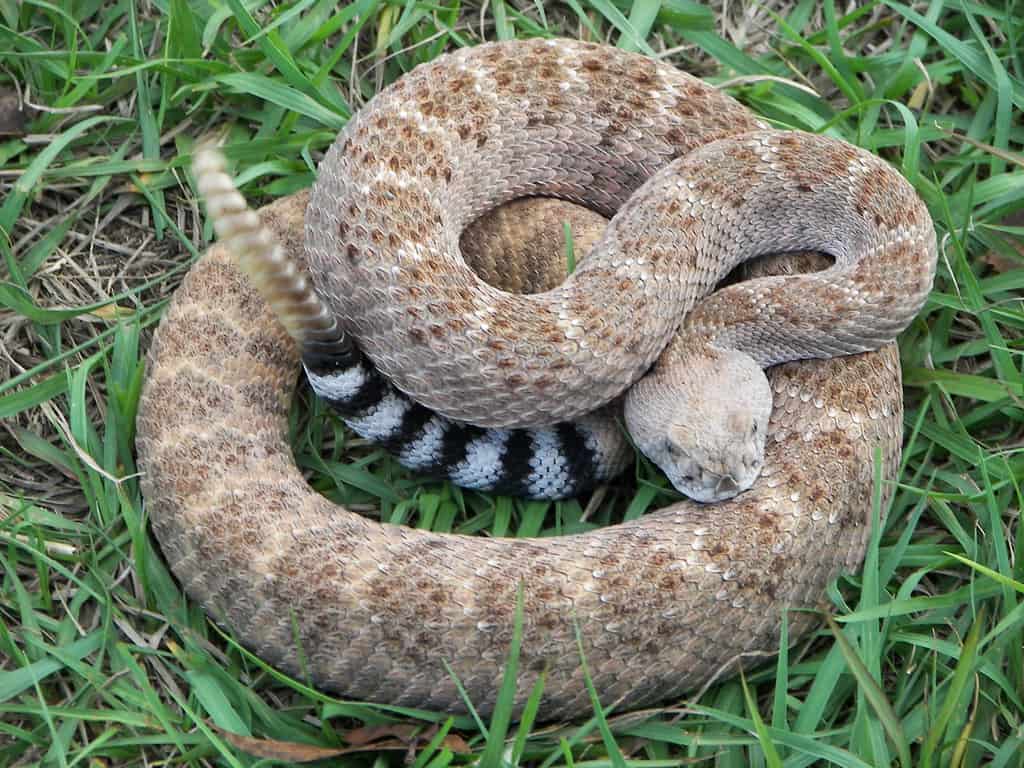
It has the triangular head common to pit vipers, and a thick body. It is most easily identified by the black and white bands evenly spaced on its tail just before the rattle and the diamond pattern on its back.
They come in a variety of shades of brown, olive, and tan that tend to reflect their habitat and help them camouflage.
They eat a variety of small mammals such as mice, kangaroo rats, and jackrabbits. They also will eat lizards and birds. They have pits on the side of their heads that sense heat and help them target prey.
Fun fact: Rattlesnake rattles are made of keratin, which is the same protein that makes up our fingernails and a rhino’s horn. Pieces of rattles can get damaged or break off, but it is painless.
Northern Mojave Rattlesnake

Is the Northern Mojave Rattlesnake venomous? Yes! This is the most venomous snake in the state. Seek urgent medical treatment immediately if bit.
Where does the Northern Mojave Rattlesnake live in Southern California? They are found in the Mojave Desert which makes up most of San Bernardino County as well as the Antelope Valley in LA County and eastern Kern County.
In many ways, the Northern Mojave Rattlesnake looks and acts like a Western Diamondback, but there are some differences in appearance.
The most easy way to differientiate the two is location, location, location. Northern Mojave Rattlesnakes live in the high desert while Western Diamondbacks live in Southern California’s low desert.
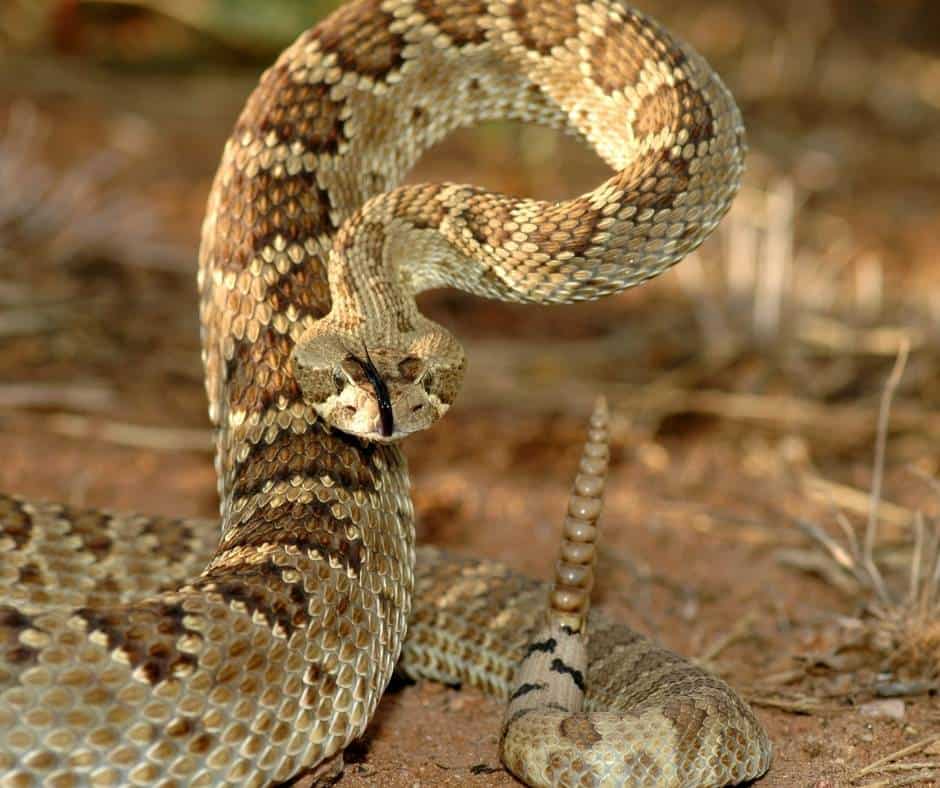
These snakes really do come in a variety of colors, from an almost black/dark brown color to a greenish tinge to a very light tan.
They have a well-defined diamond pattern going along their back and black and white rings near the rattle like a Western Diamondback, but the black rings are narrower than the white rings in this rattler.
The light band that extends from its eye towards its jaw is not as long as the Diamondbacks and does not cross the lip.
This rattlesnake feeds primarily on small mammals (mice, rats, rabbits, gophers), but will eat lizards and amphibians as well.
Southwestern Speckled Rattlesnake

Is a Southwestern Speckled Rattlesnake venomous? Yes! All rattlesnakes are venomous.
Where does the Southwestern Speckled Rattlesnake live in Southern California? The Santa Ana mountains in eastern Orange County, most of San Diego County (except the coastal area), eastern Imperial County, most of Riverside County, most of the southern half of San Bernardino County, and the Antelope Valley.
Speckled Rattlesnakes are most often spotted in rocky areas and they come in a variety of colors that camouflage well with their rocky homes.
If the rocks are light, the snake will be light in color with darker speckled bandings across its back. If the rocks are darker, the snakes will be darker brown with dark speckled bandings.

These snakes can be a light salmon color, gray, muted browns and even almost off white with speckles. Adult Speckled Rattlesnakes are typically 2-3.5 feet in length. They do have black and white (or off white) rings near the end of their tail at the rattle, similar to a Diamondback.
They are pit vipers with pits on the sides of their triangular heads used to detect heat and identify prey. They are primarily ambush predators who eat small mammals, reptiles, and small birds.
Red Diamond Rattlesnake

Is the Red Diamond Rattlesnake venomous? Yep!
Where does the Red Diamond Rattlesnake live in Southern California? It mainly lives in San Diego County, Orange County, and western Riverside County.
The Red Diamond Rattlesnake is another beautiful rattler in Southern California. It lives in the southernmost reaches of the state, mostly in coastal areas, chaparral, and rocky, scrubby mountain areas.

It can be reddish, pink, or tan with a red tinge. It does have a faint diamond pattern and the black and white rings near the rattle that are common among many rattlesnakes in Southern California. It is easiest to identify this snake because of its rusty or ruddy red coloring.
The Red Diamond Rattlesnake is 2-5 feet long and has those trademark rattlesnake pits on the sides of their triangular heads used to detect heat and identify prey. They eat small mammals, lizards, and birds .
Fun fact: A rattlesnake shakes its rattle 60 time per second. That’s fast!
Two-Striped Garter Snake
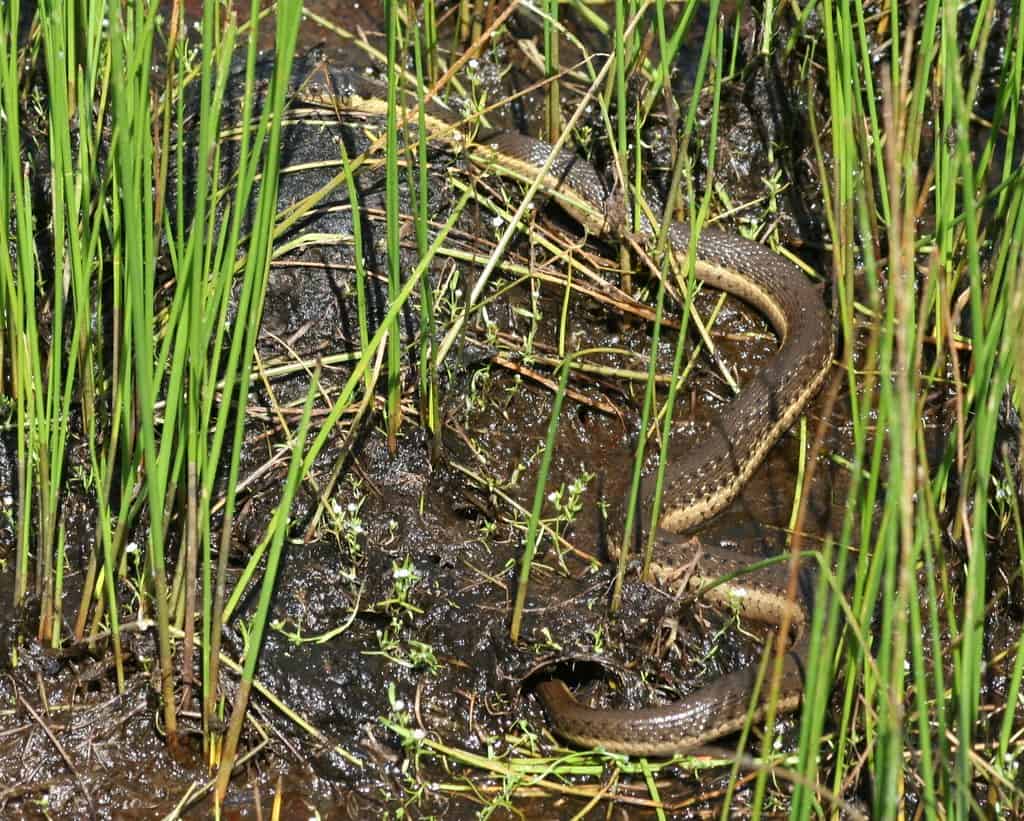
Is a Two-striped Garter Snake venomous? No
Where does the Two-Striped Garter Snake live in Southern California? In all of the coastal Southern California counties, as well as far western Riverside and San Diego counties.
The Two-striped Garter Snake is one of the snakes that calls Southern California’s freshwater waterways home. It is an aquatic snake that is usually spotted swimming across creeks, streams, and rivers.
Some of my favorite childhood memories were of catching Garter Snakes in my aunt’s backyard, running up behind my relatives to scare them with the snake, and then releasing them by her pond to watch them peacfully glide across the water.
This snake eats fish, and will grab a fish out of the water and then drag it to the shore to eat. It is quite a sight to see! The Two-striped Garter Snake also eats things that live along the water like frogs and worms.

This snake is not venomous or agressive towards humans. It is usually 2-3 feet long and is identified by two lateral stripes along the sides of the snake that are either yellow or gray.
Some are spotted with small dark spots on each side. They are usually darker in color- dark brown, olive gray, or almost black. They are usually pale yellow underneath.
Mountain Garter Snake
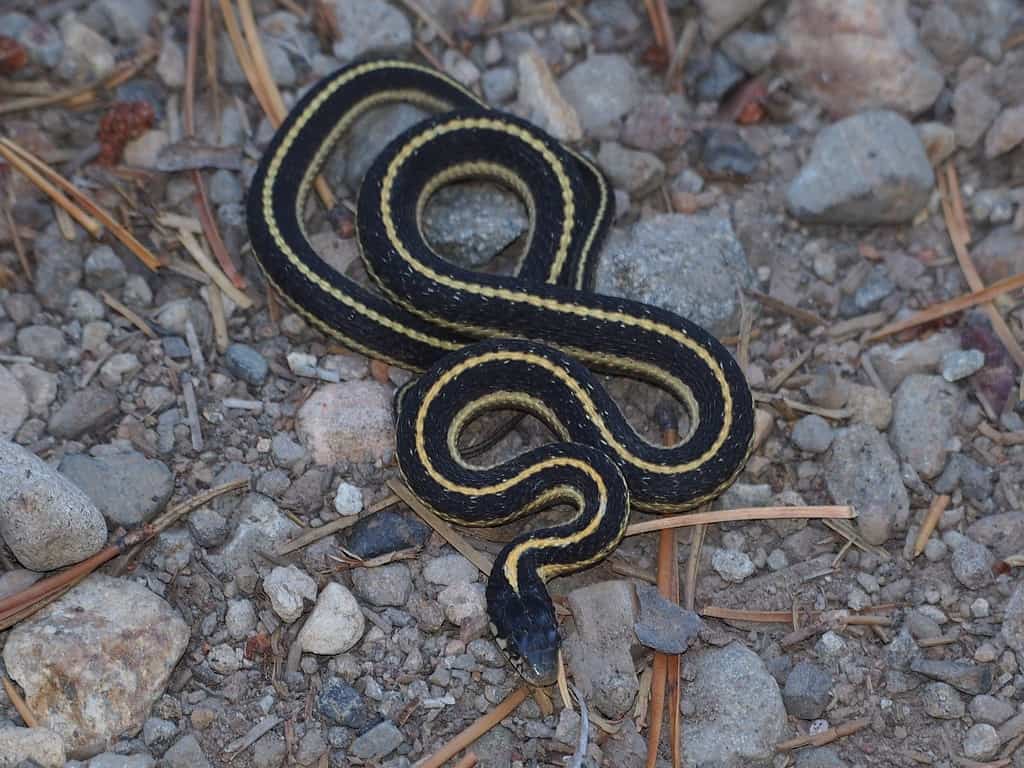
Is a Mountain Garter Snake venomous? No
Where does the Mountain Garter Snake live in Southern California? This species is only found in the San Bernardino Mountains in Southern California. Look for it in the areas around Big Bear.
The Mountain Garter Snake is quite common throughout much of Northern California but there is one isolated population in the San Bernardino Mountains.
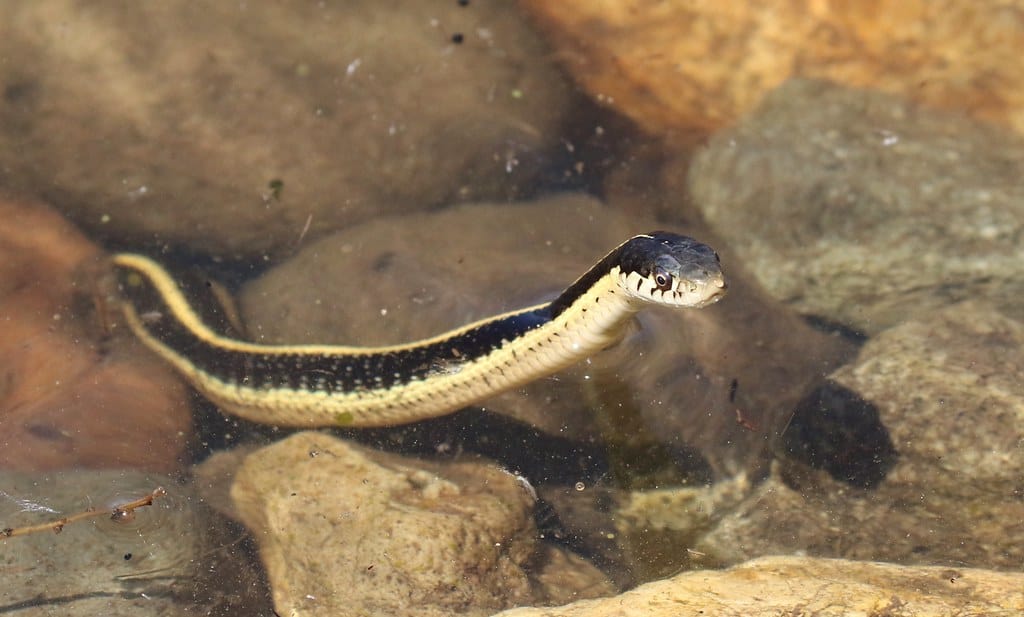
The population in Southern California is generally black with yellow stripes on either side of the body and one yellow stripe along the top of the snake’s back. It is usually a light yellow underneath.
Sometimes they will have thin yellow stripes among the black of their body running perpindicular their body length and almost look like speckling.
This snake is slender and the head is about the same width as the body. It is typically 2-4 feet in length. They tend to hang out near water like creeks and streams where they can feast on the critters that live in or near the water.
These snakes will eat a wide variety of creatures that live in and around the water including fish, frogs, leeches, slugs, lizards, and mice.
Marcy’s Checkered Garter Snake
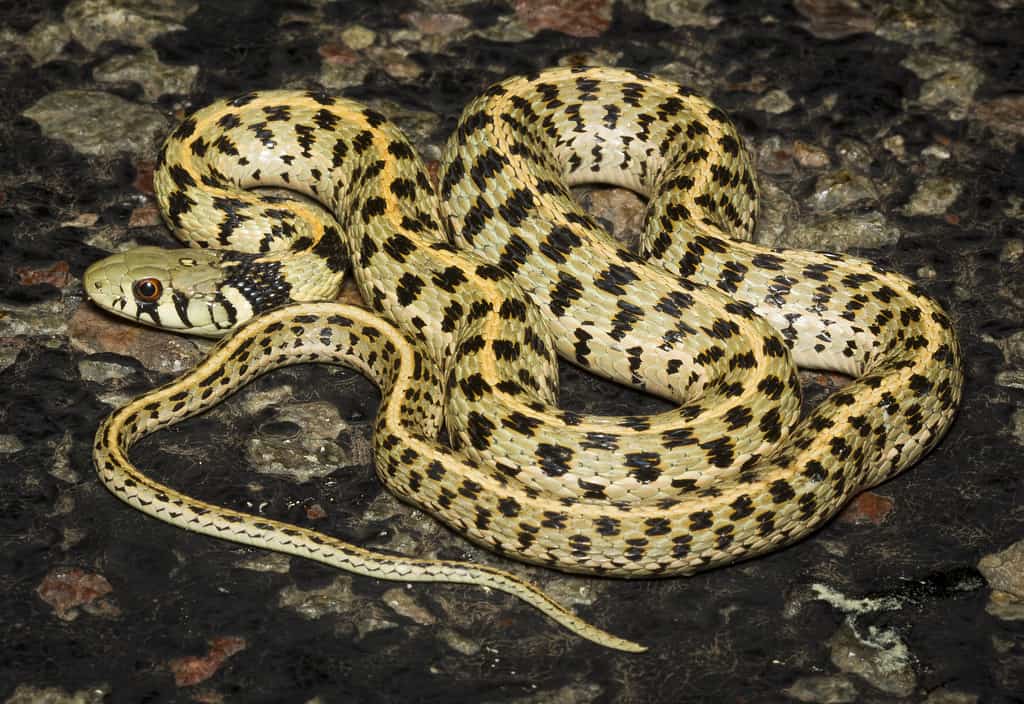
Is Marcy’s Checkered Garter Snake venomous? No
Where does the Marcy’s Checkered Garter Snake live in Southern Cailfornia? In agricultural waterways in Imperial County and the portion of SoCal runs along the Colorado River. It also can be found in the area around the Salton Sea.
The Marcy’s Checkered Garter Snake is not seen in most of Southern California, but if you head out to the Colorado River to camp and play, you just might see one. It is an aquatic snake so be sure to watch for it in the water and safe places to hide along the shore.
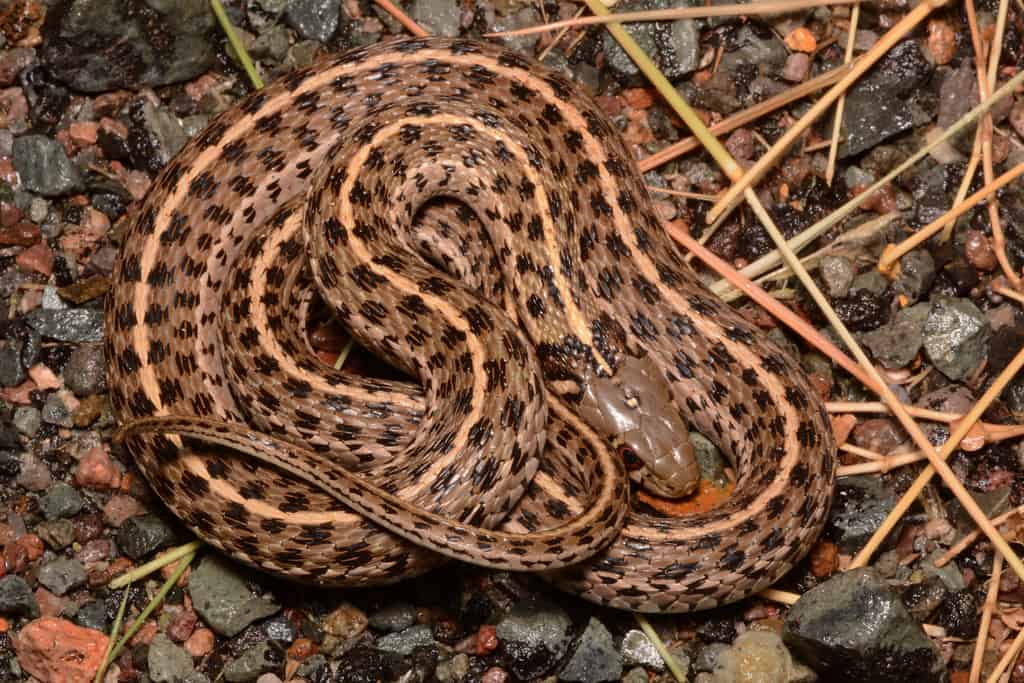
A Marcy’s Checkered Garter Snake is typically 2-3 feet long and has the yellow stripes on its back and sides that are typical of many garter snakes, but this snake has a checkerboard pattern of black splotches going along its back as well. It is usually tan or brown. It is light colored (pale yellow or off white) underneath.
The checkering does throw some people off and make them think it is not a harmless garter snake, but rest assured that these beauties aren’t venomous.
As with most garter snakes, Marcy’s Checkered Gater Snakes eat lots of amphibians and fish, but they will also eat lizards, small mammals, and even small snakes if given the chance.
Fun Fact: When Garter Snakes are picked up or disturbed they often empty the contents of the cloaca or produce a musk.
Common Garter Snake
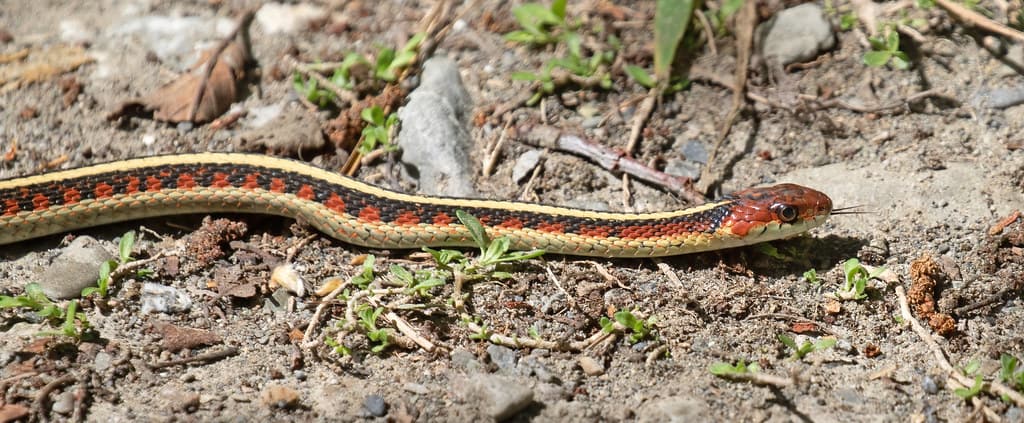
Is the Common Garter Snake venomous? Nope
Where does the Common Garter Snake live in Southern California? In regions close to the coast in Santa Barbara, Ventura, Los Angeles, Orange, and San Diego Counties as well as the far western portions of San Bernardino and Riverside Counties. It’s territory extends north into much of Central and Northern California.
There are two subspecies of the Common Garter Snake that call Southern California home. They are the California Red-sided Garter Snake and the Valley Garter Snake. The best way to tell them apart is to base it on geographic location.
The Valley Garter Snake is found in the the northern half of Ventura County and points northeast. The California Red-sided Garter Snake occupies occupies points south. It may also be found along the coast in Santa Barbara County and into Central California.
Both subspecies live in a variety of habitats, but usually near water like ponds, creeks, and marshes. They can be found near the ocean, in chaparral, in grasslands, farmlands, and wooded areas.
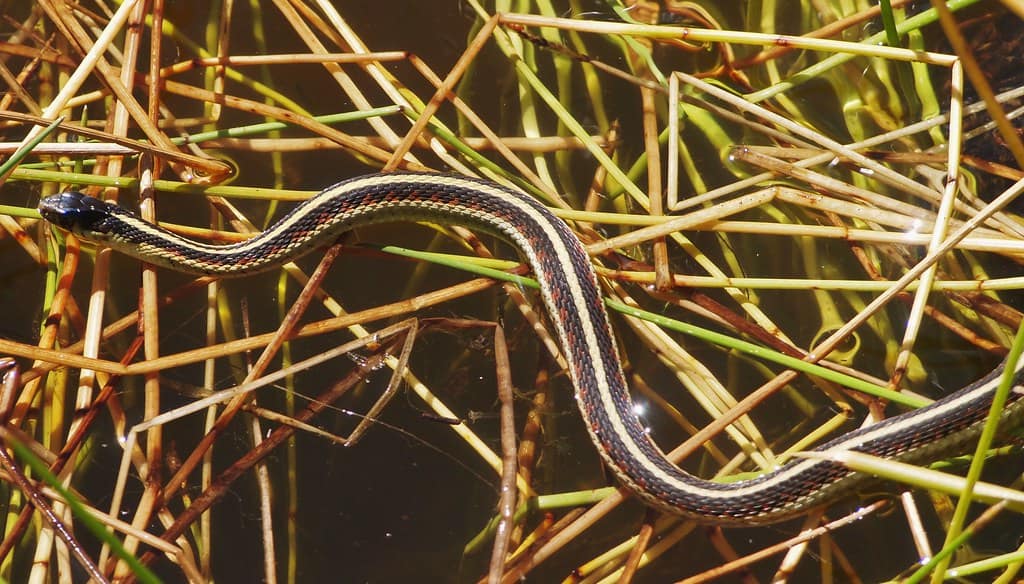
These snakes have the long, pale, yellow stripes on the top and lower side of their bodies that are common to garter snakes, but they also have red bars alternating in color with the body color running along either side of length of their bodies.
The body of these snakes tends to be a dark olive brown to black in color. It is usually about 3 feet long but can grow up to 4 1/2 feet in length. Heads are about the same width as bodies. They are a pale yellow to off white color underneath.
Like most garter snakes, they eat things that live near water like frogs, slugs, newts, small mammals, and fish.
Fun fact: There are some varieties of California Red-sided Garter Snakes that have aqua bluish stipes in places of the yellow. They are also aqua blue on their undersides!
Gopher Snake

Is a Gopher Snake venomous? No
Where Does the Gopher Snake live in Southern California? Gopher Snakes live all over Southern California. They are a very common snake and one of the snakes you are most likely to see in Southern California. There are four subspecies of Gopher Snake in SoCal which I will list below.
Gopher Snakes can be quite large and range in size from 2.5 feet to 9 feet long! They are daytime hunters which also increases the likelihood that you might spot one.
They are often confused with rattlesnakes because they can have similar coloring and size but there are a couple easy ways to tell them apart:
- Gopher Snakes don’t have rattles
- Gopher Snakes have tails that taper and go to a point. Even young rattlesnakes with just a single rattle have stumpy tails.
- Gopher Snakes have faces that are only slightly wider than their necks. Rattlesnakes have wide, triangular faces which are much wider than their necks.
Gopher Snakes are constrictors and kill their prey by striking and then squeezing them to death. They tend to eat small mammals like mice, rats, rabbits, gophers, and squirrels. They will also climb trees and get into birds nests. They eat lizards and insects when the pickings are slim.
They live in a wide variety of habitats including chaparral and coastal scrub, grasslands, woodlands, deserts, near water, in agricultural areas, in mountains, and canyons. Basically, they live all over Southern California.

The Pacific Gopher Snake lives in northern Santa Barbara County and points north throughout California.
Their main body color tends to be a tan to almost a pale brown-yellow. They have large dark brown splotches down their backs and smaller spots on the sides. The top of the head is usually brown. Eyes are typically brown, amber, or red.
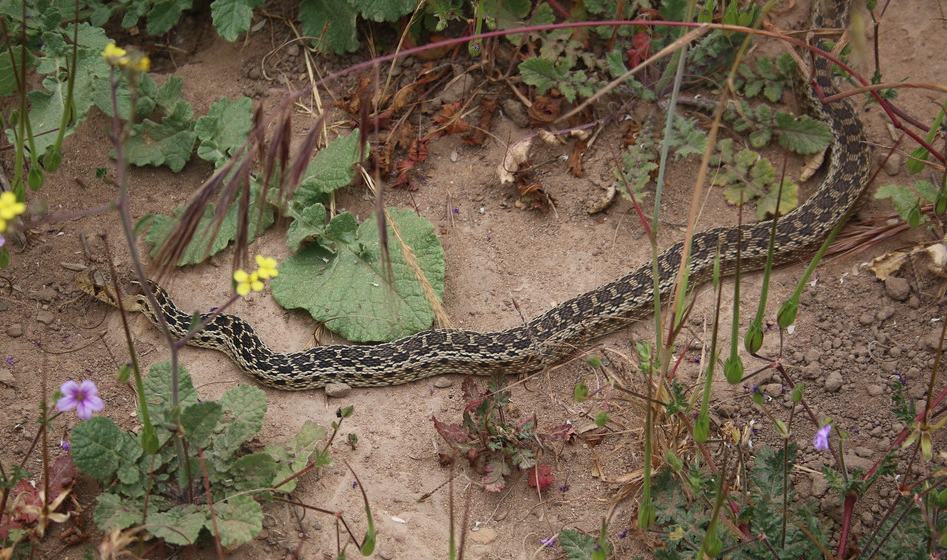
The San Diego Gopher Snake lives in coastal Southern California. Its range is as far north as coastal San Louis Obispo County all the way down to its namesake of San Diego. It includes most of Santa Barbara, Ventura, and LA Counties as well as all of Orange County, the western third of Riverside County, and the southwest corner of San Berardino County.
Like the Pacific Gopher Snake its body tends to range from light brown to yellowish. It also has the dark brown splotches down its back and smaller spots on the sides. The underside is a similar light color as well.
However, these snakes tend to darker (brown to even orange) on the top of their heads and some even have the orange down by the base of their tail and along portions of their back.
Others might not have much orange at all and look almost identical to Pacific Gopher Snakes. There are even varieties without spots! Gopher Snakes tend to have lots of exceptions to their identification rules so I tend to go by location when determining the subspecies.
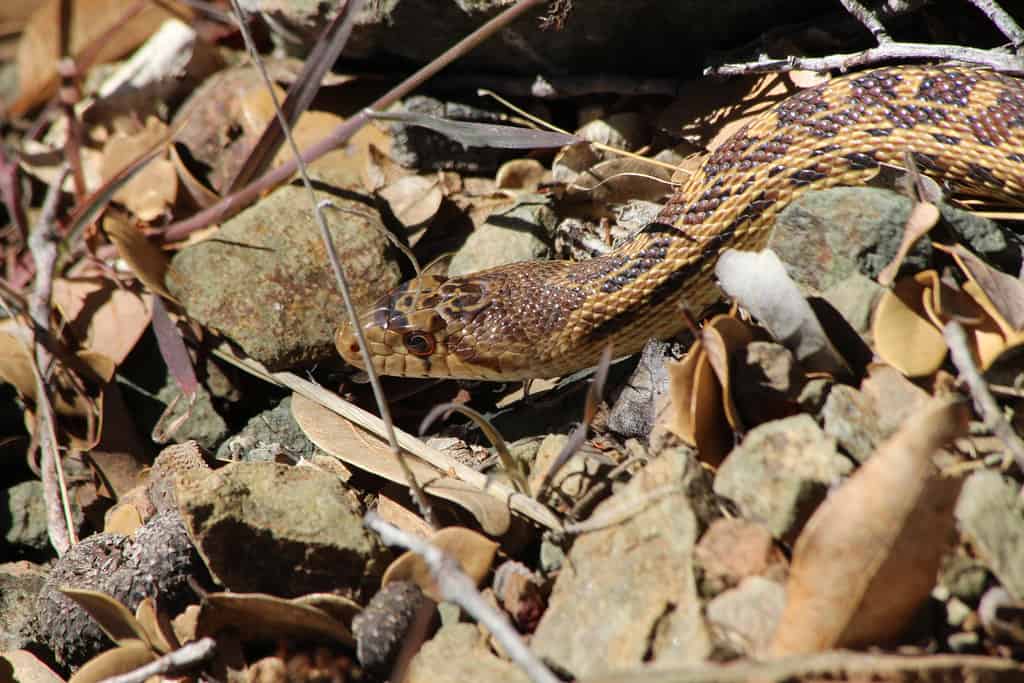
The Sonoran Gopher Snake lives in all of Imperial County and the easter 2/3 of Riverside County. It also lives in the small sliver of San Bernardino County that borders Arizona.
These snakes have light tan to straw colored bodies with the large brown splotches down their back and smaller spots on their sides. Their undersides are a light color.
The main way to differentiate them from Pacific Gopher Snakes (other than geographical location) is that the top of their heads are a light tan with little dark spots.

Finally, the Great Basin Gopher Snake lives in most of San Bernardino County (unless otherwise mentioned) and the Antelope Valley of LA County. Its range continues up toward Death Valley in Inyo County.
Once again they have the light cream to yellowish tan bodies, splotches down their back (brown, sepia, or even reddish) and small spots on their side.
The big splotches tend to be darker at the head and neck and lighter mid body. Their heads are typically close to the same color as their bodies. Undersides are light colored with dark marks.
Rosy Boa
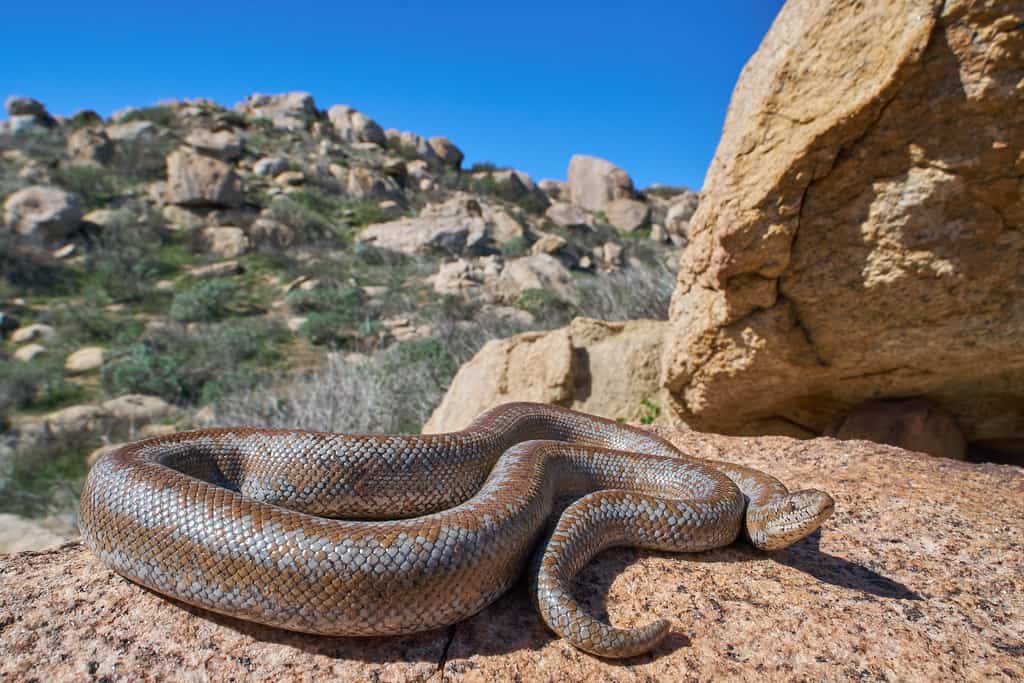
Is a Rosy Boa venomous? No. It kills its prey by constriction.
Where does the Rosy Boa live in Southern California? The Rosy Boa lives in San Diego County, most of Riverside County, the eastern edge of Orange County, northern half of LA County, eastern half of Kern County, and the northeastern corner of Imperial County.
There are two subspecies of Rosy Boar that call Southern California home. Both subspecies are usually between 1.5-3 feet long. The heads are basically the same width as their necks. Rosy Boas have a light base color and three darker stripes along their bodies- one on the top and two on the sides.
The Coastal Rosy Boa lives throughout San Diego County, in the portion of Orange County that borders Riverside County, the western third of Riverside County, southwestern corner of San Bernardino County, and most of the northern half of LA County.
Coastal Rosy Boas are usually a light cream or gray with orange or orangish brown stripes. There are also some unicolor Rosy Boas that tend to be an orangish gray. Their undersides are light with some dark splotches.
This boa is most commonly found in rocky deserts and shrublands, but it is also found in coastal chaparral in San Diego County and show up in the more aris, shrubby hillsides as well.

The Desert Rosy Boa lives in the Antelope Valley, most of San Bernardino County, the eastern third of Riverside County, northeastern corner of Imperial County, and its territory spreads into portions of Kern and Inyo County. It prefers rocky desert areas and more shrubby deserts and canyons.
Desert Rosy Boas are light tan or gray with more of a rusty-orange stripe color. Their bellies are typically light and may be spotted.
Both subspecies of Rosy Boa eats mice, kangaroo rats, ground squirrels, and other rodents as well as small reptiles, birds, and amphibians.
Western Yellow-bellied Racer Snake

Is a Western Yellow-bellied Racer venomous? No.
Where does the Western Yellow-bellied Racer live in Southern California? This snake is widely distributed through the coastal counties of Southern California (Santa Barbara, Ventura, Los Angeles, Orange, and San Diego). It can also be found in the southwestern corner of San Bernardino County and the western quarter of Riverside County.
The Western Yellow-bellied Racer (a great name for a snake!) is common throughout most of California, outside of the deserts and high alpine regions.
It hunts during the daytime and lives in most environments where it can find some sunshine like grassland, edges of lakes and streams, chaparral and woodlands that aren’t heavily forested.
This snake is usually under three feet long and olive, bluish gray, or brown on top. It is yellow (not just a clever name!) or off white underneath.
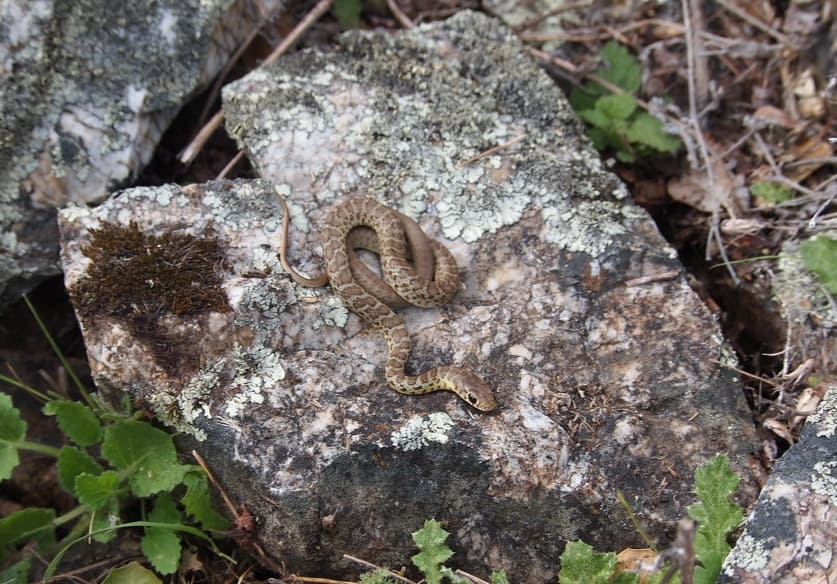
This is one of those snakes that looks drastically different when young. Young Yellow-bellied Racers have dozens of dark splotches all over their backs which make them look like Gopher Snakes, except they don’t have the stripes near their eyes that Gopher Snakes have.
They are good climbers and will climb trees if the opportunity for a meal presents itself, but they mainly stick to the ground.
These little suckers are aggressive and will bite if you don’t give them space. Luckily they aren’t venomous.
When these snakes hunt, they move along the ground with their heads held high. They lunge at their prey and crush it with their jaws, eating the animal alive.
They eat small critters like lizards, small amphibians, birds, eggs, mice,and voles. They will also eat large insects.
California Striped Racer Snake
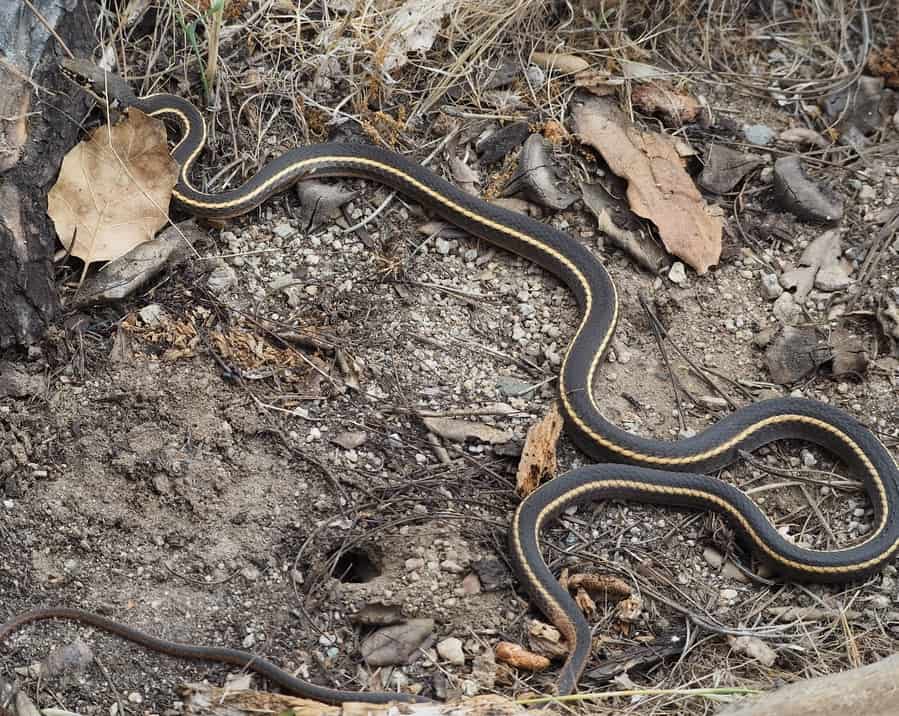
Is a California Striped Racer Snake venomous? No.
Where does the California Striped Racer live in Southern California? This snake is widely distributed through the coastal counties of Southern California- Santa Barbara, Ventura, Los Angeles (minus the Antelop Valley), Orange, and San Diego. It can also be found in the southwestern corner of San Bernardino County and third of Riverside County.
The California Striped Racer is similar to the Western Yellow-bellied Racer. It likes open area with plenty of sun available like chaparral, scrubby or rocky hillsides, water’s edge, and open woodlands.
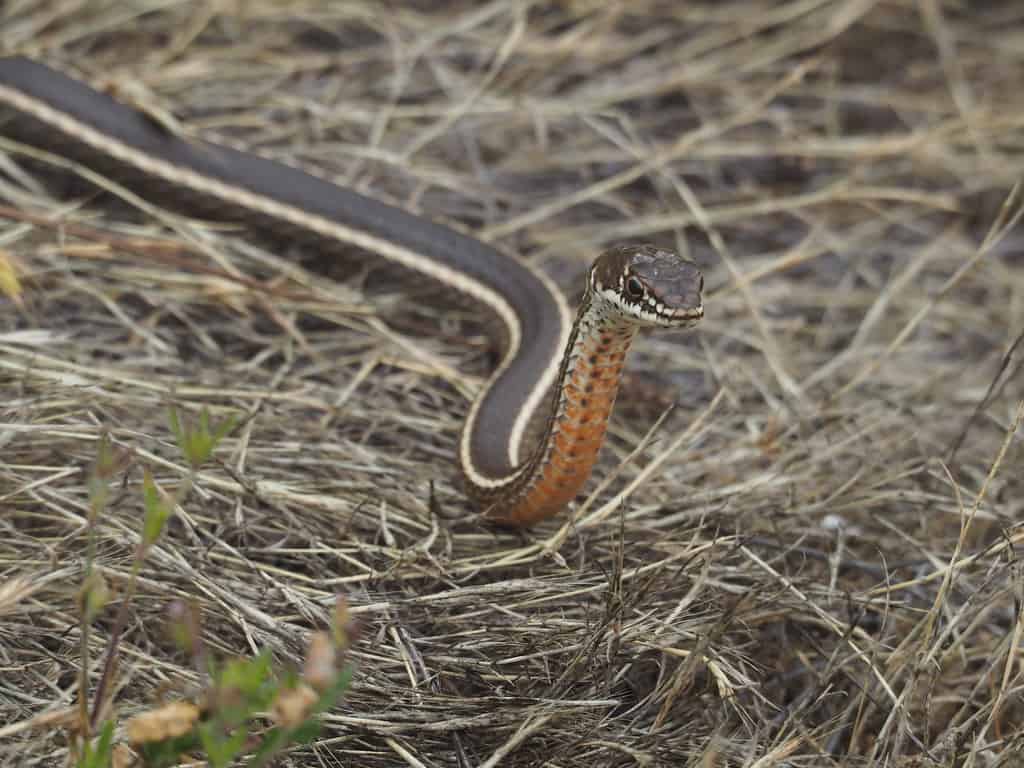
The California Striped Racer (Also known as a Whip Snake) is another snake that is common throughout large portions of California. It is usually 2-5 feet long and in many ways looks similar to a Garter Snake.
It is dark brown to black with two yellow stripes along either side of its body. Remember, Garter Snakes have three stripes? So if you only count two and don’t see a stripe on the mid-back, it is likely a California Striped Racer.
While it is not venomous, the California Striped Racer is agressive and will whip and strike repeatedly if you pick it up.
The California Striped Racer hunts in a similar fashion to the Yellow-bellied Racer with its head up and plenty of speed and great vision. They are also good climbers but mostly stick to land.
It likes to eat lizards (their favorite food) and other small creatures like mice, voles, frogs, small snakes, little birds, and salamandars.
Western Blind Snake
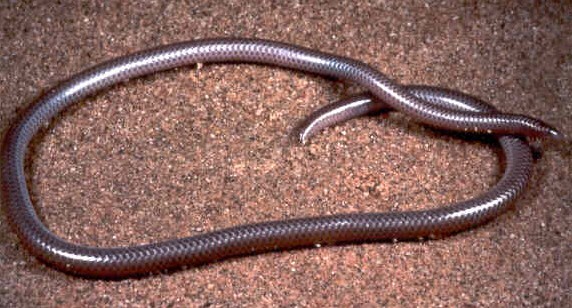
Is the Western Blind Snake venomous? Nope
Where does the Western Blind Snake live in Southern California? This snake is found in every county in Southern California.
Fun Fact: The Western Blind Snake is also commonly referred to as the Western Threadsnake
There are two subspecies of Western Blind Snake in Southern California, the Southwestern Blind Snake and the Desert Blind Snake.
The Southwestern Blind Snake lives in the more coastal regions of Southern California. It calls eastern Santa Barbara County, Ventura County, LA County, Orange County, San Bernardino County, western Riverside County, and most of San Diego County home. Its territory also stretches into Inyo and Kern counties.
Desert Blind Snake is a subspecies of this snake that lives in the southeastern corner of California, mainly in Inyo County, eastern Riverside County, and far eastern San Diego County.

Blind Snakes look a lot like worms. They are only 7-16 inches long when fully grow and very thin. Their heads are the same width as their neck. They even have the typical worm coloring- brown, pinkish, or dark gray.
These snakes are, in fact, blind. They are also nocturnal and hide under rocks or debris during the day. They mainly eat ants and termites and will burrow in the ground to reach them. This behavior also results in people mistaking them for worms.
Since they do burrow for their prey they live in places where burrowing is easy. Sandy places like beaches or deserts. Spots with looser soil like washes and rocky, brushy hillsides.
Red Racer Snake

Is a Red Racer Snake venomous? No
Where does the Red Racer Snake live in Southern California? This snake lives in every county in Southern California wherever the landscape is more desert or coastal scrub.
Another name for the Red Racer Snake is the Red Coachwhip. It is a fairly common snake in Southern California. The Red Racer can get quite big, three to nearly six feet long. Only the Gopher Snake is longer in Southern California.
Red Racers are usually red, pink, tan, or brown with distinctive black bands around their necks. They are typically light pink underneath. Their scales on their long, thin tails look braided like a whip, hence the name “coachwhip”.
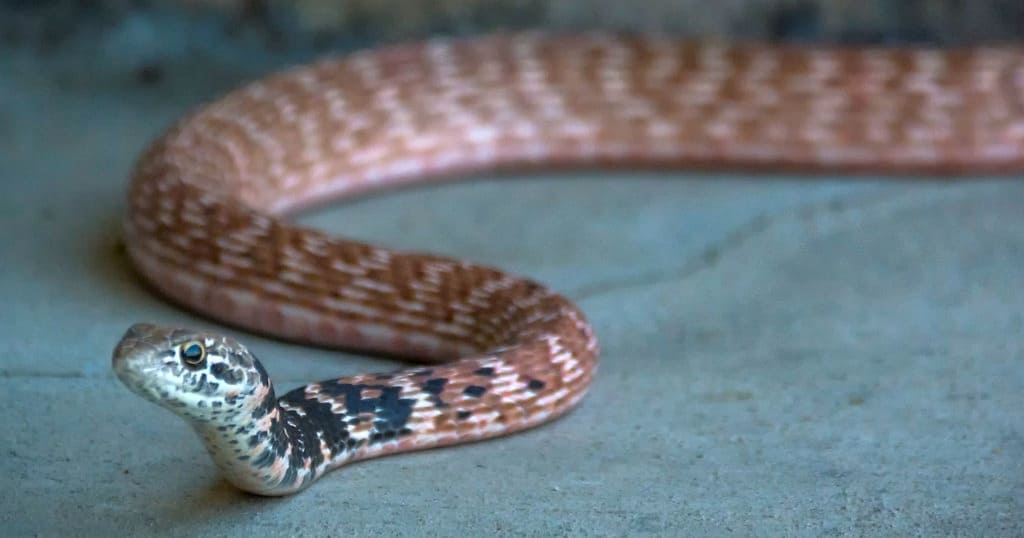
The Red Racer is quick and prefers habitats without dense vegetation that will slow it down. Therefore it lives in more open habitats like sagebrush, chaparral, desert, grasslands, and rocky areas.
It is an active hunter in the daytime, and hides in animal burrows, in brush, or under rocks when it is not out and about. It is good at climbing trees. When hunting, it crawls with its head up high, often swaying side to side.
It has excellent vision and scent, and crushes its prey with its jaws, eating the animal whole. It eats mice, kangaroo rats, lizards, small snakes, amphibians, small birds, eggs, and even bats.
Red Racers are often spotted alongside highways, unfortunately as roadkill. This is partially because they love basking in the heat reflected off the highway and partly because it will eat fresh roadkill.
They are also a more aggressive snake and will bite if threatened or attempted to be handled.
Ring-Necked Snake

Is a Ring-necked Snake venomous? It is mildly venomous but the venom does not pose a threat to humans.
Where does the Ring-Necked Snake live in Southern California? This snake lives in all the coastal counties of Southern California, as well as the southwestern corner of San Bernardino County and the western third of Riverside County.
There are three subspecies of Ring-necked Snake in Southern California- the San Bernardino Ring-necked Snake, the San Diego Ring-necked Snake, and the Monterey Ring-necked Snake.
The Monterey Ring-necked Snake lives in Santa Barbara County and up the Central Coast.
The San Bernardino Ring-necked Snake can be found in Ventura County, LA County (minus the Antelope Valley), Orange County, the southwestern corner of San Bernardino County and the western third of Riverside County.
The San Diego Ring-necked Snake lives in San Diego County.
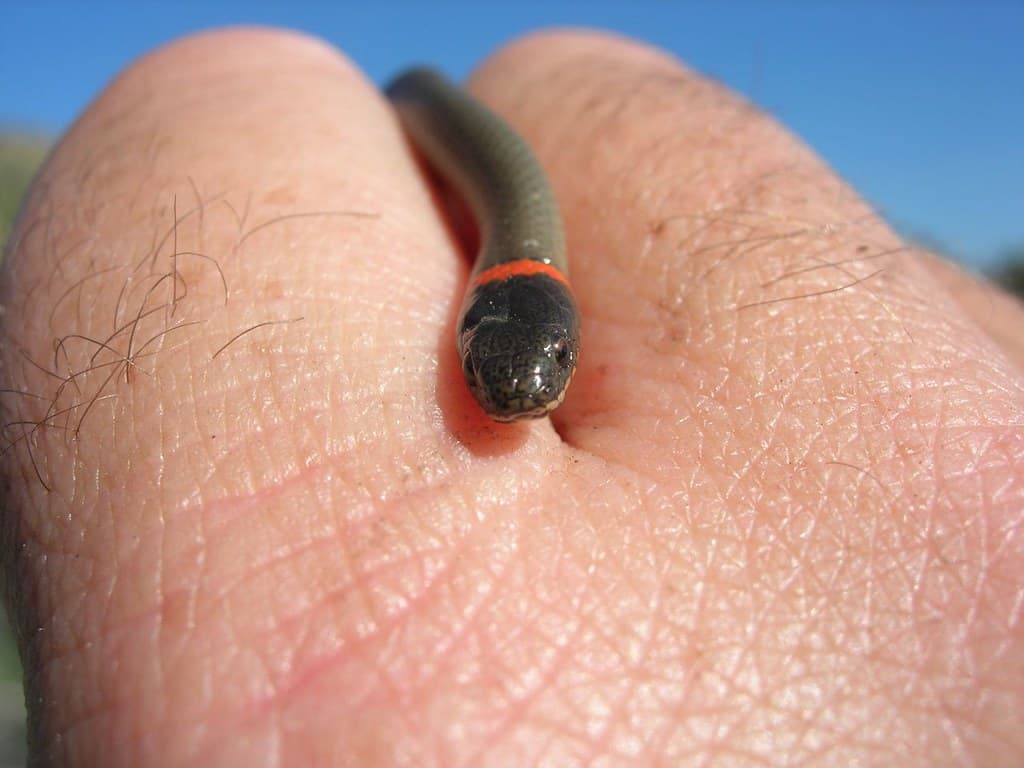
Ring-necked Snakes are small, about pencil width, and 10-16 inches in length. These are shy snakes that generally hide under things like rocks, logs, or leaf litter. You would be most like to see them by lifting up rocks or logs, or around dusk.
They live in moist habitats like woodlands, irrigated farmland, grasslands, riparain areas, or rocky hillsides.
They like to eat amphibians like salamanders, small frogs, and tadpoles. They will also eat slugs, worms, and tiny snakes and lizards.
They tend to be shades of gray, from olive to charcoal, and have a distinctive orange or yellow band on the back of their necks. They are bright orange underneath, and will flip their tail up to show you their underside if they feel threatened.
Glossy Snake
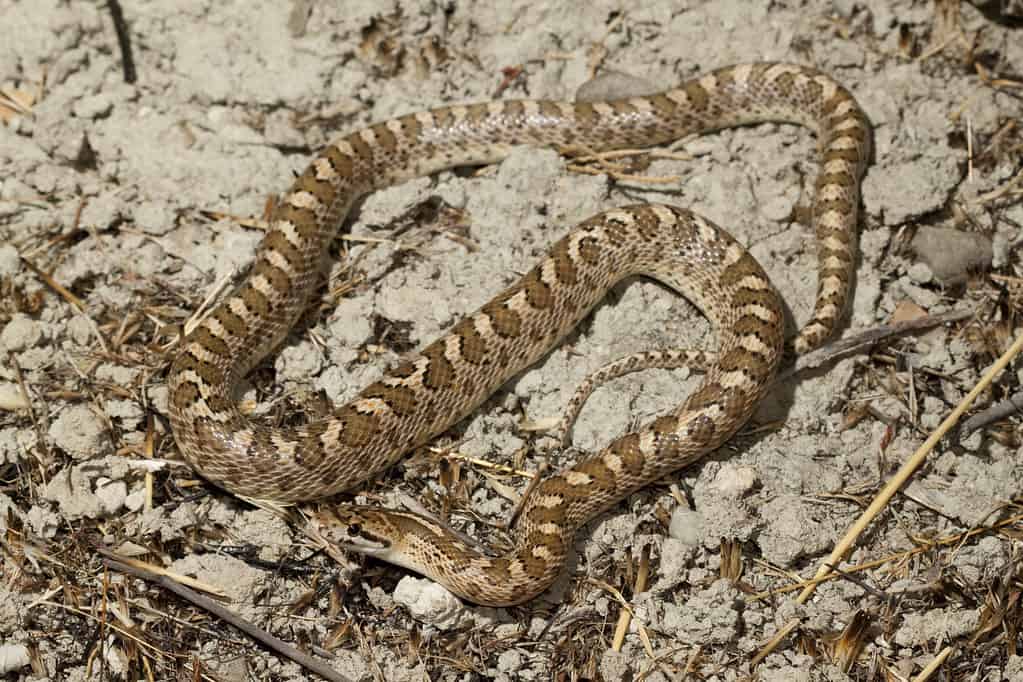
Is a Glossy Snake vemomous? No
Where does the Glossy Snake live in Southern California? The Glossy Snake lives in Ventura, LA, Orange, San Diego, Imperial, Riverside, and San Bernardino counties.
Glossy Snakes are often confused with Gopher Snakes because they do look similar. The scales are glossy, hence the name, but the coloring does look a bit faded or bleached out. For this reason it is also commonly referred to as a “faded snake”.
They are smaller than Gopher Snakes and are generally 3-4 feet long when fully grown. Their heads are also narrower than a Gopher Snake’s.
There are three subspecies of glossy snake that live in Southern California- the California Glossy Snake, the Desert Glossy Snake, and the the Mojave Glossy Snake.
The California Glossy Snake lives in southern Ventura County (as well as the very top edge of the county), most of LA County (outside of the Antelope Valley), Orange County, San Diego County, the southwestern corner of San Bernardino County, and the west quarter of Riverside County.
It is usually a big darker than the other subspecies of Glossy Snakes. The base color is tan to brown with dark brown splotches (outlined in black) that are almost rectangular on its mid back and smaller splothes running along either side of its body. The underside is pale.
They live in chaparral, grasslands, and washes where it is easy to burrow in the sand.
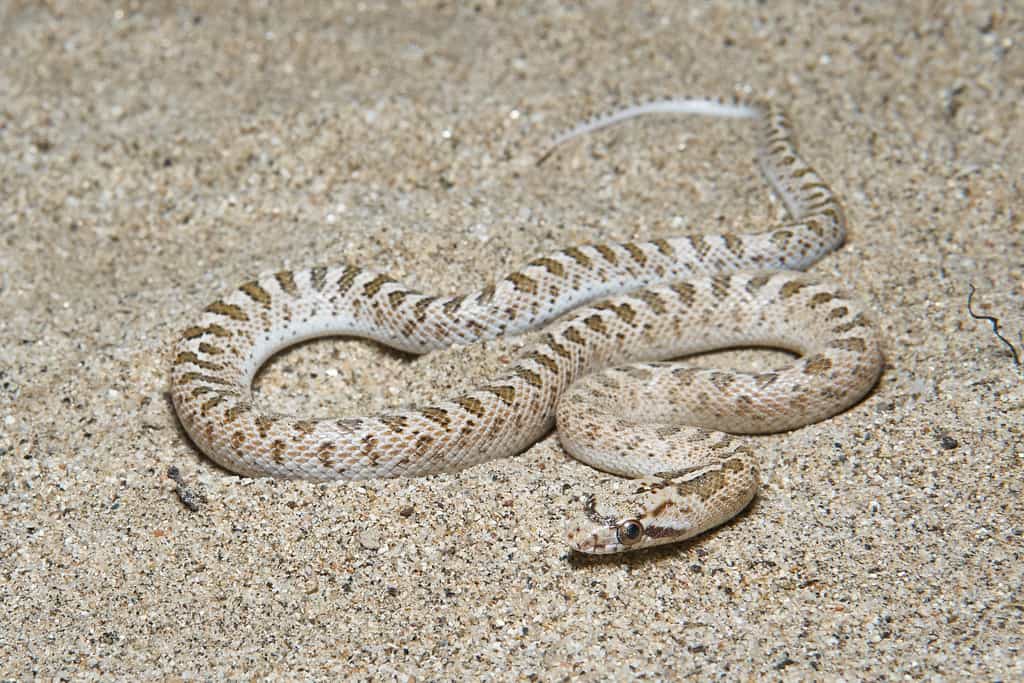
The Desert Glossy Snake lives in the very eastern edge of San Diego County, Imperial County, the eastern 3/4 of Riverside County, and the lower 2/3 of San Bernardino County.
It is generally more pale in color than the other two subpecies of Glossy Snake in Southern California. It’s base color is a light sand and it has the rectangularish splotches outlined in black down its mid back with smaller splotches running along either side of its body and the pale underside.
It lives in desert habitats, especially where it is particularly sandy or scrubby.
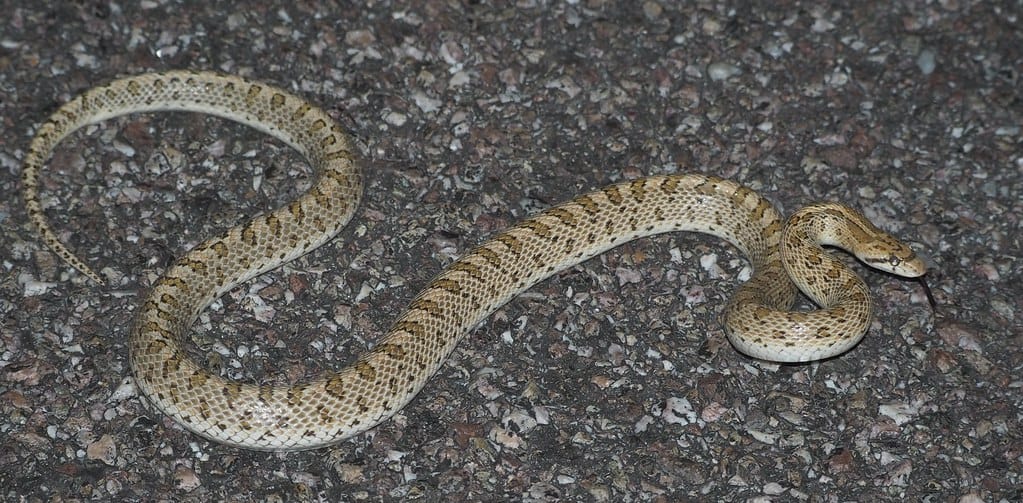
The Mojave Glossy Snake is native to the Mojave Desert including the Antelope Valley, and the upper third of San Bernardino County. Its territory extends into Kern and Inyo counties.
This snake’s base color ranges from cream to tan to light brown. The splotches are typically a mustardy brown to gray with black outlines. They are pale underneath.
These snakes are nocturnal. They hunt at night. During the day they sleep in animal burrows or under rocks. They can also make their own burrows using their specialized nose. They live in the desert (especially in sand or scrub) as well as grasslands in their range.
Glossy Snakes eat mostly lizards, but they will also eat small mammals that are nocturnal, birds that live primarily on the ground, and even small snakes. They are ambush predators who kill their prey by either constriction or just swalling them alive.
Shovel-nosed Snake
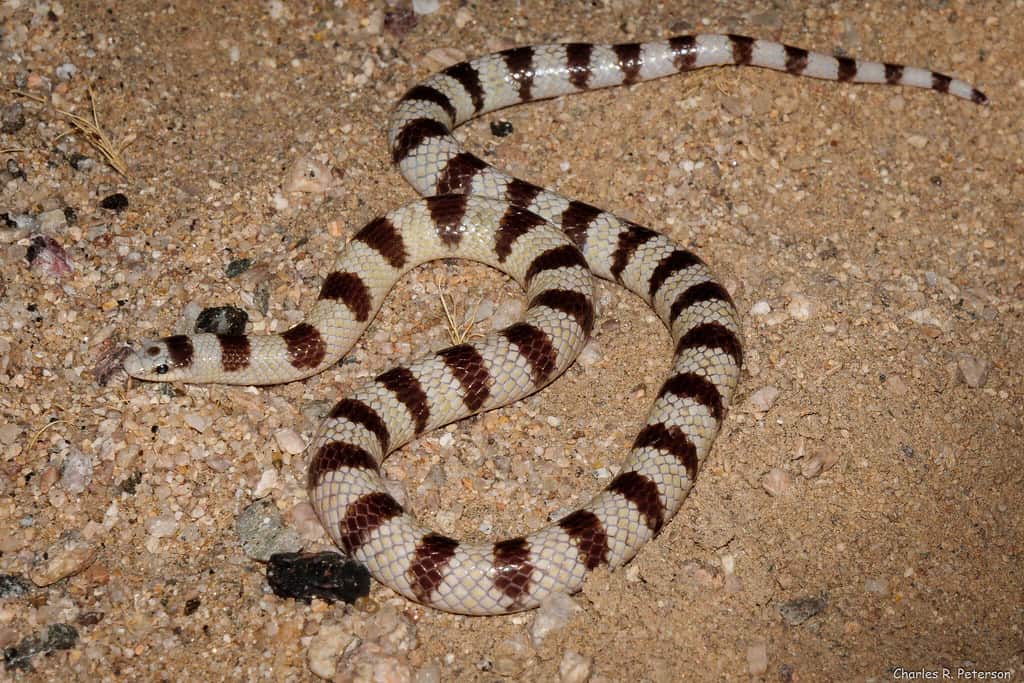
Is a Shovel-nosed Snake venomous? No
Where does the Shovel-nosed Snake live in Southern California? These are desert dwellers foound in the Mojave and Colorado deserts of Southern California. These cute little guys are only a foot to a 18 inches long when fully grown.
The Shovel-nosed Snake uses its flat, slightly pointed snout to “swim” through desert sand. It is nocturnal so your best chances of seeing them are when they cross desert roads at night. They live in sandy desert areas, desert washes, or portions of the desert with few plants.
There are two subspecies of Shovel-nosed Snake that live in Southern California, the Mojave Shovel-nosed Snake and the Colorado Desert Shovel-nosed Snake.
The Mojave Shovel-nosed Snake lives in the Antelope Valley of LA County, most of San Bernardino County (outside of the southwestern corner), and the eastern two thirds of Riverside County. Its territory extends into the desert regions of Kern and Inyo counties as well.
This subspecies has a cream or light yellow body with dark brown bands going around most of its body. The bands don’t fully connect on their undersides.
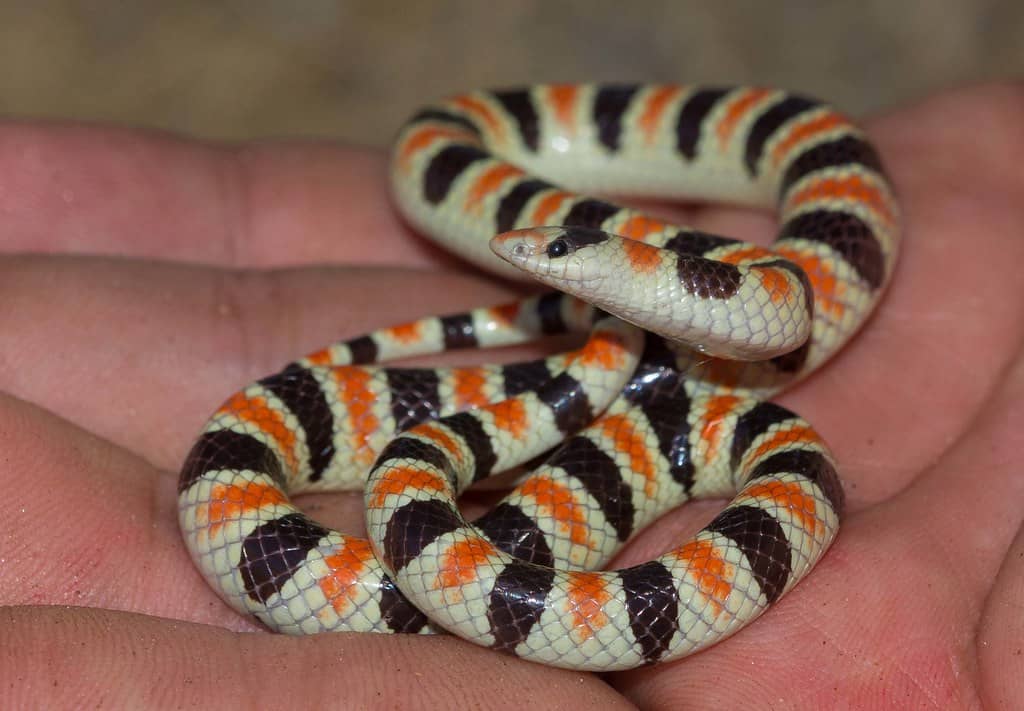
The Colorado Desert Shovel-nosed Snake lives in Imperial County as well the far northeastern corner of San Diego County.
This subspecies also has a cream or light yellow body but the bands going around its body are black with thin red crossbands in between. Some of their black bands do completely encircle the body but the red ones do not. There are some varieties where the red is barely there.
Both subspecies of Shovel-nosed Snakes in Southern California eat insects, spiders, scorpions, and centipedes.
Spotted Leaf-nosed Snake
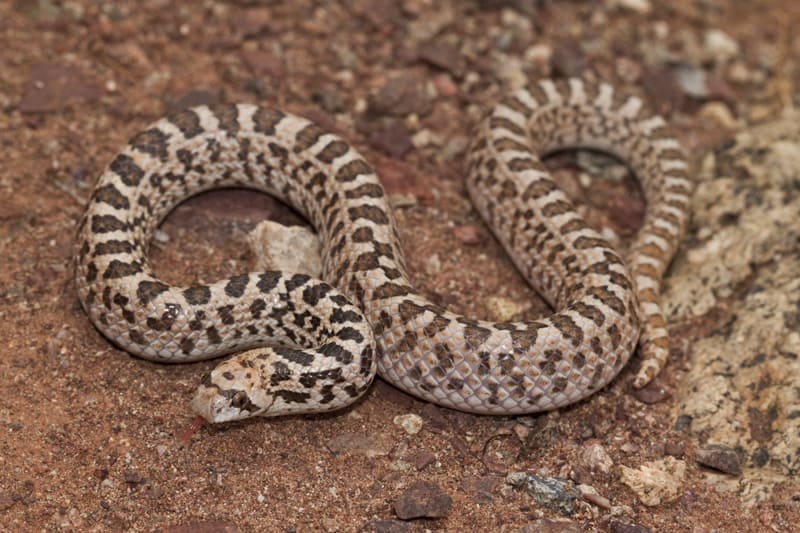
Is a Spotted Leaf-nosed Snake venomous? No
Where does the Spotted Leaf-nosed Snake live in Southern California? This snake is a desert dweller found in Inyo County, the eastern border of San Diego County, the eastern 2/3 of Riverside County, most of San Bernardino County other than the southwestern corner, the Antelope Valley. Its territory does stretch into portions of Kern and Inyo counties.
The Spotted Leaf-nosed Snake is a small snake (12-20 inches) that lives in rocks and sandy desert areas like washes or foothills below 3,000 feet. There are typically creosote bushes nearby which provide some cover.
They are nocturnal and generally pretty secretive, so sightings are not common. Sightings are most likely to occur in the spring and summer. They use the leaf on their nose to burrow in the sand. They eat lizards, especially Western Banded Geckos.
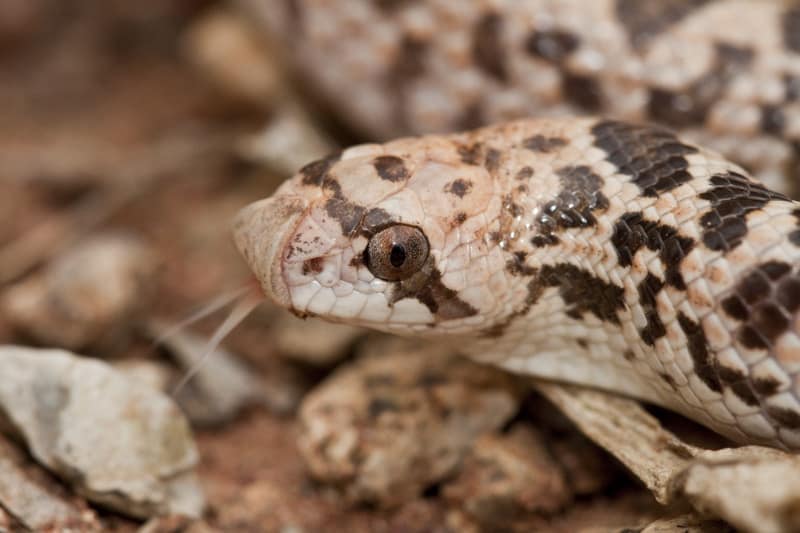
This is generally tan to an almost grayish color with small, irregular shaped dark spots all over their backs. Their bellies are very light. Their noses look almost like shovels with one large scale folded over. They are called Leaf-nosed Snakes because it is said to also look like a portion of a leaf folded over.
Another unusual feature of this snake is that its pupils are vertical. Though, it has been noted that when flash photos are take of this snake at night the pupils appear more round.
Long-nosed Snake
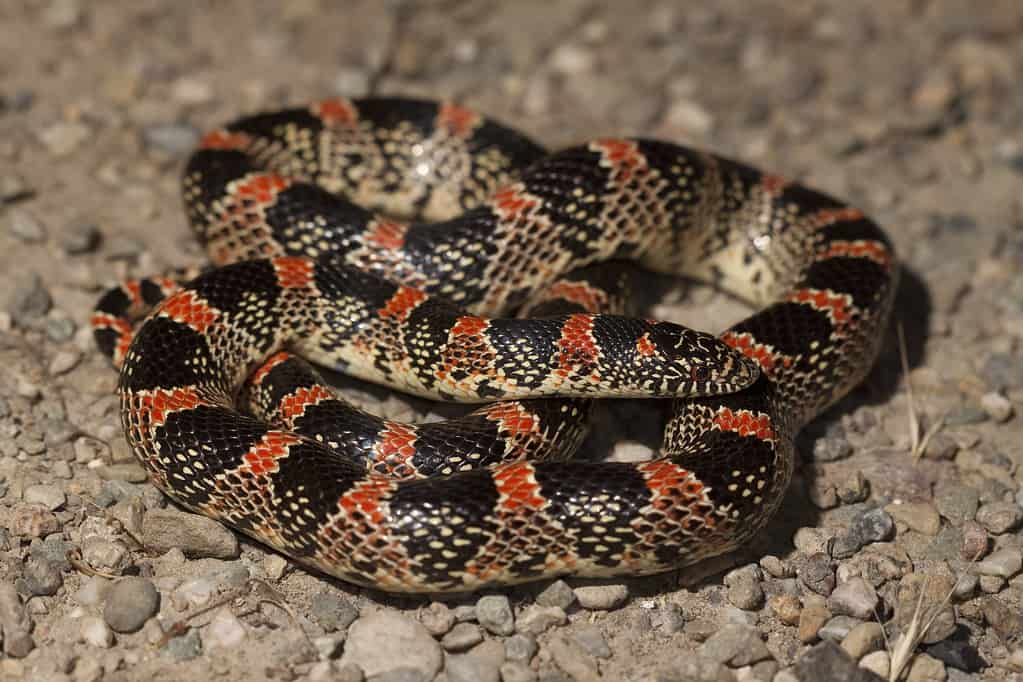
Is a Long-nosed Snake venomous? No
Where does the Long-nosed Snake live in Southern California? The northern half of LA County, eastern edge of Orange County, and nearly all of Inyo, San Bernardino, Riverside, Imperial, and San Diego counties. The territory extends into Kern County and up the Central Valley.
The Long-nosed Snake lives in grasslands, deserts, and shrubby areas. It is a nocturnal snake that is generally lives most of its life burrowed underground. You are most likely to see it along roads at night.

This is a thin snake with a head about the same width as its body. It has a long, pointed snout and bit of an overbite. These snakes are usually between 18 inches and three feet long when fully grown.
They are beautiful snakes with a cream colored body and alternating red and black speckled banding. The speckles in the banding are the cream color of the body. The underside of this snake is a solid cream.
While this snake is not aggressive and generally pretty shy, it does have a very unusual defense mechanism when handled. It will empty the contents of its cloaca (which non-venomous snakes like Garter Snakes are apt to do) along with an amount of blood that it will smear all over its body!
The long-nose snake eats mostly lizards and amphibians as well as small snakes. It will eat rodents on rare occasions when their other favorite snacks aren’t readily available. They kill their prey via constriction.
Patch-nosed Snake

Is a Patch-nosed Snake venomous? No
Where does the Patch-nosed Snake live in Southern California? The Patch-nose Snake lives in every county in Southern California.
Three subspecies in Southern California- the Desert Patch-nosed Snake, the Coast Patch-nosed Snake, and the Mojave Patch-nosed Snake.
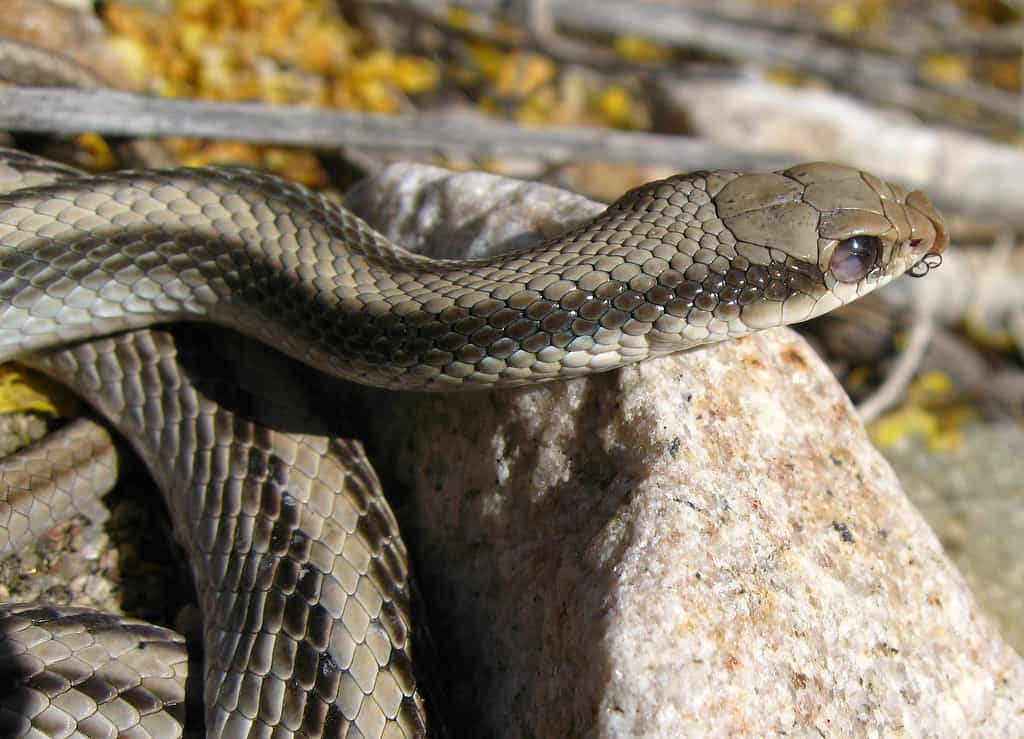
The Desert Patch-nosed Snake lives in the eastern 2/3 of Riverside County, Imperial County, and the eastern edge of San Diego County. It lives mainly in the desert, as well as rocky hillsides and scrubby areas.
This snake is pale gray to a lighter gray-brown on its sides with a yellow or tan stripe down the middle of its back. Its head is close to the shade of its side color. It is usually light yellow underneath.

The Coast Patch-nosed Snake lives in all the coastal counties of Southern California, though is is not spotted in the more heavily populated LA Basin, Antelope Valley, and north Orange County areas. It lives in chaparral, scrubby areas, and rocky hillsides.
These snakes are dark gray to brown on their sides with a lighter, tan to yellow stripe going down the middle of the their backs. Their undersides and bottom flanks are the same color as the strip on the top of their back. Their heads are a shade of brown.
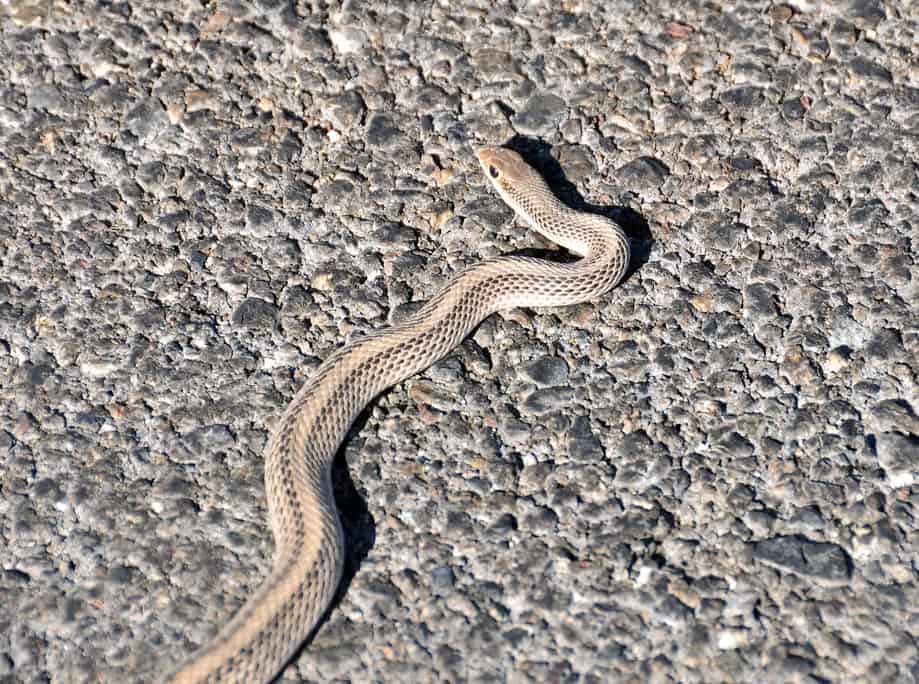
The Mojave Patch-nosed Snake is another desert dweller. It lives in the Antelope Valley, all but the southwestern corner of San Bernardino County, Inyo County, and portions of Kern County. In addition to desert it will also live in rocky hillsides and canyons, and some sagebrush habitat.
This subspecies is light gray with a wide, tan or yellow stripe down the middle of its back and darker gray to black stripes on either side of the wide stripe. The tops of their heads are gray to brownish gray. They are pale underneath.
The Patch-nosed Snake is typically 2-3 feet long. It primarily eats lizards but it will eat rodents and smalll rabbits as well. This snake is an active hunter during the day. This snake does not constrict its prey, it throws loops of its body on top of the prey to subdue it.
This snake is named for the patch-like rostral scale on the end of its nose. It can use that nose to burrow and seek out treats like reptile eggs.
Since very little is known about this snake (which is considered a species of special concern) and no scientific publications have been written about it, the San Diego Safari Park is currently engaging in a study of the Coast Patch-nosed Snake which is endemic to this park’s land. They are tracking 20 adult snakes with radio transmitters to better study these snakes.
Desert Striped Whipsnake
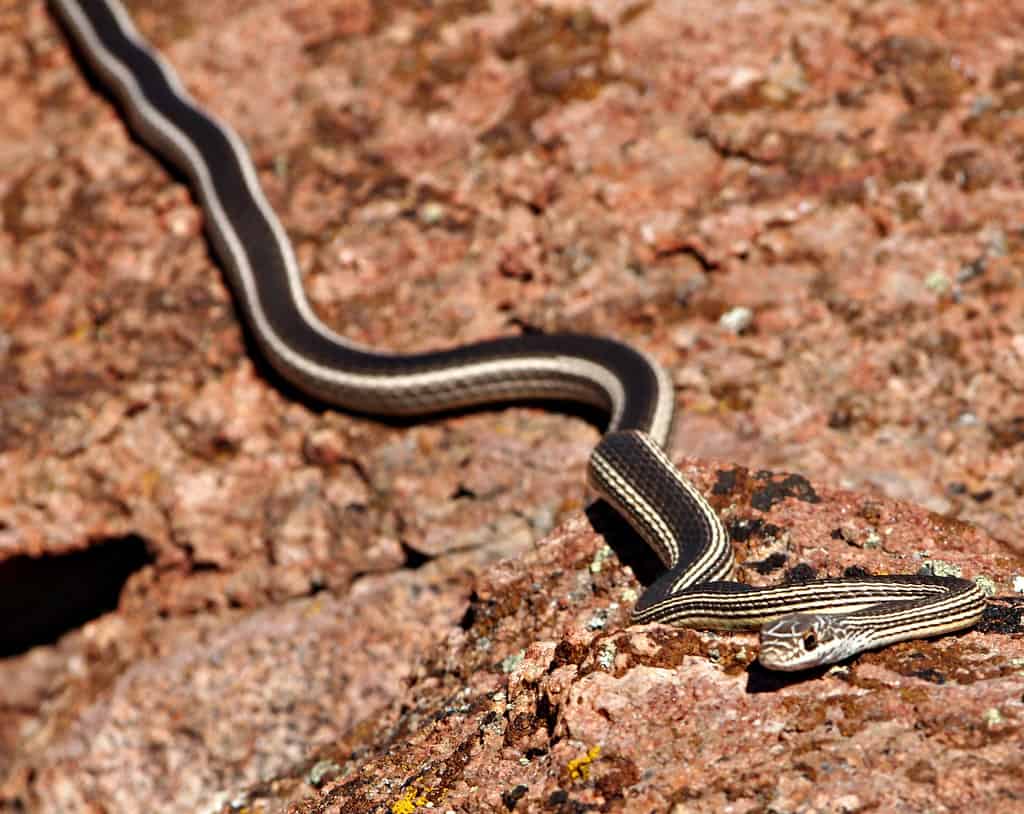
Is a Desert Striped Whipsnake venomous? No
Where does the Desert Striped Whipsnake live in Southern California? The northern portions of San Bernardino County into Inyo County.
The Desert Striped Whipsnake lives in the rural desert scrub and sagebrush flats of some of the most unpopulated areas in California.
It is a fast moving snake and hard to photograph and identify because it doesn’t stick around long enough. It can be spotted near the rare river or pond that is located in this especially dry part of the state.
When the Desert Striped Whipsnake hunts during the day, it slinks around with its head off the ground and uses its vision to identify prey- lizards, snakes, amphibians, birds, and small mammals- basically whatever is around.
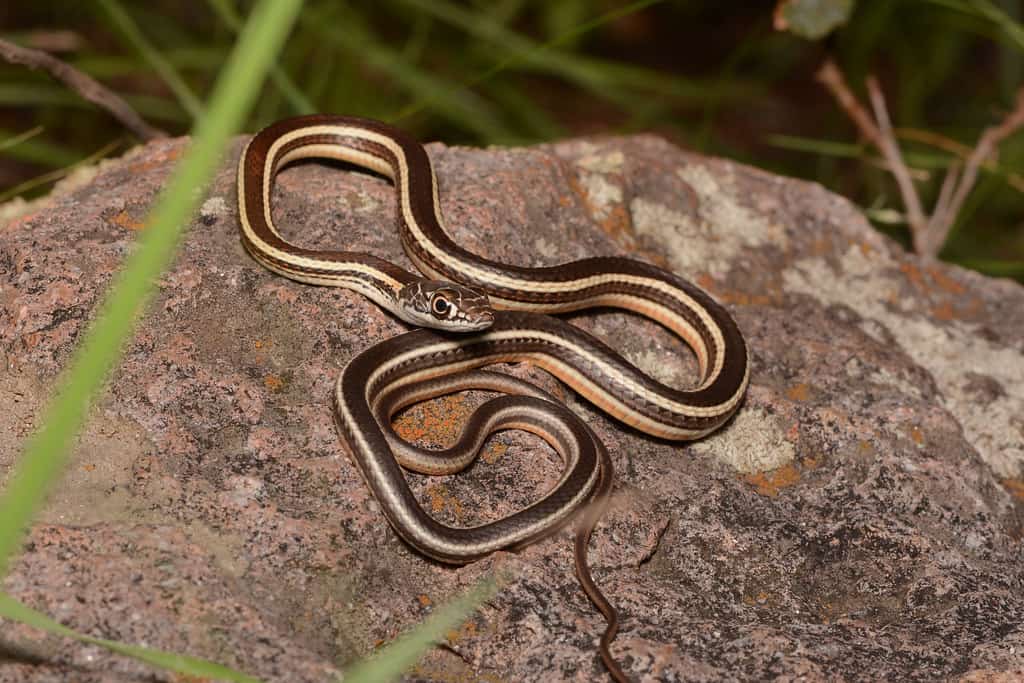
It is a slender but long snake, ranging in length from 2-5 feet. It is dark gray (sometimes more olive or black) in color with cream/light yellow stripes running down the side of its body. Its head is usually dark gray to olive brown and is slightly wider than its neck. Its undernath is usually cream but can get quite pink as it gets closer to the tail.
It is closely related to the Striped Racer that is common to the coastal counties of Southern California. It will try to bite you if you get your hands on it.
Western Black-Headed Snake
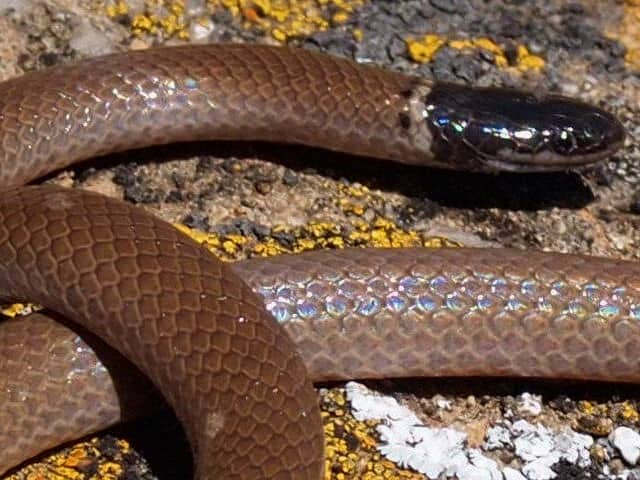
Is the Western Black-headed Snake venomous? It is mildly venomous but the venom is not dangerous to humans.
Where does the Western Black-headed Snake live in Southern California? In Southern California’s coastal counties as well as the eastern third of Riverside County and the southwestern corner of San Bernardino County as well as the southwestern corner of Imperial County.
The Western Black-headed Snake (also known as the California Black-headed Snake) is one of the smallest and most reclusive snakes in Southern California. This little guy is only 4-16 inches long when fully grown and quite slender.

It is a burrower with a flat head, and spends most of its life under objects or underground. Your best chance to spot them is at night after a rainfall or lifting up a rock and getting lucky. It eats insects, centipedes, and millipedes.
It can live in a variety of habitats such as chaparral, deserts, washes, grassy hillsides, and along the edges of waterways.
It has brown or tan body and a dark gray/black head with a white ring in between the head and body. The underside is usually reddish.
Variable Ground Snake
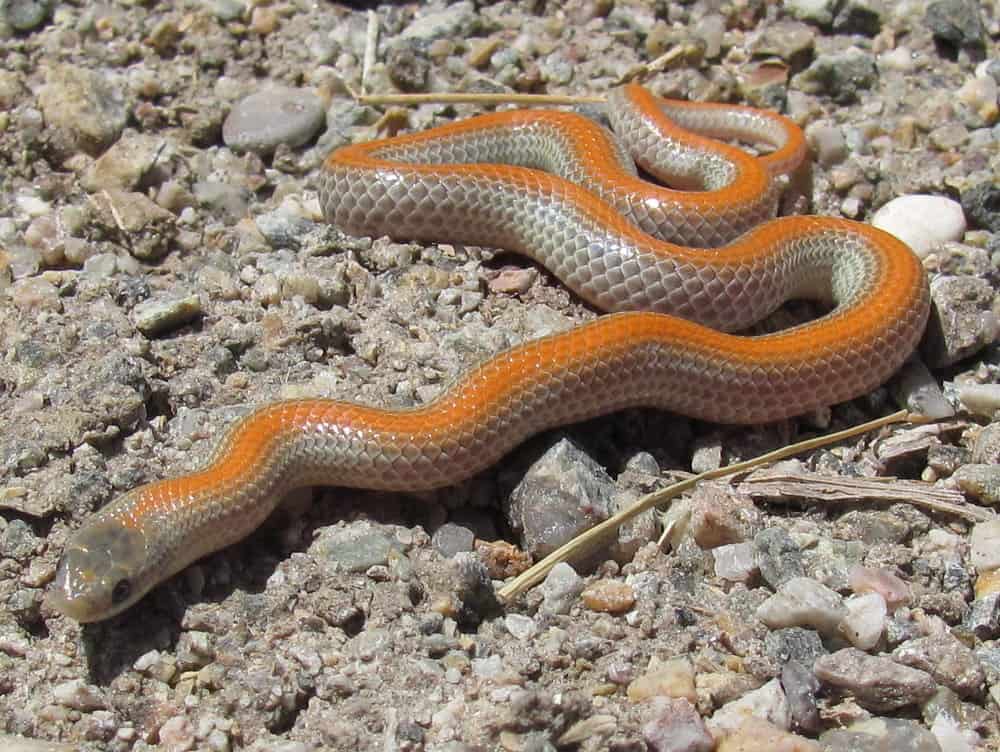
Is a Variable Ground Snake venomous to humans? No
Where does the Variable Ground Snake live in Southern California? Eastern 3/4 of Imperial County, eastern half of Riverside County, all of San Bernardino County except the southwestern corner, and on into Inyo County.
Though this little snake inhabits some of the driest portions of the state, it does live in areas that receive more moisture than the surrounding environment like washes and dry river bottoms. Overall it likes dry rocky areas with loose soil.
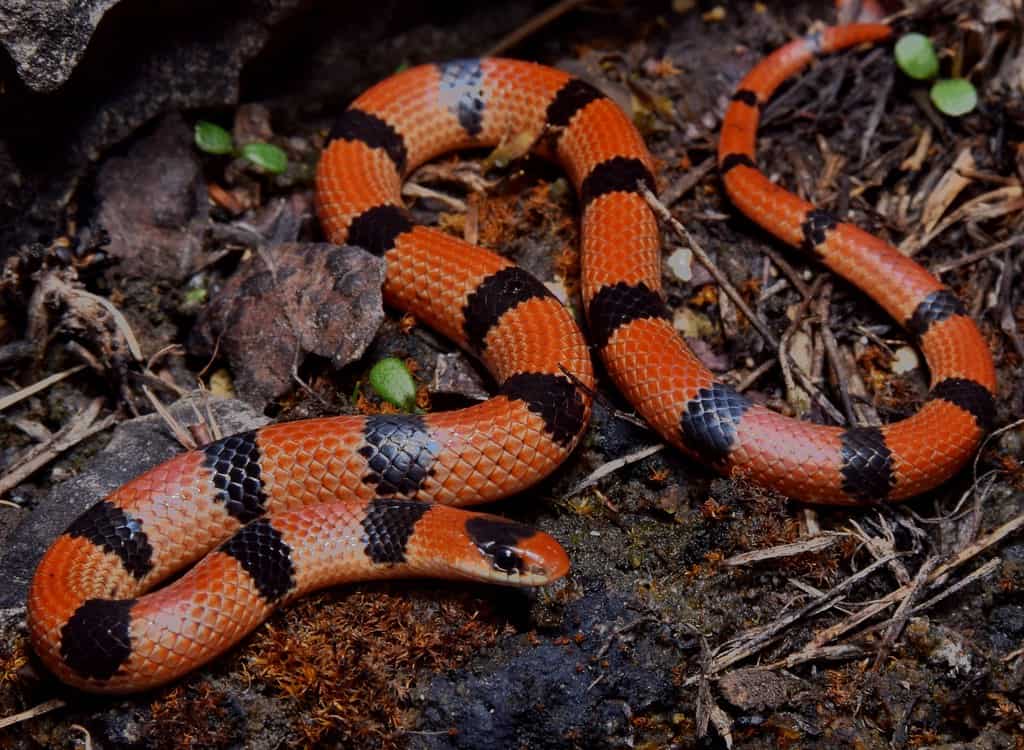
The Variable Ground Snake is only 8-12 inches in size with smooth, shiny scales that comes in variable colors and patterns (hence the name). The have small heads and big pupils.
Their base color can be gray, light brown, orange, or red. They can be red banded, black banded or black and red banded. Or they could have no bands at all and be a solid brown color on top. They can even be orange with gray sides. Their underside is usually white and may or may not have some black bands near the tail.
Variable Ground Snakes are nocturnal and shy, but quite common. You will most llikely spot one in a wash or along the road at night, looking for food. They eat insects, spiders, larvae, scorpions, and centipedes.
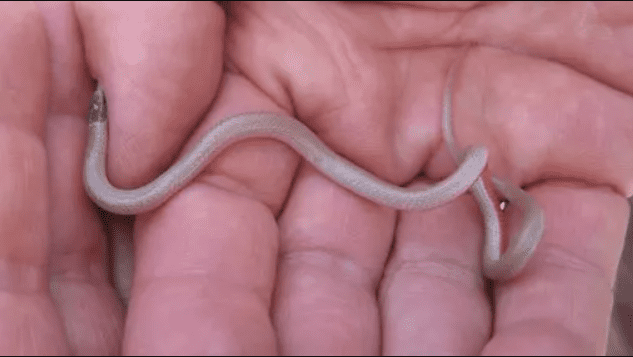
There is another subspecies, known as the Smith’s Black-headed Snake, that is found in spotty locations of the Southern California desert such as Death Valley and Joshua Tree. It is quiet small and thin, only 5-15 inches long.
The body is usually brown or tan with a dark head. The underside is red. It looks similar to the Western Black-headed Snake but doesn’t have the white ring on its neck.
Nightsnake

Is a Nightsnake venomous? They are mildly venomous but the venom is not dangerous to humans.
Where does the Nightsnake live in Southern California? The nightsnake is widely seen in every county in Southern California.
There are three subspecies of the Nightsnake in Southern California, the California Nightsnake the Desert Nightsnake and the San Diego Nightsnake.

The California Nightsnake lives in northern Santa Barbara County and points north.
The Desert Nightsnake is in the desert areas of the region- the eastern edge of San Diego County, Imperial County, eastern 2/3 of Riverside County, all but the southwest corner of San Bernardino, and Antelope Valley. Their territory stretches up into Inyo and Kern counties as well.
The San Diego Nightsnake lives in the more coastal areas- southern Santa Barbara County, Ventura County, LA County (minus Antelope Valley), Orange County, most of San Diego County, the eastern third of Riverside County, and the southwest corner of San Bernardino County.
These little guys can look like rattlesnakes in a lot of ways but they are much smaller (10-16 inches), don’t have rattles, and are nocturnal. They also have flat, triangular heads. They are technically venomous but nothing for a human or a large animal to worry about.
Nightsnakes can also be mistaken for Gopher Snakes but again, they are much smaller. Also they have vertical pupils whereas the Gopher Snake has round pupils.
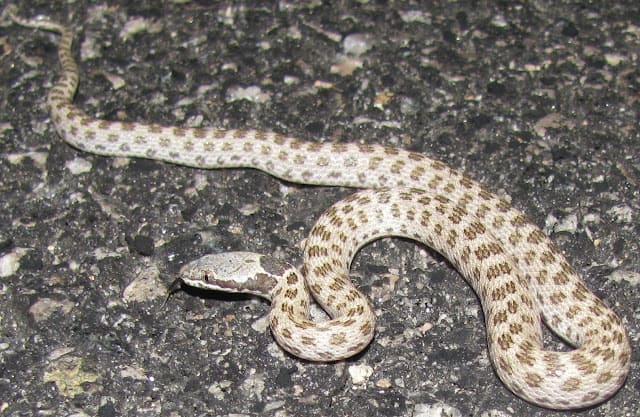
Their base color tends to match their environment which is usually anywhere for cream to light brown or gray. They have big brown or gray splotches down their backs and small splotches on their sides. They have bigger, darker blotches on their necks and their heads match their base color. They are light underneath.
They are common to chaparral and deserts, grasslands and sagebrush, and even backyards! They like to hide under rocks or pieces of wood during the day. At night they hunt for lizards, frogs, salamanders, and small mice. They inject their mild venom by chewing.
Lyre Snake

Is the Lyresnake venomous? It does produce a mild venom but it is not harmful to humans or large animals. It may cause some irritation but isn’t truly dangerous.
Where does the Lyre Snake live in Southern California? It lives in Ventura County, eastern LA County, the edges (eastern and western) of San Bernardino County, most of Riverside and San Diego counties, and the northeastern side of Imperial County.
There are two species of Lyre Snake that call Southern California home. The California Lyre Snake is by far the most common.
It lives in most of Ventura County, the eastern half of LA County (other than the far northeastern corner aka: Antelope Valley), scattered portions of San Bernardino County (mostly to the west), most of the western 3/4 of Riverside County, nearly all of San Diego County, and small portions of Imperial County near the San Diego County and the northeastern border with Riverside County.
The Sonoran Lyre Snake lives in far eastern San Berardino, Riverside, and Imperial counties.
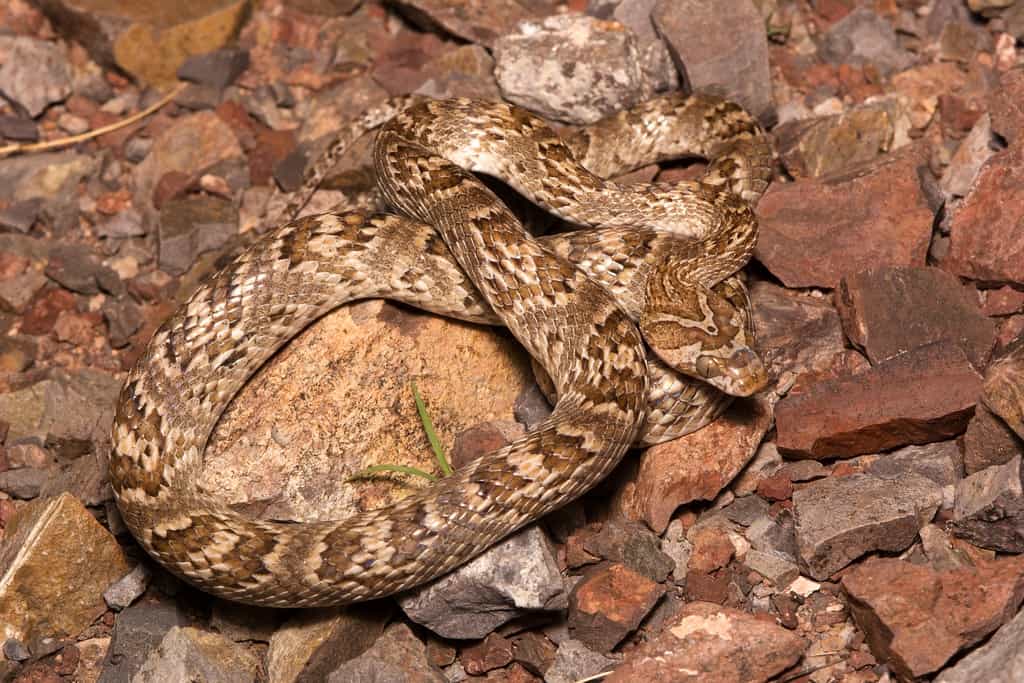
These snakes generally live in rocky areas like deserts and chaparral hillsides. Their coloration makes for excellent camouflage in rocky habitats and they are good at climbing in and around the rocks. This snake is usually 2-3 feet long.
The color of these snakes’ bodies usually matches the rocks of their habitat, typically in shades of tan or brown. They have large, irregular shaped splotches on their backs and smaller version of those splotches on their sides. The splotches are darker than the body, typically dark brown to almost and orangish brown.
They have a v-shaped marking on the top of their heads, aka: a lyre. Their undersides are cream or yellow with scattered brown spots. The pupils of the Lyre Snake are vertical.
The Sonoran Lyre Snake has fewer splotches than California Lyre Snake and their splotches tend to be further spaced apart.
Lyre Snakes are nocturnal and mostly eat lizards, but they will also eat small snakes and mammals. They will also eat birds and bats. The tend to camouflage themselves in the rock and sneak up on the lizards.
]]>I have been a huge fan of identifying birds of prey ever since I took a class on Captive Raptor Management at UC Davis many moons ago. These special birds are truly wonderous to watch, and an important part of our ecosystem.
Here are eight hawks in Southern California that you might spy when hiking, camping, or simply walking your neihgborhood. I have also included lots of pictures and distinguishing characteristics to help you identify these incredible birds.
Here is our full guide to all 34 California birds of prey.
8 Hawks in Southern California and How to Identify Them
1. Red-Tailed Hawk
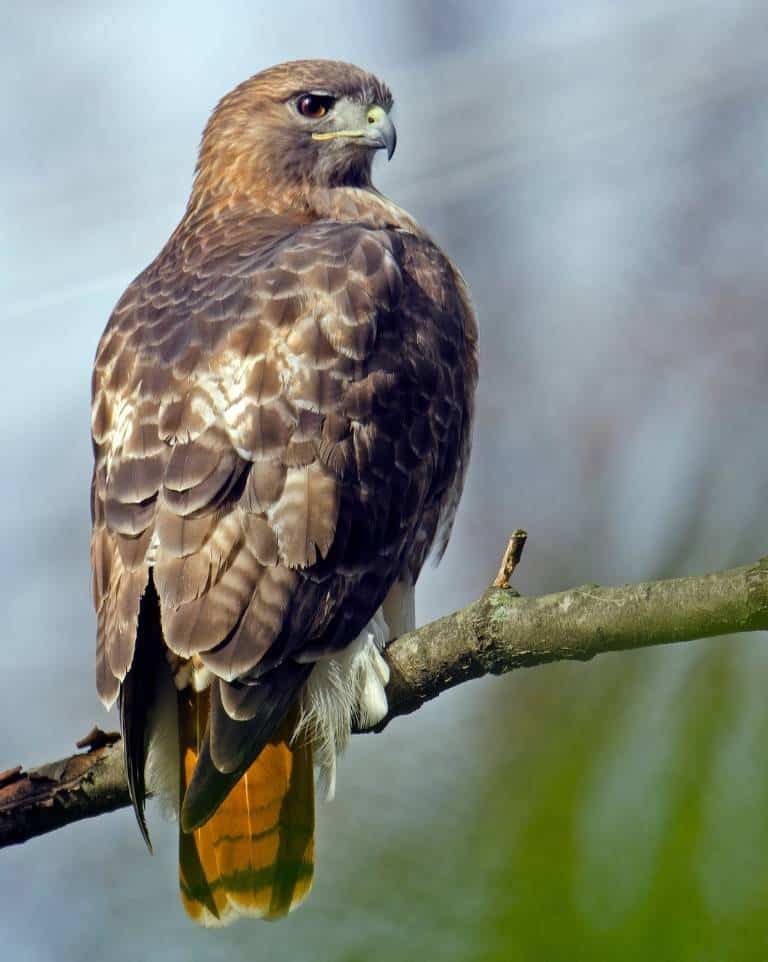
One of the most common hawks in Southern California is the Red-tailed Hawk. It is also one of the easiest birds of prey to identify thanks to its signature red tail, though sometimes the tail does have a grayish tone.
They are commonly seen throughout Southern California, from the coastline to the desert, and in both wild and urban areas.
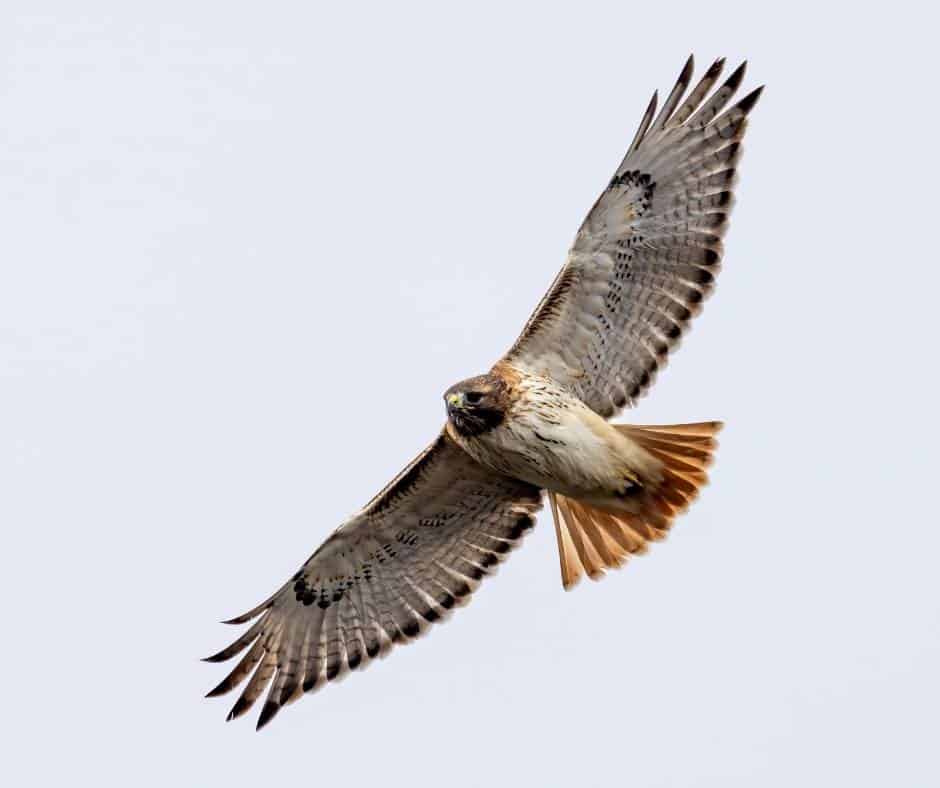
Red-tailed Hawks eat a wide variety of rodents, rabbits, lizards, snakes, insects, and even fish! You will often see them perched on fence posts, telephone poles, or soaring high above showing off those red tails.
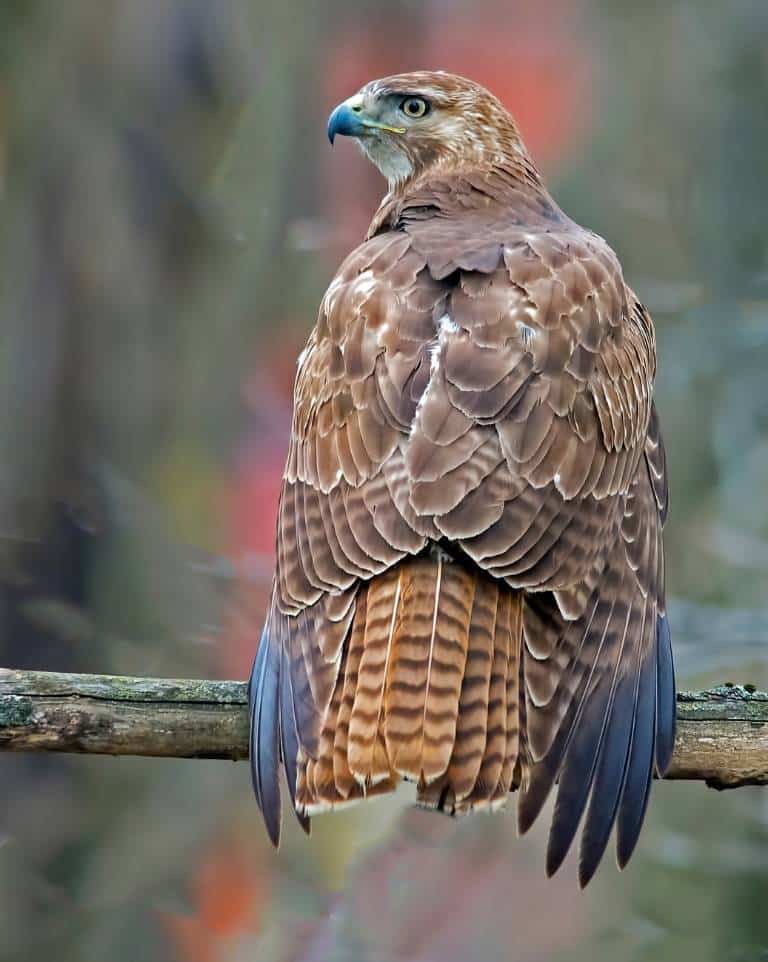
There is an exception to the “red tail rule”. Juveniles have lighter chests and their tails have evenly spaced brown and white bars on them. They generally lose their banded (or striped) tails when they are about 18 months old.
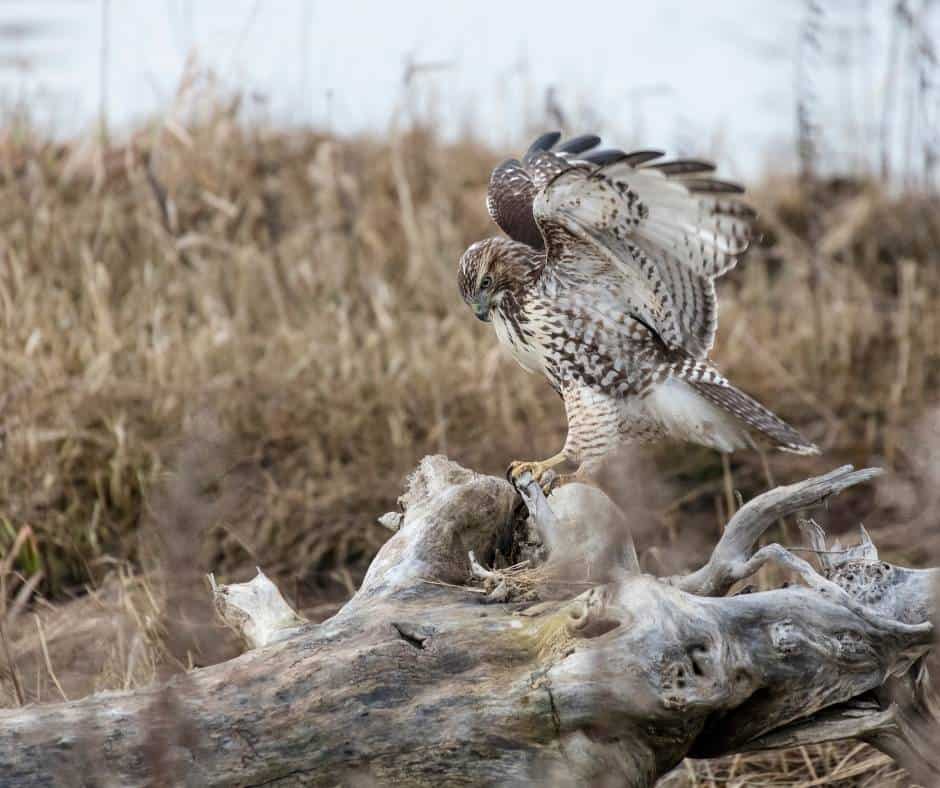
Red tailed-Hawks are excellent co-parents and work together to build their nest, incubate the eggs, and raise their young. Red-tailed hawks tend to lay 2-3 white eggs with brown spots at a time.
Young Red-tailed Hawks stay with their parents for about 10-12 weeks and generally fledge (begin to fly) around 45 days.
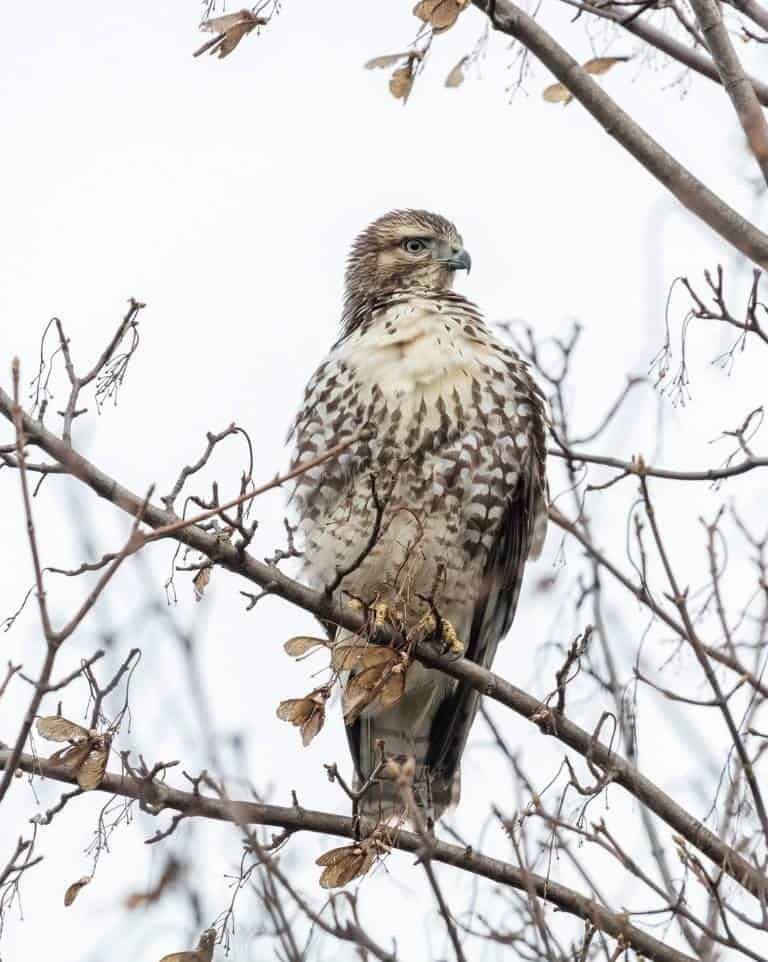
Red-tailed Hawks have distinctive screeches that will help you identify them as well. You can hear them here.
2. Ferruginous Hawk

Far less common than the Red-tailed Hawk, the Ferruginous Hawk does use Southern California as a wintering destination. They can be spotted between late September and April in grasslands, sagebrush flats, desert scrub, and low foothills in Southwestern California.
This species is considered to be “threatened” due to habitat loss and hunting.
They generally prefer open, treeless areas and will roost on a lone tree in the area or even a utility pole. You will not find these raptors in urban areas or heavily treed regions because they do require those wide, open expanses in order to hunt.
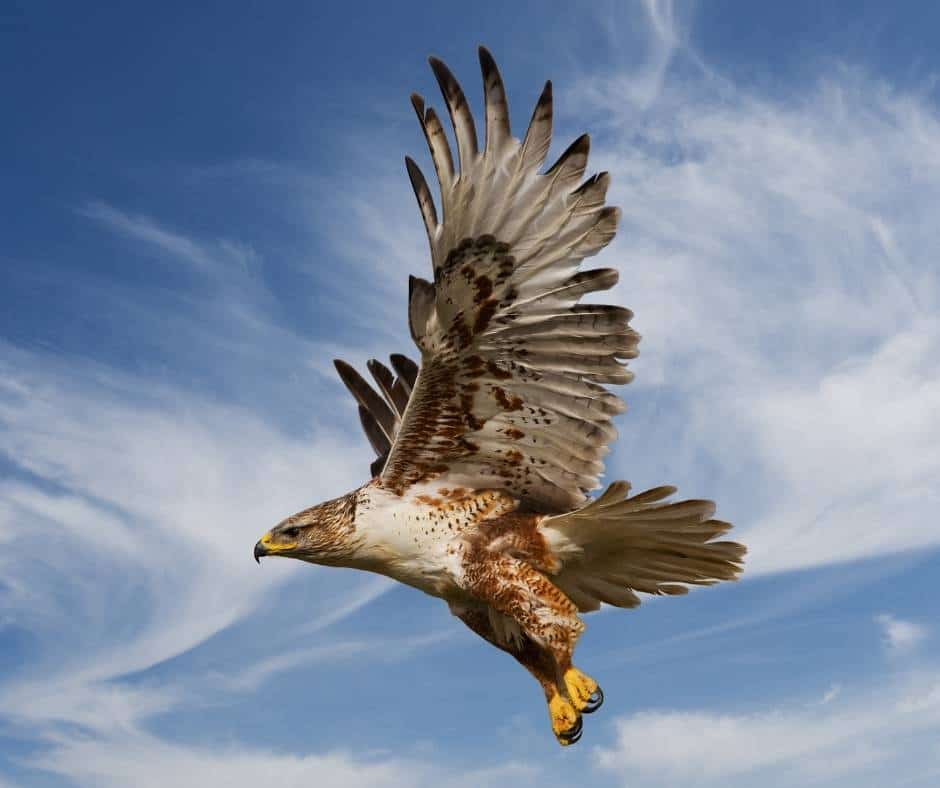
They tend to eat small mammals that inhabit grasslands such as rabbits, squirrels, gophers, and mice. They will also eat birds and snakes.
Ferruginous Hawks are larger than Red-tailed Hawks. They have a wingspan around 55 inches and a length of 20-25 inches. They typically have a gray head, rust-colored shoulders and legs, and white underparts.

These hawk can be identified in flight by the V that forms as result of their rust legs and white underparts. Juveniles will have some brown spotting on their legs and stomach. Their is a darker morph version of the Ferruginous Hawk which is chocolate in color, but it is very rare.
One of the more interesting things about this hawk is their nests. They may start with an old nest, like a crow’s nest, and then make it much bigger and bulkier with lots of sticks and twigs, as well as cow dung. They often return to their nests year after year, growing them to huge sizes over time.
Back when bison roamed the West, Ferruginous Hawk’s built their nests with sticks and pieces of bison bones, and lined their nests with bison dung!
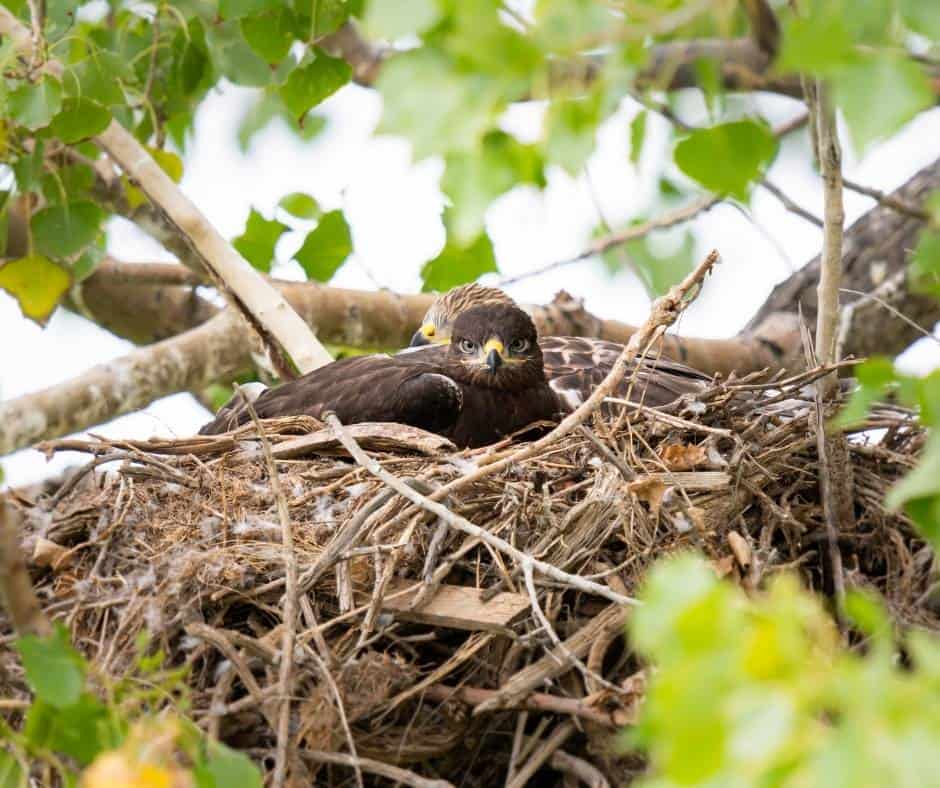
Ferruginous Hawks co-parent as well, but the mother does most of the nesting and the father does the bulk of the hunting.
When the chicks hatch (typically 2-4), the mother stays with them for the first three weeks. Father brings back food, mother feeds it to the chicks. Eventually, around thee weeks, both parents start hunting. The chicks fledge at 45 days and stay a few weeks longer after that to learn to hunt with their parents.
Listen to the sounds of a Ferruginous Hawk.
3. Red-Shouldered Hawk

The Red-shouldered Hawk is onother one of the most commonly spotted hawks in Southern California. This beautiful bird has a year-round population in Southern California.
It is commonly spotted in riparian woodlands, but it also makes an appearance in residential areas when there is bird feeder attracting song birds that it can easily hunt and eat. It also likes to hang out in eucalyptus groves and oak woodlands, both of which a relatively common in Southern California.
In addition to song birds in residential areas, these hawks also eat small mammals (like mice and voles), lizards, and snakes. They hunt from a perch, like a tree, and then swoop down to snag their prey when they spot it.
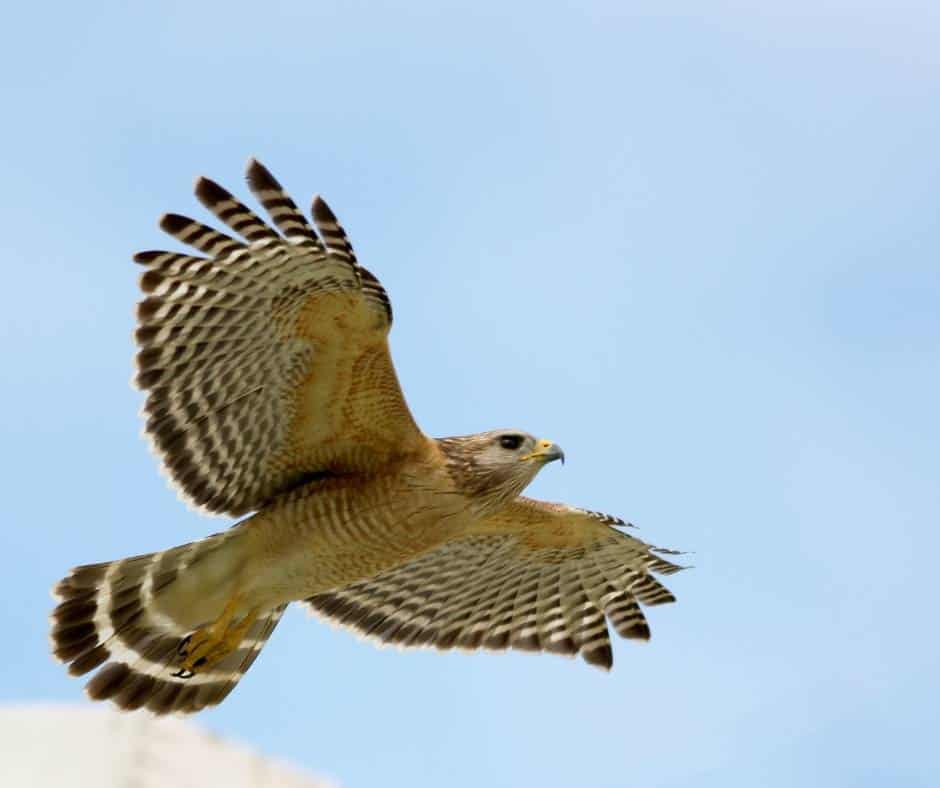
Red-shouldered hawks are easy to identify. They have red shoulders (it’s not just a clever name!) and a black and white bands on its wings and tail. These birds of prey are about the same size as a crow.
These hawks do return to the same nest year after year, so once you have found their “spot”, you can expect to see your new pals again next year. Their nests usually have 3-4 pale eggs that are blotched with brown and lavender.
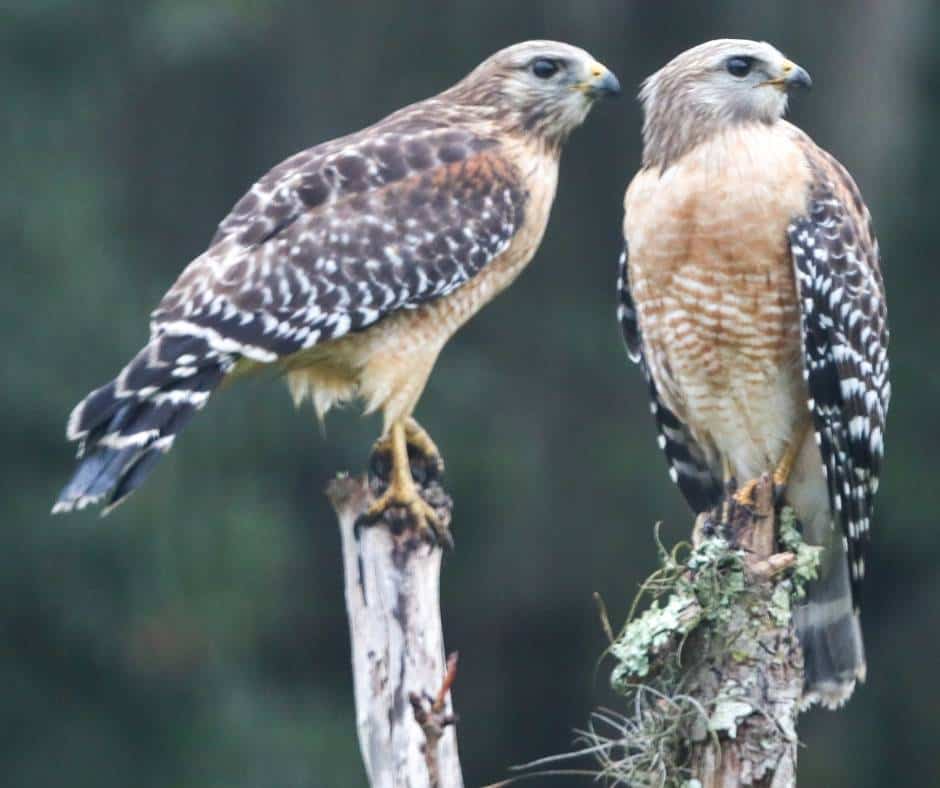
Females tend to do the bulk of the nest incubating and watching while males do the bulk of the hunting. Young Red-shouldered Hawks fledge after about six weeks, but hang out with their parents for another 8-10 weeks to get fed and learn how to hunt.
Listen to the calls of the Red-shouldered Hawk.
Explore Southern California with these 20 incredible weekend getaways.
4. Cooper’s Hawk

The Coopers Hawk is a common hawk in urban and suburban areas. While their natural habitat is the forest, they have discovered that they have a taste for doves and pigeons, and they have plenty of both to eat if they stick to where the people are.
If you have a bird feeder, there is a chance that a Cooper’s Hawk might look at it as a smorgasbord, and we aren’t taking about the bird seed! If you do have a hawk that is suddenly using your bird feeder as a hunting ground, remove it for a week and the bird will move on.
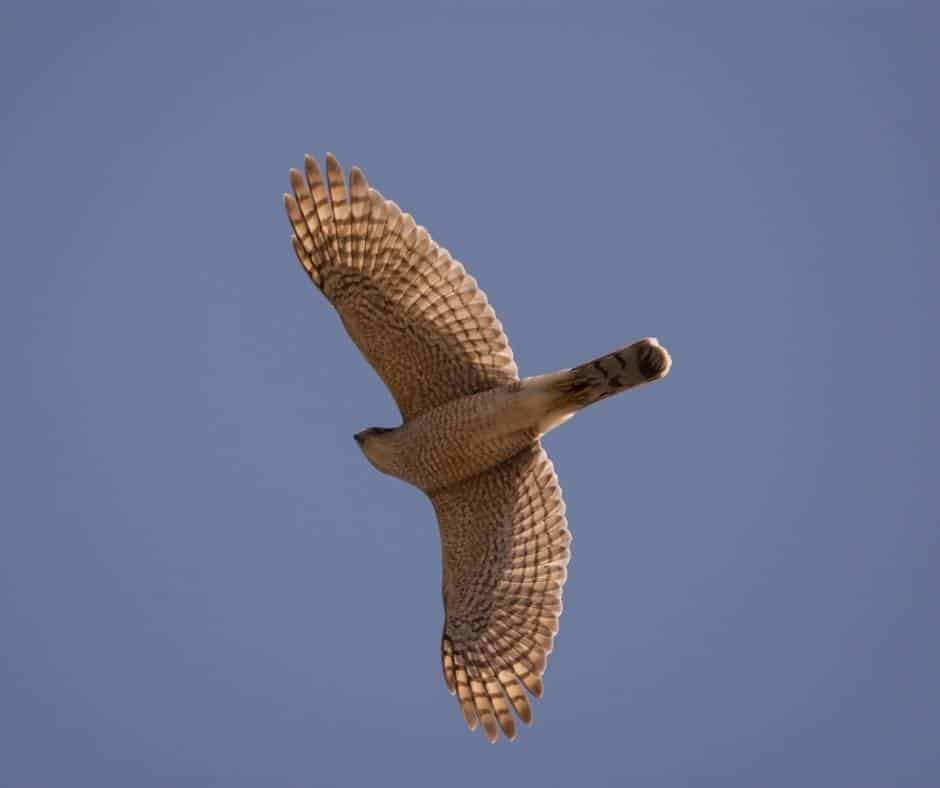
Cooper’s Hawks are excellent flyers and move quickly through the air or vegetation to snag their prey. They kill it by squeezing it to death, but they have also been known to drown their prey as well.
One of the more gruesome facts about Cooper’s Hawks revolves around the fact that it likes to eat medium-sized birds, including their own!
A male Cooper’s hawk is much smaller than a female (they are both around crow size. Males are a small crow, females are a large crow), so it has to be very submissive to the female and send out calls letting her know it is a mate and not food.
Then, the male considers the submission (any thing to make you happy honey, just don’t eat me!) by building the nest and providing all the food for its mate and their young for three months until the young leave the nest.
Adult Cooper’s Hawks have bluish-gray backs, reddish chests, reddish-gold eyes and a blackish-gray cap on their heads. Their tails have black and gray banding with a white tip that is rounded. They have a long tail and shorter wings than a Red-tailed or Red-shouldered Hawk.
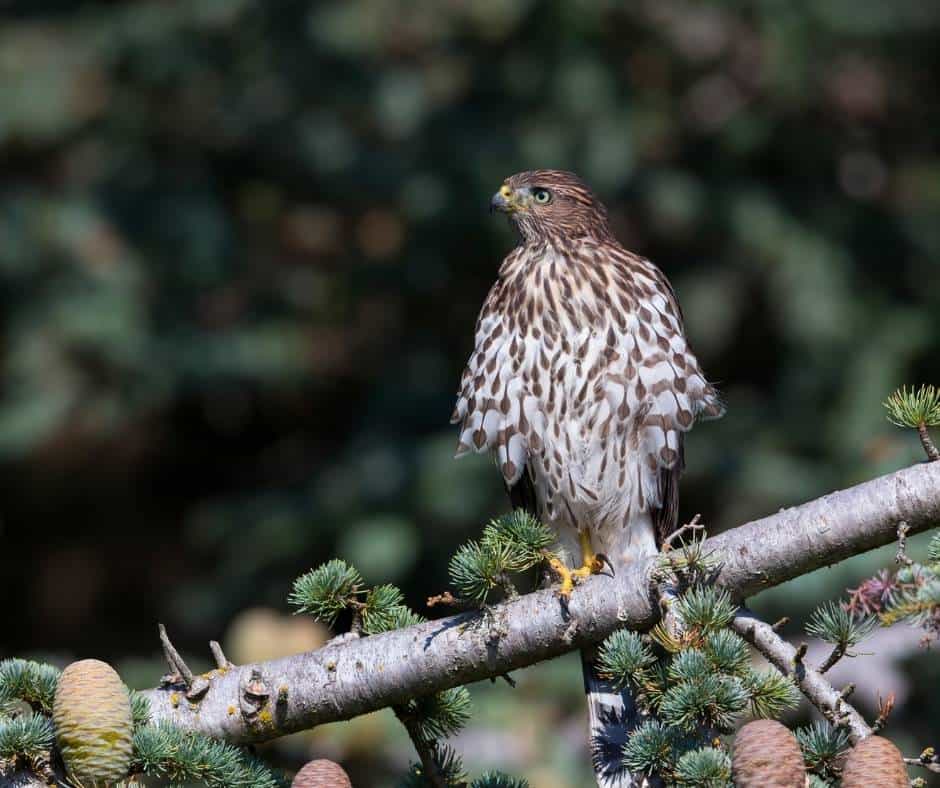
Juveniles have brown and white streaking on their chests (instead of the red) and their eyes are more yellow.
Cooper’s Hawks look very similar to the next hawk on our list, the Sharp-shinned Hawk and it can be tricky to tell them apart. Keep reading to learn more about how to tell who’s who!
Listen to the sounds that a Cooper’s Hawk makes.
5. Sharp-shinned Hawk

Sharp-shinned Hawks look, and in many ways behave, like Cooper’s Hawk, but they are smaller and more secretive.
Like the Cooper’s Hawk, they live in forests but have also adapted to live in urban and suburban areas which are home to lots of songbirds and bird feeders.
When the Sharp-shinned hawk catches their prey, the bang their future meal on a stump or low branch until they die. These hawks tend to eat smaller birds like robins or sparrows, but they will also eat small amphibians and mammals if available.
So how does one tell a Cooper’s Hawk from a Sharp-shinned Hawk? They both have bluish-gray backs, reddish chests, reddish-gold eyes and a blackish-gray cap on their heads. They both have long, banded tails. Even the juveniles have similar indentifiers!
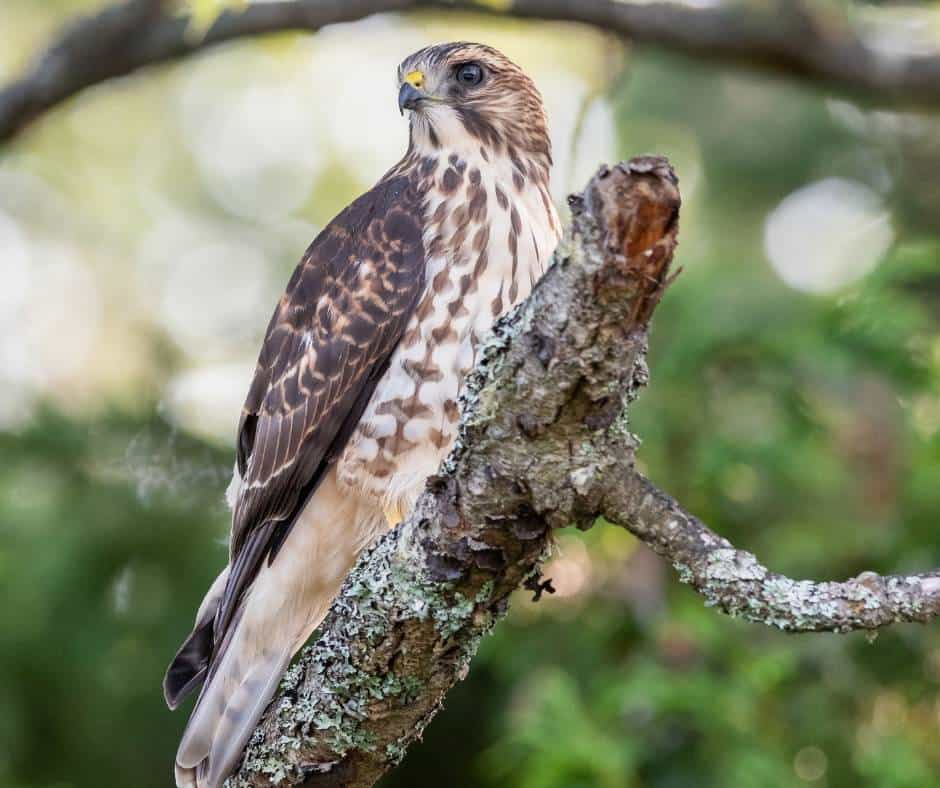
Well, when they are in flight, it can be very difficult to tell these two hawks apart. Sharp-shinned Hawks are smaller than Cooper’s Hawks but perspective is hard to gain when they are midair. The best identifier is that Sharp-shinned Hawks have square-edged tails while Cooper’s Hawks have rounded tails.
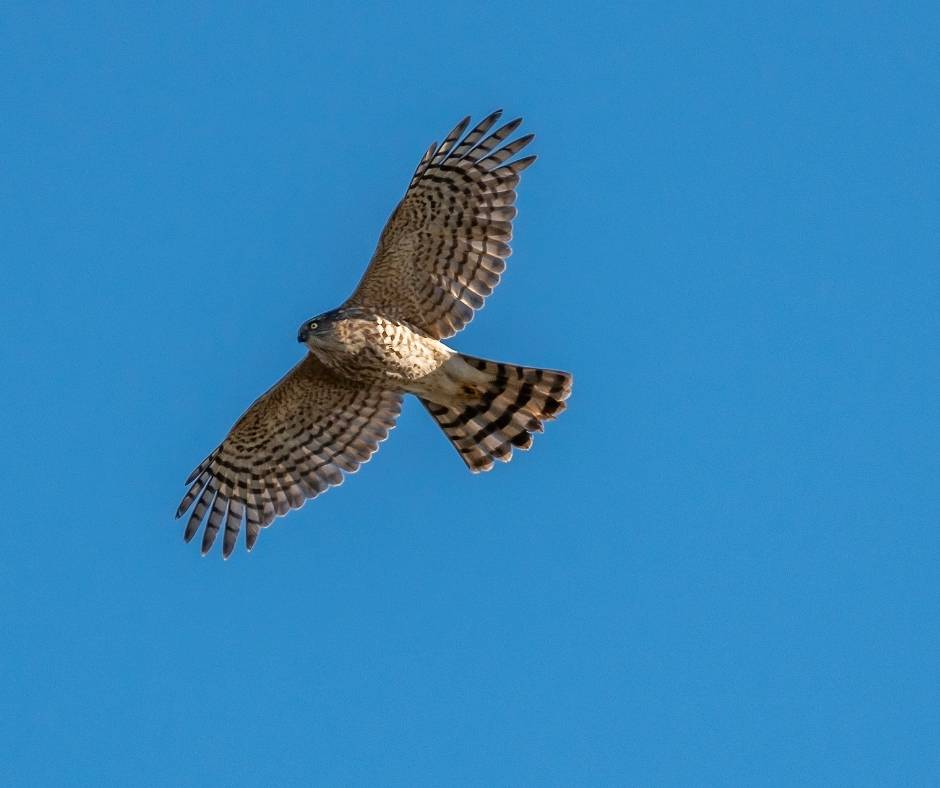
If you can see a the hawk perched, take a look at its head. The Sharp-shinned Hawk has a curved head and short neck. The Cooper’s Hawk has a flat head and slightly longer neck.

Unlike the Cooper’s Hawk, the Sharp-shinned Hawk does not have a year-round population in Southern California. These small hawks migrate from Canada and spend the colder months here. For these reasons, you won’t ever see a Sharp-shinned Hawk’s nest in our neck of the woods.
These are the sounds that a Sharp-shinned Hawk makes.
6. Northern Goshawk
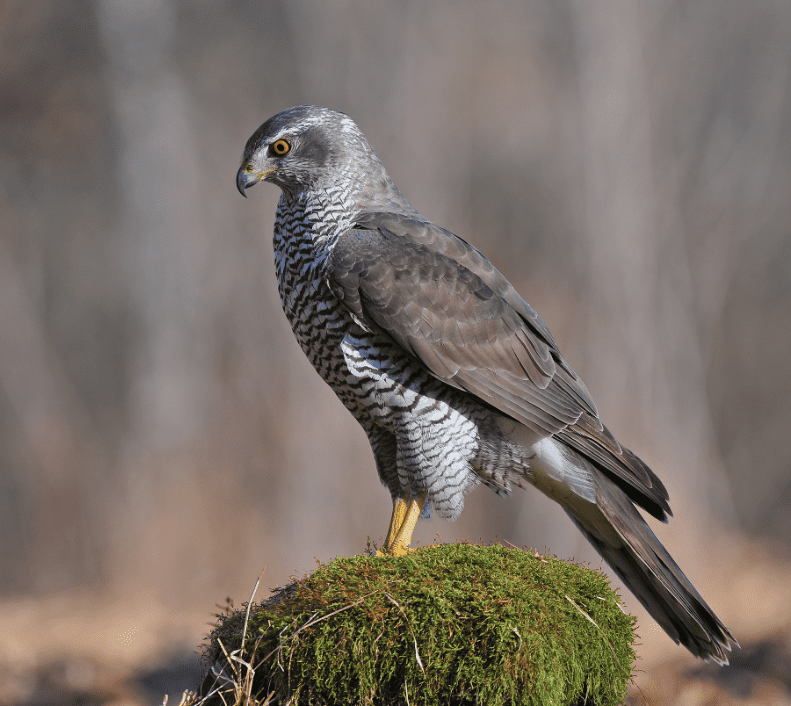
One of the more rare hawks in Southern California is the Northern Goshawk. This bird is only really seen in the mountains of Los Padres National Forest around Mt. Pinos and Frazier Mountain in northern Ventura County. This is the moutainous area near the highest points of the famed I-5 Grapevine.
Goshawks like to build their nests in old-growth pine forests, and as we know, there aren’t a ton of those around in the area. Still, you can spot these birds in the Mt. Pinos area, which is a nice place for hiking and winter snow play. Just keep your eyes open while you explore.

Northern Goshawks are sit-and-wait predators. They will sit on a treetop and patiently wait until they spot prey like squirrels, woodpeckers, rabbits, or even small birds of prey. The do breed in monogamous pairs and have huge territorys of 2,000-8,000 acres. There are about 1,000 breeding pairs in the state.

The Northern Goshawk is larger than a crow and are fairly easy to identify. They are dark grey on top with a dark grey cap on their heads. Their underparts are more of a streaky light grey. They can also be colored more of a brownish grey. They have a distinct white eyebrow strip and their eye color is orange to red.

Juvenile Northern Goshawks are brown and more streaky than their older counterparts. Their eyes are yellow and the eyebrow strip is less distinct.
Here are the sounds that a Northern Goshawk makes.
7. Northern Harrier
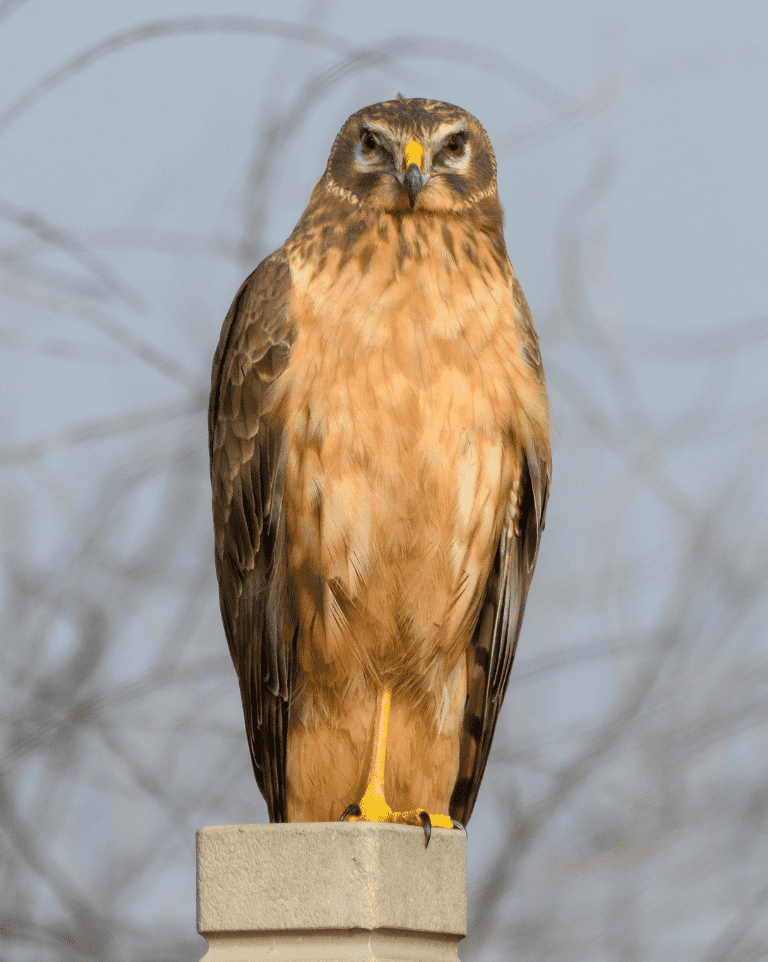
Northern Harriers are spotted in Southern California in the winter, mainly over grasslands and marshes. This is a non-breeding population of hawks; they use Southern California as a wintering location before heading back north to the Pacific Northwest.
You are far more likely to see this bird in the rice fields or salt water marshes of Central and Northern California, but they have been spotted in marshy areas like the Newport Beach Back Bay, especially during the winter.
These birds are small and light, but their long wings and tails make them appear larger, around the size of a crow. As with nearly all hawks, the females are significantly larger than the males.
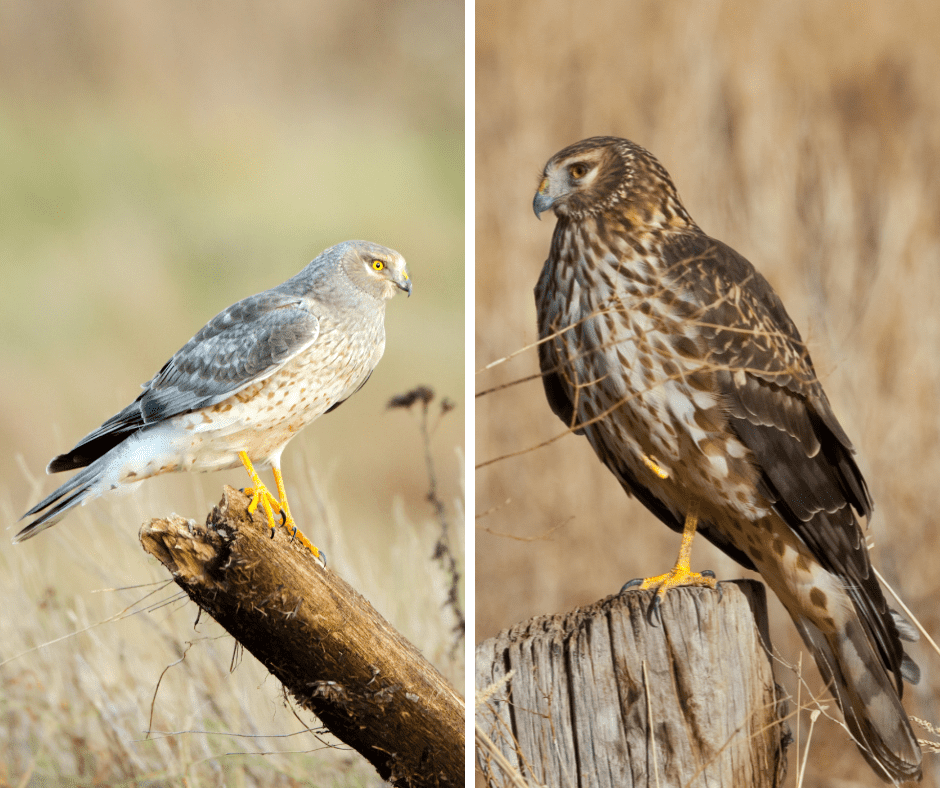
Females are different colors than the males. Males are gray on top and white underneath. They have black wing tips. Females are dark brown on top and have light brown streaky underparts. Both have a white patch near their rump which is a main identifier of this hawk in flight.
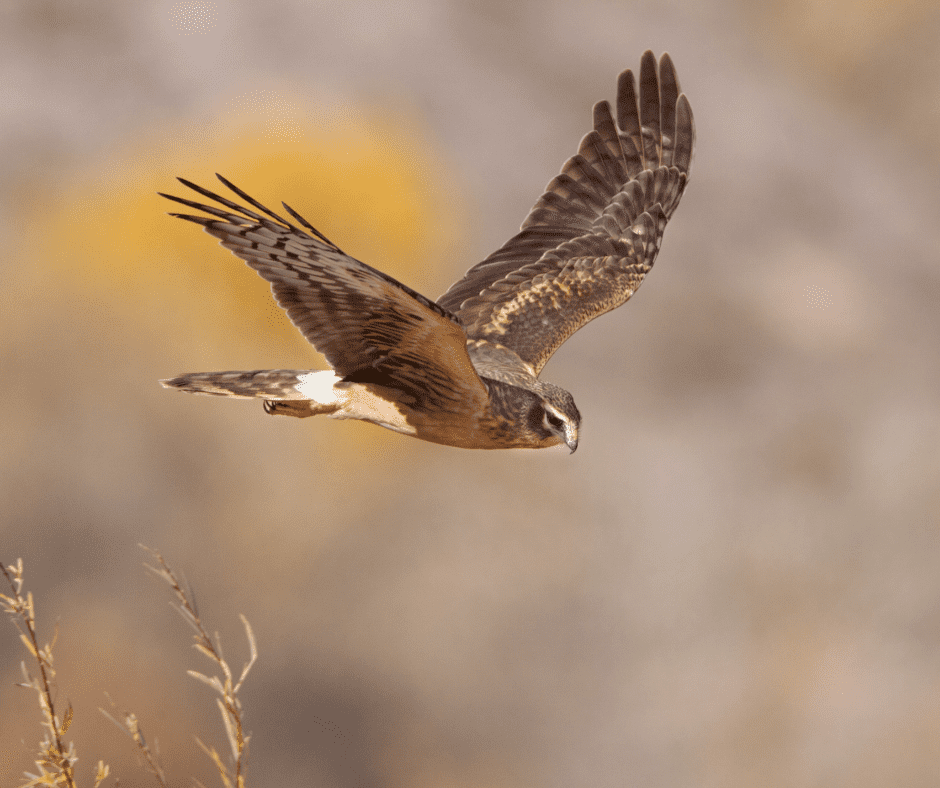
They both fly in a v-shape, with their wings higher than their bodies. They also hunt by sound and have a heart-shape facial disk that helps them locate their prey, just like owls. They mainly eat small mammals and birds that live in the marshy areas like mice, voles, and even small ducks.
Listen to the high-pitched calls of the Northern Harrier.
8. White-Tailed Kite
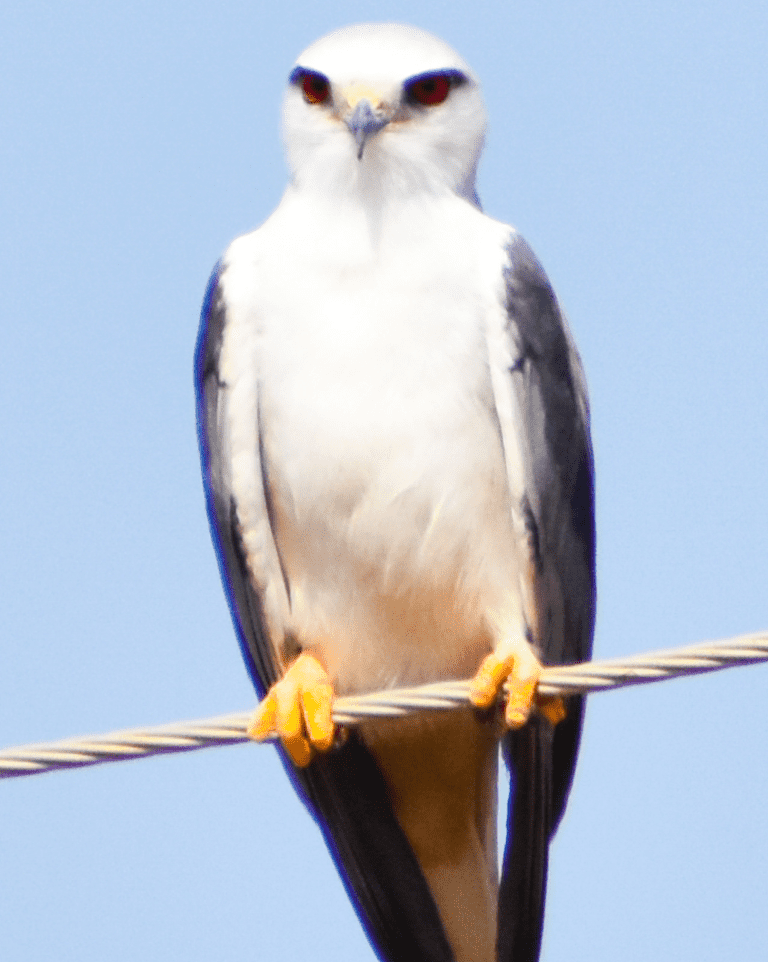
White-tailed Kites are some of the smallest hawks you will see in Southern California. They are typically crow-sized. The largest population of White-tailed Kites in North America is found in California, mainly in the grassy lowlands west of the desert.
They like farmland, wetlands, and open grasslands. They will roost in trees on the edges of these more open areas. When they aren’t breeding, you can often find White-tailed Kites roosting together in great numbers, sometimes up to 100 birds will hang out together in a small cluster of trees!
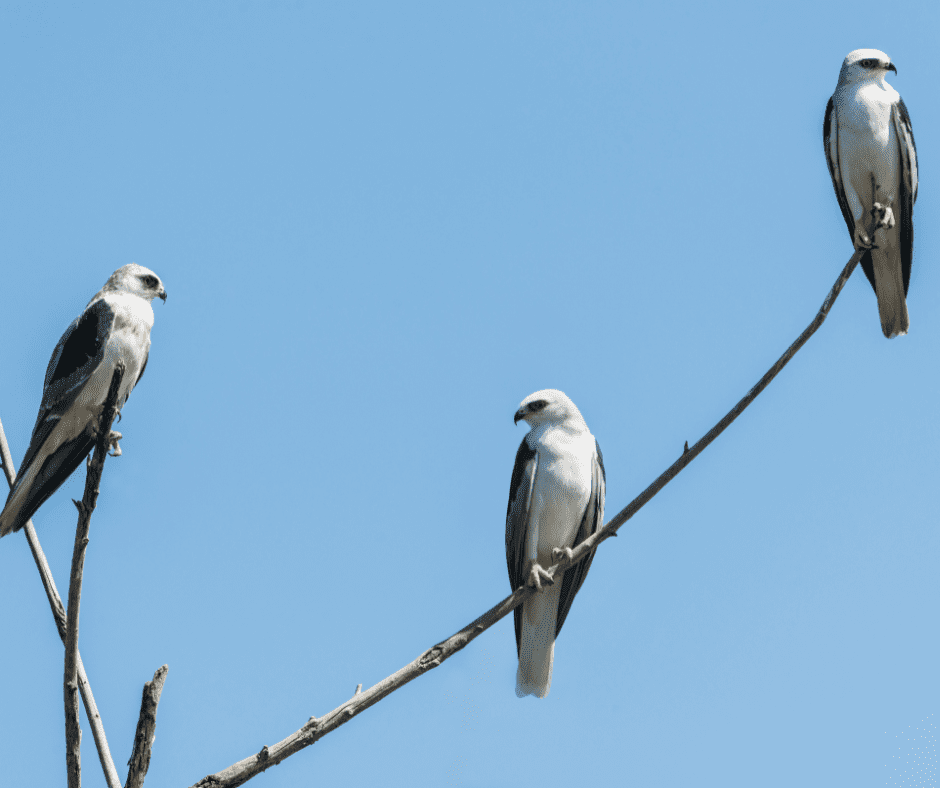
This bird eats mostly mice and voles, and hunts by hovering above the ground with its wings flapping and its head tipped down. This behavior is called “kiting”. When it sees movement of a mouse or vole on the ground, it then darts down to grab it.
White-tailed kites are usually fairly easy to identify thanks to their distinct coloring. They have white tails (it’s not just a clever name!), white heads, gray bodies, white underparts, and black shoulder patches. Eyes are generally orange or red.
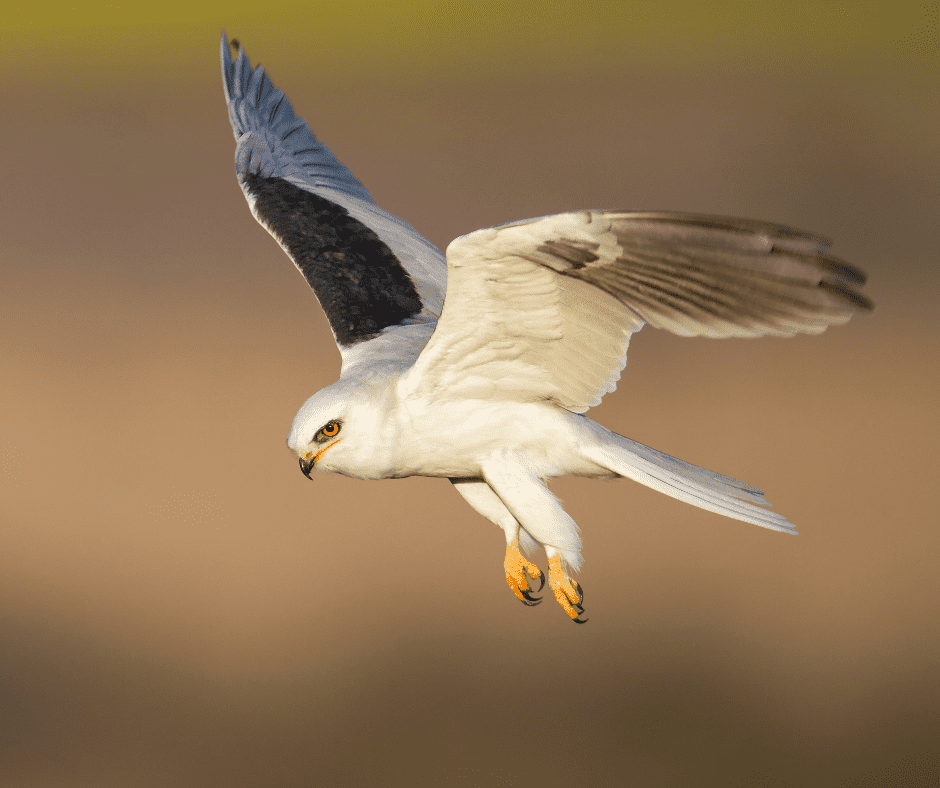
Females lay about four eggs at a time which are creamy white with some brown. The female incubates the eggs and stays with them until they are ready to fly. Males hunt and bring food. Young White-tailed Kites begin to fly after about a month and will return to the nest for a coupel more weeks to be fed and to sleep.
]]>